Roland KR107 ELECTRONIC PIANO WITH USB PORT User Manual KR 107 e
Roland Corporation ELECTRONIC PIANO WITH USB PORT KR 107 e
Roland >
Contents
- 1. USERS MANUAL 1
- 2. USERS MANUAL 2
- 3. USERS MANUAL 3
USERS MANUAL 3
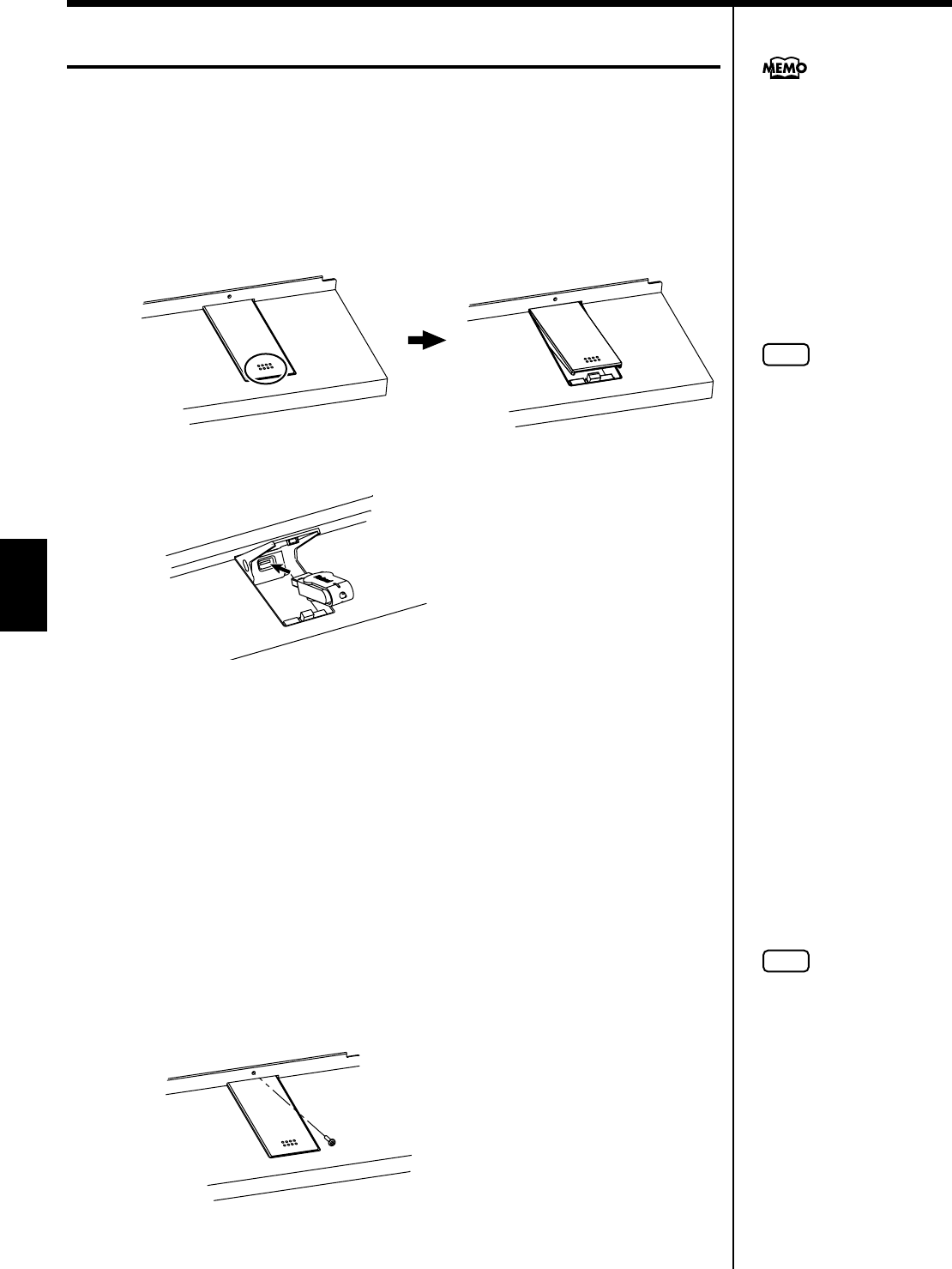
98
Chapter 5 Recording and Saving the Performance
Chapter 5
Using External Memories
If you install separately available external memory or a floppy disk drive, you'll be
able to save songs you've recorded and listen to commercially available music data.
■Connecting and Ejecting a External Memory
1. Press the External Memory port cover and open the cover.
Press the cover in; the cover will open.
2. Connect the external memory to the External Memory port.
3. Press the cover in again to close the cover.
* Always keep the Ext Memory port cover closed except when connecting and
disconnecting external memory.
Locking the External Memory Port Cover
When connecting external memory (sold separately), you can lock the memory port
cover to prevent theft of the connected external memory.
1. Connect the external memory to the external memory port.
2. Press the External Memory port cover to close the cover.
3. Secure the lock using the anti-theft lock screws included with the
instrument.
s
NOTE
Use external memory available
from Roland. Proper
functioning cannot be
guaranteed if other external
memory products are used.
If connecting an optional
floppy disk drive, substitute
“floppy disk” wherever the
term “external memory”
appears here.
NOTE
Take care not to lose the anti-
theft lock screws. Also be sure
to use only the included
screws to secure the anti-theft
lock.
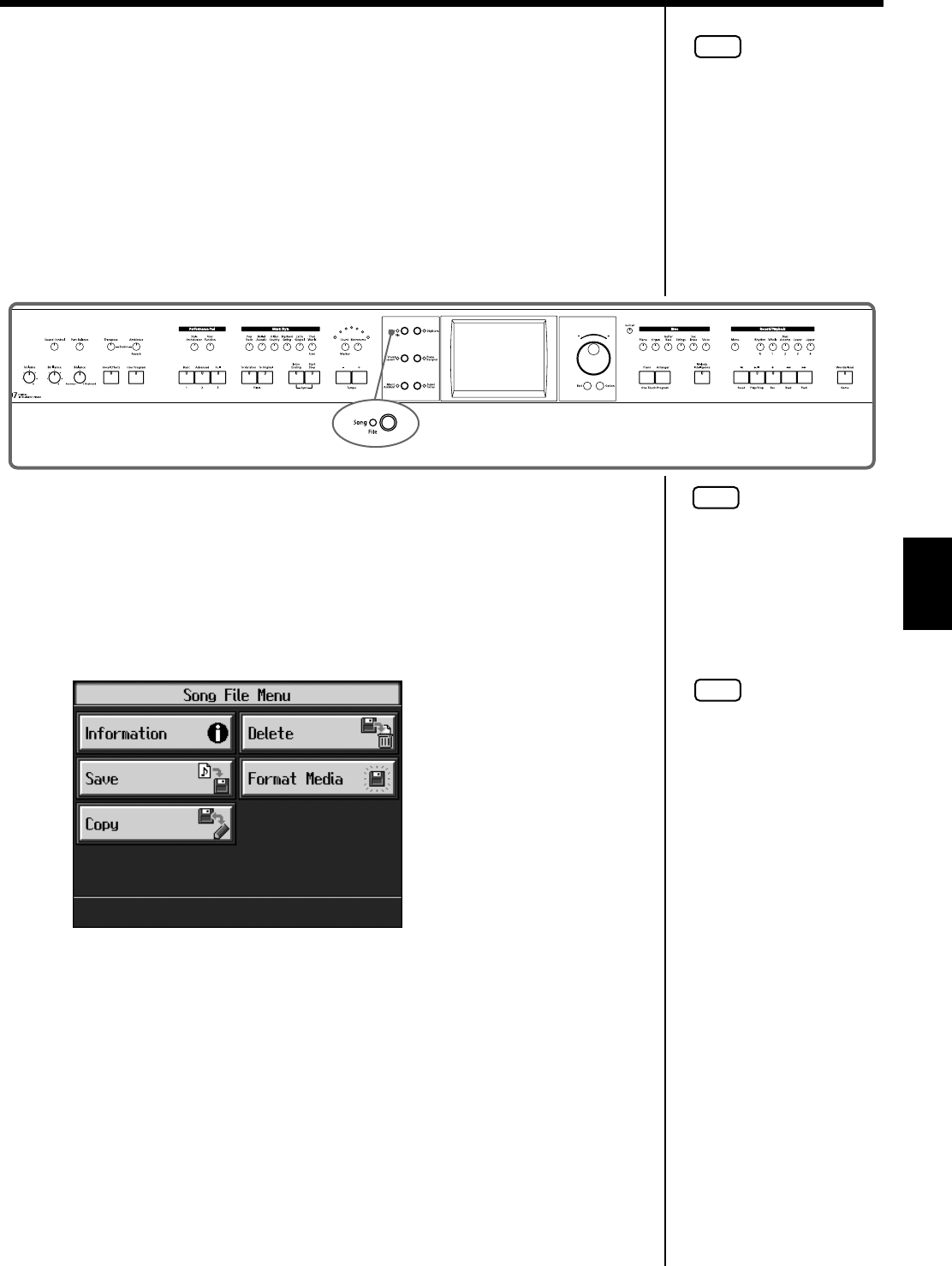
99
Chapter 5 Recording and Saving the Performance
Chapter 5
■
Formatting Media (Format)
The process of preparing external memory or disks so that they can be used with the
KR-107 is called “initialization” (formatting).
In certain cases, particularly with floppy disks, the media is formatted for a specific
type of device. If the media format does not match the KR-107's, you will not be able
to use that media with the KR-107.
fig.panel4-3
1.
Connect the external memory to the external memory port.
2.
Press the [Song/File] button.
3.
Touch <File>.
A “File screen” like the one below appears.
fig.d-songfile.eps_60
4.
Touch <Format>.
The following screen appears.
NOTE
When a external memory is
initialized, all of the data
saved on the external
memory is erased. If you’re
formatting a used external
memory for reuse, be sure to
check first to make sure the
external memory doesn’t
contain any data you don’t
want to lose.
NOTE
When initializing floppy disks,
check to make sure that the
disk's write protect tab is slid
to the “write” position.
NOTE
Do not eject the floppy disk
while data is being read from
or written to the disk. This
may scratch the disk's
magnetic surface, rendering
the disk unusable. (The disk
drive's indicator lights
brightly while data is being
read from or written to the
disk. At all other times, the
indicator is lit more dimly, or
is not lit at all.)
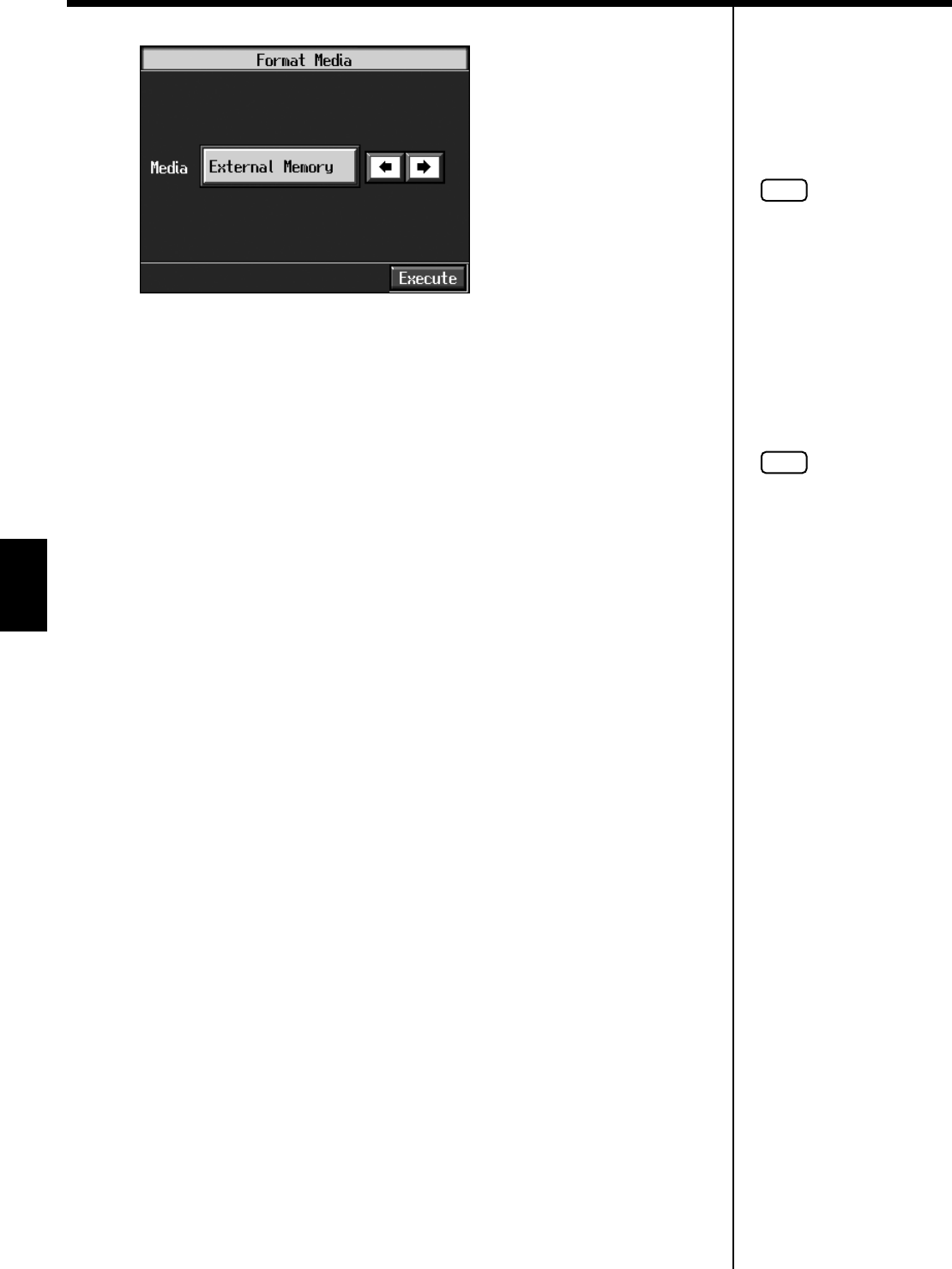
100
Chapter 5 Recording and Saving the Performance
Chapter 5
fig.d-format.eps_60
Press the [Exit] button to go back to the previous screen.
5.
Touch <Media> ** ** to select the storage media to be initialized.
6.
Touch <Execute>.
A confirmation screen appears. If you want to quit the initialization, touch <Cancel>.
7.
Touch <OK>.
Initialization of the external memory begins.
When initialization is completed, you’re returned to the previous screen.
NOTE
Do not remove the storage
media until the initialization is
completed.
NOTE
If “Error” appears on screen,
take a look at “Error
Messages” (p. 169).
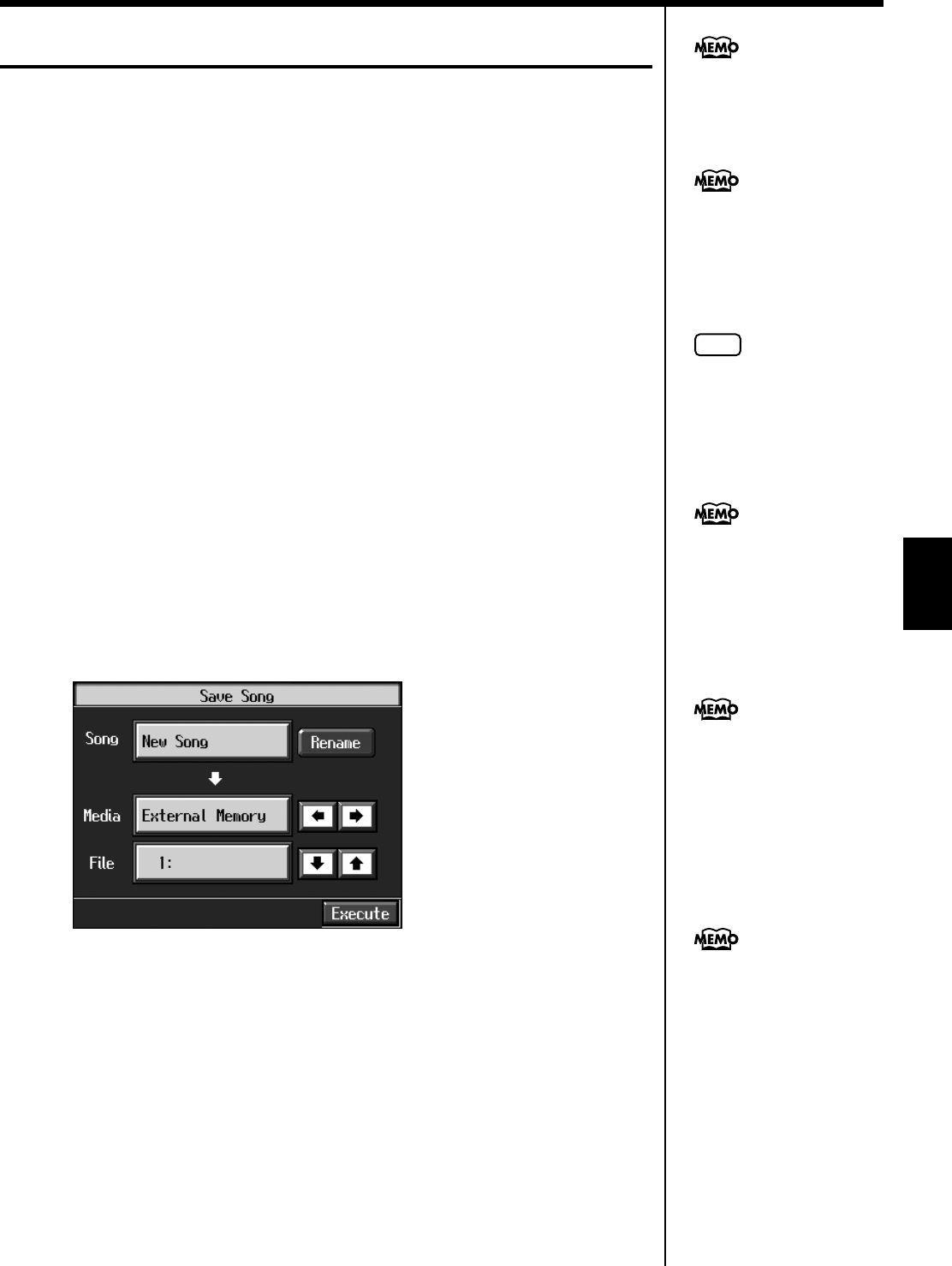
101
Chapter 5 Recording and Saving the Performance
Chapter 5
Saving Songs
A recorded performance is discarded when you switch off the power or choose
another song. Storing recorded performances and other data to external memories
or the Favorites is called “saving.” Be sure to save important songs to external
memories or Favorites.
What are “Favorites?”
You can register songs you are currently practicing or particularly like to
“Favorites,” allowing you to select these songs easily (p. 68).
When you register a song on a external memory to Favorites, you can then play back
the song without connecting the external memory to the external memory connector.
If a recorded performance is saved to Favorites, the performance won’t be erased
when the power is turned off.
Preparations for Saving Data
When saving to external memories, connect the external memory to the external
memory port.
1.
Press the [Song/File] button.
2.
Touch <File>.
3.
Touch <Save>.
The following “Save Song screen” appears.
fig.d-songsave.eps_60
Substitute the words “floppy
disk drive” for “external
memory” if using a separately
purchased floppy disk drive.
When using a new strage
media, first initialize (format)
the external memory on the
KR. Take a look at “Formatting
Media (Format)” (p. 99).
NOTE
Some commercially available
music files cannot be saved
b
ecause they are copy
protected.
When saving to floppy disks,
first check to make sure that
the floppy disk’s protect tab is
set to the “Write” position
(p.*).
If not handled with care, a
floppy disk can be damaged,
or the data on it become
corrupted, making playback
impossible. We recommend
saving your songs on two
different floppy disks.
When you want to clear all of
the content saved to the
“Favorites” and restore the
settings to the original factory
condition on the KR, refer to
“Formatting the User
Memory” (p. 150).
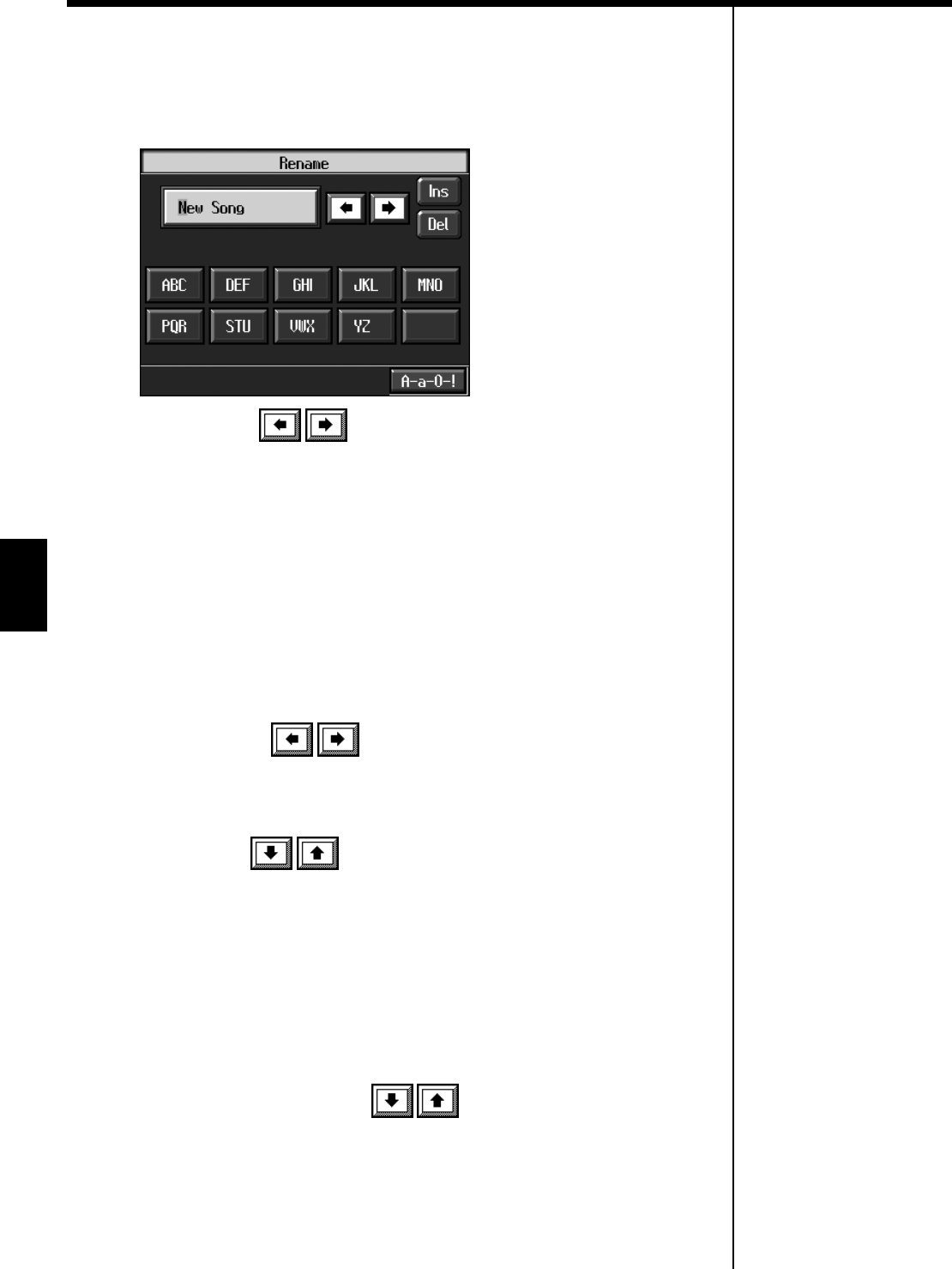
102
Chapter 5 Recording and Saving the Performance
Chapter 5
Determining the name of the song to be saved
4.
Touch <Rename>.
The following “Rename screen” appears.
fig.d-songname.eps_60
When you touch , the cursor moves.
When you touch the icon for the letter or character to be input, the character appears
at the cursor location. For example touching <ABC> in succession cycles you
through the available choices in that character group (“A”
→
”B”
→
”C”...).
Each touch of <A-a-0-!> cycles the type of characters through “English (upper case),”
“English (lower case),” “numerals,” “symbols,” then back to “English (upper case).”
When you touch <Del>, the character at the cursor position is deleted.
When you touch <Ins>, a space is inserted at the cursor position.
5.
When you have finished with the name, press the [Exit] button.
Determining the Save Destination
6.
Touch <Media>
to select the save-destination storage media.
Touch <Disk> if you are saving to a external memory; touch <Favorites> if you are
saving to Favorites.
7.
Touch <File> to select the save-destination song number.
If a song name is displayed with a number a song is already saved to that number.
If you select a number with a previously saved song and then proceed to save a new
song, the previously saved song will be erased. If you do not want to lose a saved
song, select a number with no song name indicated in the save-destination column.
Selecting the Save Setting (when saving to external memories)
8.
Touch <Save Setting>.
9.
Touch “Tone Compatibility” to select the tone compatibility
format.
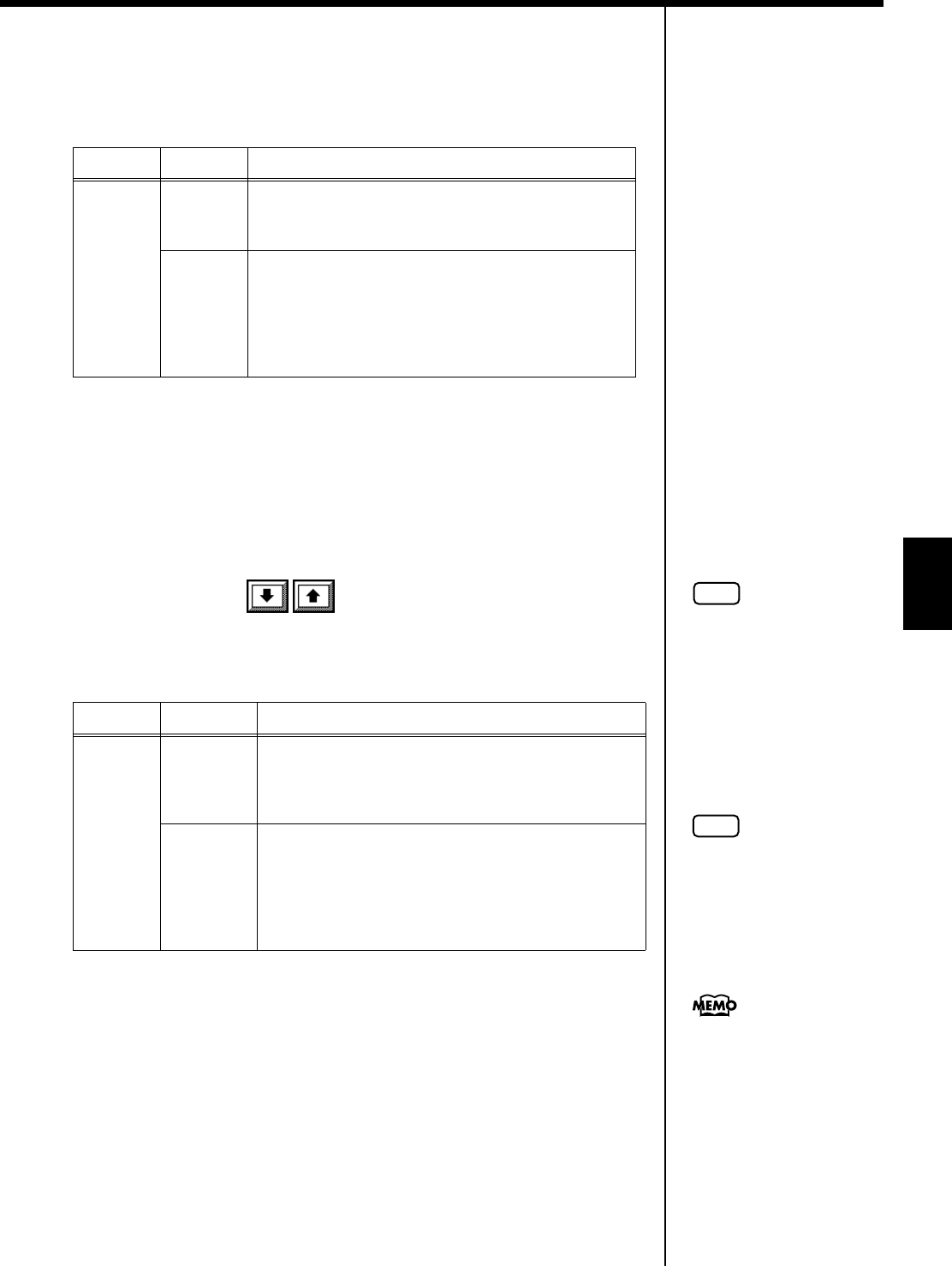
103
Chapter 5 Recording and Saving the Performance
Chapter 5
Some Tones are unique to the KR. Data that is recorded using these tones may not
play back correctly on other Roland Digital Pianos or Music Players. When you want
to save data so that it can be played back on another devices, save the data with
“MT” set as the Tone compatibility format.
<Note>
When data saved with “MT” as the Tone compatibility format is played back on this
instrument, some of the nuances that were part of the performance at the time the
data was recorded may be altered.
Even with data saved with “MT” as the Tone compatibility format, an exact
reproduction of the original performance may be unobtainable when using GS
devices other than Roland Pianos and Music Players.
10.
Touch <File Format> to select the file format.
The resulting file format will be different depending on whether <Save> or <As
SMF> is chosen, as described below.
11.
Press the [Exit] button.
Save
12.
Touch <OK> to start saving.
The time required for saving ranges from several seconds to half a minute or more.
Don’t take the external memory out of the external memory port until the saving
process is finished.
Press the [Exit] button to return to the Song File screen.
Display Explanation
Tone
Compati
bility
KR
The song is saved as data capable of reproducing
performances with richness of expression using this
unit’s special Tones.
MT
Data is saved in a form that can also be played on the
Roland Digital Pianos or Music Players other than this
unit.
You can listen to songs saved in this format on the
Roland HP-G/R series and KR series keyboards as
well as on Roland MT series devices.
Display Explanation
File
Format
Save
Saves the song in this unit’s format. You can listen to
songs saved in this format on the Roland HP-G/R
series and KR series keyboards as well as on Roland
MT series devices. This format is called “i-format”.
Save As
SMF
Saves the song as an SMF (Standard MIDI Files). Songs
saved in this SMF format can be listened to on many
instruments that can play SMF music files (p. 183).
A song recorded using commercial music files can’t be
saved in “Save As SMF” format for reasons of
copyright protection.
NOTE
Depending on the playback
instrument, some notes may
drop out or sound different.
NOTE
Never turn off the power
while the saving operation is
in progress. Doing so will
damage the KR’s internal
memory, making it unusable.
It’s a good idea to get into the
habit of moving the write-
protect tab on the floppy disk
to the “Protect” position when
you’ve finished saving your
data. Keeping the tab at
“Protect” prevents operations
that could erase your songs by
mistake.
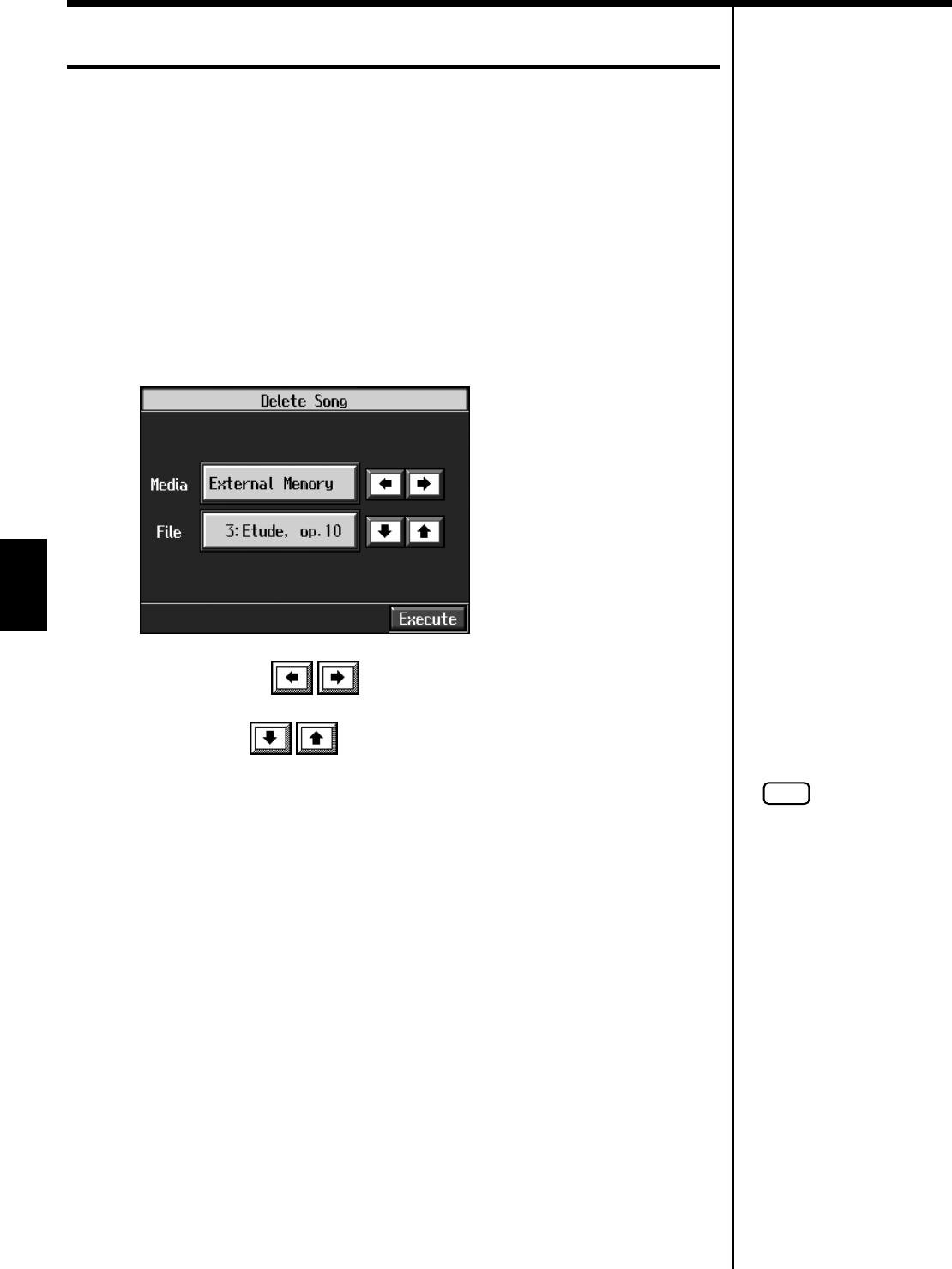
104
Chapter 5 Recording and Saving the Performance
Chapter 5
Deleting Saved Songs
This deletes songs that have been saved on external memories, or to Favorites.
To delete a song on a external memory, first connect the external memory to the
external memory port.
1.
Press the [Song/File] button.
2.
Touch <File>.
The “Song File screen” appears.
3.
Touch <Delete>.
A “Delete Song screen” appears.
fig.d-songdel.eps_60
4.
Touch <Media>
to select the storage media.
5.
Touch <File>
to select the song to be deleted.
6.
Touch <Execute>.
The selected song is deleted.
Do not eject the external memory from the external memory port until the operation
is finished.
Press the [Exit] button to return to the Song File screen.
NOTE
Never turn off the power
while the operation is in
progress. Doing so will
damage the KR’s internal
memory, making it unusable.
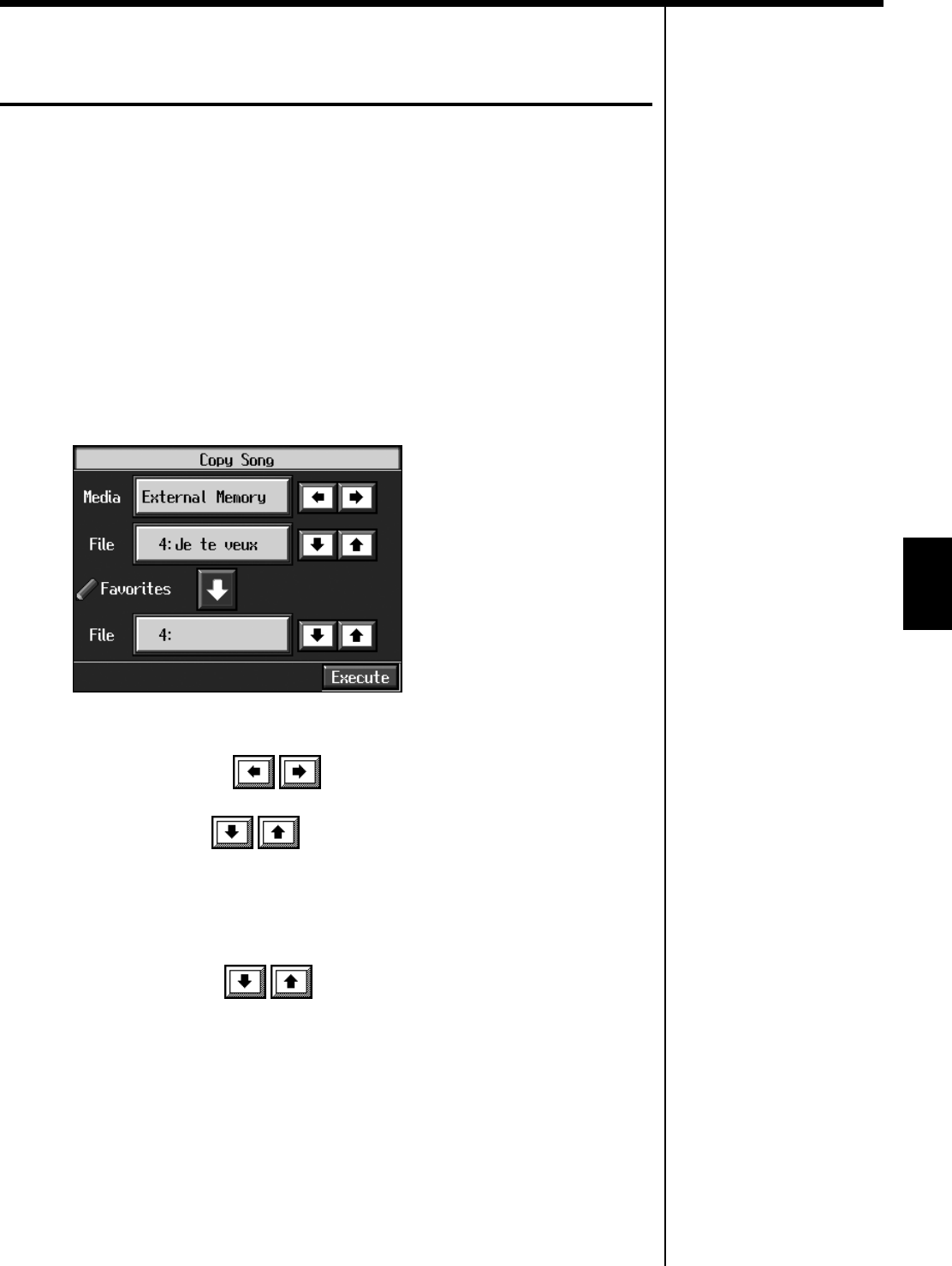
105
Chapter 5 Recording and Saving the Performance
Chapter 5
Copying Songs on External Memories
to Favorites
You can take songs saved on external memories and copy them to Favorites.
You can also copy songs in Favorites to external memories.
1.
Connect the external memory with the song to be copied to the external
memory port.
2.
Press the [Song/File] button.
3. Touch <File>.
4. Touch <Copy>.
The following “Copy Song screen” appears.
fig.d-songcopy.eps_60
Specifying the Copy Source
5. Touch the <Media> to select the copy source storage media.
6. Touch the <File> to select the song you want to copy.
When “Copy All” is selected, all of the songs on the external memory are copied to
Favorites.
Specifying the Copy Destination
7. Touch <Favorites> to select the copy destination for the
song.
If a song name is displayed with a number, a song is already saved to that number.
If you select a number with previously saved song data and proceed to copy to that
location, the previously saved song will be erased. If you don’t want to erase a
previously saved song, choose a number with no song name appears in the
destination column.
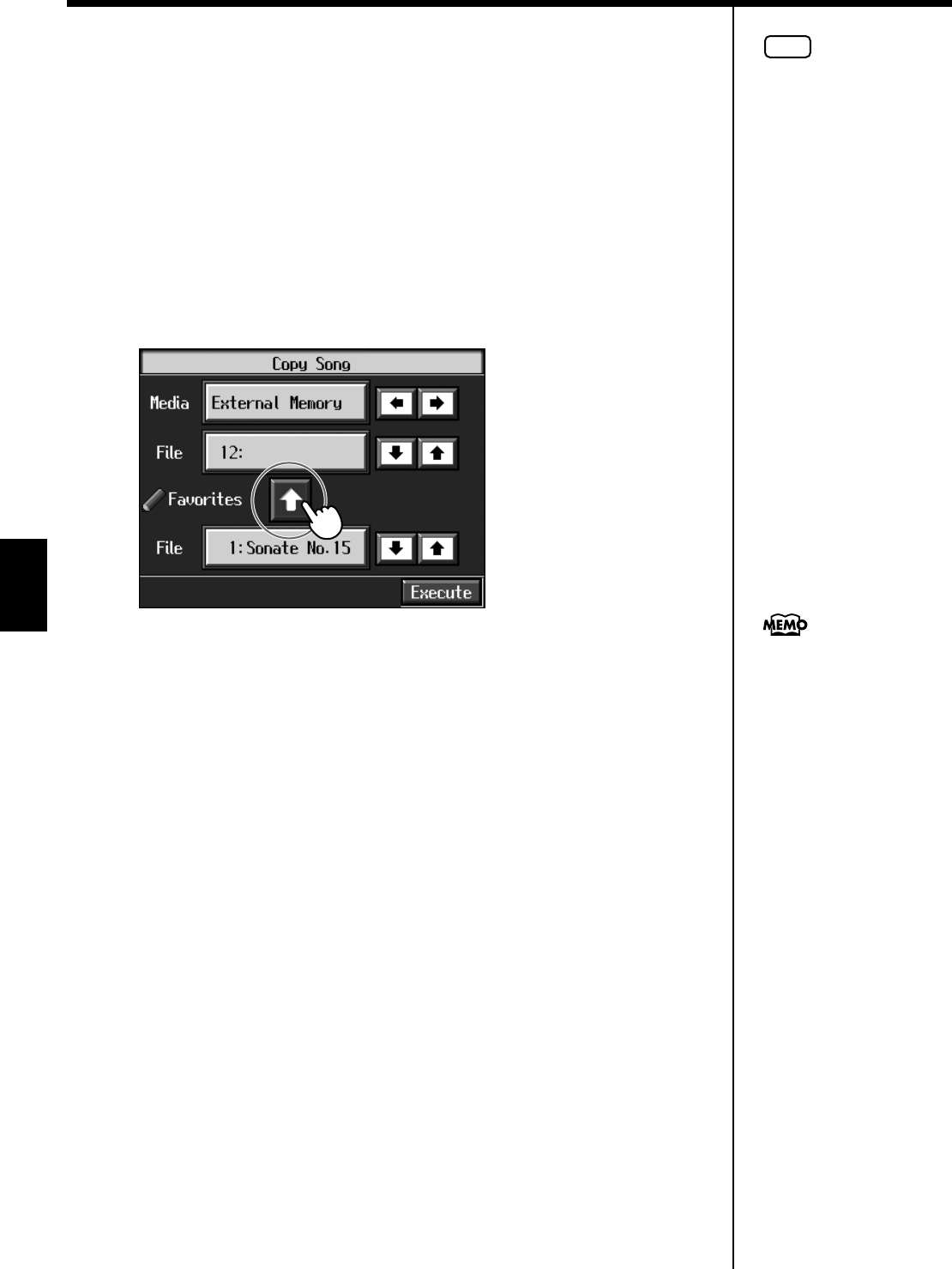
106
Chapter 5 Recording and Saving the Performance
Chapter 5
8. Touch <Execute>.
Do not eject the external memory from the external memory port until the copy is
finished.
The song from the external memory is copied to Favorites.
■Copying Songs Saved in Favorites to External
Memories
Songs that’ve been saved to Favorites can be copied onto external memories.
In this case, in the “Copy Song screen” in Step 4 above, touch the arrow icon in the
center to point the arrow upwards. This sets the KR to copy the song in Favorites to
the external memory.
fig.d-songcopy2.eps_60
The rest of the procedure is identical to that used for copying songs from external
memories to Favorites.
NOTE
Never turn off the power
while the operation is in
progress. Doing so will
damage the KR’s internal
memory, making it unusable.
Some song data cannot copy
b
ecause they are copy
protected.
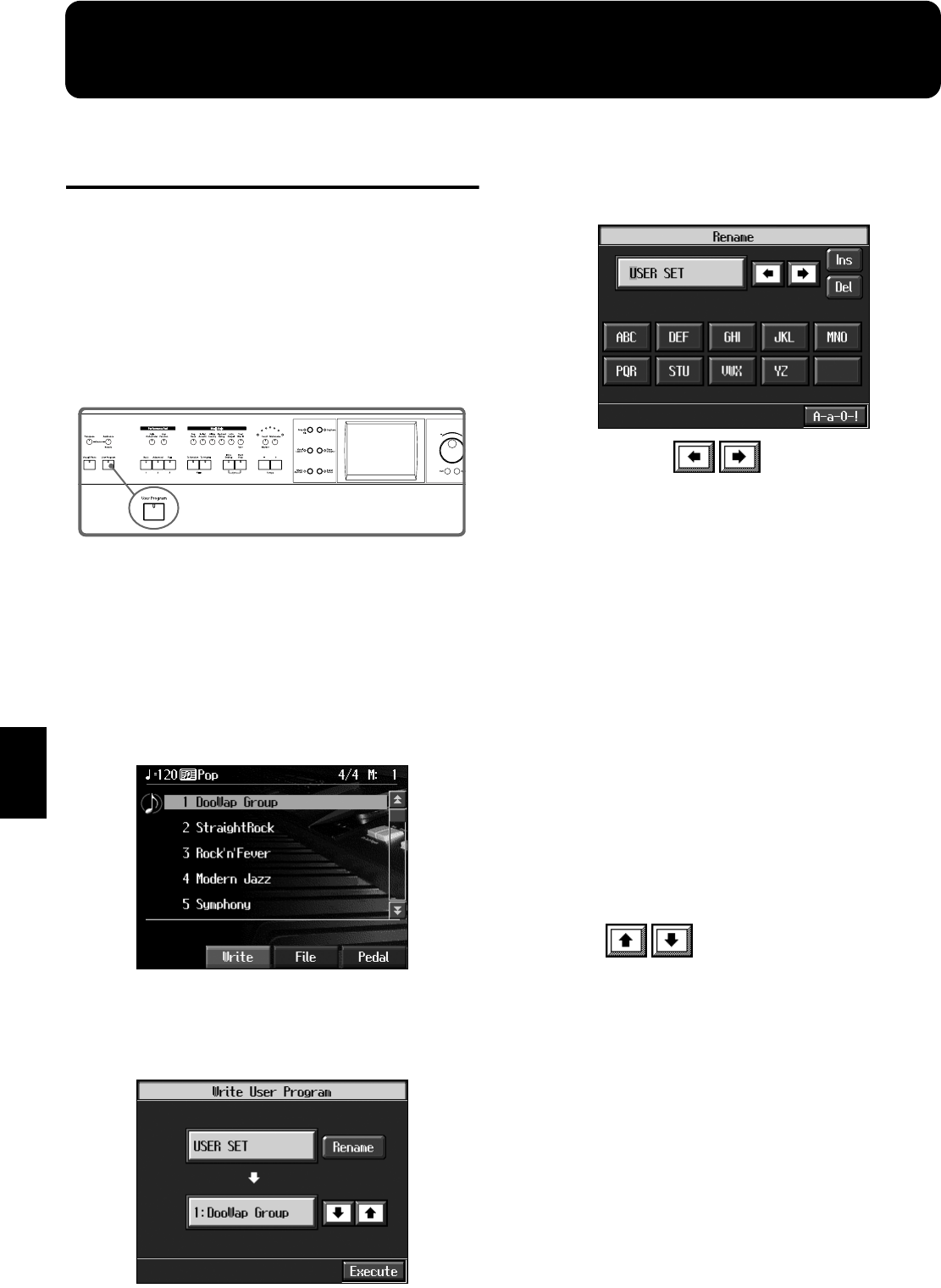
107
Chapter 6
Chapter 6 User Program Registration
Saving Performance Settings
(User Program)
Any collection of settings, including those describing the
current status of your data selections or settings Automatic
Accompaniment, can be saved to the [User Program] button.
You can then call up the stored settings by pressing the [User
Program] button. Saving your preferred combinations of
Music Styles and Tones, as well as other frequently used
settings, makes it more convenient.
You can register up to 36 User Programs to the KR.
fig.panel_UPG
→For more on what can be registered to a User Program, refer to
“Parameters Stored in the User Program” (p. 182).
1. Set the Music Style, Tone, and other data until the
settings are the way you want them.
2. Press the [User Program] button.
A “User Program screen” like the one shown below
appears.
fig.d-upg.eps_50
3. Touch <Write>.
A “Write User Program screen” like the following
appears.
fig.d-upgwrite.eps_50
Determining the name of the User Programs
4. Touch <Rename>.
A “Rename screen” like the following appears.
fig.d-upgname.eps_50
When you touch , the cursor moves.
When you touch the icon for the character to be input,
the character appears of the cursor potion.
For example, touching the <ABC> icon in succession
cycles you through the available choices in that character
group (A→B→C→A...).
Each touch of <A-a-0-!> cycles the type of characters
through “English (upper case),” “English (lower case),”
“numerals,” “symbols,” then back to “English (upper
case).”
When you touch <Del>, the character at the cursor
position is deleted.
When you touch <Ins>, a space is inserted at the cursor
position.
5. When you have finished with the name, press the [Exit]
button.
You’re returned to the Write User Program screen.
Determining the write destination
6. Touch to select the write-destination
number.
7. Touch <Write>.
The confirmation message appears.
8. Touch <OK>.
The current performance settings are saved to the [User
Program] button.
* Never turn off the power while the display indicates
<Writing...>. Doing so will damage the KR’s internal
memory, making it unusable.
→You can restore the content registered to the [User Program]
button to the original factory settings. Refer to “Restoring the
Factory Settings (Factory Reset)” (p. 148).
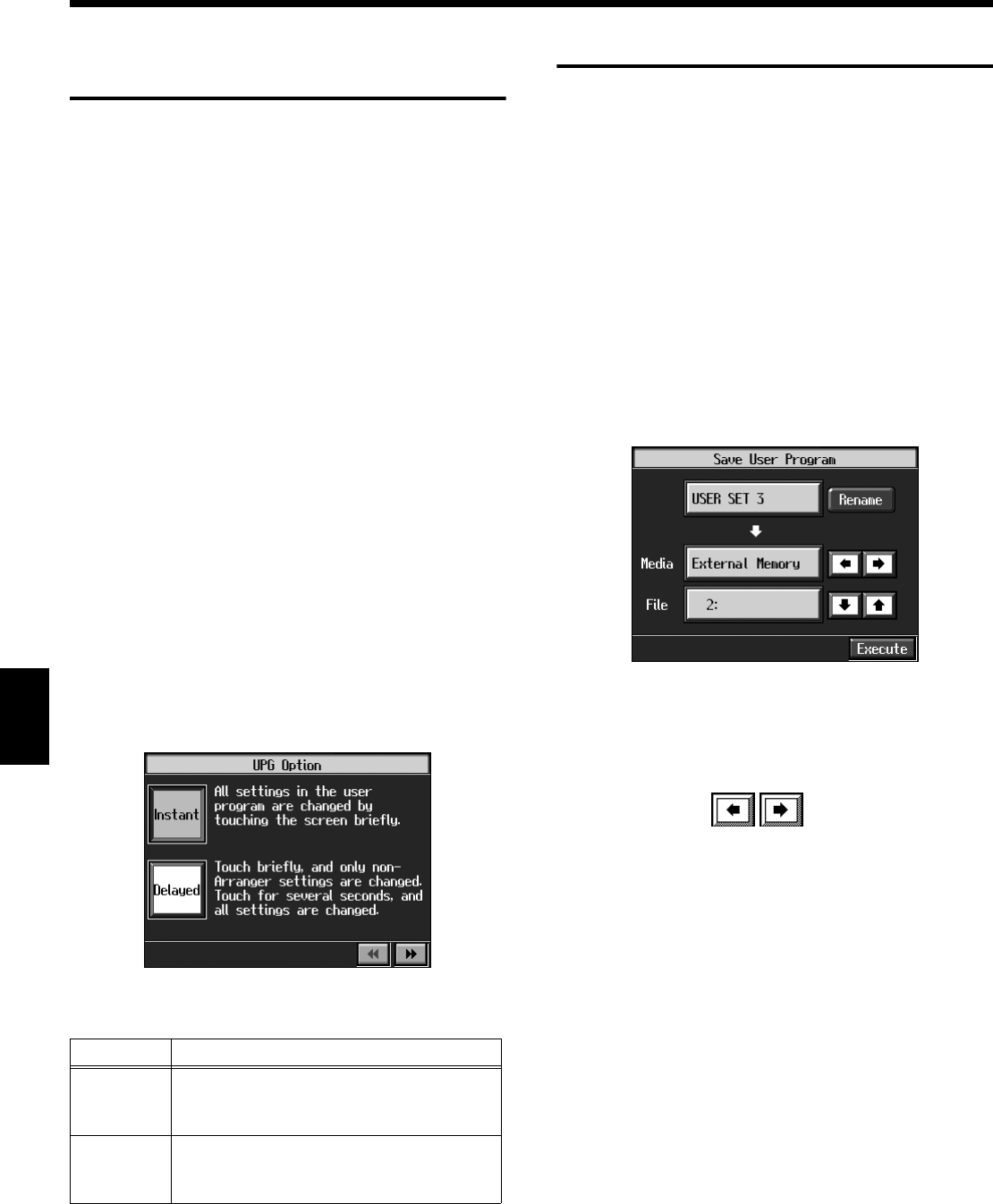
108
Chapter 6 User Program Registration
Chapter 6
Calling Up Saved User
Programs
You can easily call up settings saved to the [User Program]
button.
1. Press the [User Program] button.
The “User Program screen” appears.
Touch the scroll bar and drag up or down to scroll
through the screen and display other options.
Touch the page icons to change pages.
2. Touch the name of the User Program you want to call
up.
When you touch the name of the User Program, the
buttons or other performance settings instantly change
to the previously saved settings.
■Changing the Way User
Programs Are Called Up
When calling up User Programs, you can prevent the settings
for Automatic Accompaniment from switching by not
touching the touch screen for a few moments.
1. Press the [User Program] button.
2. Press the [Option] button in the lower part of the
screen.
A settings screen like the following appears.
fig.d-upgopt.eps_50
3. Touch <Instant> or <Delayed> to select the setting.
Press the [Exit] button to return to the User Program
screen.
Saving the User Program Sets
You can take the 36 User Programs saved to the [User
Program] button and save them as a set to a floppy disk, or to
user memory.
When saving to an external memory, first connect an external
memory to the external memory port.
→For more on working with the disk drive, refer to “Using
External Memories” (p. 98).
1. Press the [User Program] button.
2. Touch <File>.
3. Touch <Save>.
A “Save User Program screen” like the following
appears.
fig.d-upgsave.eps_50
Giving a name to a set of User Programs
4. Touch <Rename>.
The Rename screen appears.
When you touch , the cursor moves.
When you touch the icon for the character to be input,
the character appears at the cursor position. For example
touching the <ABC> icon in succession cycles you
through the available choices in that character group
(A→B→C→A...).
Each touch of <A-a-0-!> cycles the type of characters
through “English (upper case),” “English (lower case),”
“numerals,” “symbols,” then back to “English (upper
case).”
When you touch <Del>, the character at the cursor
position is deleted.
When you touch <Ins>, a space is inserted at the cursor
position.
5. When you have finished with the name, press the [Exit]
button.
Display Explanation
Instant
Immediately after a User Program name is
touched, the Automatic Accompaniment
settings also switch.
Delayed
The Automatic Accompaniment settings
switch after you touch and road the User
Program name for a few moments.
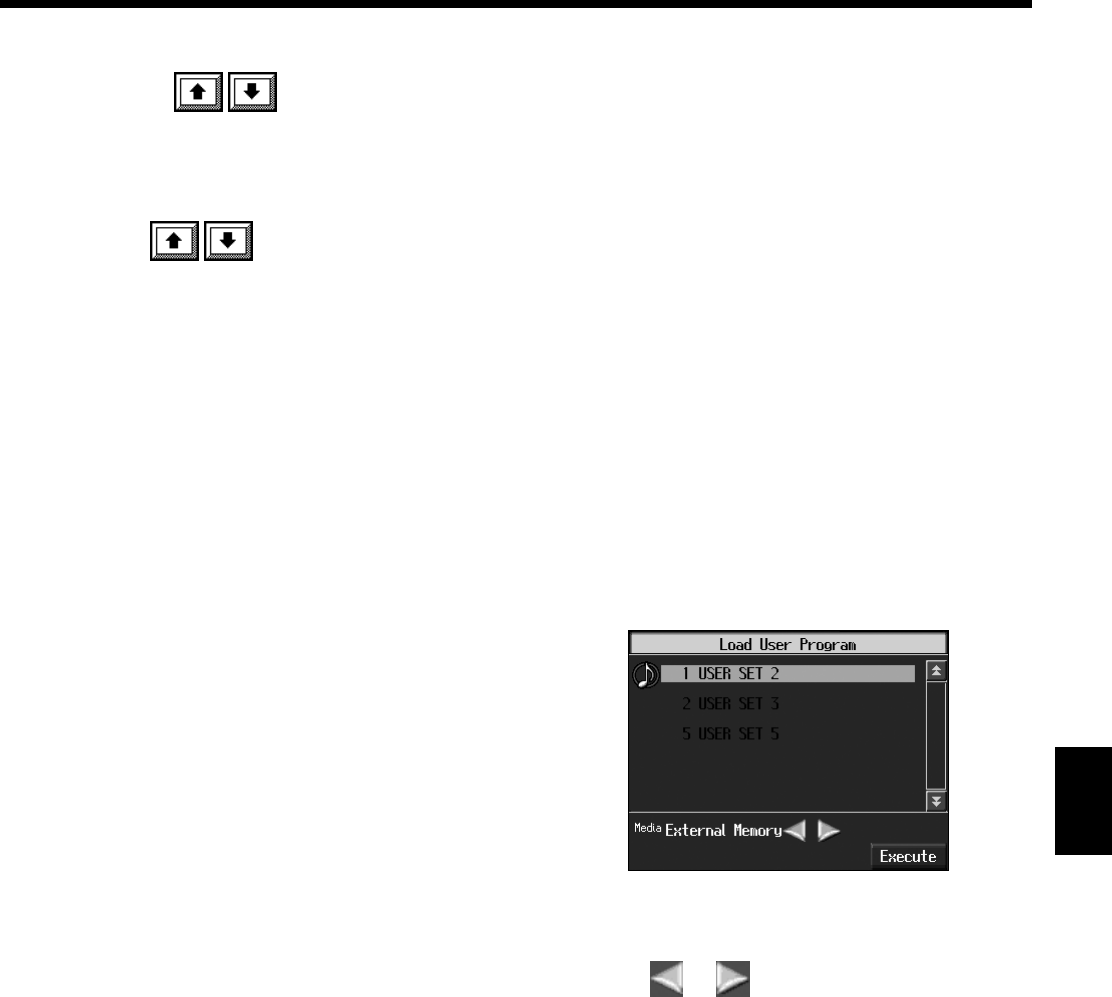
109
Chapter 6 User Program Registration
Chapter 6
Determining the save destination
6. Touch <MEdia> to select the save-
destination strage media.
Touch <Disk> if you are saving to a floppy disk; touch
<User> if you are saving to user memory.
7. Touch <File> to select the save-
destination User Program number.
If a User Program set name is displayed, a User Program
set saved to that saved to that number is already.
If you select a number with previously saved User
Program set data, then save a new set of data to that
same number, the older User Program set will be
deleted. If you don’t want to lose any previously saved
User Programs, select a number in the save-destination
column that does not yet have a name.
Save
8. Touch <Save> to begin the save.
Press the [Exit] button to return to the User Program File
screen.
* Never turn off the power or eject the external
memory from the external memory port while the
operation is in progress. Doing so will damage the
KR’s internal memory, making it unusable.
→When clearing the set of saved User Programs, refer to
“Deleting Saved User Program Sets” (p. 110).
■Loading Saved User Program
Sets
User Programs that have been saved on floppy disks or in
user memory can be called up, on an individual set basis, to
the [User Program] button.
* Note that calling up these User Programs results in the
deletion of all User Programs currently recorded to the [User
Program] button.
When loading a set of User Programs from an external
memory, first connect the external memory to the external
memory port.
→For more on working with the external memory, refer to
“Using External Memories” (p. 98).
1. Press the [User Program] button.
2. Touch <File>.
3. Touch <Load>.
A “Load User Program screen” like the following
appears.
fig.d-upgload.eps_50
Specifying the set of User Programs to be
loaded
4. Touch < > < > to select the storage media to be
read from.
5. Touch the name of User Program to load.
6. Touch <Load>.
The confirmation message appears.
7. Touch <OK>.
The selected User Programs are loaded to the [User
Program] button.
* Never turn off the power or eject the external
memory from the external memory port while the
operation is in progress. Doing so will damage the
KR’s internal memory, making it unusable.
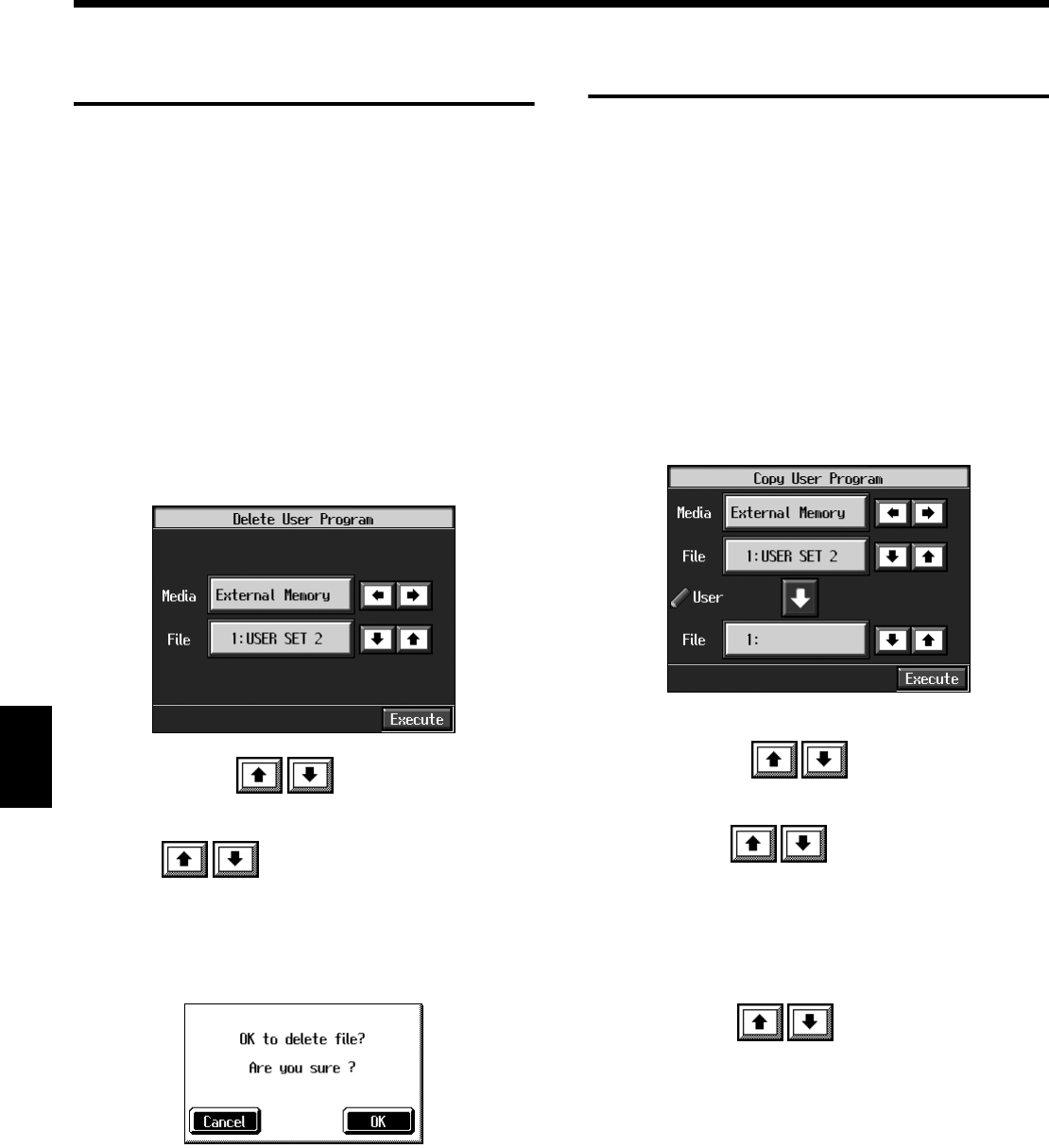
110
Chapter 6 User Program Registration
Chapter 6
Deleting Saved User
Program Sets
You can delete individual User Program sets saved to
external memories or in user memory.
When deleting a set of User Programs on an external
memory, first connect the external memory to the external
memory port.
→For more on working with the external memory, refer to
“Using External Memories” (p. 98).
1. Press the [User Program] button.
2. Touch <File>.
3. Touch <Delete>.
A “Delete User Program screen” like the following
appears.
fig.d-upgdel.eps_50
4. Touch <Media> to select the strage
media.
5. Touch to select the set of User Programs
to be deleted.
6. Touch <Delete>.
A screen like the one shown below appears.
fig.msg_filedel
7. Touch <OK>.
The selected User Programs are deleted.
Touching <Cancel> cancels deleting the file.
* Never turn off the power or eject the external
memory from the external memory port while the
operation is in progress. Doing so will damage the
KR’s internal memory, making it unusable.
Copying Sets of User Programs on
Floppy Disks to the User Memory
You can copy sets of User Programs saved on external
memories and to user memory.
You can also copy sets of User Programs saved in user
memory and to external memories.
1. Insert the external memory with the settings to be
copied in the disk drive.
2. Touch the [User Program] button.
3. Touch <File>.
4. Touch <Copy>.
A “Copy User Programs screen” like the following
appears.
fig.d-upgcopy.eps_50
Specifying the copy source
5. Touch <Media> to select the strage
media.
6. Touch <File> to select the set of User
Programs you want to copy.
When “All” is selected, all of the sets of User Programs
on the floppy disk are copied to user memory.
Specifying the copy destination
7. Touch <User> to select the copy
destination for the set of User Programs.
If a User Program name is displayed, already a User
Program saved to that number is already.
If you select a number with User Programs data, and
then copy data to that number, the previously saved
User Programs are deleted. If you do not want to delete
the saved User Programs, select a number in the save-
destination column for which no name is displayed.
8. Touch <Execute>.
The set of User Programs on the floppy disk is saved to
user memory.
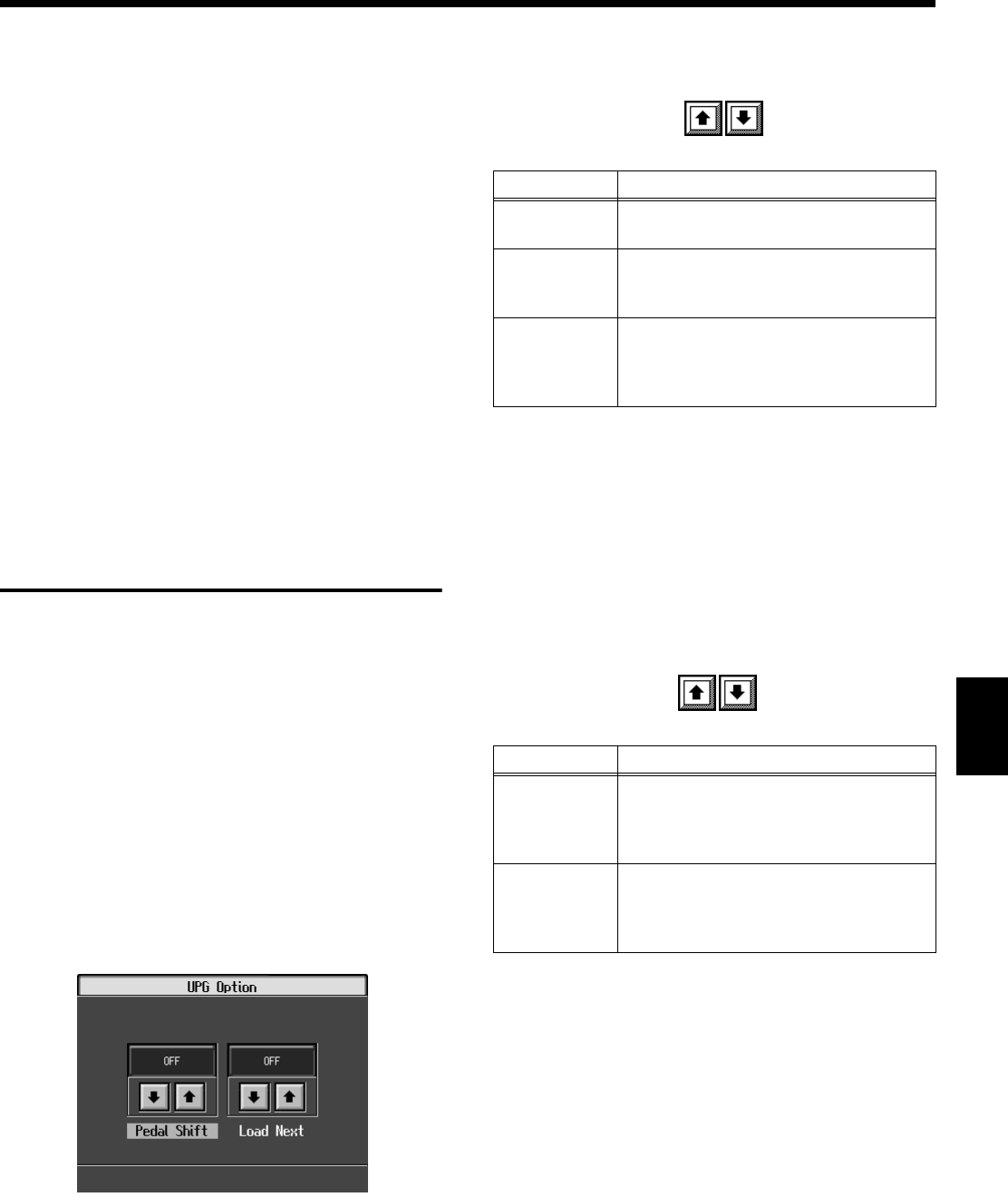
111
Chapter 6 User Program Registration
Chapter 6
* Never turn off the power or eject the external
memory from the external memory port while the
operation is in progress. Doing so will damage the
KR’s internal memory, making it unusable.
■Coping Sets of User Programs
Stored in the User Memory to
Floppy Disks
You can take User Program sets saved in user memory and
copy them to floppy disks.
In this case, in the Copy User Programs screen in Step 4
above, touch the large arrow icon in the center to get the
arrow to point up. This sets the KR to copy the User Program
set in the user memory to the floppy disk.
The rest of the procedure is identical to that used for copying
sets of User Program set from external memories to user
memory.
Using the Pedal to Switch
User Programs
You can assign the function of the sequential switching of the
“User Programs” to the pedal. That way, each time you
depress the pedal, the KR107 switches to the next User
Program.
Great for use in concerts and similar situations, this allows
you to prepare and save your User Programs in the sequence
they are to be used, and then call up User Programs in the
appropriate order while you perform, simply by depressing
the pedal.
1. Press the [User Program] button.
2. Touch <Pedal> in the lower part of the screen.
A “Copy User Programs screen” like the following
appears.
fig.d-upgopt.eps_50
■Selecting the Pedal Used for
Switching Settings (Pedal Shift)
3. Touch <Pedal Shift> to select the setting.
Press the [Exit] button to return to the User Program
screen.
■Sequential Loading of User
Program Sets Stored in
External Memory (Load Next)
When using the pedal to switch your User Programs,
you can also call up sequential sets of User Programs as
saved to external memory. This feature is called the
“Load Next” function.
3. Touch <Load Next> to select the setting.
Press the [Exit] button to return to the User Program
screen.
Display Explanation
Off You can use a function assigned to the
pedal.
Left Pedal
The left pedal is dedicated to switching
User Programs.The function assigned to
the left pedal cannot be used.
Center Pedal
The center pedal is dedicated to
switching User Programs.The function
assigned to the center pedal cannot be
used.
Display Explanation
Off
Switches Load Next off. The next press of
the pedal after the 36th User Program is
called up returns you to the first User
Program of the same User Program set.
On
Switches Load Next on. The next press of
the pedal after the 36th User Program has
been called up takes you to the first User
Program in the next User Program set.
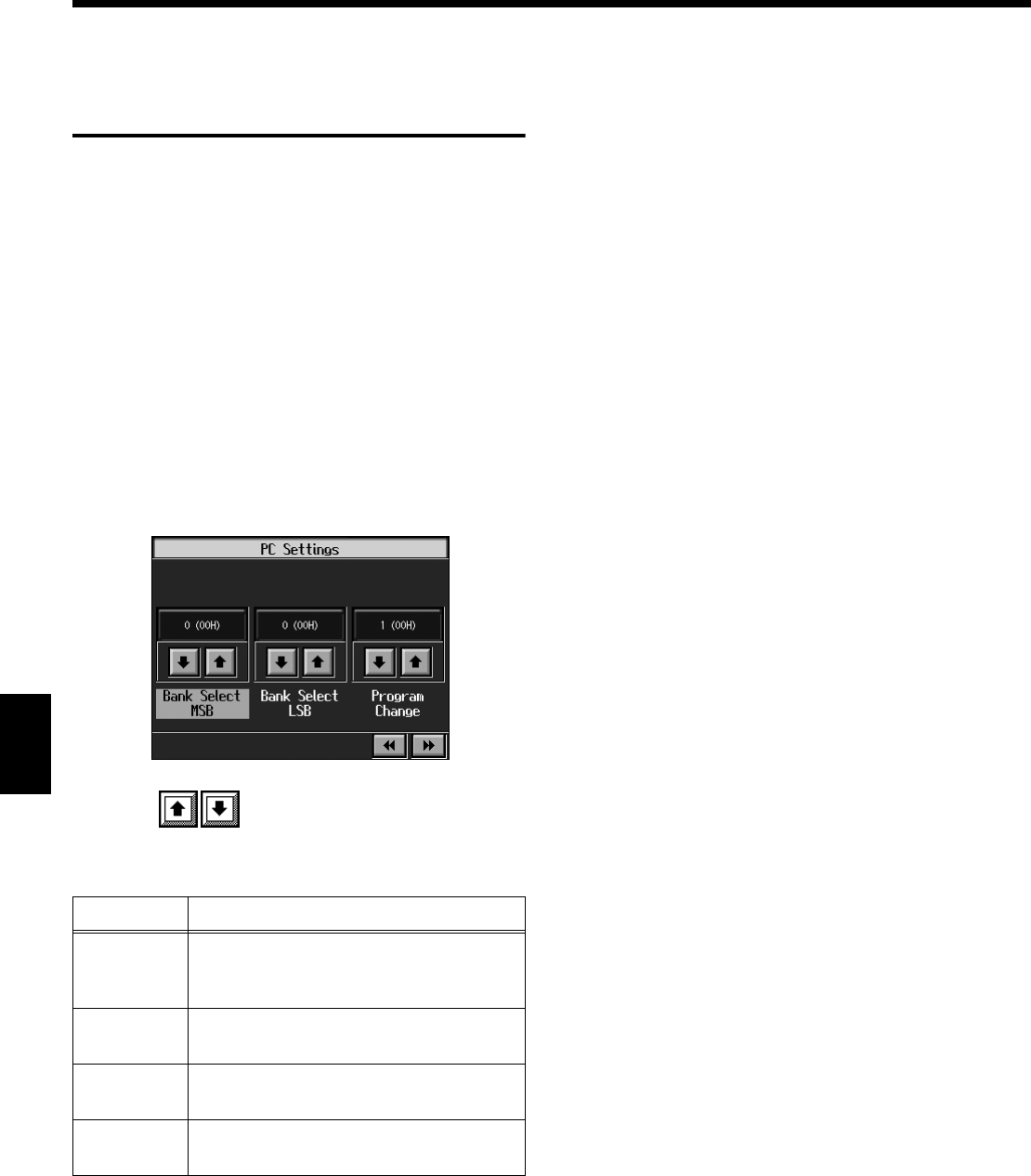
112
Chapter 6 User Program Registration
Chapter 6
Simultaneously Switching
User Program and
Transmitting PC Numbers
You can have PC (Program Change) numbers be transmitted
to an external MIDI device when you switch the User
Program on the KR.
You can register PC number settings to each of the User
Programs, just as you can with button settings and other
settings preferences.
Calling Up the Performance Settings to Be Set
1. Press the [User Program] button, then touch the name
of the performance setting you want to set.
Setting the Transmission of the PC
2. Touch <PC Set> in the User Program screen.
The following type of screen appears.
fig-upgPCset.eps_50
3. Touch for the parameter and make the
settings.
4. Press the [Exit] button.
The User Program screen returns to the display.
Touch <Write> to save the setting to the User Program.
For more detailed information, refer to “Saving
Performance Settings (User Program)” (p. 107).
Display Description
Tx PC
Channel
This prevents the PC number from being
transmitted (Off), or sets the transmission
channel (Channel 1–16).
Bank
Select MSB Sets the Bank Select MSB.
Bank
Select LSB Sets the Bank Select LSB.
Program
Change
Sets the Program Change messages
(Program Numbers).
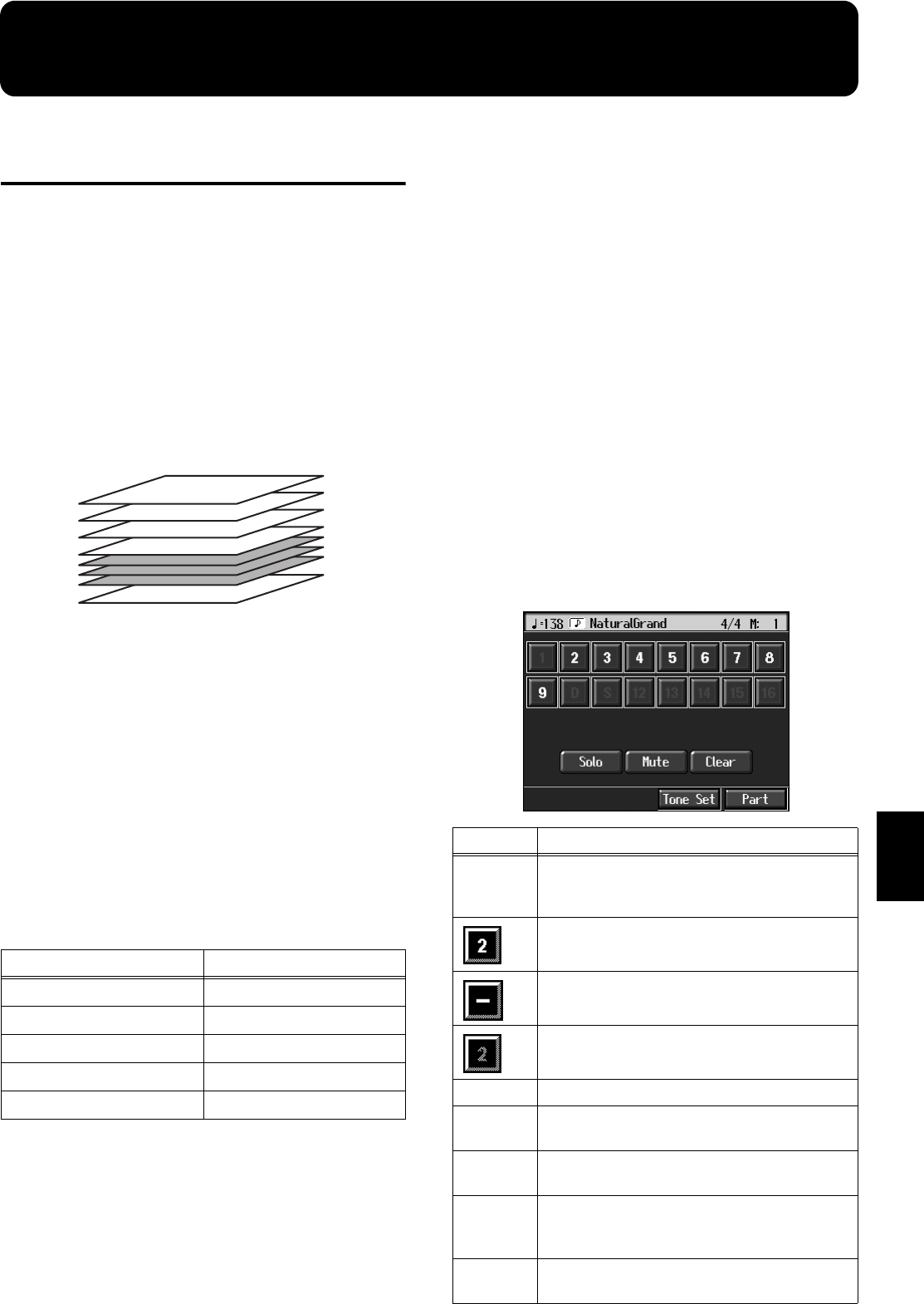
113
Chapter 7
Chapter 7 Creating and Editing Songs
Multitrack Recording with 16
Parts (16-Track Sequencer)
Multitrack recording always you to listen to previously
recorded material while continuing to add performances of
other parts.
The KR is capable of multitrack recording of up to sixteen
parts. Since each part’s performance is recorded using one
tone, you can layer performances, using up to sixteen tones
for the data in one song. The function used to layer these
sixteen parts, one at a time, is called the “16-Track
Sequencer.”
fig.16track.e
16-Track Sequencer and Track Buttons
In addition to the “16-Track Sequencer” function, the “Track
Buttons” (p. 83) are another of the unit’s playing/recording
functions.
These five “Track buttons” are used for organizing the 16-
Track Sequencer’s sixteen parts. This allows you to use the
16-Track Sequencer to add more sounds to performances
recorded with the Track buttons, and make even more
detailed edits of the songs.
You can easily play back the original song data with the 16-
Track Sequencer, mute parts by pressing the Track buttons,
and more.
The Track buttons correspond to 16-track sequencer parts as
shown below.
Since the 16-Track Sequencer records one tone to one part,
you cannot use Layer performance (p. 25), Split performance
(p. 26), or other such functions to record two or more tones
simultaneously. Also, you can’t record the performance with
Automatic Accompaniment.
When you want to record with Automatic Accompaniment,
then you should use the Track buttons for recording. (Refer
to “Recording With Accompaniment” (p. 92))
Commercially Available Music Files
Commercially available song file recorded in Roland’s SMF
format is also composed of sixteen parts.
By loading the song file from the floppy disk and using the
16-Track Sequencer, you can then also edit the song file.
→Although with commercially available Roland SMF music
data, Part 11 is included in the [2/Bass Accomp] track button,
other tracks match to the corresponding Track buttons.
* With some commercially available music files, you cannot edit
the data.
■The 16-Track Sequencer Screen
When recording with 16-track Sequencer, display the 16-
track Sequencer screen.
1. Press the [Menu] button.
The Menu screen appears.
2. Touch <16trk Sequencer>.
A “16-track Sequencer screen” like the one shown below
appears.
fig.d-16tr.eps_50
Track button Part
[R/Rhythm] D (10), S (11)
[1/Whole] 1
[2/Bass Accomp] 2, 5–9, 12–16
[3/Lower] 3
[4/Upper] 4
Part 16
You can record performances for up to 16 parts,
overlaying them part by part, to create a single song.
16-Track Sequencer
Part 4
Piano Part (right hand)
•
•
•
Part 3
Piano Part (left hand)
Part 2
Bass Part
Part 1
Flute Part
Icon Explanation
<1>–<16>
Touch to select the part to be recorded, or the
part whose settings are to be changed. The
button for the selected part changes color.
This Part to be played back
The Part not to be played back (Muted Part)
Parts that do not have performance data
recorded to them.
Solo Only the selected Part is played back.
Mute This allows you to prevent the sound for the
selected part from playing.
Clear The performance data for the selected part is
deleted.
Options
This displays the Part Settings screen, in which
you can make detailed settings for each part.
For details refer to p. 114.
Tone Set The Tone Set screen appears. For details refer
to p. 115.
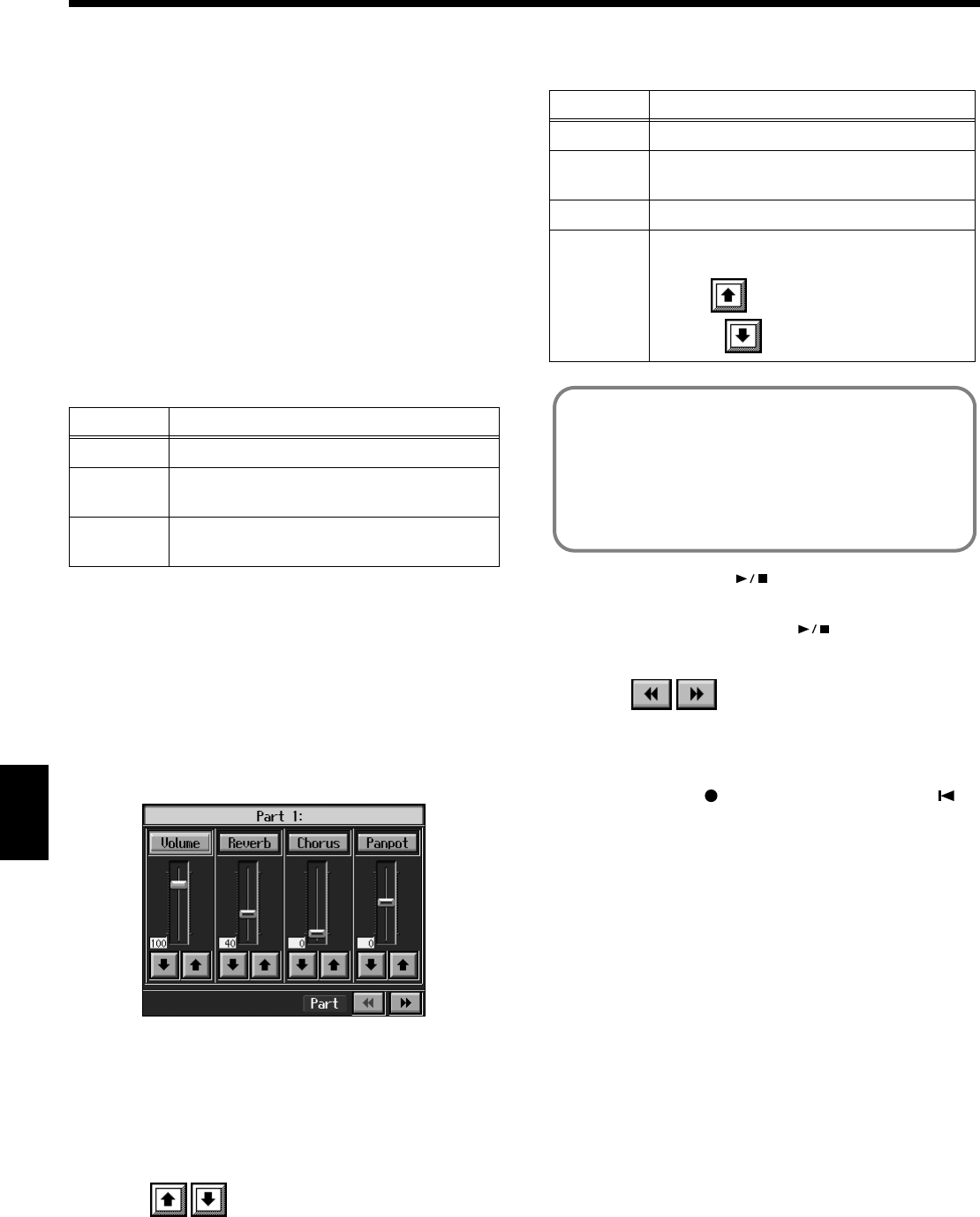
114
Chapter 7 Creating and Editing Songs
Chapter 7
■Modifying the Settings of Each Part
You can change the Tones and volume, as well as mute the
playback, for each individual part in songs recorded with the
16-track Sequencer and the internal songs.
→Because commercially available Roland SMF music files are
also made up of 16 Parts, you can change the settings for the
individual Parts and play them back in the same way.
First, select the song for which the settings are to be made
(p. 64).
1. Display the 16-track Sequencer screen (p. 113).
2. Touch the screen to choose the Part for which you want
to make settings.
Change the settings for the selected Part.
* When you touch <Clear>, a message asking you to confirm the
deletion appears. To erase the recorded sound, touch <OK>. If
you don’t want to erase the recorded sound, touch <Cancel>.
Once a performance has been erased, it can’t be restored.
* You cannot touch <Clear> during playback of the song.
3. Touch <Options> to make more detailed settings for
the selected part.
A screen like the one shown below appears.
fig.d-16trpart.eps_50
You can change the Tone for the selected Part by
pressing a Tone button while this screen is displayed.
When selecting Part 10 or 11, you can touch <Drum Set>
to select the drum set or effect sound.
The Part name and tone name are displayed at the top of
the screen.
4. Touch for the corresponding item to change
the setting.
You can adjust the values by touching the desired
parameter and turning the dial or by touching and
dragging the slider.
When you press the [ (Play/Stop)] button, you
hear what the song sounds like as you change the
settings. When you press the [ (Play/Stop)]
button, playback of the song stops.
5. Touch to make settings for other parts.
The Part name appears at the upper part of the screen.
Change the settings for other parts as needed.
6. Hold down the [ (Rec)] button and press the [
(Reset)] button.
This operation set the changes in the settings.
The song can then be saved to a floppy disk or to user
memory.
If you do not want to delete a song after changing the
settings for the individual parts, save the song to a
floppy disk or to user memory (p. 101).
* You cannot save the settings that determine whether sounds
for each individual part are played or not (solo and mute).
Display Function
Solo Only the selected Part is played back.
Mute Toggles playback of the selected Part to on
or off.
Clear The performance data for the selected part is
deleted.
Display Explanation
Volume Changes the volume level.
Reverb Changes the amount of reverb effect
applied to the sound.
Chorus Changes the amount of chorus applied.
Panpot
Shifts the direction from which the sound is
heard between left and right.
Touch to shift the sound to the right,
or touch to shift it to the left.
What’s Panpot?
Panpot is the control that determines the placement of
the sound in the stereo sound field between left and
right speakers. By altering the Panpot setting, you can
change the perceived location of the sound between the
left and right speakers.
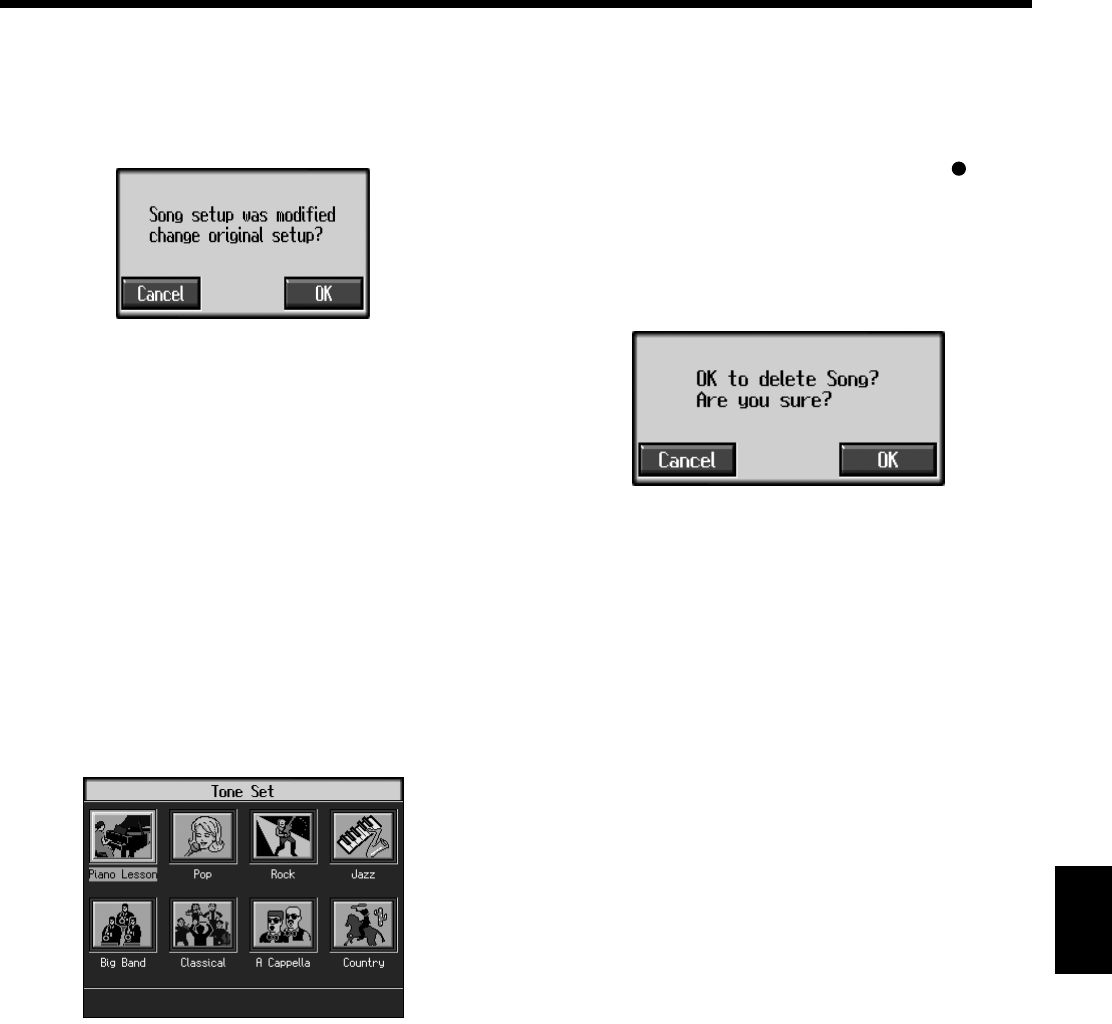
115
Chapter 7 Creating and Editing Songs
Chapter 7
If the following message appears
If you try to display another screen after you’ve changed the
song’s settings for each Part, a message like the one below
may appear.
fig.m-songmod.eps
Touch <OK> to change the song’s settings.
Touch <Cancel> to discard the changes you’re made.
■Getting the Most Suitable Part
Tones for the Musical Genre
(Tone Set)
“Tone Set” is a function that automatically assigns the most
suitable tones for the selected musical style.
When you’re creating a song, you can assign Tone sets, then
change the Tones to suit the ideas you have for your song.
1. Display the 16-track Sequencer screen (p. 113).
2. Touch <Tone Set> in the lower part of the screen.
A screen like the one shown below appears.
fig.d-16trtone.eps_50
3. Touch the screen to select a musical genre.
4. Press the [Exit] button.
The 16-track Sequencer screen appears.
Tones for each part are assigned automatically.
* In some genres, some parts may have no tone assigned.
■Recording a Performance
❍Step 1 Prepare for Recording
Selecting the song to record
1. Hold down the [Song] button and press the [ (Rec)]
button.
The following screen is displayed if there is any
previously recorded performance or any song with
changed settings.
fig.m-songmod.eps
Touch <Yes> to delete the song.
If you want to overwrite while recording, select a song.
→If a song has already been recorded, or if the song’s settings
have been changed, the “OK to delete Song?” confirmation
prompt appears when you touch <0: (Song Name)>. For more
information, take a look at “If the following screen appears” (p.
89).
Determining the song’s beat and tempo
2. Press the [Metronome] button to select the beat (p. 43).
→You can’t change a song’s beat once it’s been recorded. If you
want to compose a song whose beat changes partway through
the song, take a look at “Changing the Beat in the Middle of a
Song (Beat Map)” (p. 127).
3. Press the Tempo [-] and [+] buttons to set the basic
tempo of the song.
If you do not need the metronome sound, press the
[Metronome] button once more.
→When using song data that has already been recorded, the
recording is made using the source song’s basic tempo. To
change the basic tempo of a song, please refer to “Changing the
Tempo of Recorded Songs” (p. 127).
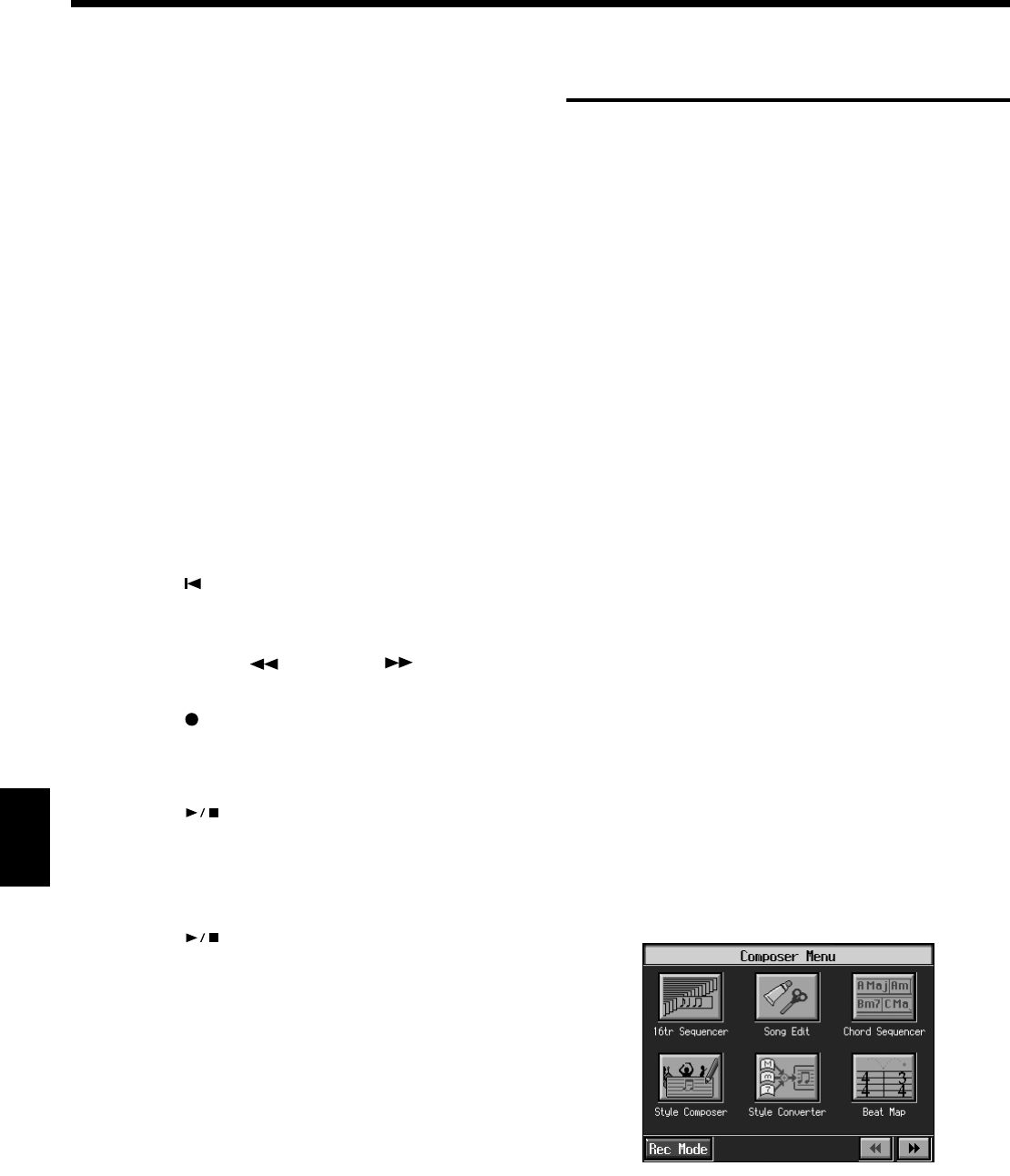
116
Chapter 7 Creating and Editing Songs
Chapter 7
❍Step 2 Start Recording
If necessary, choose a recording method.
For more on how to record, refer to p. 116.
If you record for the first time, there’s no need to select the
recording method.
Selecting the Part to Record
1. Display the 16-track Sequencer screen (p. 113).
2. Touch the number for the Part you want to record.
The button for the touched part being set turns orange.
You can only record drum sounds or effect sounds on
Part D (10) or Part S (11). You can select drum sets or
effect sounds by selecting Part D (10) or Part S (11) and
touching <Drum Set>.
Selecting the sound to play
3. Use the Tone buttons to choose a Tone to play.
After selecting a Tone, press the [Exit] button to call up
the “16-Track Sequencer screen.”
Recording the performance
4. Press the [ (Reset)] button.
Recording will start at the beginning of the song.
If you want to record from a point other than the
beginning, use the [ (Bwd)] and [ (Fwd)]
buttons to select another measure to begin.
5. Press the [ (Rec)] button and watch the indicator is
light up.
The KR is put in recording standby.
6. Press the [ (Play/Stop)] button.
A two-bar count-in sounds, then recording starts.
* You cannot use the performance pads when recording with the
16-track sequencer.
7. Press the [ (Play/Stop)] button.
Recording stops.
When one part is recorded, continue by selecting and
recording another part. Continue layering parts to finish
recording the song.
→You only need to follow the procedure described in “Step 1 –
Prepare for Recording” when you’re recording the first Part.
For the second Part and after, you can skip step 1 and proceed
from “Step 2 Start Recording.”
* Any performance that has been recorded is deleted when the
power to the KR is turned off. It is a good idea to save song
data to a floppy disk or user memory. For more information,
refer to “Saving Songs” (p. 101).
Changing the Recording
Method (Rec Mode)
You can use any of the four methods below to record with
the KR.
Although you will normally be using “Replace Recording,”
where previously recorded material is erased when new
sounds are recorded, you’ll find that you can record songs
easily by using this method in combination with other
recording methods.
Replace Recording (p. 117)
This is the normal method for recording. New material is
recorded as previously recorded material is erased.
Mix Recording (p. 117)
New notes are recorded on top of notes previously recorded.
This convenient feature makes it easy for you to record
melodies over prerecorded accompaniment.
Loop Recording (p. 117)
Specified measures are recorded repeatedly, while new notes
are combined with existing music. A convenient feature for
creating rhythm parts. Loop Recording allows you to record
over and over within a selected segment, adding a different
percussion sound with each pass.
Punch-in Recording (p. 118)
You can re-record only a specified passage as you listen to a
recorded performance.
→Immediately after the power is turned on, Replace Recording is
selected.
Changing the Recording Method
1. Press the [Menu] button.
The Menu screen appears.
fig.d-menu1.eps_50
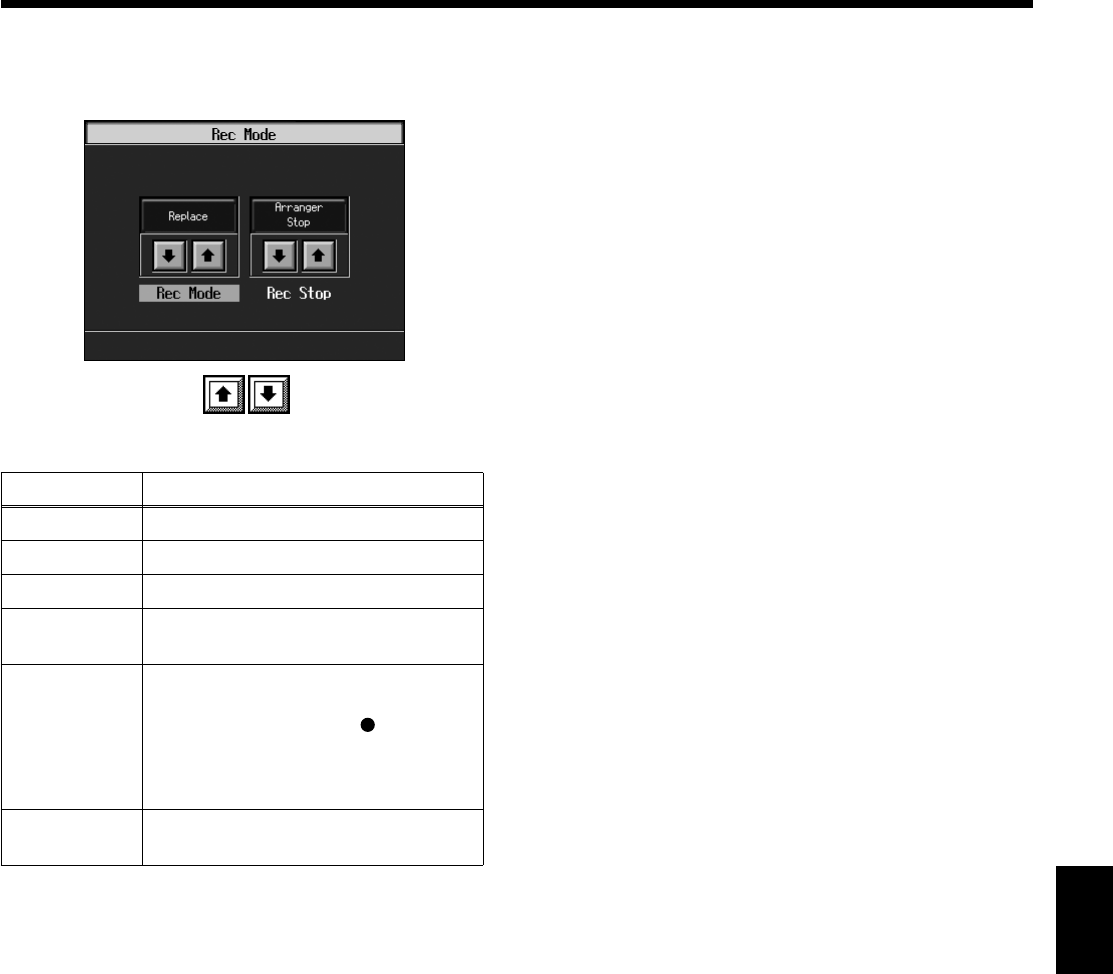
117
Chapter 7 Creating and Editing Songs
Chapter 7
2. Touch <Rec Mode>.
A “Rec Mode screen” like the following appears.
fig.d-recmode.eps_50
3. Touch <Rec Mode> to select the recording
mode.
4. Press the [Exit] button.
Returns to the Menu screen.
■Recording While Erasing the
Previous Recording (Replace
Recording)
The recording process where previous material is erased as
new material is recorded is called “replace recording.” This
setting is in effect when you turn on the power.
1. In the “Rec Mode screen” (p. 116), select <Replace>.
Press the [Exit] button to return to the Menu screen.
The KR is set to the replace recording mode.
Record the performance using the procedures described
in Chapter 4 (p. 89), “Multitrack Recording with 16 Parts
(16-Track Sequencer)” (p. 113).
■Layering a Recording Over
Previously Recorded Sounds
(Mix Recording)
You can record a performance layered over a previously
recorded performance. This method is called “Mix
Recording.”
1. In the “Rec Mode screen” (p. 116), select <Mix>.
Press the [Exit] button to return to the Menu screen.
Record the performance using the procedures described
in “Recording While Selecting the Track Buttons
(Redoing Recordings)” (p. 95), “Multitrack Recording
with 16 Parts (16-Track Sequencer)” (p. 113), or other
methods.
* After you have finished with mix recording, return to the
usual replace recording mode.
■Repeated Recording at the
Same Location (Loop Recording)
You can record a specified passage over and over, layering
sounds with each pass. This method is called “Loop
Recording.” This is handy when recording a Rhythm Part.
For example, use this method to make a Loop Recording of a
four-measure segment. First record the bass drum, the snare
drum next, then the hi-hat and so on, layering a different
instrument onto the same four measures. After you have
finished recording the four-measure rhythm pattern, you can
then use the procedure in “Copying Measures (Copy)” (p.
122) to create as many copies of the four measures as you
need to complete your Rhythm part.
1. Place A and B markers at the beginning and end of the
passage you want to record.
Take a look at “Setting Markers for Repeated Practice
(Marker)” (p. 84).
If you haven’t recorded anything yet, then use “Blank
Recording” to create the necessary number of measures
before placing the markers.
Display Recording Method
Replace Replace Recording
Mix Mix Recording
Loop Loop Recording
Auto Punch-
In/Out
Punch-in recording of the interval
between set markers.
Manual
Punch-In/Out
Punch-in recording starting from the
point at which the pedal, the
Performance Pad or the [ (Rec)]
button is pressed.
For more about Punch In Recording,
refer to p. 118.
Tempo You can add tempo changes to a
recorded composition. See p. 127.
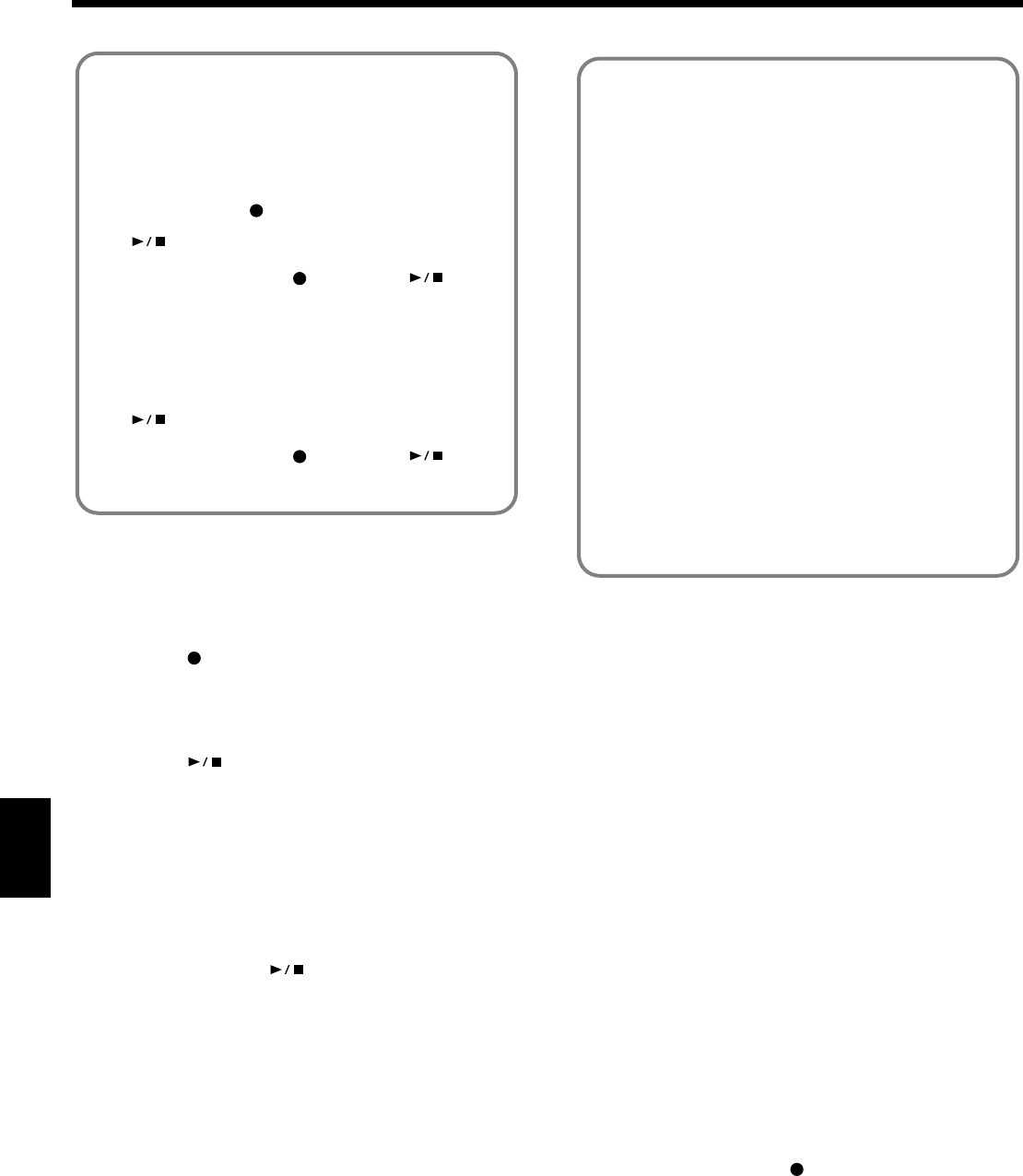
118
Chapter 7 Creating and Editing Songs
Chapter 7
2. In the Rec Mode screen (p. 116), select <Loop>.
Press the [Exit] button to return to the menu screen.
The recording method changes to loop recording.
3. Press the [ (Rec)] button.
4. Press the Track button for the track to be recorded.
The KR is put in recording standby.
5. Press the [ (Play/Stop)] button to begin
recording.
Recording starts from Marker A.
When the song reaches Marker B, it then returns to
Marker A, where recording continues.
Each time the recording is looped, the newest sounds are
layered over previously recorded sounds.
6. When you press the [ (Play/Stop)] button,
recording stops.
* After you have finished with loop recording, return to the
usual replace recording mode (p. 116).
■Re-Recording Part of Your
Performance (Punch-in Recording)
You can re-record part of a passage as you listen to a
recorded performance. This recording method is called
“Punch-in Recording.” This convenient function lets you
record over a specified points in a part as you listen to a
prerecorded performance in another section.
User Punch-In Recording by the following two methods:
Recording the Region Defined by Markers A and B
(Auto Punch-In/Out)
Before you start recording, place markers A and B to
define the passage you want to re-record. Make the
setting for punch-in recording, and re-record just the
passage between markers A and B.
Recording From the Point at Which the Pedal or
Buttons Are Pressed (Manual Punch-In/Out)
You can play back a performance and depress the pedal
at the desired place to start re-recording. Depressing the
pedal a second time cancels recording and returns you to
playback.
Instead of pressing the pedal, you can press a
performance pad or the[ (Rec)] button to start and
cancel recording.
❍Recording a Passage Specified by Markers
1. Before you start re-recording, place markers A and B to
define the passage.
Following the procedures described in “Setting Markers
What is Blank Recording?
Blank Recording is recording a number of silent
measures with no content.
1. Set the basic tempo and beat of the song.
2. Hold down the [ (Rec)] button and press the
[ (Play/Stop)] button.
The indicators for the [ (Rec)] and [ (Play/
Stop)] buttons both light up, then after two
measures of the count sound, recording begins.
3. Without performing anything, record only the
required number of measures, then press the
[ (Play/Stop)] button.
The indicators for the [ (Rec)] and [ (Play/
Stop)] buttons both go out, and recording stops.
Loop Recording Shortcut
You can also use the method described below to set Loop
Recording.
1. Place A and B markers at the beginning and end of
the passage you want to record.
Take a look at “Setting Markers for Repeated
Practice (Marker)” (p. 84).
If you haven’t recorded anything yet, then perform
“Blank Recording” for the necessary number of
measures before placing the markers.
2. Touch the <Repeat> icon in the Marker screen
(p. 84).
This sets the loop recording mode.
Start a recording.
* After you have finished with loop recording, touch the
<Repeat> icon in the “Marker screen” once more to
return to the usual replace recording mode.
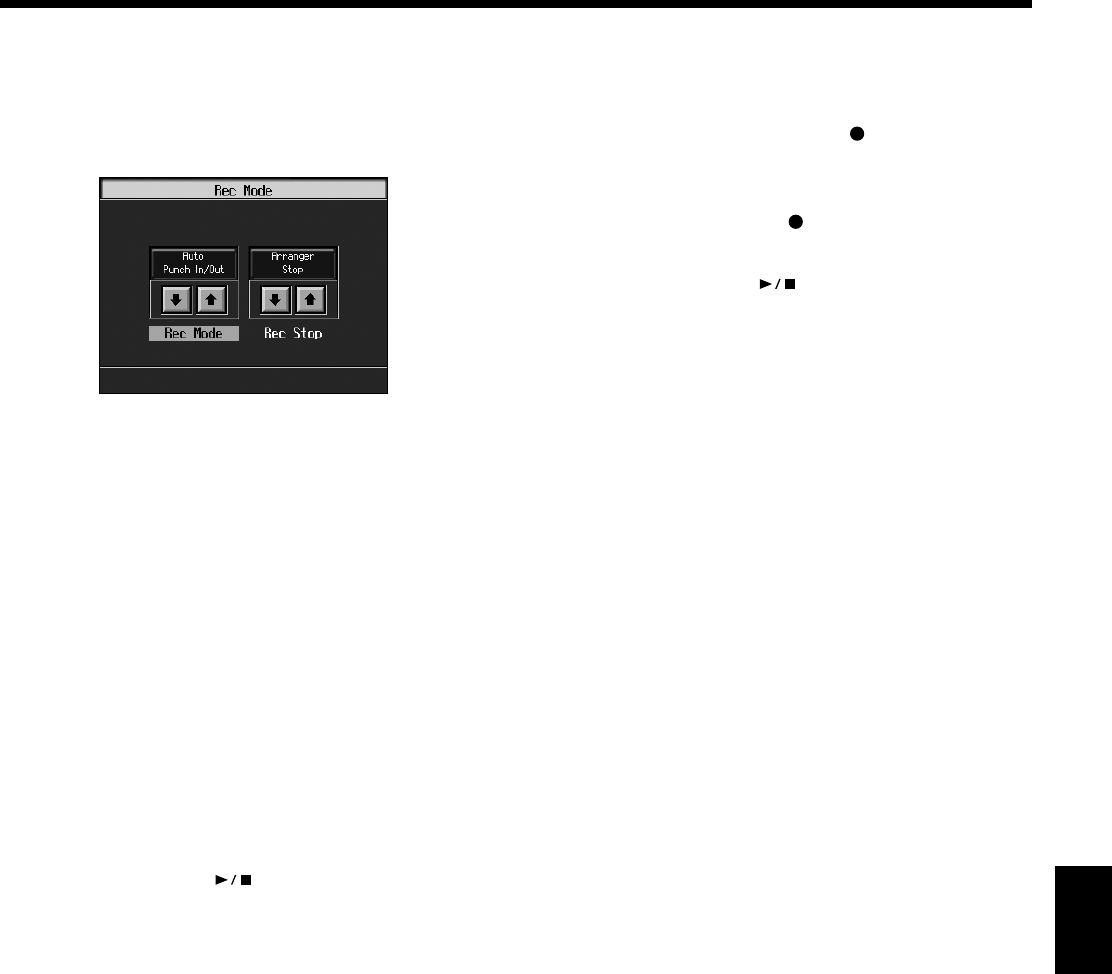
119
Chapter 7 Creating and Editing Songs
Chapter 7
for Repeated Practice (Marker)” (p. 84), use Markers A
and B to specify the passage.
2. In the Rec Mode screen (p. 116), select <Auto Punch-In/
Out>.
fig.d-rec-punch.eps_50
This changes the recording mode to “Punch-In
Recording.”
Press the [Exit] button to return to the Menu screen.
3. Begin recording.
Begin recording using the procedures described in
“Recording While Selecting the Track Buttons (Redoing
Recordings)” (p. 95) or “Multitrack Recording with 16
Parts (16-Track Sequencer)” (p. 113).
Up until the specified passage, the previously recorded
performance plays back.
When you reach the specified passage, sounds are erased
as recording starts; begin playing now.
When you reach the end of the specified passage,
recording stops, and the KR returns to playback of the
previously recorded performance.
4. When you press the [ (Play/Stop)] button, the
song stops.
❍Starting Recording from the Measure
Specified by Buttons and Pedals
If using the Performance Pads or pedals, you must first
change the function of the pedals and Pads. Follow the
procedures in “Assigning Functions to Pedals and
Performance Pads (Pedal Setting/User Functions)” (p. 142),
and assign <Auto Punch-In/Out> to the buttons or pedal.
1. In the Rec Mode screen (p. 116), select <Manual Punch-
In/Out>.
This changes the recording mode to “Punch-In
Recording.”
Press the [Exit] button to return to the Menu screen.
2. Begin recording.
Begin recording using the procedures described in
“Recording While Selecting the Track Buttons (Redoing
Recordings)” (p. 95) or “Multitrack Recording with 16
Parts (16-Track Sequencer)” (p. 113).
The previously recorded performance will be played
back.
Press the pedal to which Punch In/Out is assigned (p.
139), a performance pad, or the [[ (Rec)]] button to
begin recording, then start your performance.
Recording stops when you press the pedal, the
Performance Pad, or the [ (Rec)] button again, and
the previously recorded performance is played back.
3. When you press the [ (Play/Stop)] button, the
performance stops.
* When you’re finished with Punch-In Recording, return to the
ordinary Replace Recording mode. Take a look at “Changing
the Recording Method” (p. 116).
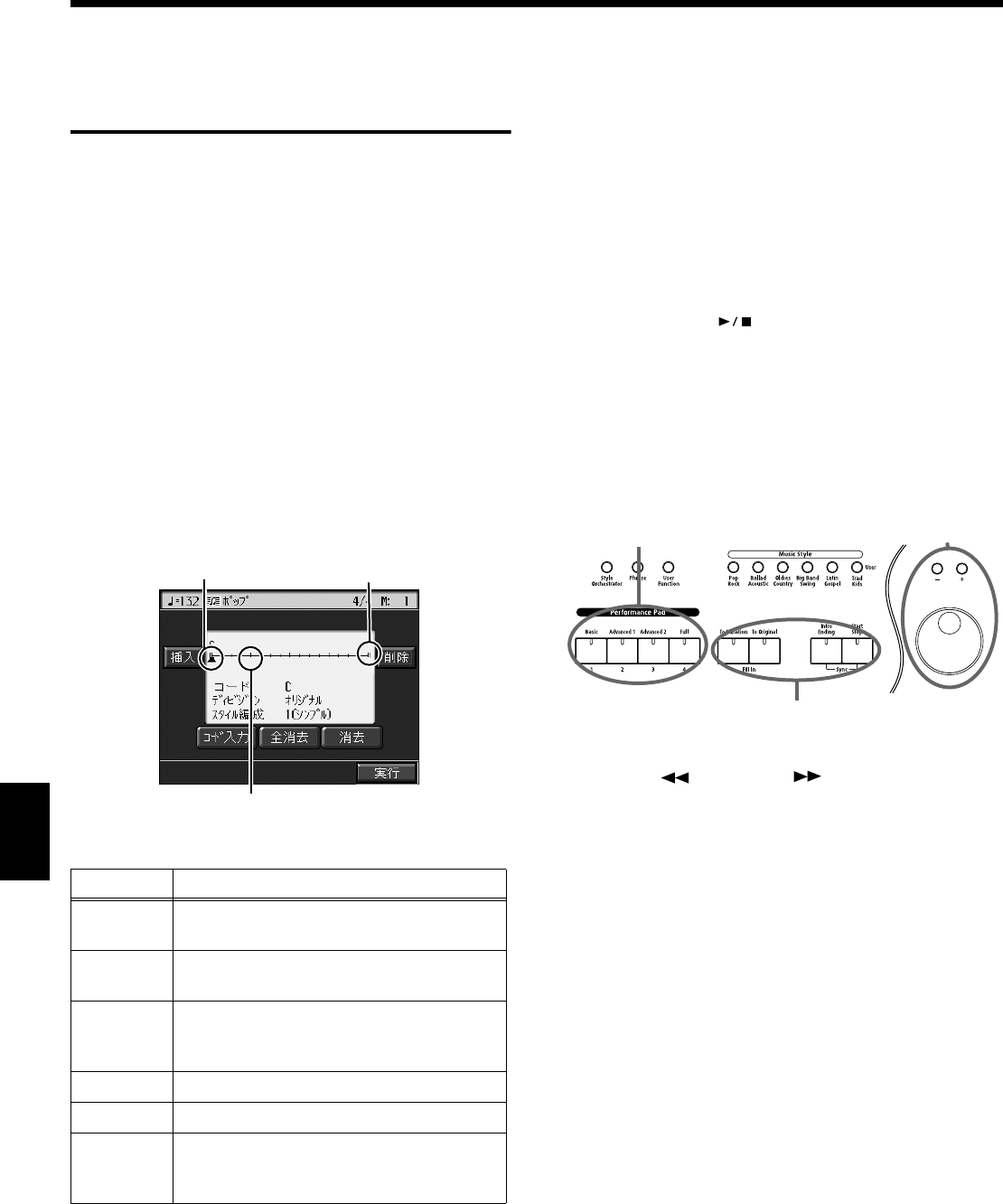
120
Chapter 7 Creating and Editing Songs
Chapter 7
Composing an
Accompaniment By Entering
Chords (Chord Sequencer)
You can enter a chord progression and choose the places
where the accompaniment pattern will change to create an
accompaniment for a song. This feature is called “Chord
Sequencer.”
Thanks to the chord sequencer, you can create an
accompaniment ahead of time and play along with your
right hand.
1. Press the [Menu] button and watch the indicator light
up.
The Menu screen appears.
2. Touch <Chord Sequencer>.
The screen like the one shown below is called “Chord
Sequencer screen.”
fig.d-chordseq.eps_50
3. Press a Music Style button or the touch screen to select
a Music Style (p. 50).
4. Press the [Exit] button.
You are returned to the Chord Sequencer screen.
5. Enter the chord progression and the accompaniment
pattern.
Refer to “Inputting Chords with the Chord Sequencer.”
6. When you have finished inputting all the data, touch
<Execute>.
The accompaniment you’ve composed is registered at “0:
New Song.”
When storage of the data is complete, return to the Menu
screen.
Now, press the [ (Play/Stop)] button, and try
playing the melody along with the accompaniment you
created.
* Songs you’ve created are discarded as soon as you turn off the
power. If you do not want to delete the song, save it to a floppy
disk or to user memory. Refer to “Saving Songs” (p. 101).
Inputting Chords with the Chord Sequencer
1. Use the dial to move the cursor to the input position.
Use the [ (Bwd)] and [ (Fwd)] buttons to move
the cursor one measure at a time.
2. Enter the chord progression and the changes in the
accompaniment pattern and arrangement.
Just as when performing with Automatic
Accompaniment, press the keys to specify a chord, and
press a button to select the accompaniment pattern (p.
57). You can change the Style Orchestrator with the
Performance Pads (p. 58).
3. Touch <Ins> once to insert one measure before the
measure where the cursor is currently positioned.
If you touch <Del>, the measure where the cursor is
currently positioned is deleted, while the measures that
follow are moved forward.
To remove what you have input, move the cursor to the
position with input you want to delete, then touch
<Clear>. This deletes the entered setting.
→You can only insert an intro at the beginning of a song. When
you add an intro, the number of bars corresponding to the
length of the intro is inserted automatically.
Display Explanation
Ins One measure is inserted before the measure
where the cursor is positioned.
Del The measure in which the cursor is
positioned is deleted.
Chords
Allows input of chords without playing the
keyboard. Refer to “Inputting Chords
without Playing the Keyboard” (p. 121).
All Clear Deletes all of the data that’s been input.
Clear Deletes the data at the cursor position.
Execute
Records the input chord progression.
Touch this icon when you have finished
inputting all of the chords.
This is the end of the song. When
continuing to add input, insert
measures by touching <Ins>.
This is the “cursor.” The cursor
shows where the chord change
or other information is input.
This indicates the position where the
accompaniment pattern (Division) or
the Style Orchestrator changes.
Change the accompaniment arrangements Move the cursor
Select the accompaniment pattern (Division)
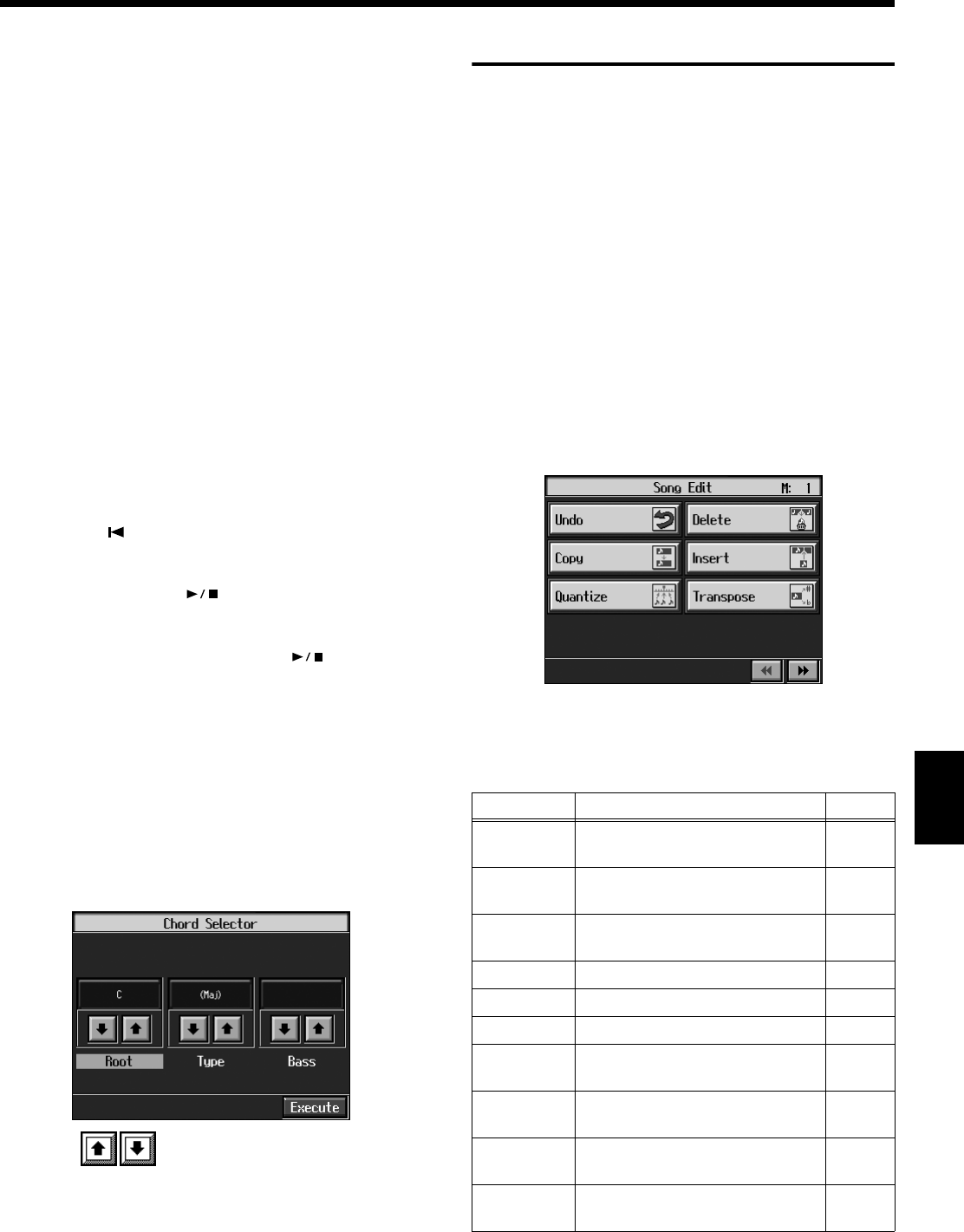
121
Chapter 7 Creating and Editing Songs
Chapter 7
Functions That Can Be Assigned to the Pedals
and the Performance Pads
→For instructions on assigning functions, refer to “Assigning
Functions to Pedals and Performance Pads (Pedal Setting/
User Functions)” (p. 142).
• Inputting a short Intro and Ending
Assign “Intro 2/Ending 2" to a pedal or pad.
• Inputting a “Variation” or “Original” without a Fill-In
Assign “Original/Variation” to a pedal or pad.
• Using the keyboard to input slash chords (such as Fm/C)
Assign “Leading Bass” to a pedal or pad.
• Inputting a break somewhere within the song
Assign “Break” to a pedal or pad.
• Insert half fill-ins (fill-ins lasting half a measure)
Assign “Half Fill In” to a pedal or pad.
Check the accompaniment you inserted
Here’s how to play back as much of the accompaniment as
you have input.
1. Press the [ (Reset)] button to return to the
beginning of the song.
2. When you press the [ (Play/Stop)] button, the
performance is played back.
3. Playback stops when you press the [ (Play/Stop)]
button once more.
■Inputting Chords without
Playing the Keyboard
You can use <Chords> at the bottom right of the Chord
Sequencer screen to specify chords on the screen.
1. At the Chord Sequencer screen, touch <Chords>.
A screen like the one shown below appears.
fig.d-chordinput.eps_50
2. Touch in each to specify the chords.
3. Touch <Execute> to enter the chord.
You are returned to the Chord Sequencer screen.
Editing Songs
There are many ways you can edit performances recorded
using the KR Track button or 16-track sequencer.
■Basic Operation of the Editing
Functions
* While songs are being loaded, the measure number in the
upper right of the screen is highlighted (text and background
are inverted). Start editing the song only after the measure
number is no longer highlighted.
Selecting the editing function
1.
Press the [Menu] button and watch the indicator light up.
The Menu screen appears.
2. Touch <Song Edit>.
A “Song Edit screen” like the following appears.
fig.d-edit1.eps_50
3. Touch an editing function to select that function.
For more detailed information, refer to the
corresponding page for each function.
Function Explanation Page
Undo Undoes editing operations that
have been performed. p. 122
Copy Copies measures and internal
rhythm patterns.
p. 122,
p. 137
Quantize Evens out sounds in recorded
performances. p. 123
Delete Deletes measures. p. 123
Insert Inserts a blank measure. p. 124
Transpose Transposes parts individually. p. 124
Erase Erases data in measures, creating
blank measures. p. 125
Part
Exchange Exchanges the sounds in parts. p. 125
Note Edit Allows corrections to be made
note by note. p. 126
PC Edit Allows editing of the Tones
changes that occur during a song. p. 126
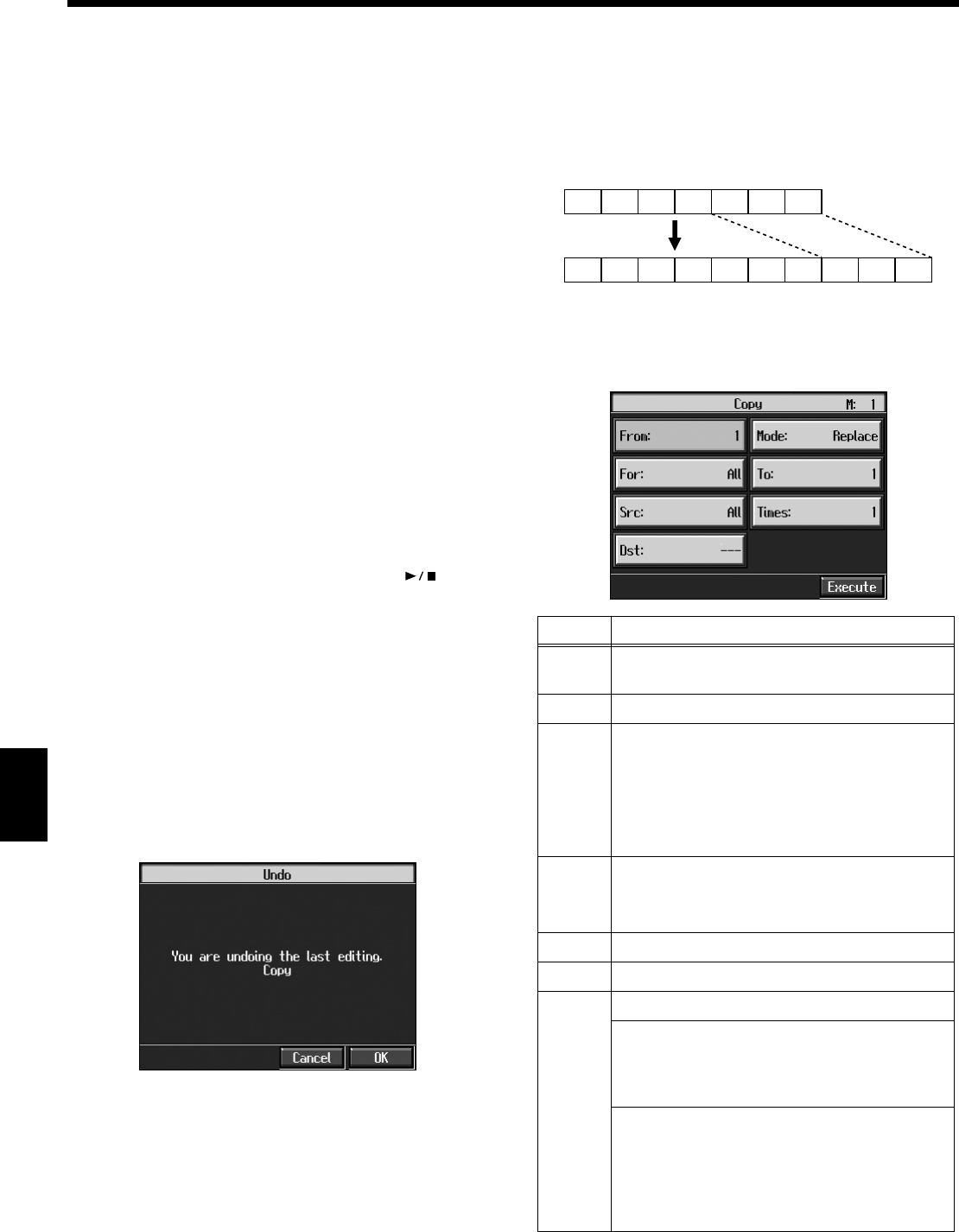
122
Chapter 7 Creating and Editing Songs
Chapter 7
→”PC” stands for “Program Change,” which is a command that
tells an instrument to change the sound it’s using. With songs
that rely on the use of a variety of sounds, a “PC” needs to be
located at every point within the song where the Tone is to be
changed
* Some edits can’t be undone, not even by choosing “Undo.” We
recommend saving songs to floppy disks or to user memory before
editing. For more on how to save songs, refer to “Saving Songs”
(p. 101).
Editing
4. Touch the item to be edited.
The background of the item being set turns orange.
5. Set the value with the [-] [+] buttons or the dial.
To cancel the operation once it is underway, press the
[Exit] button.
6. When you’re done making all the settings, touch
<Execute>.
When you are finished editing the setting, return to the
“Song Edit screen.”
Press the [Exit] button to return to the Menu screen.
→You can play back edited songs by pressing the [ (Play/
Stop)] button in the “Song Edit screen.”
■Undoing Edits (Undo)
You can cancel an editing operation that you’ve just carried
out. This is handy when you want to undo an edit and
restore data to the way it was before.
* There are some edits that can’t be restored.
At Step 3 of “Selecting the editing function” (p. 121), select
<Undo>.
Editing functions that can be undone appear on screen.
fig.d-e-undo.eps_50
If you touch <Cancel>, the undo is cancelled, and you’re
returned to the Song Edit screen.
If you touch <OK>, the confirmation message appears on
screen. Touch <OK> to undone the most recent edit.
■Copying Measures (Copy)
You can copy a portion of a performance to a different bar in
the same Part or to a measure in another Part. This is handy
when you’re composing a song that repeats a similar phrase.
fig.e-copy.e
At Step 3 of “Selecting the editing function” (p. 121), select
<Copy>.
A screen like the one shown below appears.
fig.d-e-copy.eps_50
Item Content
From Measure number of the first measure of the
segment to be copied
For Number of measures to be copied
Src
Copy-source Track button or part number
Choosing “All” copies all Parts. “- - -” appears
in the <Dst> column.
If you choose a Track button, you can only copy
to the selected Track button. You cannot copy
to the other Track buttons.
To
Copy-destination measure number
When “End” is selected, the data is copied to
the end of the song.
Times Number of times the data is to be copied
Dst Copy-destination part number
Mode
Data can be copied in the following three ways:
Replace
If there is a performance recorded at the copy
destination, this previous recording is erased,
and the copied data is written in its place.
Mix
If there is a performance recorded at the copy
destination, the copied data is layered over the
previous recording. If the Tones used for the
copy source and copy destination are different,
the copy-destination Tone is used.
1234567
12345678910
Ex. To copy measures 5-7 to measure 8.
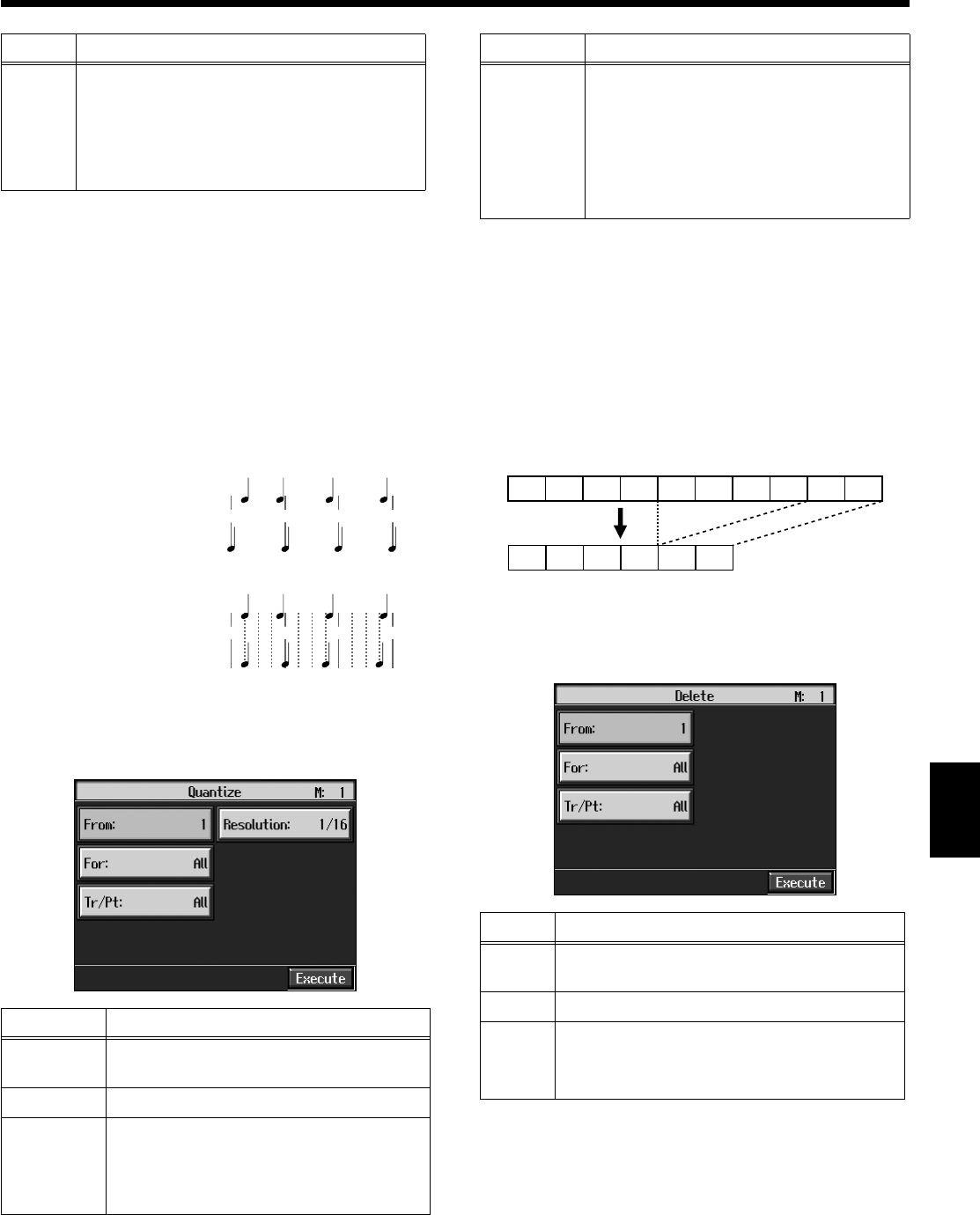
123
Chapter 7 Creating and Editing Songs
Chapter 7
■Correcting Timing
Discrepancies (Quantize)
You can correct for timing discrepancies in a recorded
performance by automatically aligning the music with the
timing you specify. This is called “Quantizing.”
As an example, let’s say that the timing of some quarter-
notes in a performance is a little off. In this case, you can
quantize the performance with quarter-note timing, thus
making the timing accurate.
fig.e-quantize.e
At Step 3 of “Selecting the editing function” (p. 121), select
<Quantize>.
A screen like the one shown below appears.
fig.d-e-quant.eps_50
When finished with the Quantize settings, return to the Song
Edit screen.
■Deleting Measures (Delete)
You can delete a part of a performance measure by measure.
When a portion of a performance is deleted, the rest of the
performance is shifted up to fill the gap. Erasing measures in
a specified passage is called “deleting.”
fig.e_delete.e
At Step 3 of “Selecting the editing function” (p. 121), select
<Delete>.
A screen like the one shown below appears.
fig.d-e-del.eps_50
Mode
Insert
If there is a performance recorded at the copy
destination, the copied portion is inserted
without erasing the previous recording. The
song is lengthened by the number of inserted
measures.
Item Content
From Measure number of the first measure of the
segment to be quantized
For Number of measures to be quantized
Tr/Pt
Track button or part number to be
quantized
Choosing “All” quantizes the same passage
in all Parts.
Item Content
1 2 3 4
1 2 3 4
Example: Quarter-note resolution
Example: Sixteenth-note resolution
Actual note data
Note data after quantization
Actual note data
Note data after quantization
Resolution
Quantization timing
Select one of the following values
1/2 (half note), 1/4 (quarter note),
1/6 (quarter-note triplet), 1/8 (eighth note),
1/12 (eighth-note triplet), 1/16 (sixteenth
note), 1/24 (sixteenth-note triplet),
1/32 (thirty-second note)
Item Content
From Measure number of the first measure of the
segment to be deleted
For Number of measures to be deleted
Tr/Pt
Track button or part number to be deleted
When “All” is selected, the same portion of all
parts is deleted.
Item Content
12345678910
123456
Ex. To delete measures (bars) 5-8
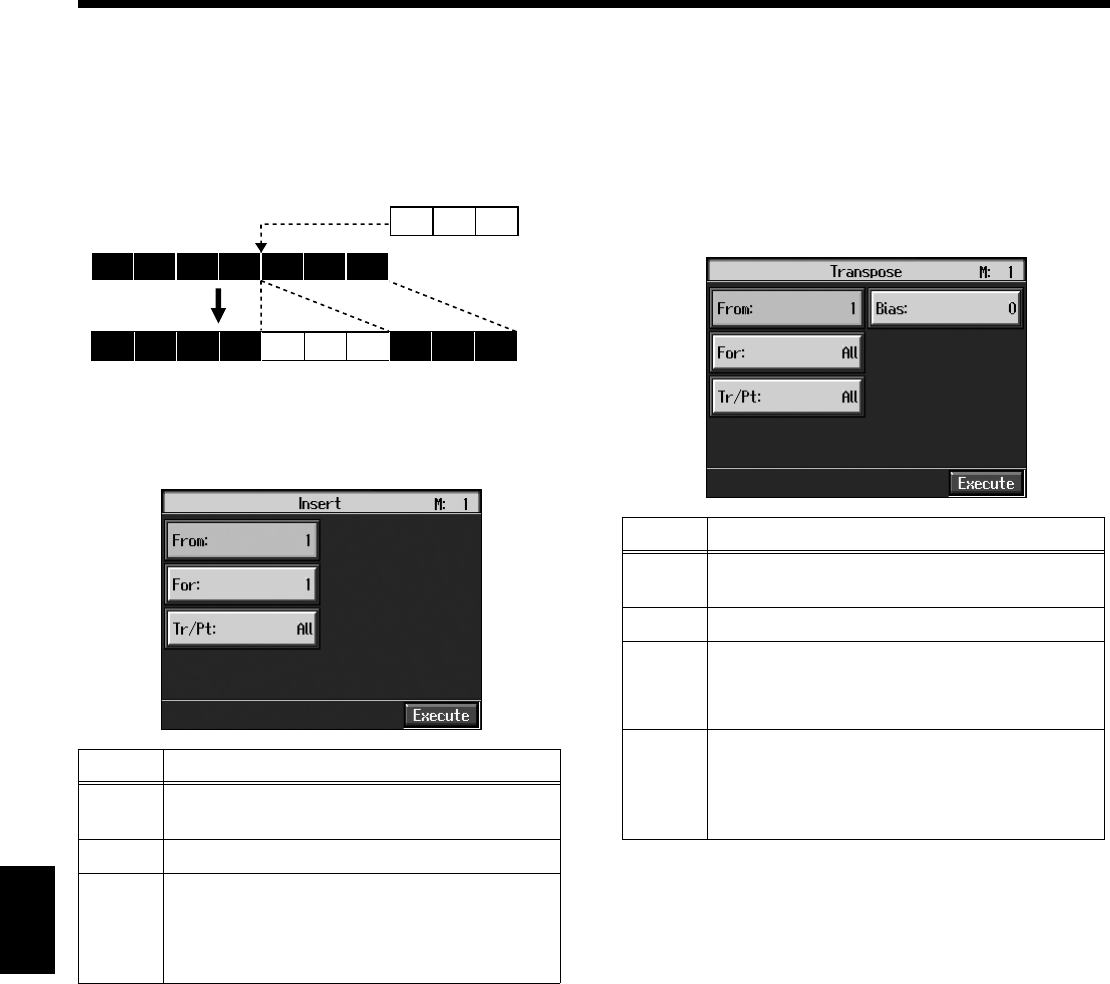
124
Chapter 7 Creating and Editing Songs
Chapter 7
■Inserting Blank Measures
(Insert)
You can add a blank measure at a location you specify. This
addition of a blank measure is called “insertion.”
fig.e_insert.e
At Step 3 of “Selecting the editing function” (p. 121), select
<Insert>.
A screen like the one shown below appears.
fig.d-e-ins.eps_50
■Transposing Individual Parts
(Transpose)
You can transpose specified parts and tracks individually.
At Step 3 of “Selecting the editing function” (p. 121), select
<Transpose>.
A screen like the one shown below appears.
fig.d-e-trans.eps_50
* You cannot transpose performances of the drum sets and
sound effect sets (such as the Rhythm Track).
Item Content
From Measure number of the first measure of the
segment to be inserted
For Number of measures to be inserted
Tr/Pt
Track button or part number where data will be
inserted
When “All” is selected, blank measures are
inserted at the same place in all parts.
1234567
Ex. To insert measures (bars) 5-7
12345678 9 10
Item Content
From Measure number of the first measure of the
segment to be transposed
For Number of measures to be transposed
Tr/Pt
Track button or part number to be transposed
When “All” is selected, the same portion of all
parts is transposed.
Bias
The range of transposition
You can select the range to transpose the data,
from -24 (two octaves down) to +24 (two
octaves up), adjustable in semitones.
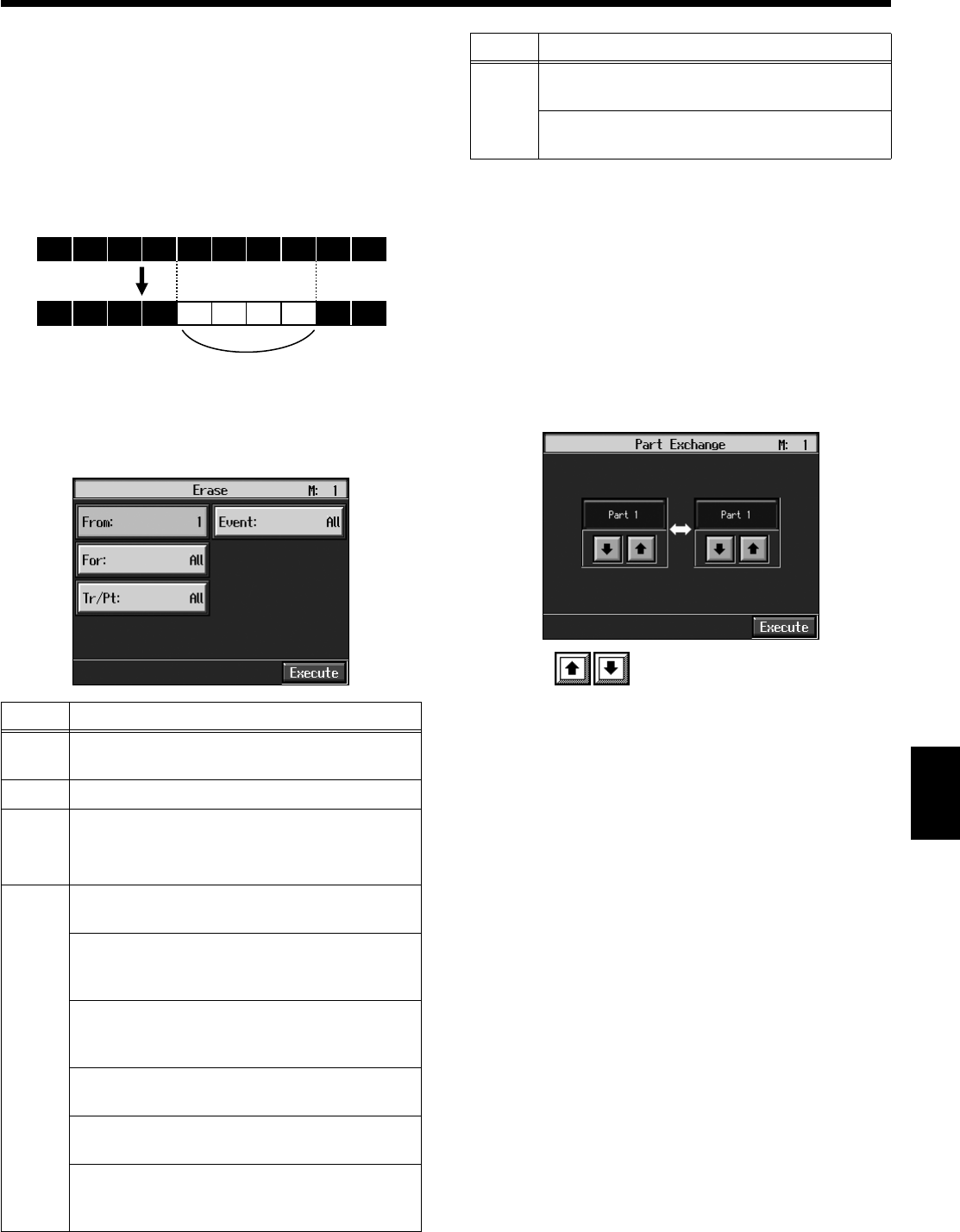
125
Chapter 7 Creating and Editing Songs
Chapter 7
■Making Measures Blank
(Erase)
You can delete the performance data in a specified block of
measures, turning them into blank measures without
reducing the length of the song. This process is called
“erasing.”
fig.e_erase.e
Follow the steps in “Selecting the editing function” (p. 121) to
choose <Erase>.
A screen like the one shown below appears.
fig.d-e-erase.eps_50
■Exchanging Parts
(Part Exchange)
You can exchange the notes recorded for a particular part
with the notes recorded for another part. This process of
exchanging parts is called “part exchange.”
At Step 3 of “Selecting the editing function” (p. 121), select
<Part Exchange>.
A screen like the one shown below appears.
fig.d-e-partex.eps_50
Touch each to choose Parts you want to
exchange.
Item Content
From Measure number of the first measure of the
segment to be erased
For Number of measures to be erased
Tr/Pt
Track button or part number to be erased
When “All” is selected, the same portion of all
parts is erased.
Event
Select from the following types of performance
data to erase:
All
All performance data, including notes, tempos,
tones switches, volume changes, etc., are erased.
Tempo
Tempo data is erased. Erasing the tempo data for
all measures results in a single, constant tempo.
Prog.Change
Erases the data for switching Tones (p. 122).
Note
Erases only notes.
Except Notes
Erases all of the performance data except for the
notes.
12345678910
123456789 10
Blank measures
Ex. To erase measures (bars) 5-8
Event
Expression
Erases Expression (volume change) information.
Lyric
Erases only lyrics.
Item Content
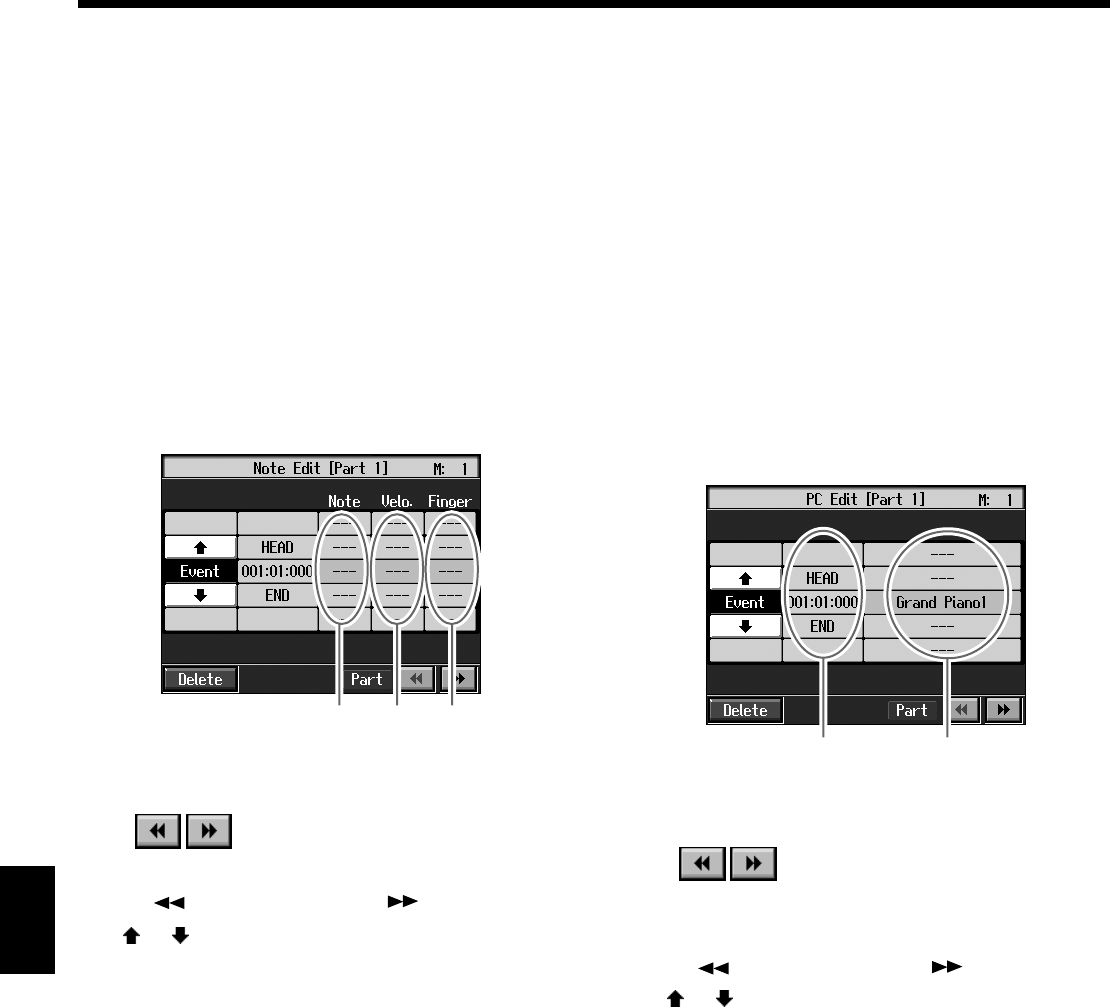
126
Chapter 7 Creating and Editing Songs
Chapter 7
■Correcting Notes One by One
(Note Edit)
You can make corrections in a recorded performance one
note at a time. This process of making changes in individual
notes is called “note editing.”
You can make these corrections by using note editing:
• Deleting misplayed notes
• Changing the scale of a single note
• Changing the force used in playing a single key (velocity)
• Change the fingering
At Step 3 of “Selecting the editing function” (p. 121), select
<Note Edit>.
A screen like the one shown below appears.
fig.e-note.e
The note-location display uses “Measure: Beat: Tick” as the
format. A tick is a unit of time that’s shorter than a beat.
Touch to select the part with the note to be
corrected. The Part number appears at the top of the screen.
Use the [ (Bwd)] button and the [ (Fwd)] button or
use < > < > in the upper part of the screen to find the
note to be corrected.
When you’ve found the note you want to correct, touch
“Pitch” or “Velocity” for the note.
Use the [-] [+] buttons and the dial to correct the pitch or
velocity. If you want to delete the note, touch <Delete>.
When you’re done making all the settings, press the [Exit]
button.
Return to the Song Edit screen.
■Modifying the Tone Changes in
a Song (PC Edit)
In some songs, the instrument sound changes during the
course of the song (that is, the Tone changes in the middle of
a Part). In such songs, an instruction to switch the Tone is
inserted at the place where you want the sound to change.
This instruction is called a “Program Change” (PC), and
actions such as deleting program changes, or changing the
selected Tone by them are called “PC editing.”
* It is not possible to insert a program change into a measure or
beat that does not contain a program change.
At Step 3 of “Selecting the editing function” (p. 121), select
<PC Edit>.
A screen like the one shown below appears.
fig.d-e-pc.eps_50
The PC-location display uses “Measure: Beat: Tick” as the
format. A tick is a unit of time that’s shorter than a beat.
Touch to select the part with the program
change to be edited.
The Part number appears at the top of the screen.
Use the [ (Bwd)] button and the [ (Fwd)] button or
use < > < > in the upper part of the screen to find the
program change to be edited.
When you’ve found the Program Change you want to
modify, touch “Tone Name” on the screen.
Press a Tone button to select a Tone group, then select a Tone
with the [-] [+] buttons and the dial. When selecting Part 10
or 11, select the drum set or effect sound.
If you want to delete the Program Change, touch <Delete>.
When you’re done making all the settings, press the [Exit]
button.
Location Pitch Velocity
Location Tone name
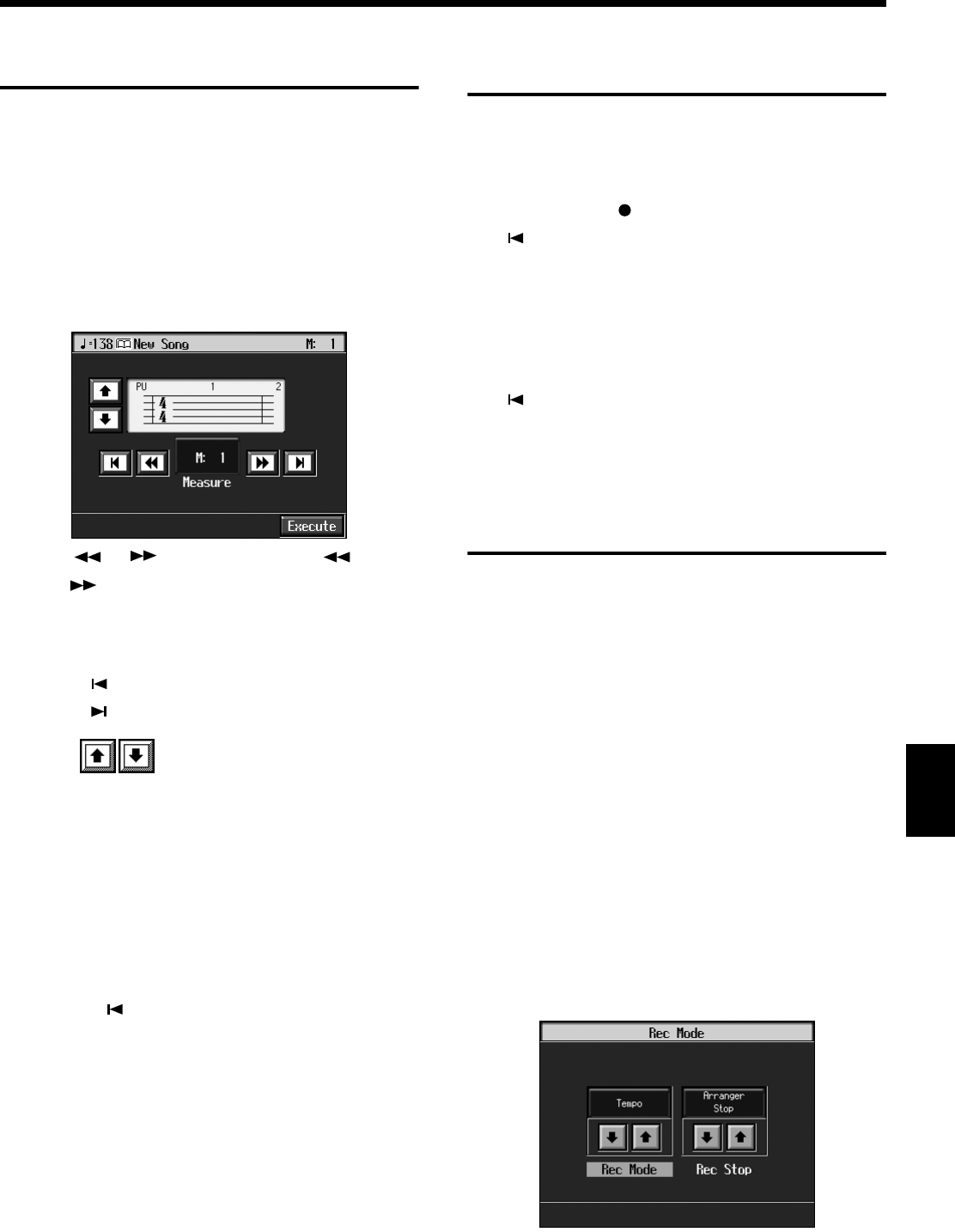
127
Chapter 7 Creating and Editing Songs
Chapter 7
Changing the Beat in the Middle
of a Song (Beat Map)
You can create songs that have beat changes during the
course of the song.
* You can’t change a song’s beat once it’s been recorded. Before
recording the performance, determine the beat to be used.
1. Press the [Menu] button.
The Menu screen appears.
2. Touch <Beat Map>.
A screen like the one shown below appears.
fig.d-beatmap.eps_50
3. Use < >< > in the screen or the [ (Bwd)]
and [ (Fwd)] buttons to move to the measure
whose beat you want to change.
The measure number appears in the top-right area of the
screen.
Touch < > to move to the beginning of the song.
Touch < > to move to the end of the song.
4. Touch in each to set the beat.
5. Touch <Execute>.
The beat change starts with the measure you selected.
Repeat Steps 3–5 to make beat settings in other measures
as needed.
Recording the performance
6. Press the [Exit] button twice.
The screen displayed before you pressed the [Menu]
button appears.
7. Press the [ (Reset)] button to return the measure
number to “1.”
8. Start a recording.
Record the performance using the procedures described
in “Chapter 5 Recording and Saving the Performance”
(p. 89). Specify the measure, then change the beat.
Changing the Tempo of
Recorded Songs
You can change the basic tempo of a composition. The basic
tempo was initially set when the song was recorded.
1. Press the Tempo [-] and [+] buttons to choose a tempo.
2. Hold down the [ (Rec)] button and press the
[ (Reset)] button.
The song’s basic tempo changes.
The change in basic tempo is discarded when you turn
off the power or choose a different song. Save important
song data to floppy disks or to user memory (p. 101).
* If the song you’re working on has tempo changes, press the
[ (Reset)] button to go back to the beginning of the song
before you carry out this operation.
Changing the Tempo Within
the Song
You can add tempo changes to a recorded composition.
The KR stores song tempo information and performance data
separately. Therefore, when making changes to the tempo in
a song, you must record the changes in the tempo
information independently of the performance data.
This recording of the tempo is called “Tempo Recording.”
■Adjusting the Tempo While
Listening to a Song
You can add ritardando and other such gradual tempo
changes.
Setting the Rec Mode to “Tempo”
1. Press the [Menu] button.
The Menu screen appears.
2. Touch <Rec Mode>.
A screen like the one shown below appears.
fig.d-rec-tempo.eps_50
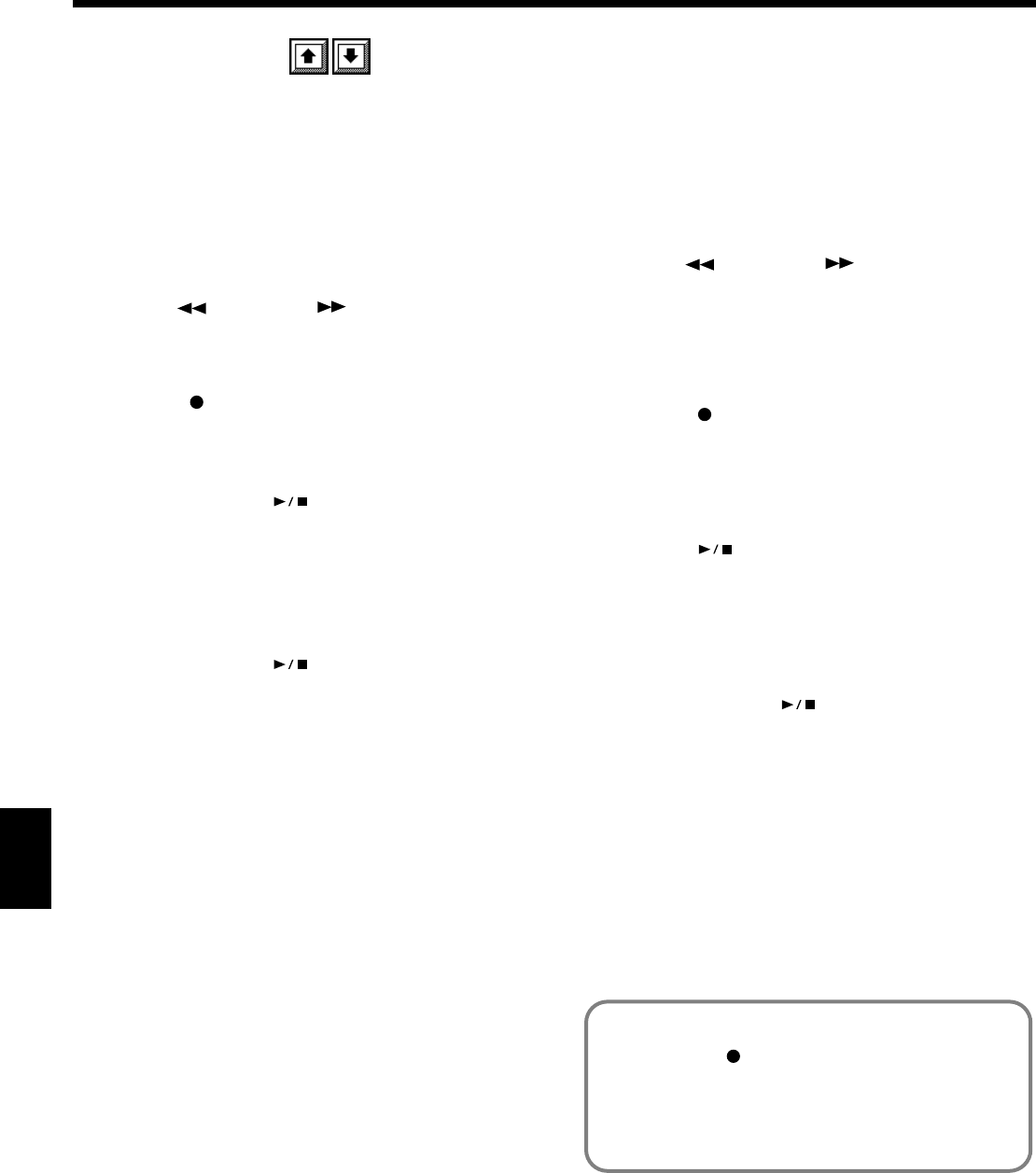
128
Chapter 7 Creating and Editing Songs
Chapter 7
3. Touch the <Rec Mode> to select <Tempo>.
This makes the setting for tempo recording.
Press the [Exit] button a number of times to switch to the
screen where the measure number is indicated in the
upper right of the screen.
When the KR goes into Tempo Recording, the tempo
indication is highlighted.
Recording the Tempo
4. Use the [ (Bwd)] and [ (Fwd)] buttons to
move slightly before the measure where you want to
change the tempo.
5. Press the [ (Rec)] button and watch the indicator is
flashing.
The KR is put in recording standby.
6. When you press the [ (Play/Stop)] button,
recording begins.
7. When you get to the place where you want to change
the tempo, use the Tempo [-] and [+] buttons or the dial
to vary the tempo as desired.
8. When you press the [ (Play/Stop)] button,
recording stops.
The song’s tempo changes.
* You cannot record performances while in Tempo Recording
mode. When you’re finished tempo recording, go back to the
ordinary Replace Recording. Take a look at “Changing the
Recording Method (Rec Mode)” (p. 116).
■Adjusting the Tempo at a
Particular Measure
You can create a tempo change at the beginning of a selected
measure. This is handy when you want to make a sudden
change in tempo.
First, carry out Steps 1–3 of “Changing the Tempo Within the
Song” (p. 127) to make the “Tempo Recording” settings.
1. Use the [ (Bwd)] and [ (Fwd)] buttons to
move to the measure where you want to change the
tempo.
The measure number appears in the top-right area of the
Basic screen.
2. Press the [ (Rec)] button and watch the indicator is
flashing.
The KR is put in recording standby.
3. Use the [-] [+] buttons or the dial to change the tempo.
4. Press the [ (Play/Stop)] button.
The song’s tempo changes starts with the measure you
selected.
→While tempo recording is being used to write tempo, the tempo
display in the screen will be highlighted.
5. When you press the [ (Play/Stop)] button, the
change in tempo stops.
* You cannot record performances while in Tempo Recording
mode. When you’re finished tempo recording, go back to the
ordinary Replace Recording. Take a look at “Changing the
Recording Method (Rec Mode)” (p. 116).
→If you want to restore the previous tempo, delete the tempo
data at the place where the tempo was recorded. For an
explanation of how to delete the information of tempo settings,
refer to “Making Measures Blank (Erase)” (p. 125).
Tempo Recording Shortcut
Hold down the [ (Rec)] button and press one of the
Tempo [-] [+] buttons to switch to the Tempo Recording
settings. Record tempo information. In this case, tempo
recording is canceled when recording ends.
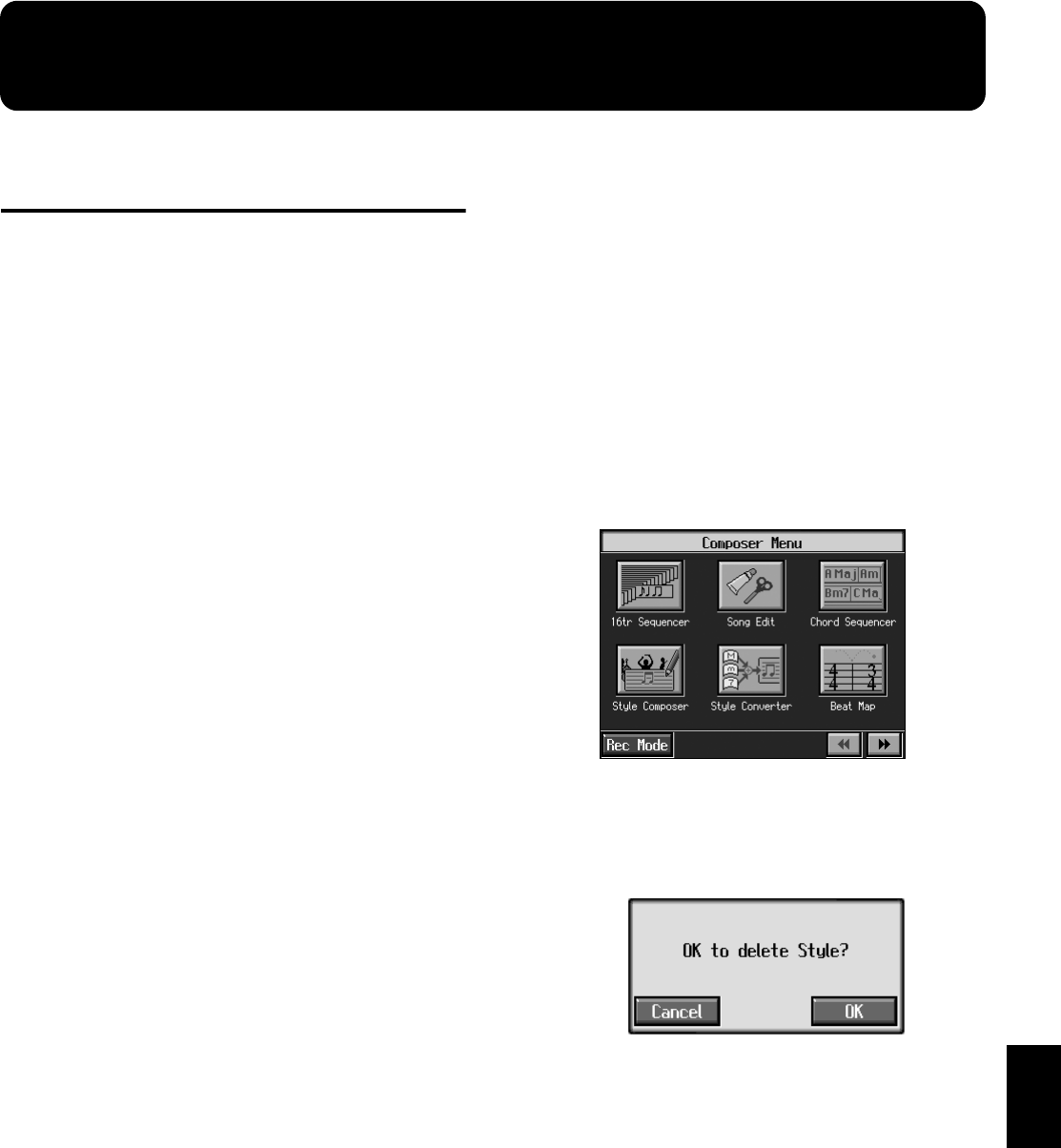
129
Chapter 8
Chapter 8 Creating Music Styles
Creating Original Styles
(User Styles)
Although the KR features a variety of internal Music Styles,
you can also create your own. These original Styles are called
“User Styles.”
You can use either of the two methods described below to
create a User Style.
Style Composer
With this method, you combine internal Music Styles to
create new Styles. You can create a new Style by selecting
from among the Rhythm, Bass, Accompaniment 1,
Accompaniment 2, Accompaniment 3, Accompaniment 4,
Accompaniment 5, and Accompaniment 6 parts in different
styles.
Style Converter (p. 131)
Create a new Style by extracting the portions you need from
songs composed with the 16-track sequencer.
When you’re composing a song, there’s no need to specify all
the chords. You can specify just some of the chords, and the
KR automatically chooses the other chords and arranges the
Style.
Style Converter features an “Auto mode” that allows you to
easily create Styles from songs with a single chord, and a
“Manual mode,” in which you create Styles from songs with
three kinds of chords–major, minor, and seventh chords.
■Creating New Styles by
Combining Internal Music
Styles (Style Composer)
You can create a new style by selecting from among the
Rhythm, Bass, Accompaniment 1, Accompaniment 2,
Accompaniment 3, Accompaniment 4, Accompaniment
5,and Accompaniment 6 parts in different Styles. This
function is called the “Style Composer.”
* You can only combine the KR’s built-in Styles.
Displaying the Style Composer Screen
1. Press the [Menu] button.
The Menu screen appears.
fig.d-menu1.eps_50
2. Touch <Style Composer>.
* If a User Style has already been recorded, a message like the
one shown below appears.
fig.m-styledel.eps
Touch <Cancel> to return to the Menu screen. Save User
Styles to floppy disks, or to user memory (p. 134).
When you touch <OK>, the previously recorded User Style is
deleted, and a new User Style is created.
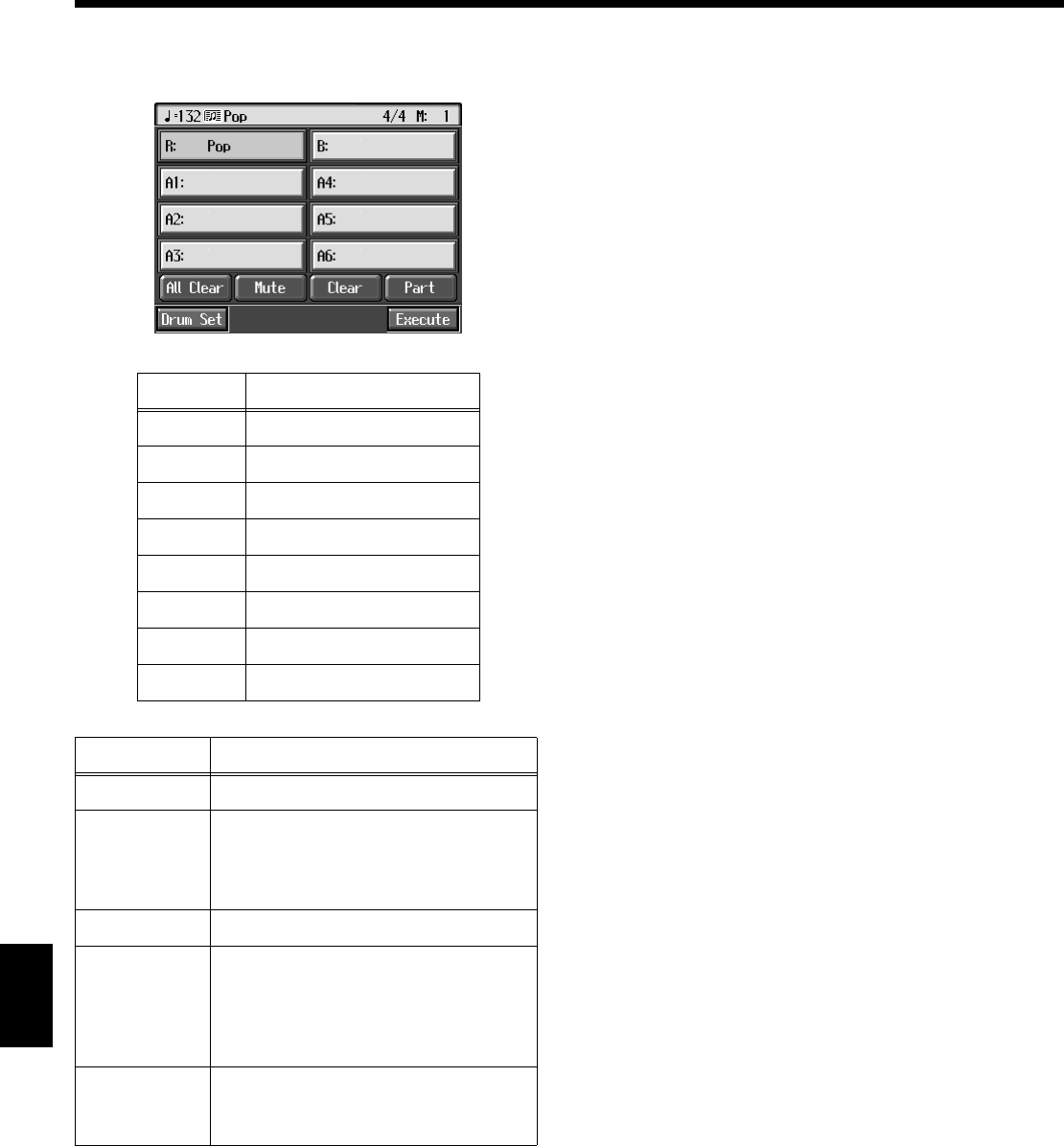
130
Chapter 8 Creating Music Styles
Chapter 8
A “Style Composer screen” like the one shown below
appears.
fig.d-stylecomp.eps_50
Selecting the Styles assigned to each part
3. Touch the part to be set.
The button for the touched part being set turns orange.
4. Press an Music Style button, then select a Style with
the touch screen or the [-]/[+] buttons and the dial.
When you have decided on a Style, press the [Exit]
button to display the Style Composer screen.
5. Repeat steps 3 and 4 to determine the Styles for each
Part.
Deciding on a Style
6. Touch <Execute>.
You have created a new Style.
The User Style is recorded to the Music Style [User]
button. Try playing with the new Style.
* If you turn off the power or record a new User Style, any User
Style you’ve previously recorded is lost. If you do not want to
delete the Style, save it to a floppy disk or to user memory.
Take a look at “Saving a User Style” (p. 134).
❍Muting Parts for a particular division
You can mute the sound of particular Parts in specific
Divisions.
For example, all parts are played when you use a “Variation”
accompaniment pattern, whereas if you select the “Original”
accompaniment pattern, every part other than
“Accompaniment 1" is muted. With this arrangement, when
the accompaniment pattern changes from the original to the
variation, it creates a more elaborate effect in the
accompaniment.
→For more on Divisions, refer to the “Style Arrangements” (p.
131).
1. Touch the Style Composer screen to choose the Part
you want to mute out.
2. Press the Fill In [To Variation] or [To Original] button
to switch to the division that you want to mute.
3. Touch <Mute> on the screen.
The Part you chose is only muted out in the Division you
selected.
If you want to hear the muted-out Part, touch <Mute>
again.
* To mute out a Division that changes after a few seconds (intro,
ending, or fill-in), touch <Mute> immediately after switching
to the Division.
Display Part
RRhythm
BBass
A1 Accompaniment 1
A2 Accompaniment 2
A3 Accompaniment 3
A4 Accompaniment 4
A5 Accompaniment 5
A6 Accompaniment 6
Icon Function
All Clear Deletes all of the settings.
Mute
You can mute the sound of particular
Parts in specific Divisions. For more
information, take a look at “Muting
Parts for a particular division” (p. 130).
Clear Deletes the Styles in selected parts.
Options
The Part Settings screen is displayed,
allowing you to make detailed settings
to each part. For more information, take
a look at “Editing the volume and effect
settings for each Part” (p. 131).
Execute
Records the created Style to the Music
Style [User] button. Touch this when
you have finished creating the Style.
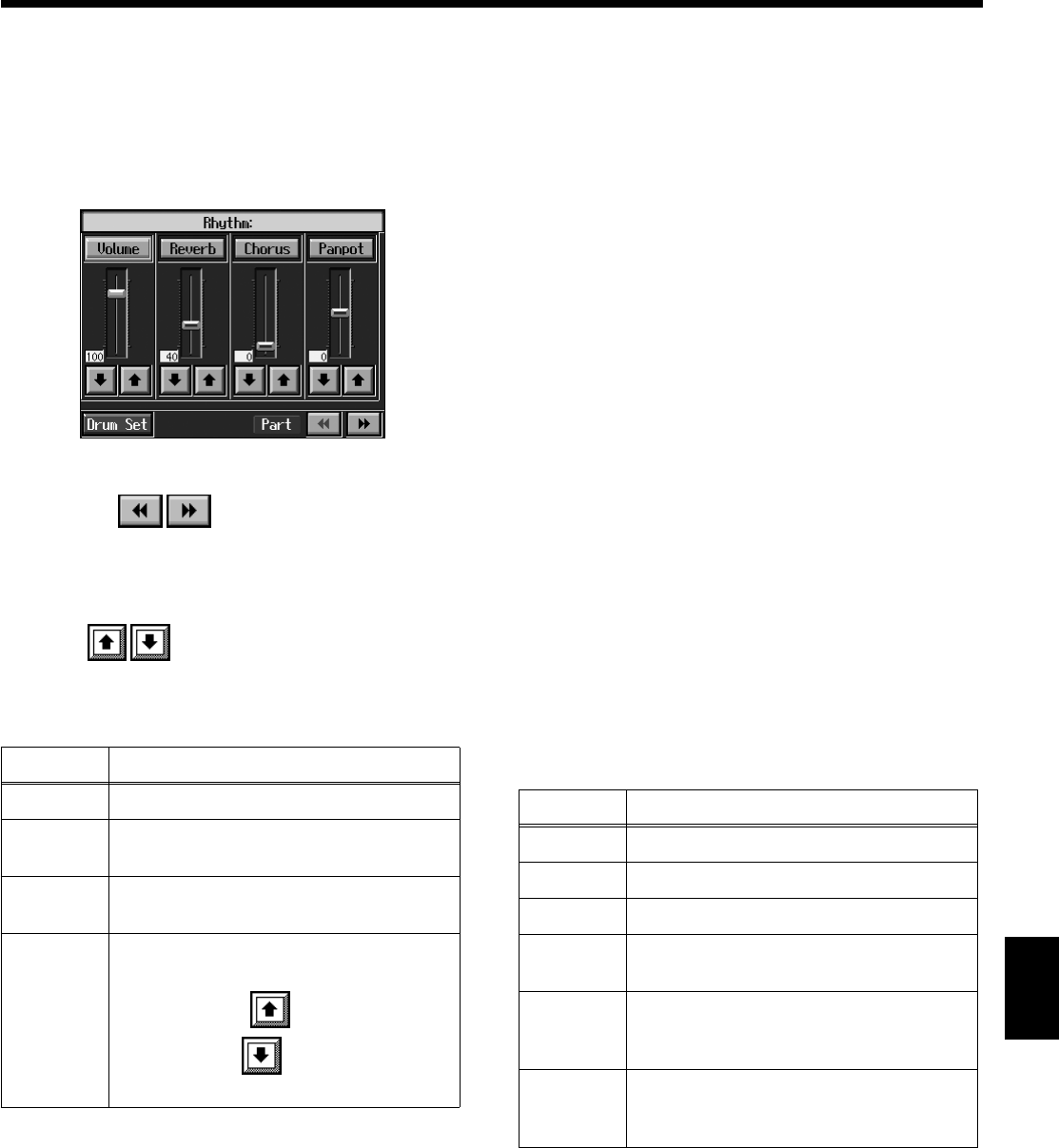
131
Chapter 8 Creating Music Styles
Chapter 8
❍Editing the volume and effect settings for
each Part
Displaying the Part settings screen
1. At the Style Composer screen, touch <Part>.
A screen like the one shown below appears.
fig.d-scomp-part.eps_50
Modifying the settings of each part
2. Touch the to select the part with the
settings to be changed.
The part name and Tone name are indicated in the upper
part of the screen.
3. Touch for each parameter to change the value.
You can also change the values by touching each
parameter name and then using the dial.
You can change the Tone for the selected Part by
pressing a Tone button to change the Tone while this
screen is displayed. When selecting Rhythm Part, you
can touch <Drum Set> to select the drum set or effect
sound.
Finishing the settings
4. Press the [Exit] button.
The Style Composer screen appears.
■Creating a Style from a Song
You Composed Yourself
(Style Converter)
You can take a song you’ve composed yourself and extract
the portions you need to create your own original Style.
When you’re composing a song, there’s no need to specify all
the chords. You can specify some of the chords, and the KR
automatically chooses the other chords and arranges the
style. This function is called the “Style Converter.”
Style Converter features an “Auto mode” that allows you to
easily create Styles from songs with a single chord, and a
“Manual mode,” in which you create Styles from songs with
three kinds of chords–major, minor, and seventh chords.
When creating a song in order to create an music style, it’s
good practice to consider the arrangement of the music style.
Style Arrangements
Music Styles created with the Style Converter function are
composed of eight parts: “Rhythm,”
“Bass,”“Accompaniment 1,“”Accompaniment 2,”
“Accompaniment 3,””Accompaniment 4,“”Accompaniment
5,” “Accompaniment 6.”
A song progresses in predictable a sequence, such as intro,
melody A, melody B, bridge and ending.
With the KR, such changes in songs are allocated to the
following six performance states. We call these six parts of a
song “Divisions.”
You can make a song more lively or more restrained by
increasing or reducing played parts by Divisions. You can
also modify a song by changing the Tone of the parts in the
Divisions.
Display Explanation
Volume Adjusts the volume.
Reverb Adjusts the amount of reverb effect applied
to the sound.
Chorus Adjusts the amount of chorus effect applied
to the sound.
Panpot
Changes the left-right direction from which
the sound appears to come.
When you touch , the sound moves to
the right; touch to move the sound to
the left.
Division Performance division
Intro The intro is played at the start of a song.
Ending This is played at the end of a song.
Original This is a basic accompaniment pattern.
Variation This is a developmental accompaniment
pattern. It is a variation on an Original.
Fill-In To
Variation
This is a one-measure phrase inserted at a
juncture where the mood changes. It is used
to make a song more lively.
Fill-In To
Original
This is a one-measure phrase inserted at a
juncture where the mood changes. It is used
to make a song more sedate.
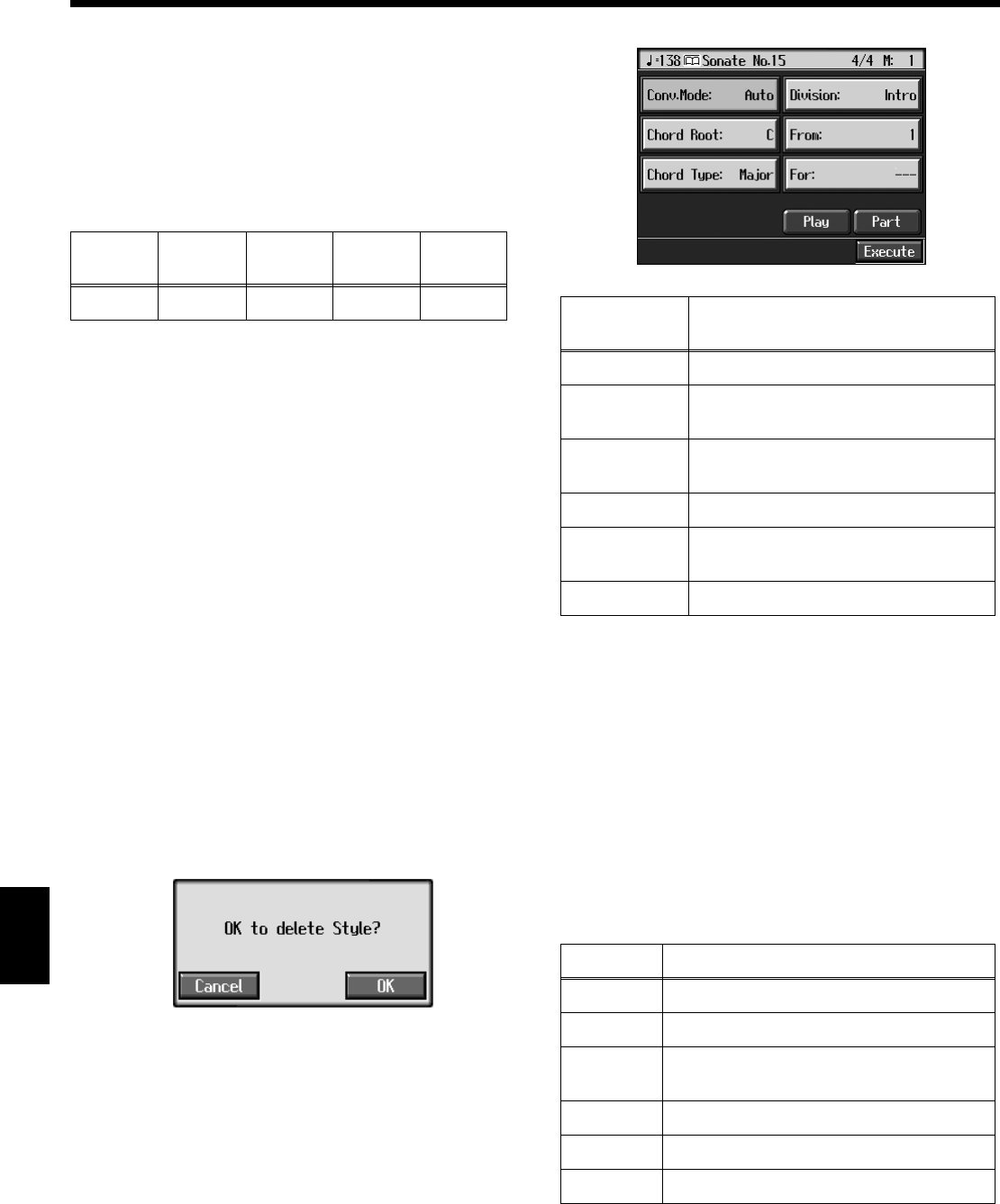
132
Chapter 8 Creating Music Styles
Chapter 8
❍Creating Styles in Auto Mode
Points to note when creating songs
• Use one of the major, minor, or diminished seventh
chords to create the song. We recommend using
diminished seventh chords to compose the song.
• It is convenient to record the sounds shown below for
the Parts of the 16-track sequencer.
→When using parts other than Part 2, 7, 8, 9, and D, refer to
“Changing an Extracted Part” (p. 133).
Creating songs
1. Use the 16-track sequencer to record the song.
Record the song after referring to “Multitrack Recording
with 16 Parts (16-Track Sequencer)” (p. 113) and other
related sections.
When using music data, first select a song (p. 64).
Displaying the Style Converter screen
2. Press the [Menu] button.
The Menu screen appears.
3. Touch <Style Converter>.
* If no song for use in creating a new Style is selected, the
message “Please select a song” appears. Use the [Select/Listen
to a Song] button to select a song (p. 64), then start the
procedure again.
* If a User Style has already been recorded, a message like the
one shown below appears.
fig.m-styledel.eps
Touch <Cancel> to return to the Menu screen. Please save the
User Style on a floppy disk or in the internal memory (p. 134).
When you touch <OK>, the previously recorded User Style is
deleted, and a new User Style is created.
A “Style Converter screen” like the one shown appears.
fig.d-styleconv.eps_50
Making the settings
4. Touch <Conv.Mode>, then use the [-] [+] buttons or the
dial to switch the mode to “Auto.”
This makes the setting for the Auto mode.
5. Touch <Chord Root> and <Chord Type>, then use the
dial to input the chord root and type for the segment to
be extracted.
6. Touch <Division>, then use the dial to select the
Division.
* Only one measure can be extracted when “Fill To Vari” or
“Fill To Ori” is selected for the Division. The number of
measures may also be limited in other Divisions.
Rhythm Bass Accomp
1
Accomp
2
Accomp
3
D (10) 2 7 8 9 Parameter
Name
Settings Content
Conv.Mode Switches the mode (Auto/Manual)
Chord Root Chord root for the segment to be
extracted
Chord Type Chord type for the segment to be
extracted (major/minor/seventh)
Division Division
From Measure number of the first measure of
the segment to be extracted
For Number of measures extracted
Display Performance division
Intro Intro
Original Original accompaniment pattern
Fill To
Vari From the fill-in to the variation
Variation Variation accompaniment pattern
Fill To Ori From the fill-in to the original
Ending Ending
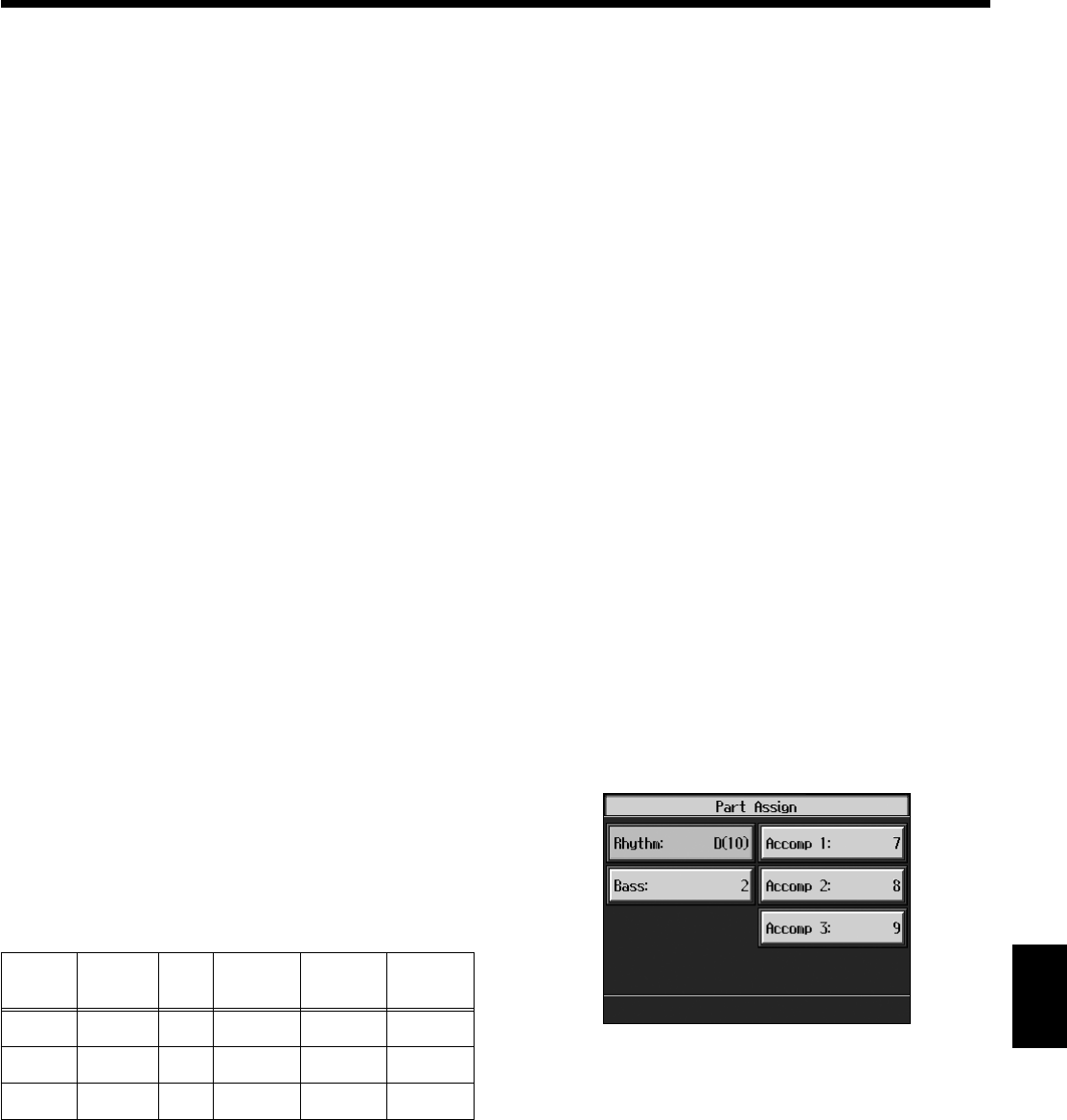
133
Chapter 8 Creating Music Styles
Chapter 8
7. Touch <From> and <For>, then use the [-] [+] buttons or
the dial to select the measures to be extracted.
Touching <Play> at the bottom of the screen, you can
listen to performance of the portion which you chose.
8. Repeat Steps 5–7 to create Styles for all of the
Divisions.
* If no setting is made for a Division, it uses a simple drum pattern.
Deciding on a Style
9. When you’re done making all the Division settings,
touch <Execute>.
The User Style is recorded to the [User] button.
* If you turn off the power or record a new User Style, any User
Style you’ve previously recorded is lost. If you do not want to
delete the Style, save it to a floppy disk or to user memory.
Take a look at “Saving a User Style” (p. 134).
* The following data is saved to the User Style. If a song
includes data other than this, the results you get might not be
what was intended.
• Keyboard performance data
• Amount of Reverb effect applied
• Amount of Chorus effect applied
❍Creating a Style in Manual Mode
When you create a Music Style in the Manual mode, you can
clearly point up the differences in accompaniment for each
individual chord.
Points to note when creating songs
• Record your performance with the three chord types of
diminished seventh, major, and minor.
• It is convenient to record the sounds shown below for
the Parts of the 16-track sequencer.
→The chords all share the same Rhythm Part.
→If you want to use the performance of other part, check out
“Changing an Extracted Part” (p. 133)
Creating songs
1. Use the 16-track sequencer to record the song.
Record the song after referring to “Multitrack Recording
with 16 Parts (16-Track Sequencer)” (p. 113) and other
related sections.
When using music data, first select a song (p. 64).
Displaying the Style Converter screen
2. Press the [Menu] button.
3. Touch <Style Converter>.
The “Style Converter screen” appears.
4. Touch <Conv.Mode>, then use the dial to switch the
mode to “Manual.”
This makes the setting for the Manual mode.
After that, the steps are the same as for “Creating Styles
in Auto Mode” (p. 132).
When you touch <Play> in the lower part of the screen,
you can listen to the performance of the part selected
with <Options>.
❍Changing an Extracted Part
You can extract and change part of a song created with 16-
track sequencer.
1. At the Style Converter screen (p. 132), touch <Part>.
A screen like the one shown below appears.
fig.d-styleconv.eps_50
2. Touch the performance Part with settings you want to
change.
3. Use the dial to specify which 16-track Sequencer
performance part you want to extract.
→In the Manual mode, the type of chords appear at the bottom of
the screen. Set the Parts for all chords.
4. Press the [Exit] button to return to the Style Converter
screen.
The Style Converter screen appears.
Chords Rhythm Bass Accomp
1
Accomp
2
Accomp
3
Major D (10) 3 4 5 6
Seventh - 2 7 8 9
Minor - 12 13 14 15
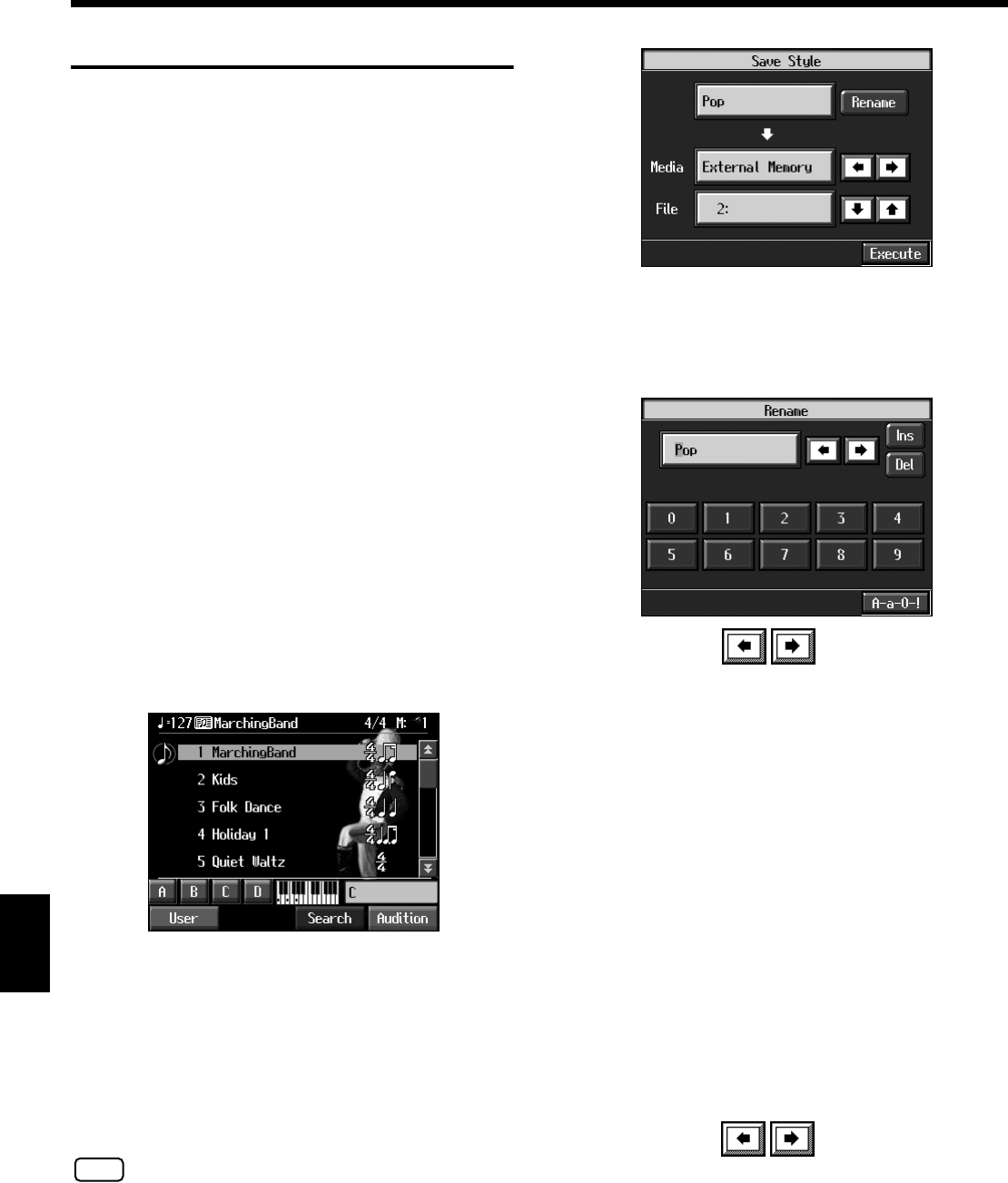
134
Chapter 8 Creating Music Styles
Chapter 8
Saving a User Style
You can save the User Styles you create to floppy disks and
the user memory. When saved to the user memory, User
Styles are not deleted when the power is turned off. You can
also select Styles saved to the user memory by pressing the
Music Style [User] button.
You can save up to 99 User Styles in user memory.
What is the User Memory?
The user memory is the area within the instrument
where User Styles created with the KR, sets of User
Programs, and other such data are stored.
You can also copy User Styles and sets of User Programs
saved on floppy disks.
Data saved to the user memory is not deleted, even
when the KR’s power is turned off.
→When you want to clear all of the content saved to the user
memory and restore the settings to the factory settings, refer to
“Formatting the User Memory” (p. 150).
Preparations for saving data
When saving to an external memory, first connect a external
memory to the external memory port.
1. Press the Music Style [User] button.
A “User Style screen” like the following appears.
fig.d-usrdisk.eps_50
If the User Style screen is not displayed, touch <User> in
the lower part of the screen.
2. Touch <User>.
3. Touch <File>.
4. Touch <Save>.
A “Save Style screen” like the following appears.
NOTE
This function is not available with songs on CDs.
fig.d-stylesave.eps_50
Determining the name of the Style to be saved
5. Touch <Rename>.
A “Rename screen” like the following appears.
fig.d-stylename.eps_50
When you touch , the cursor moves.
When you touch the icon for the character to be input,
the character appears at the cursor position.
For example, touching the <ABC> icon in succession
cycles you through the available choices in that character
group (A→B→C→A...).
Each touch of <A-a-0-!> cycles the type of characters
through “English (upper case),” “English (lower case),”
“numerals,” “symbols,” then back to “English (upper
case).”
When you touch <Del>, the character at the cursor
position is deleted.
When you touch <Ins>, a space is inserted at the cursor
position.
6. When you have finished with the name, press the [Exit]
button.
Determining the save destination
7. Touch <Media> to select the save-
destination strage media.
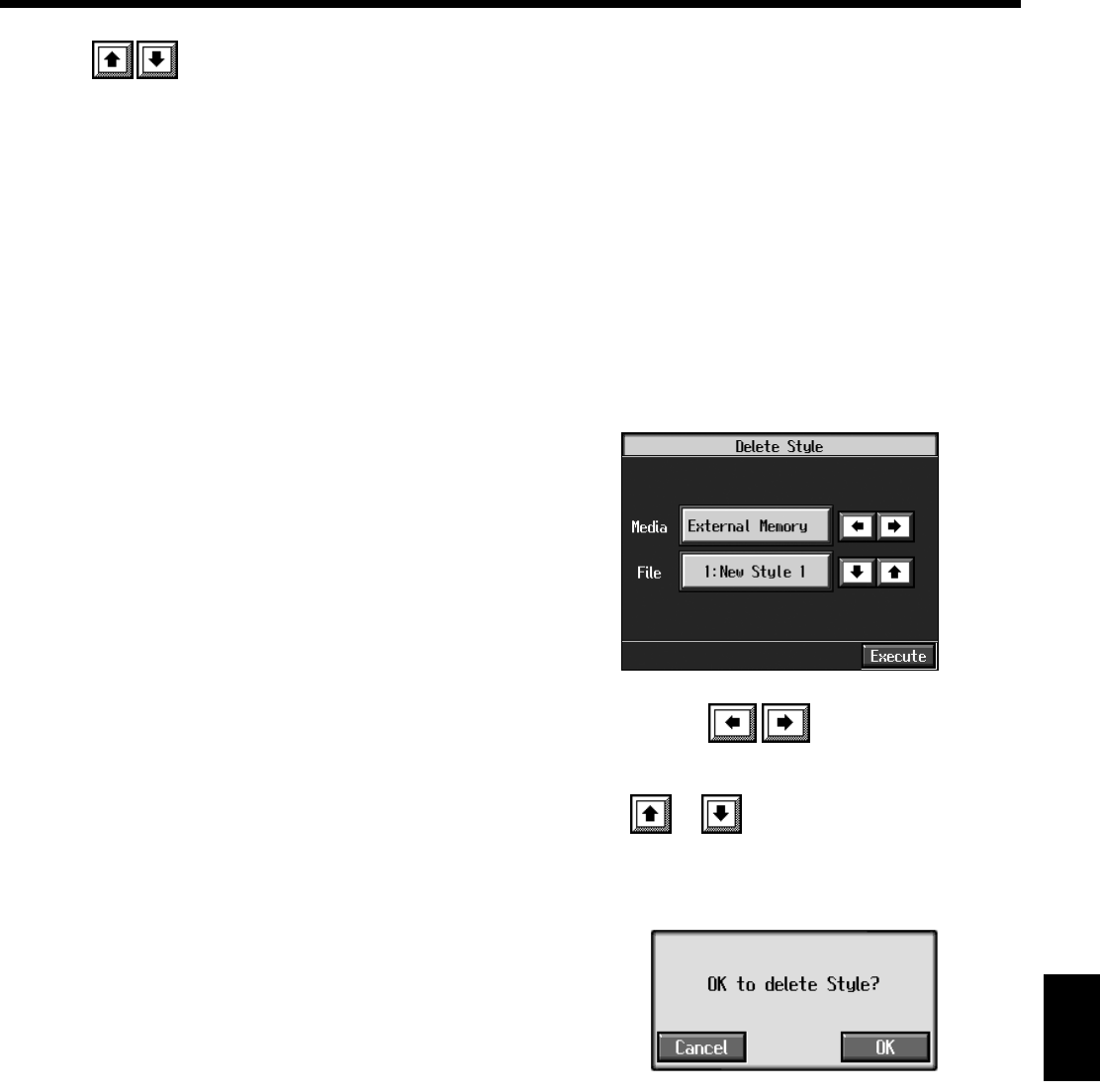
135
Chapter 8 Creating Music Styles
Chapter 8
8. Touch to select the save-destination
number.
If a Style name is displayed, a style is already saved to
that number.
If you select a number with a previously saved User
Style and then save to that number, the previously saved
User Style is deleted. If you do not want to delete the
User Style being saved, select a number in the save-
destination column that does not yet have a name.
9. Touch <Save>.
The saving process starts.
* Never turn off the power or eject the external
memory from the external memory port while the
operation is in progress. Doing so will damage the
KR’s internal memory, making it unusable.
■Deleting Saved User Styles
This deletes User Styles that have been saved to floppy disks
or in user memory.
When deleting a User Style on a floppy disk, first insert the
floppy disk in the disk drive.
1. Press the Music Style [User] button.
A “User Style screen” appears.
If the User Style screen is not displayed, touch <User> in
the lower part of the screen.
2. Touch <File>.
3. Touch <Delete>.
A “Delete Style screen” like the following appears.
fig.d-styledel.eps_50
4. Touch <Media> to select the strage
media.
5. Touch or to select the Style to be deleted.
6. Touch <Delete>.
A screen like the one shown below appears.
fig.m-filedel.eps
7. Touch <OK>.
The selected Style is deleted.
If you touch <Cancel>, the Style won’t be deleted.
* Never turn off the power or eject the external
memory from the external memory port while the
operation is in progress. Doing so will damage the
KR’s internal memory, making it unusable.
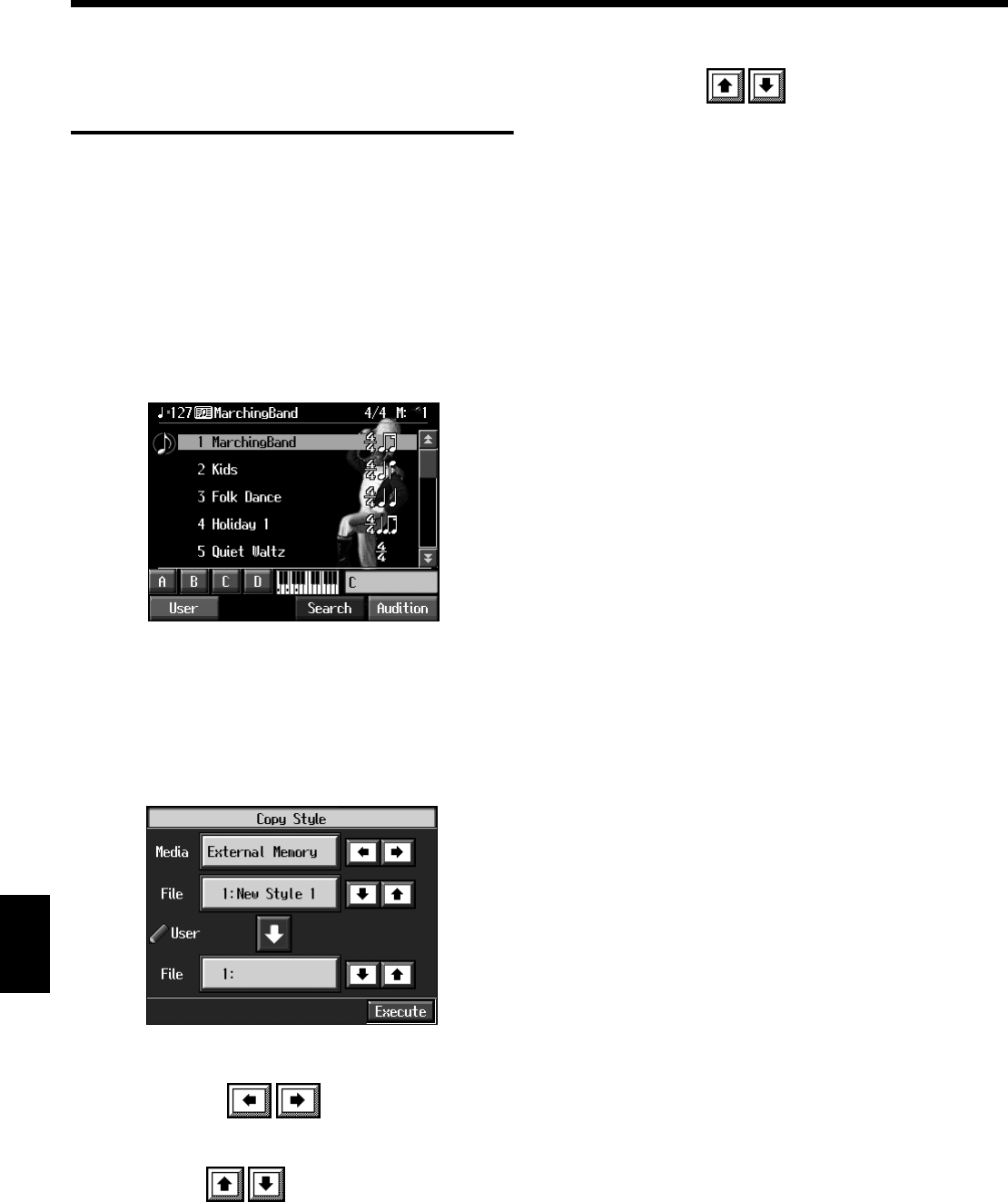
136
Chapter 8 Creating Music Styles
Chapter 8
Copying Styles on External
Memories to the User
Memory
You can take User Styles saved on floppy disks and copy
them to user memory.
You can also take User Styles saved in user memory and
copy them to floppy disks.
1. Insert the floppy disk with the Style to be copied in the
disk drive.
2. Press the [User] button.
A “User Style screen” like the following appears.
fig.d-usrdisk.eps_50
If the User Style screen is not displayed, touch <User> in
the lower part of the screen.
3. Touch <File>.
4. Touch <Copy>.
A “Copy Style screen” like the following appears.
fig.d-copystyle.eps_50
Specifying the copy source
5. Touch <Media> to select the copy source
media.
6. Touch <File> to select the Style you want to
copy.
When “All” is selected, all of the Styles on the floppy
disk are copied to user memory.
Specifying the Copy Destination
7. Touch <User> to select the copy destination
for the Style.
If a Style name is displayed, a style is already saved to
that number.
If you select a number with a previously saved Style and
then copy to that number, the previously saved Style is
deleted. If you do not want to lose the Style being saved,
select a number in the save-destination column that does
not yet have a name.
8. Touch <Execute>.
The Style on the floppy disk is copied to user memory.
* Never turn off the power or eject the external
memory from the external memory port while the
operation is in progress. Doing so will damage the
KR’s internal memory, making it unusable.
■Copying Styles Saved in the
User Memory to External
Memories
You can take Styles saved in user memory and copy them to
floppy disks.
In this case, touch the large arrow icon in the center of the
“Copy Style screen” in Step 4 above so that the arrow points
upwards. Turn the KR will copy user memory Styles to the
floppy disk.
The rest of the procedure is identical to that used for copying
Styles from floppy disks to user memory.
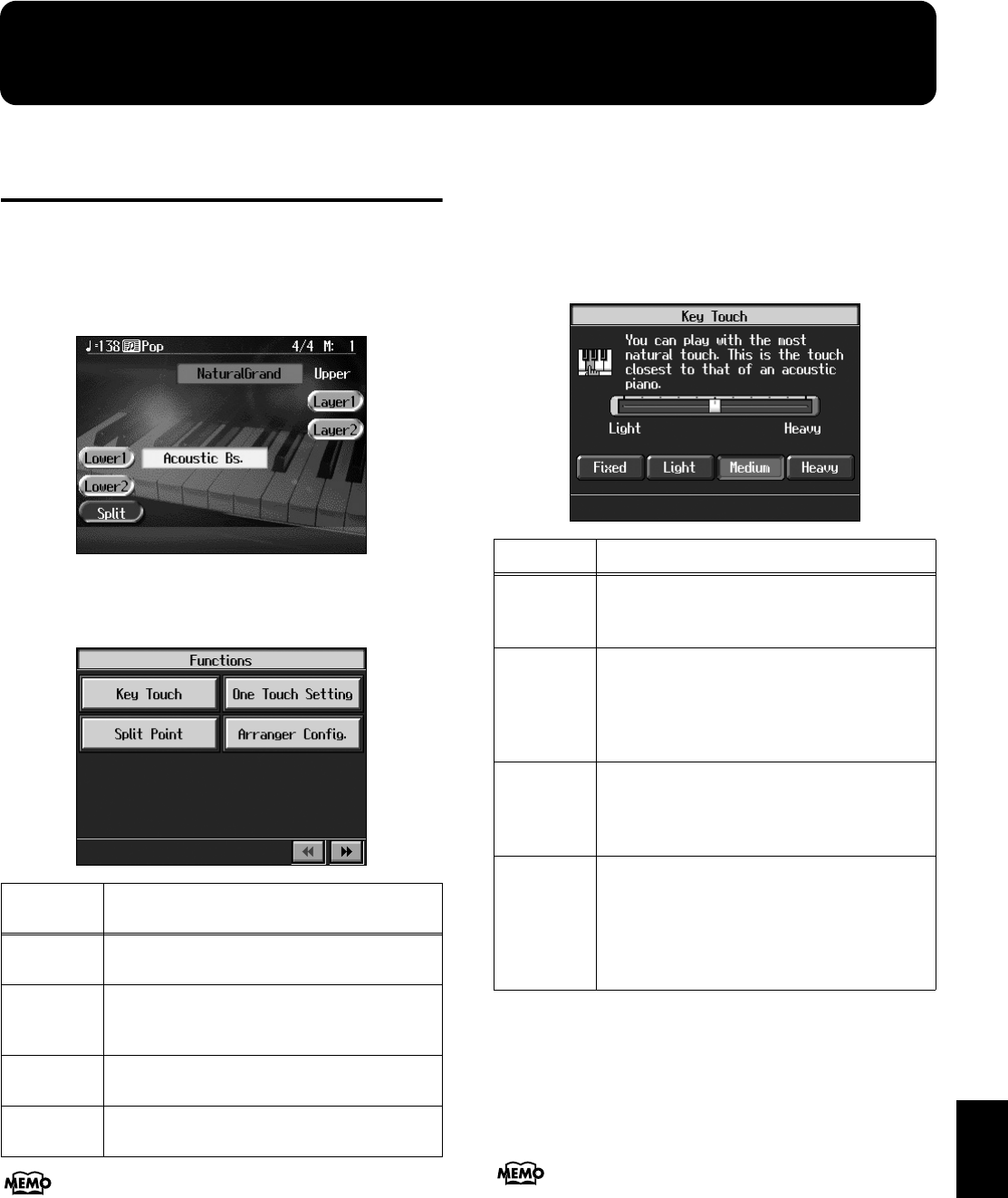
137
Chapter 9
Chapter 9 Various Settings
Changing the Settings for
One-Touch Arranger
■Procedure
1. Press the One Touch Program [Arranger] button to
display the Basic screen.
fig.d-arrbasic.eps_50
2. Touch <Functions>.
A screen like the one shown below appears.
fig.d-funcmenu1.eps_50
You set the tuning and make a variety of other settings
for the KR107 starting with the second page of the
settings screen.
3. Touch the name of the parameter to be set.
Refer to the corresponding page for each function.
4. Press the [Exit] button to return to the Basic screen.
■Adjusting the Keyboard Touch
(Key Touch)
You can vary the touch of the keyboard when you play the
keys.
At Step 3 in “Procedure” (p. 138), touch <Key Touch>.
fig.d-p-key.eps_50
Touch any of the icons <Fixed>, <Light>, <Medium>, or
<Heavy>, to set the key touch for the keyboard.
To make fine adjustments, touch the slider in the screen.
Move the slider to the right to add resistance, and to the right
to make the key touch lighter.
You can also change the key touch by pressing the
[Piano Designer] button. For more details, refer to the
Quick Start.
Parameter
Name Explanation
Key Touch Refer to “Adjusting the Keyboard Touch
(Key Touch)” (p. 137).
One Touch
Setting
Selects the setting to be specified when the
One Touch Program [Arranger] button is
pressed (p. 138).
Split Point Sets the key at which the keyboard is divided
(the split point) (p. 138).
Arranger
Config.
Sets the way the Automatic Accompaniment
plays sounds (p. 138).
Display Explanation
Fixed
Notes sound at an unchanging volume level,
regardless of how lightly or forcefully you
play the keyboard.
Light
This sets the keyboard to a light touch. You
can achieve fortissimo (ff) play with a less
forceful touch than usual, so the keyboard
feels lighter. This setting makes it easier for
children, whose hands have less strength.
Medium
This sets the keyboard to the standard touch.
You can play with the most natural touch.
This setting is closest to the response of an
acoustic piano.
Heavy
This sets the keyboard to a heavy touch. You
have to play the keyboard more forcefully
than usual in order to play fortissimo (ff), so
the keyboard touch feels heavier. This
setting allows you to add more expression
when playing dynamically.
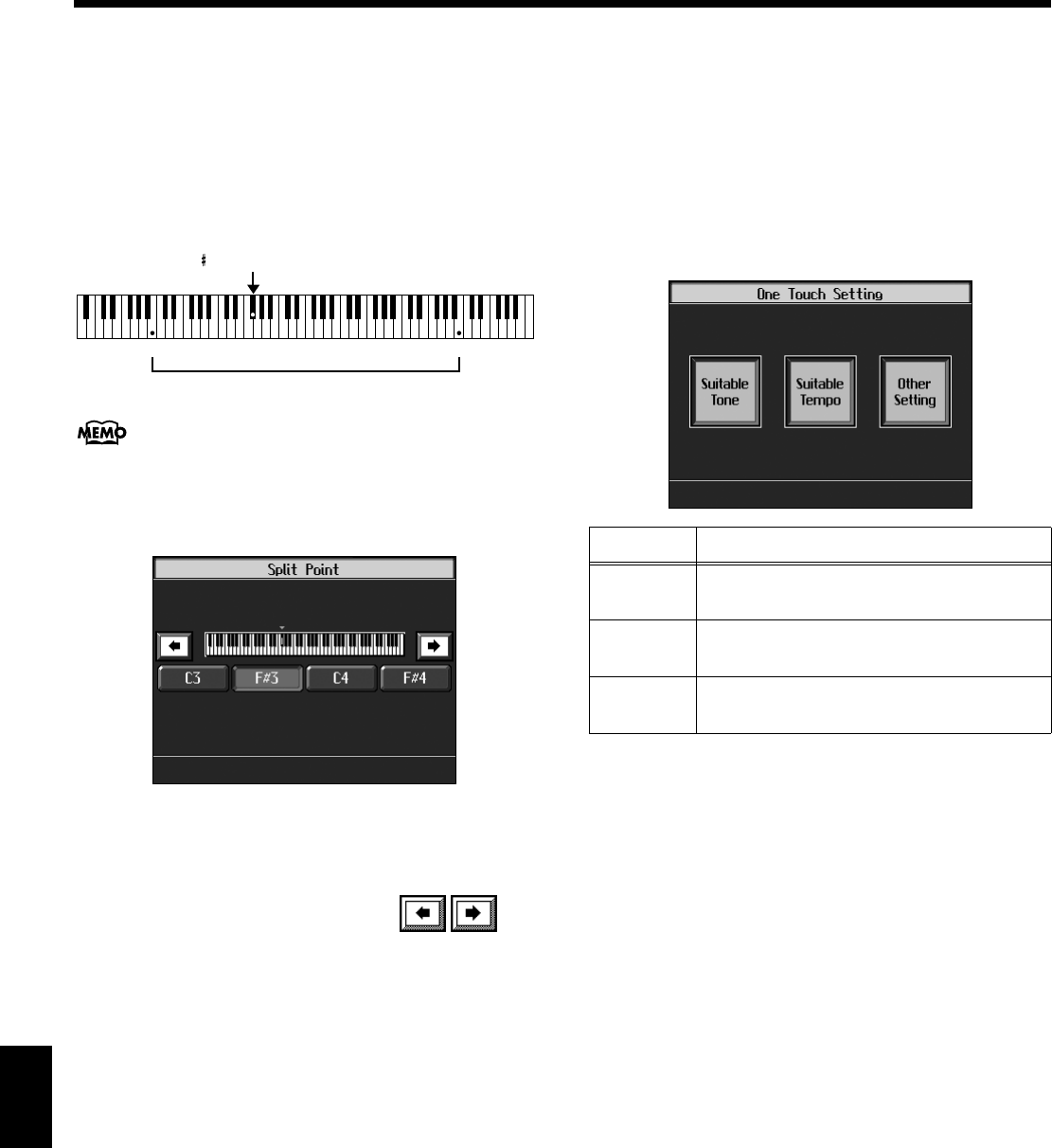
138
Chapter 9 Various Settings
Chapter 9
■Changing the Keyboard’s Split
Point (Split Point)
This sets the point (the split point) where the keyboard is
divided when specifying chords in the left hand while using
the Automatic Accompaniment and when playing split
performances (p. 26).
The setting is at “F#3” when the KR is powered up.
fig.splitpoint.e
The key you chose for the split point belongs to the left-
hand section of the keyboard.
At Step 3 in “Procedure” (p. 137), touch <Split Point>.
fig.d-splitpoint.eps_50
Touch either <C3>, <F#3>, <C4>, or <F#4> in the lower part
of the screen.
The key you chose becomes the split point.
To set another key as the split point, touch in
the screen, then specify the key.
You can set the split point within a range of B1 to B6.
■Changing Music Styles Without
Changing the Tone or Tempo
(One Touch Setting)
Normally, when you select a Music Style, the Tone and
tempo settings suitable for that Music Style are selected
automatically. However, you can also set it so the tempo and
Tone settings don’t change when you change Music Styles.
At Step 3 “Procedure” (p. 137), touch <One Touch Setting>.
fig.d-1touchset.eps_50
Touch each icon to switch individual settings on and off.
All items are set to ON when you turn on the power.
Parameters switched to OFF (highlighted in orange) do not
change, even when the Music Style is changed.
■Changing How Chords Are
Played and Specified
(Arranger Config)
This changes the settings determining how Music Styles are
played, and how the keys are pressed to specify chords.
What are the Chord Tone and Bass Tone?
When the Automatic Accompaniment is stopped, and Sync
Start (p. 54) is turned off, chords are produced when you
play in the left-hand side of the keyboard. This is called the
“chord tone,” and the root of the chord that is played at the
same time is called the “bass tone.”
At Step 3 “Procedure” (p. 137), touch <Arranger Config>.
F 3 (Split Point)
Split Point Settings Range
B1 B6
Display Explanation
Suitable
Tone
The suitable tone for a Music Style is
selected automatically.
Suitable
Tempo
The suitable tempo for a Music Style is
selected automatically.
Other
Setting
Other settings (Style Orchestrator, phrases,
etc.) are changed automatically.
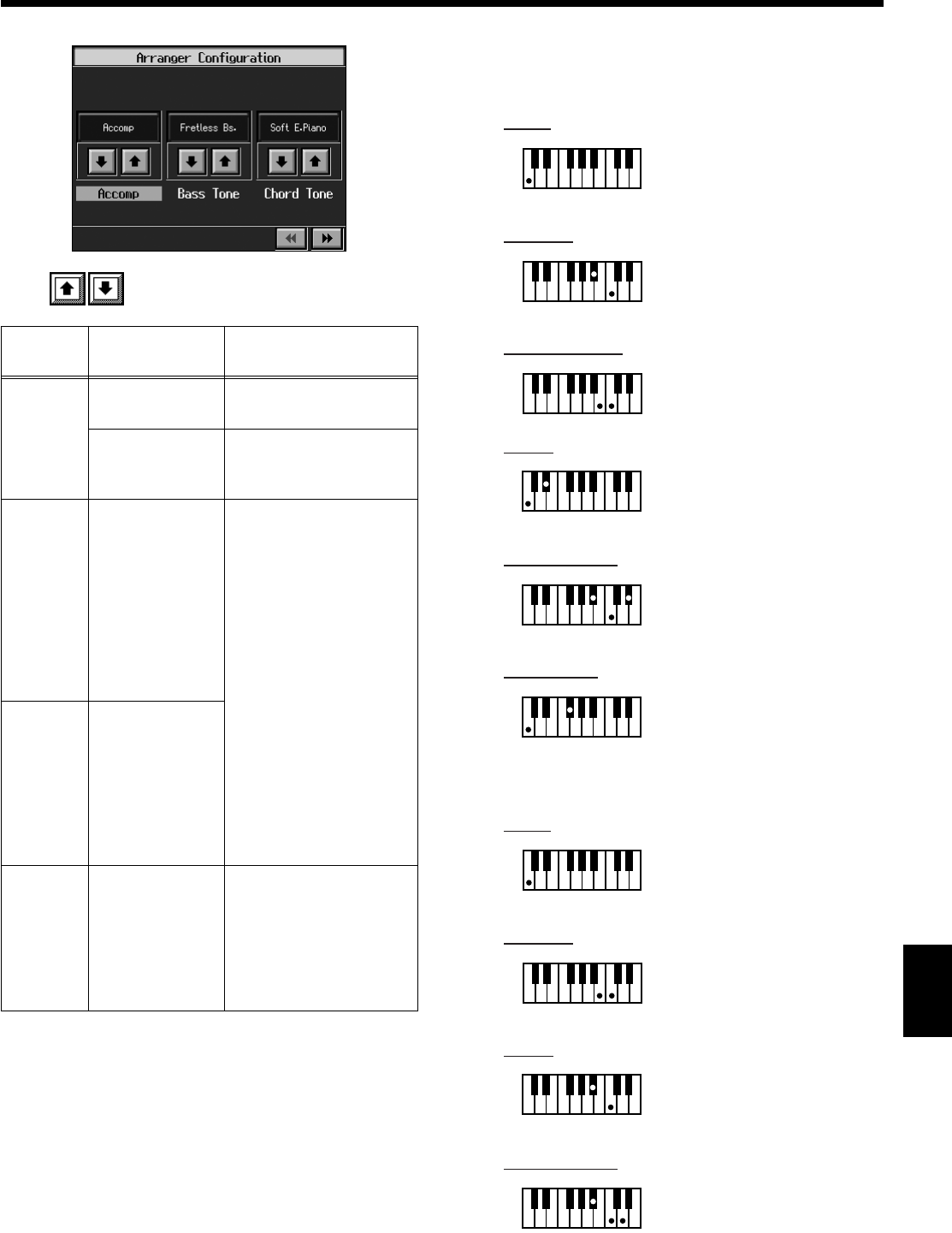
139
Chapter 9 Various Settings
Chapter9
fig.d-arrset.eps_50
Touch of each item to make settings.
What is Chord Intelligence?
“Chord Intelligence” (p. 47) is the name of the function that
recognizes the chords being specified for an accompaniment
when only one or two keys of the chords have been pressed,
which can be used while automatic accompaniment is active.
How to play chords in the Chord Intelligence mode:
Parame-
ter Name Value Explanation
Accomp
Accomp All Music Style parts are
played.
Chord&Bs
Only Music Style rhythm
parts, chord Tones, and
bass Tones are played.
Bass
Tone
OFF,
Acoustic Bs.,
A. Bass+Cymbl,
Fingered Bs.,
Picked Bs.,
Fretless Bs.,
Slap Bass,
Organ Bass,
Synth Bass 101,
Thum Voice
Selects the bass Tone or
chord Tone. When set to
“Off,” no tone is played.
Chord
Tone
OFF, E.Piano 1,
E. Piano 2,
Soft E. Piano,
Hard E. Piano,
Slow Strings,
Strings,
Choir,
Doos Voice
Chord
Intelli
Intelligence 1,
Intelligence 2,
Manual
This selects the way
chords are played with
the Chord Intelligence
function. When you set
this to “Manual,” play all
of the notes describing
the chord.
C
C maj 7
C 7
C m
C m7
C dim
Ex:
Ex:
Ex:
Ex:
Ex:
Ex:
Major
Seventh
Major Seventh
Minor
Minor Seventh
Diminished
Play the chord root.
Play the root and
the second key above it.
Play the root and
the third key above it.
Play the root and
the sixth key above it.
Play the root,
the third key above it, and
the second key below it.
Play the root and
the first key below it.
• Intelligence 1
C
C 7
C m
C m7
Ex:
Ex:
Ex:
Ex:
Major
Seventh
Minor
Minor Seventh
Play the root of the chord.
Play the root of the chord
and the white key to the
left of the root.
Play the root of the chord
and the black key to the
left of the root.
Play the root of the chord
and the black and white key
to the left of the root.
• Intelligence 2
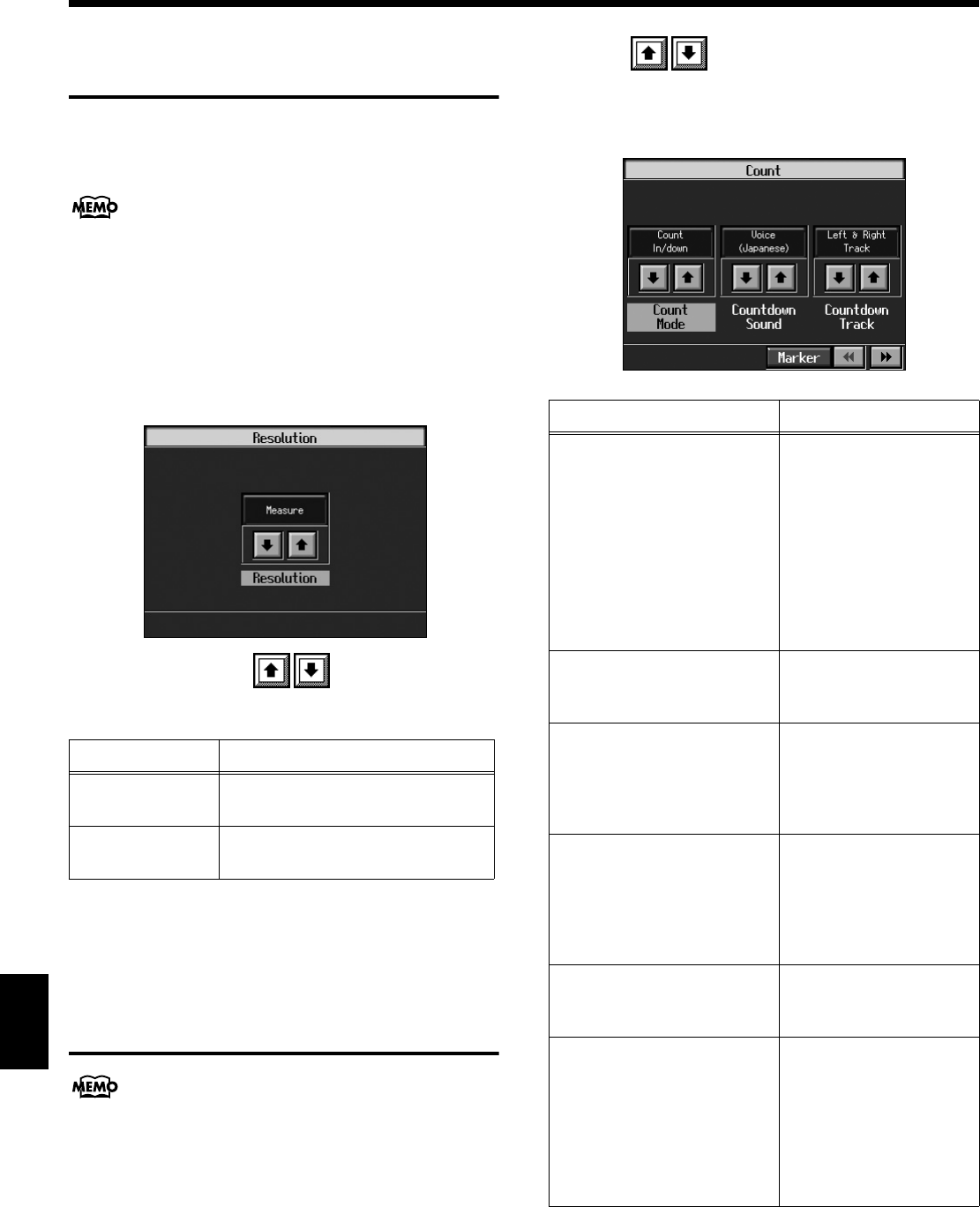
140
Chapter 9 Various Settings
Chapter 9
Placing a Marker in the
Middle of a Measure
A marker is normally placed at the start of the selected
measure, but you can also set it so that a marker is placed at a
position partway through a measure.
For detailed information about Marker, refer to “Setting
Markers for Repeated Practice (Marker)” (p. 84).
1. Press the [Count/Marker] button.
The Count screen appears.
2. Touch <Marker>.
The Marker screen appears.
fig.d-funcmenu2.eps_50
3. Touch <Resolution> to choose the marker
setting.
4. Press the [Exit] button to go back to the Marker screen.
Changing the Settings for the
Count
For detailed information about count, refer to “Match the
Tempo Before You Begin Playing (Count)” (p. 82) and
“Having a Count Sound Play at the End of the Intro
(Countdown)” (p. 56).
1. Press the [Count/Marker] button.
The Count screen (p. 43) appears.
2. Touch of each item to make settings.
3. Press the [Exit] button to return to the Metronome
screen.
fig.d-funcmenu2.eps_50
Indication Explanation
Measure This lets you place a marker at the
beginning of the measure.
Beat This lets you place a marker at the
beginning of the beat.
Parameter Name Value
Count Mode
Specify what type of count
will be added.
Count In
(add a count before the
performance),
Countdown
(add a count only before
you begin playing),
Count In/down
(add both a count-in and
a countdown)
Countdown Sound
Specify the countdown
sound.
Voice (JP), Voice (ENG)
Part
Specify the track or part that
will determine the beginning
of the performance when
added a countdown.
Both Tracks
Lower Track
Upper Track
Part 1–16
Count-In Sound
Specify the count-in sound.
Stick, Click, Electronic,
Voice (JP), Voice (ENG),
Wood Block, Triangle
Castanets,
Handclap
Animal
Measures
Specify the length (number of
measures) of the count-in.
1, 2
Repeat
When “Repeat” is turned ON
on the Marker screen (p. 86)
this specified whether the
count-in will sound each time
the range between the
markers is repeated, or only
the first time.
First, Every
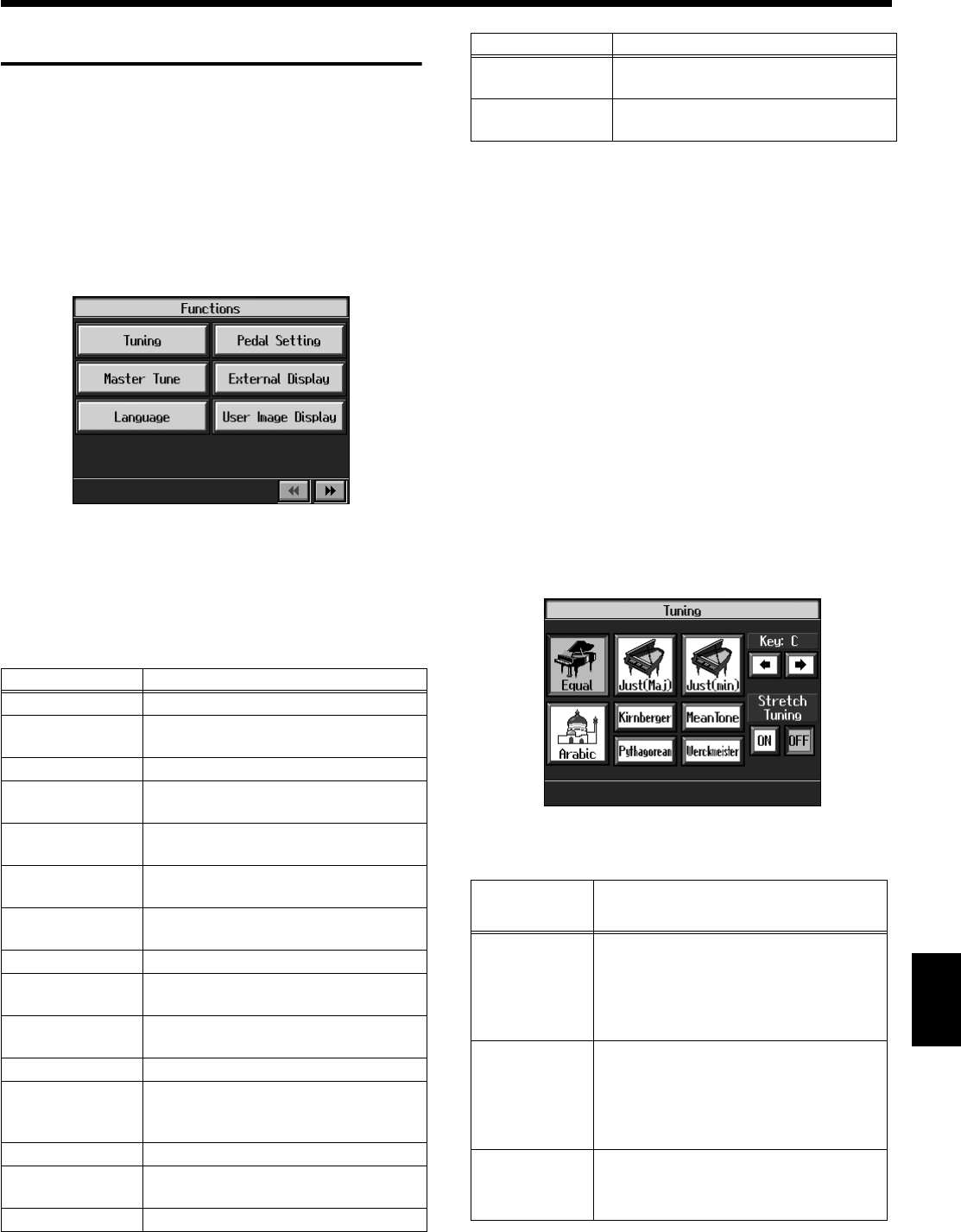
141
Chapter 9 Various Settings
Chapter9
Other Settings
You can change the tuning, the language shown on the
display, and other settings to make the KR easier to use.
■Procedure
1. Switch to the Basic screen, or press the One Touch
Program [Piano] button.
2. Press the [Option] button.
A “Functions screen” like the following appears.
fig.d-funcmenu2.eps_50
When you press the [Option] button on the Basic screen,
the first page displayed shows the parameters for the
Automatic Accompaniment settings (p. 137).
When you press the [Option] button on the Piano screen,
the parameters for the piano performance settings
continue into the second page (p. 138).
3. Touch the name of the parameter you want to set.
Refer to the corresponding page for each function.
4. Press the [Exit] button to return to the Functions screen.
■Changing the Tuning (Tuning)
❍Choosing the Tuning
You can play classical styles such as Baroque using historic
temperaments (tuning methods).
Most modern songs are composed for and played in equal
temperament, the most common tuning in use today. But at
one time, there were a wide variety of other tuning systems
in existence. By playing in the temperament that was in use
when a composition was created, you can experience the
sonorities of chords originally intended for that song.
At Step 3 in “Procedure” (p. 138), touch <Tuning>.
fig.d-p-temp.eps_50
You can choose from among the eight tunings described
below.
Parameter Explanation
Tuning Changing the tuning methods.
Pedal
Setting
Assigns functions to the pedal and
performance pad (p. 142).
Master Tune Sets the KR’s standard pitch (p. 145).
External Display Selects the content to be shown on the
connected external display (p. 163).
Language Selects the language used in the
display (p. 145).
User Image
Display
Selects the image data and display
used (p. 146).
Opening
Message
Sets the message that appears when
the power is turned on (p. 147).
MIDI Setting Refer to p. 159.
Program
Change Refer to p. 159.
Memory Backup Stores edited settings and other data to
the KR (p. 147).
MIDI Ensemble Refer to p. 159.
Factory Reset
Restores the content stored with
Memory Backup to the original factory
settings (p. 148).
V-LINK Refer to p. 157.
Remote Control Changing the Functions of the Remote
Control’s Buttons (p. 148).
USB Driver Refer to p. 164.
Remote Sensor Sets the remote sensor’s on or off(p.
149)
Touch Screen Allows for calibration of the touch
screen (p. 149).
Tuning
system Characteristics
Equal
This temperament divides the octave
into 12 equal parts. All intervals will be
slightly out of tune by the same amount.
This setting is in effect when you turn on
the power.
Just (Maj)
This temperament makes the 5th and
3rd intervals pure. It is unsuited to
playing melodies and cannot be
transposed, but is capable of beautiful
sonorities.
Just (min)
Just intonation differs between major
and minor keys. The same results as
major can be obtained in a minor key.
Parameter Explanation
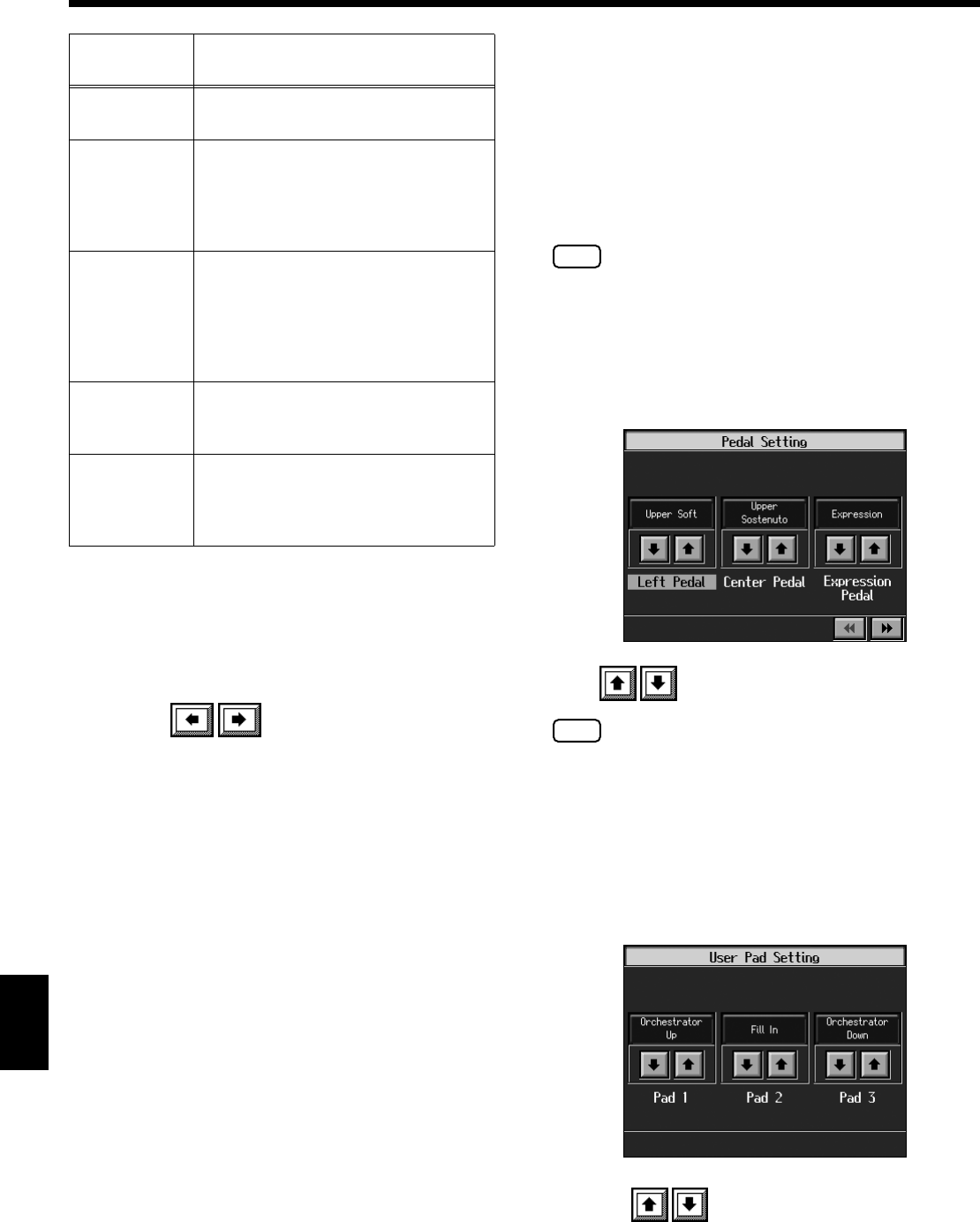
142
Chapter 9 Various Settings
Chapter 9
Touch any one of the icons to choose the tuning system.
When playing in a temperament other than equal
temperament, you must specify the tonic (the note
corresponding to C for a major key, or to A for a minor key)
of the key in which you will play.
Touch <Key> to select the tonic.
If you have selected equal temperament, it is not necessary to
select the tonic.
❍Setting the Tuning Curve (Stretch Tuning)
Pianos are generally tuned so that the low range is flatter and
the high range is sharper than equal tempered pitches. This
method of tuning is unique to the piano, and is known as
“stretched tuning.”
A graph that shows the changes in pitch of actual tuning
compared with the changes in equal temperament pitch is
called a tuning curve. Changing the tuning curve produces
subtle variations in the reverberations of the chords you play.
Touch the Stretch Tuning <ON> or <OFF> icon to select the
tuning curve.
When set to “ON,” the tuning curve features extended low
and high ranges (Stretch Tuning). It is suitable for piano
solos. This setting is selected when the power is turned on.
When set to “OFF,” the standard tuning curve is used. It is
suitable when playing in an ensemble with other
instruments.
■Assigning Functions to Pedals
and Performance Pads (Pedal
Setting/User Functions)
You can assign a variety of functions to the left and center
pedals, the expression pedals, and the performance pads.
You can call up the assigned functions just by pressing the
corresponding pedal or pad.
925
NOTE
Use only the specified expression pedal (EV-7/5; sold
separately). By connecting any other expression pedals, you risk
causing malfunction and/or damage to the unit.
❍Assigning Functions to Pedals
At Step 3 “Procedure” (p. 137), touch <Pedal Setting>.
fig.d-pedalset.eps_50
Touch to assign functions to each of the pedals.
NOTE
Pressing the One Touch Program [Piano] button restores the
piano performance functions to the pedals (p. 18).
❍Assigning Functions to Performance Pads
1. Press the [User Function] button and watch the
indicator light up.
A screen like the one shown below appears.
fig.d-usrfunc.eps_50
2. Touch to assign functions to each of the
Performance Pads.
Arabic This tuning is suitable for the music of
Arabia.
Kirnberger
This temperament is a modification of
meantone temperament and just
intonation, allowing more freedom of
modulation. Performances are possible
in all keys (III).
Pythagorean
This temperament is based on the
theories of the Greek philosopher
Pythagoras, and has pure fourths and
fifths. Chords containing a third will
sound impure, but melodies will sound
good.
Meantone
This temperament is a partial
compromise of just intonation in order
to allow modulation.
Werkmeister
This temperament is a combination of
meantone and Pythagorean
temperaments. It allows you to play in
all keys. (First method, number three.)
Tuning
system Characteristics
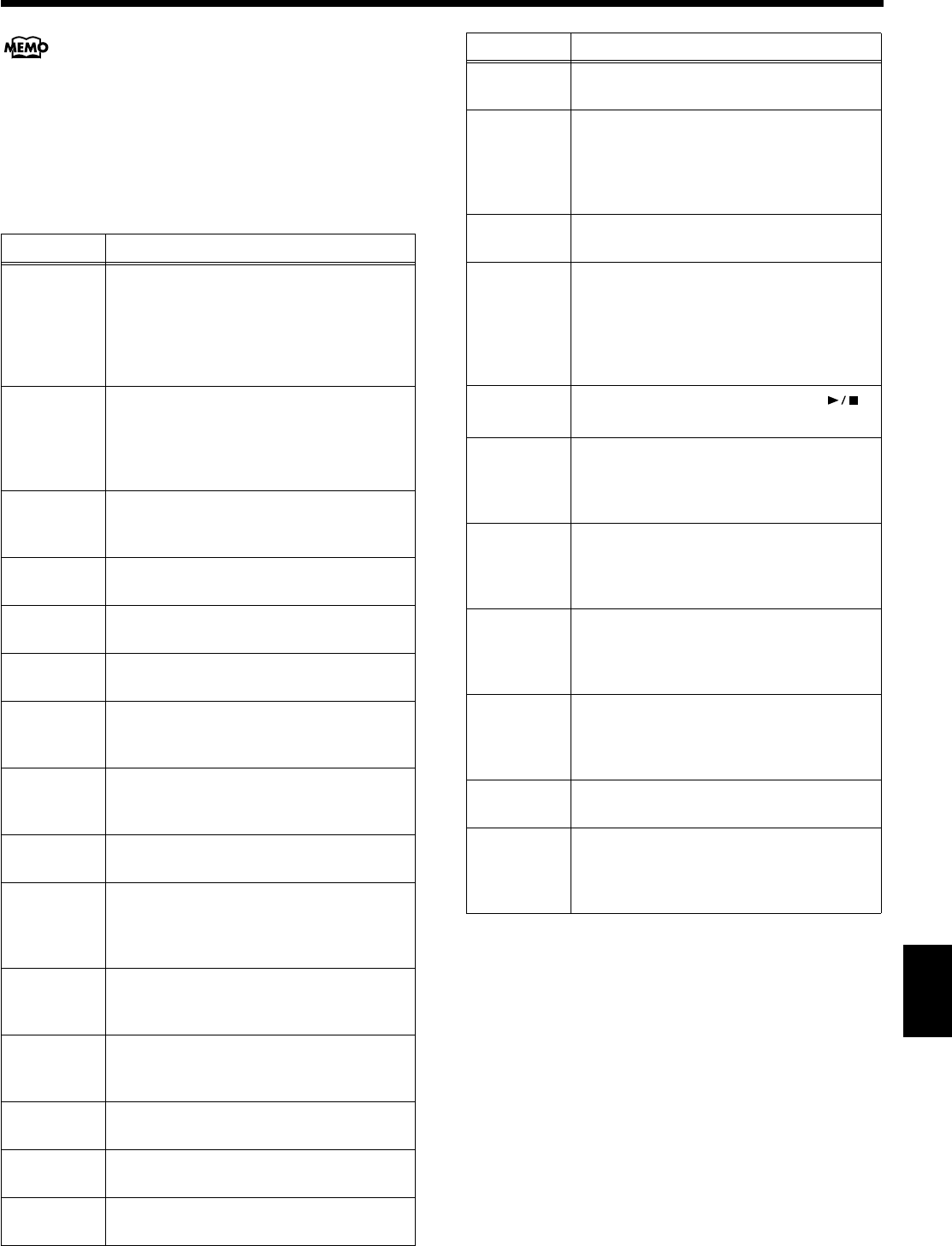
143
Chapter 9 Various Settings
Chapter9
If you set the pedal as a dedicated switch for selecting
User Programs, the function assigned to the pedal
cannot be used. Refer to “Using the Pedal to Switch User
Programs” (p. 111).
❍Functions that can be assigned (Pedals,
Performance Pads)
* What is the leading bass function?
The function that sounds the lowest note of a fingered chord
as the bass tone is called “Leading Bass.” When this function
is turned on, the Bass Tone changes when chord inversions
are used. Usually the tonic of the chord you play sounds as
the bass tone.
* What is the rotary effect?
This adds a sort of spinning effect to the organ sound, similar
to the sound when a rotary speaker is used.
Changing the speed increases or decreases the speed of this
spinning effect.
Function Explanation
Leading
Bass
Toggles the Leading Bass function* on or
off. The function stays on as long as the
pedal to which this is assigned is pressed.
When assigned to a Performance Pad, this
is alternately switched on and off each time
the pad is pressed.
No Chord
Only the Moving Keys Rhythm part is
played. After No Chord is switched on,
specifying a chord by playing the actual
keys cancels the function, and all of the
accompaniment parts are played.
Break
During the performance of Automatic
Accompaniment, the accompaniment
stops for one measure only.
Fill In to
Variation
Performs the same function as the Fill In
[To Variation] button (p. 57).
Fill In to
Original
Performs the same function as the Fill In
[To Original] button (p. 57).
Fill In A fill-in is inserted, but the accompaniment
pattern after that doesn’t change.
Half Fill In
to Variation
This plays a fill-in half a measure long,
then switches to the Variation
accompaniment pattern.
Half Fill In
to Original
This plays a fill-in half a measure long,
then switches to the Original
accompaniment pattern.
Original/
Variation
This changes the accompaniment pattern
without inserting a fill-in.
Arranger
Reset
When this function is used during
Automatic Accompaniment, the
accompaniment returns to the beginning of
the Division (p. 46).
Intro 1/
Ending 1
Performs the same function as the [Intro/
Ending] button (p. 54). Intro 1 and Ending
1 are played.
Intro 2/
Ending 2
Performs the same function as the [Intro/
Ending] button (p. 54). Intro 2 and Ending
2 are played.
Arranger
Start/Stop
Performs the same function as the [Start/
Stop] button (p. 54).
Orchestrat
or Up
This changes the accompaniment to a more
elavorate arrangement (p. 58).
Orchestrat
or Down
Changes the accompaniment to a simpler
arrangement (p. 58).
Melody
Intelligence
Turns the Melody Intelligence function on
and off (p. 59).
Fade In/Out
This starts Automatic Accompaniment
with a fade-in (where the volume gets
progressively louder), ends it with a fade-
out (where the volume gets progressively
softer), then stops.
Rotary
Slow/Fast
This switches the speed of the rotary effect*
when you perform with an organ Tone.
Glide
While the pedal or Performance Pad is held
down, the pitch of the sound drops
temporarily, returning to the original pitch
when the pedal or Pad is released. This can
be effective for simulating the performance
of instruments like a Hawaiian guitar.
Composer
Play/Stop
Performs the same function as the [
(Play/Stop)] button (p. 64).
Page
Fwd 1
Press the pedal or the Pad turns the
notation appearing on the KR display to
the next page while the performance of a
song is stopped.
Page
Bwd 1
Press the pedal or the Pad turns the
notation appearing on the KR display to
the preceding page while the performance
of a song is stopped.
Page
Fwd 2
Press the pedal or the Pad turns the
notation appearing on the external display
to the next page while the performance of a
song is stopped.
Page
Bwd 2
Press the pedal or the Pad turns the
notation appearing on the external display
to the preceding page while the
performance of a song is stopped.
Punch In/
Out
During Punch-in Recording, this starts and
stops recording (p. 118).
Tap
Tempo
You can set the tempo according to the
interval at which the pedal or pad is
pressed
(p. 81).
Function Explanation
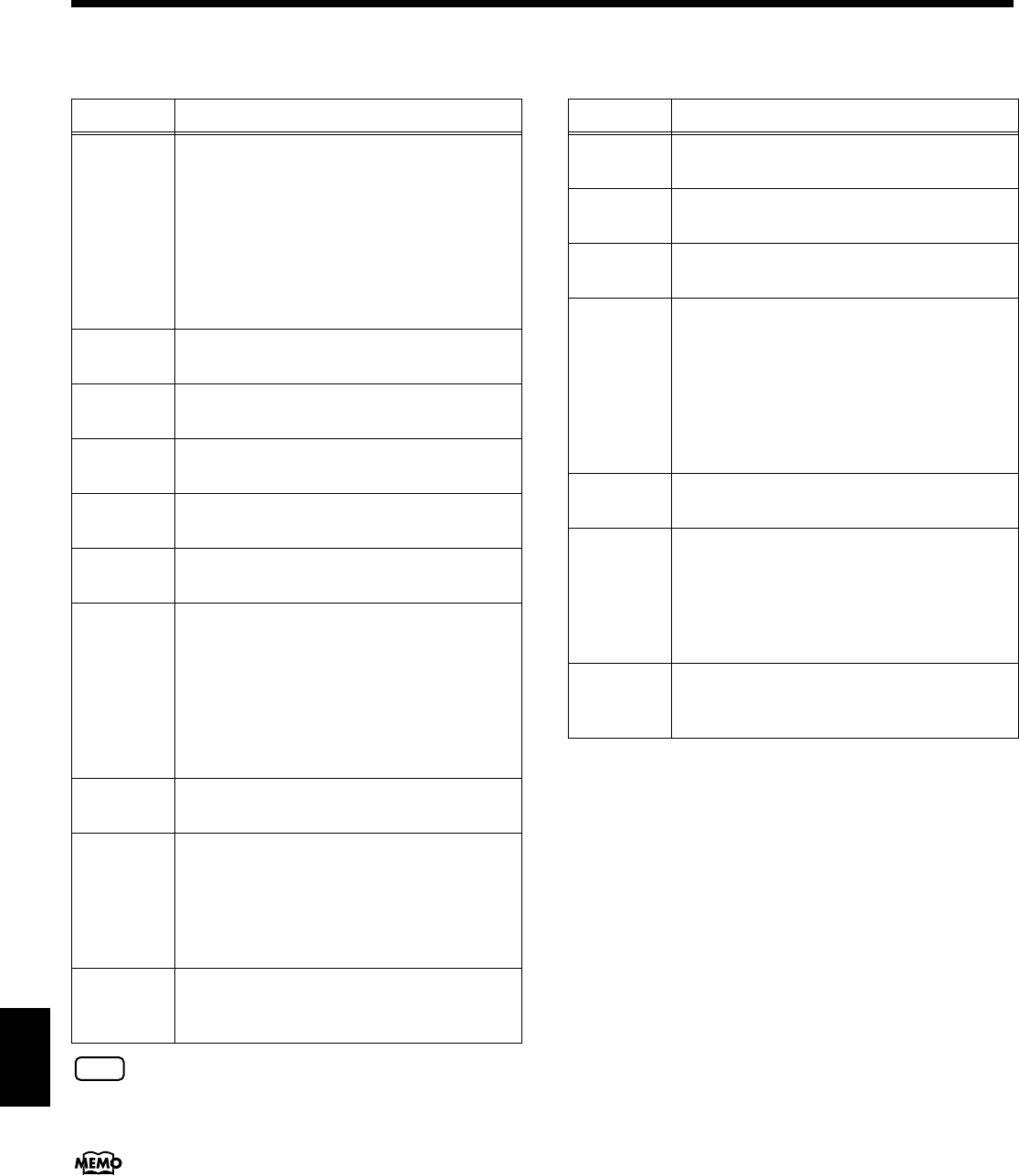
144
Chapter 9 Various Settings
Chapter 9
❍Functions that can be assigned (Pedals
Only)
NOTE
The effect may not be applied correctly when you press a pedal
if “Pedal EX1–4” is assigned to more than one pedal.
Using the “Bend Up” or “Bend Down” function during a
split performance (p. 25) changes the pitch of sounds in
the right-hand side of the keyboard. Additionally, the
range in which the pitch can change when the Bender
effect is used is called the “bend range”; refer to
“Changing the Bend Range (Pedal Setting)” (p. 145).
❍Functions that can be assigned (Expression
Pedals Only)
Function Explanation
Replay
Pressing the pedal during playback of a song
stops the playback. When the pedal is
released, playback resumes from the
beginning of the measure that was playing
when the pedal was pressed. When the pedal
is pressed in rapid succession, the playback
will resume backs up the same number of
measures as the number of times the pedal is
pressed.
Upper
Soft The pedal functions as a soft pedal (p. 18).
Upper
Sostenuto
The pedal functions as a sostenuto pedal
(p. 18).
Lower
Damper
Applies a damper pedal effect to the sounds
in the left-hand side of the keyboard.
Bend Up This raises the pitch of notes you play on the
keyboard.
Bend
Down
This lowers the pitch of notes you play on the
keyboard.
Pedal EX1
When the pedal is pressed during a layer
performance, the Tone volume changes
between two levels, depending on how
firmly the pedal is pressed.
Pressing the pedal with “Pedal EX1” selected
increases the layer Tone volume. The layer
Tone is played at a fixed volume, regardless
of how forcefully the keys are played.
Pedal EX2 Pressing the pedal with “Pedal EX2” selected
increases the layer Tone volume.
Pedal EX3
Pressing the pedal with “Pedal EX3” selected
increases the layer Tone volume, while the
volume of the left-hand Tone is decreased.
The layer Tone is played at a fixed volume,
regardless of how forcefully the keys are
played.
Pedal EX4
Pressing the pedal with “Pedal EX4” selected
increases the layer Tone volume, while the
volume of the right-hand Tone is decreased.
Function Explanation
Expressio
n Pedal Adjusts the overall volume.
Bend Up This raises the pitch of notes you play on the
keyboard.
Bend
Down
This lowers the pitch of notes you play on the
keyboard.
Pedal EX1
When the pedal is pressed during a layer
performance, the Tone volume changes
between two levels, depending on how
firmly the pedal is pressed.
Pressing the pedal with “Pedal EX1” selected
increases the layer Tone volume. The layer
Tone is played at a fixed volume, regardless
of how forcefully the keys are played.
Pedal EX2 Pressing the pedal with “Pedal EX2” selected
increases the layer Tone volume.
Pedal EX3
Pressing the pedal with “Pedal EX3” selected
increases the layer Tone volume, while the
volume of the left-hand Tone is decreased.
The layer Tone is played at a fixed volume,
regardless of how forcefully the keys are
played.
Pedal EX4
Pressing the pedal with “Pedal EX4” selected
increases the layer Tone volume, while the
volume of the right-hand Tone is decreased.
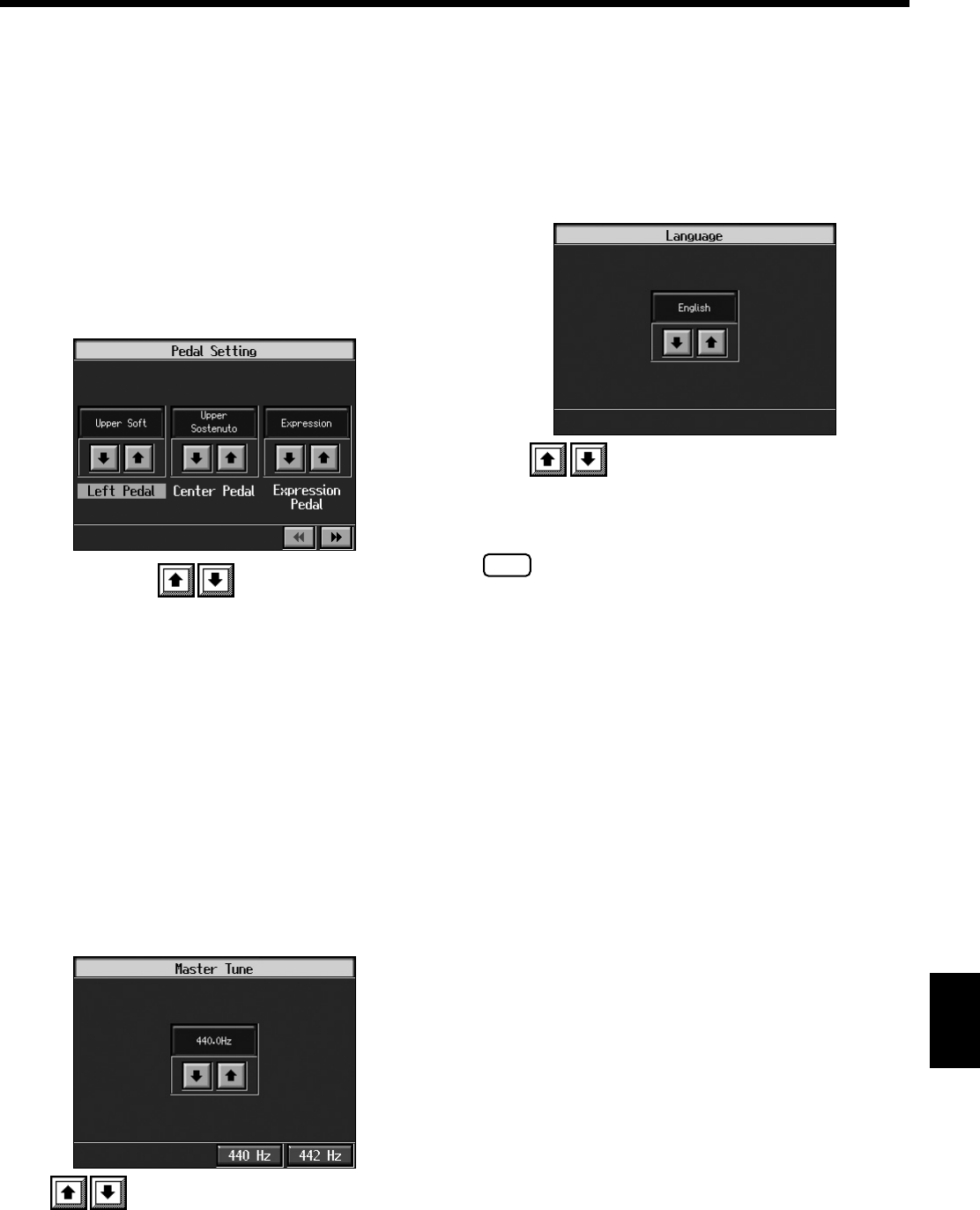
145
Chapter 9 Various Settings
Chapter9
■Changing the Bend Range
(Pedal Setting)
The effect of smoothly raising or lowering the pitch of a
played note is called the “bender effect.”
You can assign the bender function to a pedal, then apply the
bender effect by depressing and releasing the pedal.
You can also make a setting that determines how much the
pitch of the note changes when you apply the bender. The
maximum range of change in pitch is called the “bend
range.”
At Step 3 “Procedure” (p. 137), touch <Pedal Setting>.
fig.d-pedalset.eps_50
Touch <Bend Range> to adjust the bend range
setting.
You can set this to any value within a range of 1 to 12 (in
half-tone steps, up to one octave).
■Changing Standard Pitch
(Master Tune)
“Standard pitch” generally refers to the pitch that is heard
when you play middle A. When performing in an ensemble
with other instruments, adjust the standard pitch so that the
instruments of the ensemble match. Tuning all the
instruments to a standard pitch is called “master tuning.”
At Step 3 in “Procedure” (p. 141), touch <Master Tune>.
A screen like the one shown below appears.
fig.d-tuning.eps_50
Touch to change the pitch.
Standard pitch can be set to any value from 415.3–466.2 Hz.
■Changing the Language
(Language)
Five choices are available for the language used in displaying
information on the screen.
At Step 3 in “Procedure” (p. 141), touch <Language>.
A screen like the one shown below appears.
fig.d-lang.eps_50
Touch to select the language.
Available settings
English, Japanese, German, French, Spanish
NOTE
German, Spanish, and French are displayed for some functions.
Other screens will be displayed in English.
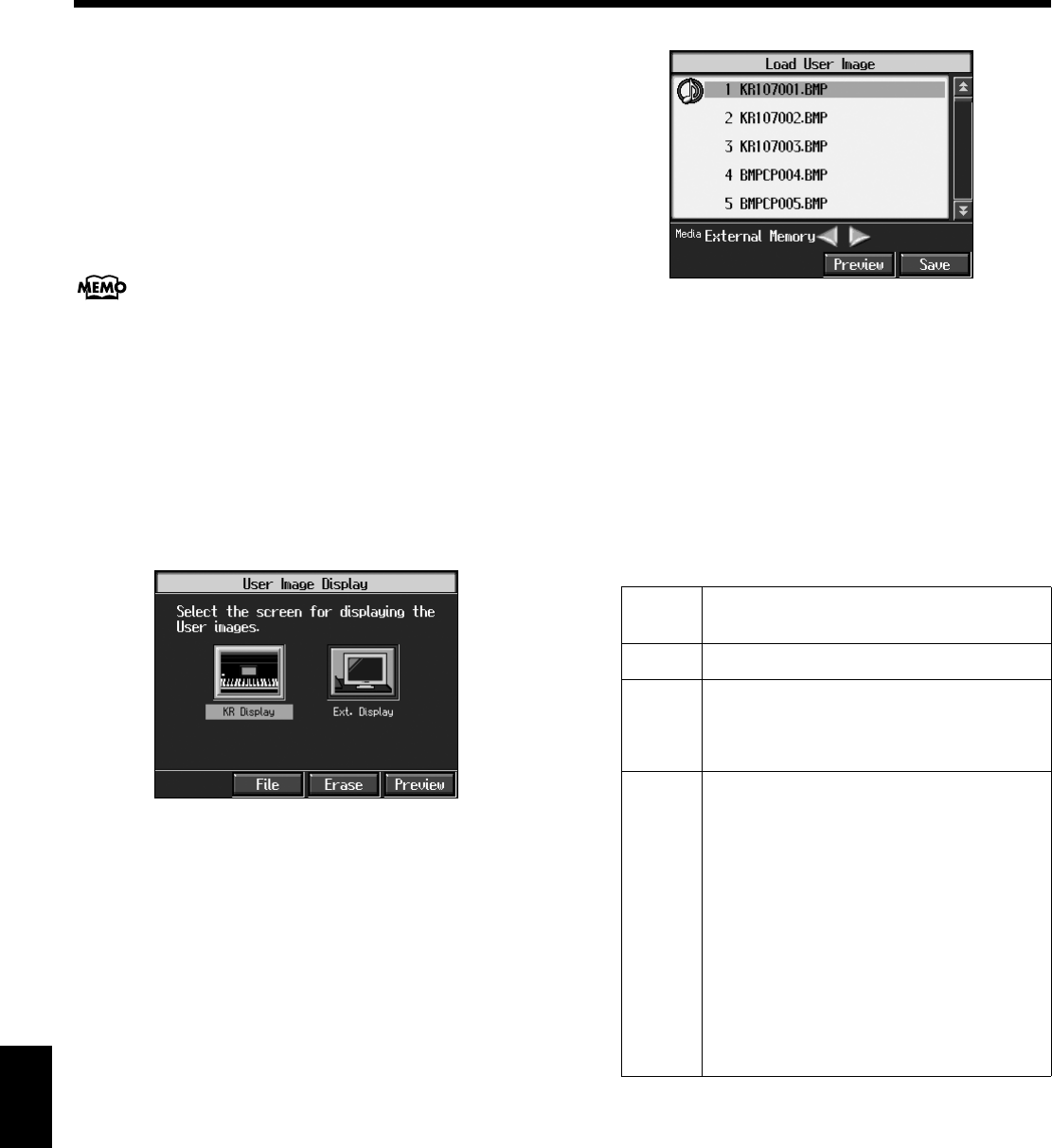
146
Chapter 9 Various Settings
Chapter 9
■Selecting Images To Be Shown
on the KR and External
Displays
(User Image Display)
You can have image data from computers and other devices
shown on the onboard display, or on an external display
you’ve connected. You can store two types of image data,
“KR-display-use” data, and “external-display-use” data.
“KR-display-use” images appear on the KR’s display
when the instrument’s power is turned on. Refer to the
procedure in “Changing the Settings for Showing
Images with the External Display (External Display)” (p.
163) to set the instrument so the “external-display-use”
image is displayed on the external display.
At Step 3 in “Procedure” (p. 141), touch <User Image
Display>.
A screen like the one shown below appears.
fig.d-usrimage.eps_50
Selecting the display to be set
1. Touch <KR Display> or <Ext. Display>.
Select the setting either for “KR-display-use” or
“external-display-use” images.
Selecting the images to be displayed
First, take a floppy disk to which the image data stored
in the KR has been saved, and insert the floppy disk in
the disk drive.
2. Touch <File>.
A screen like the one shown below appears.
fig.d-usrimage2.eps_50
3. Touch the name of the stored image data.
When you touch <Preview>, you can then show the
selected image data on the display selected in Step 1.
4. Touch <Save>.
The selected image data is stored.
5. Press the [Exit] button to return to the previous screen.
To clear the stored image data, touch <Erase>.
❍Image data that KR can display
Size 320 x 240 pixels (for KR display)
640 x 480 pixels (for external display)
Color 1/4/8 bit (2/16/256 colors)
Format
BMP format
* The KR cannot deal with compressed
image data.
Name
1–8 characters in length (lowercase is ok). A
filename extension of “.BMP” (uppercase
characters) must be added after the name.
The following characters can be used to
name an image.
A B C D E F G H I J K L M N O P Q R S T U
V W X Y Z a b c d e f g h i j k l m n o p q r s
t u v w x y z 0 1 2 3 4 5 6 7 8 9 # $ % & ‘ ( ) -
@ ~ { } ^ _ !
* If you use a character that cannot be used
in a name, it will be replaced by another
character when displayed.
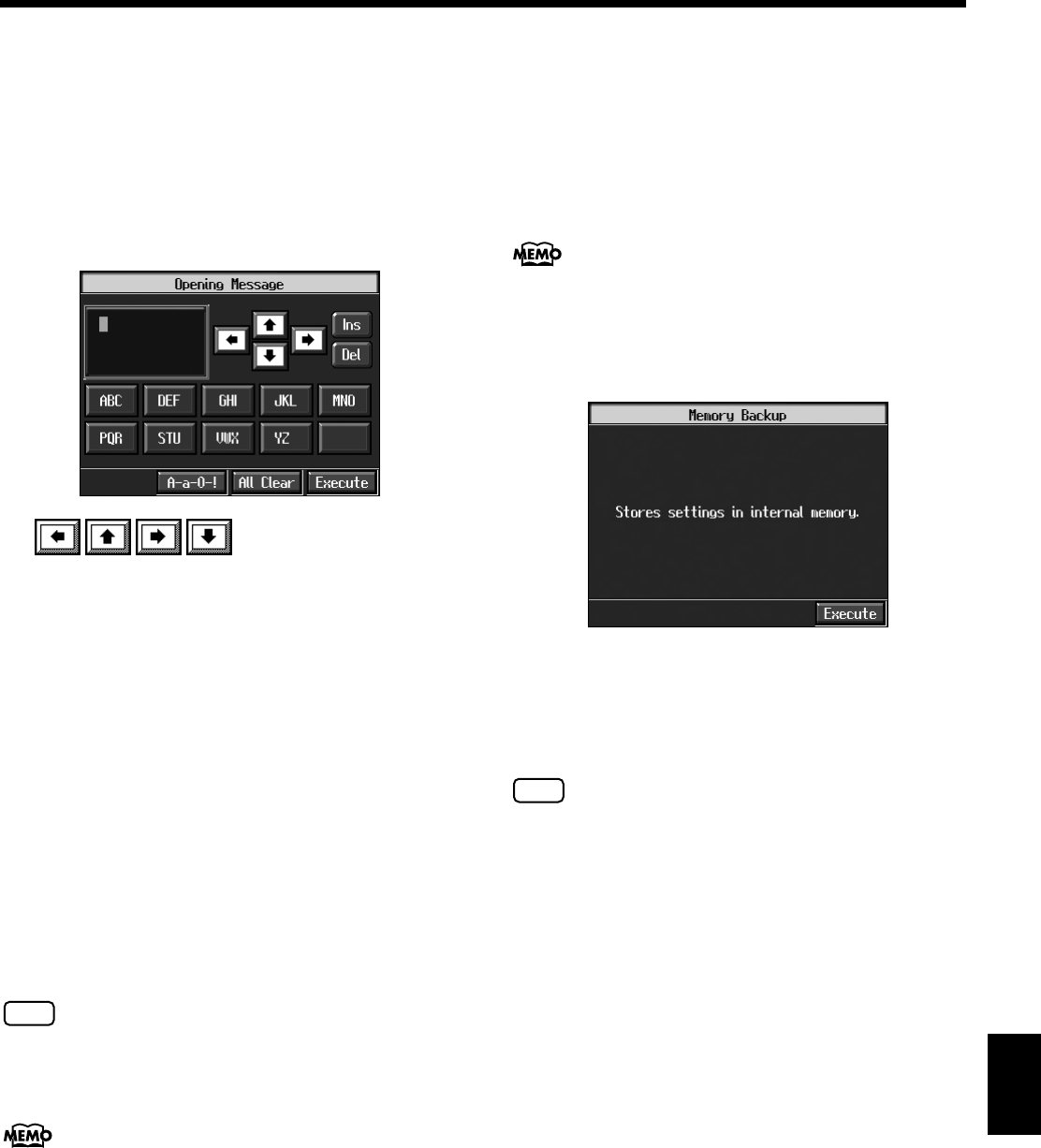
147
Chapter 9 Various Settings
Chapter9
■Changing the Screen Message
When the Power Is Turned On
(Opening Message)
You can modify this screen to show your favorite phrase
when the power is turned on.
At Step 3 in “Procedure” (p. 141), touch <Opening Message>.
A screen like the one shown below appears.
fig.d-openmsg.eps_50
Use to move the cursor.
When you touch the character icon, the character is input
where at the position.
When you touch the icon for the character to be input, the
character appears at the cursor position. For example,
touching the <ABC> icon in succession cycles you through the
available choices in that character group (A→B→C→A...).
Each touch of <A-a-0-!> cycles the type of characters through
“English (upper case),” “English (lower case),” “numerals,”
“symbols,” then back to “English (upper case).”
When you touch <Del>, the character at the cursor position is
deleted.
When you touch <Ins>, a space is inserted at the cursor
position.
When you have finished inputting the characters, touch
<Execute>.
NOTE
Never turn off the power while the display indicates
<Executing...>. Doing so will damage the KR’s internal
memory, making it unusable.
If you touch <All Clear> at the bottom of the screen and
then touch <Execute>, the display reverts to the screen
that normally appears when you turn on the power to
the instrument.
■Remembering the Settings
Even When the Power is
Turned Off (Memory Backup)
Normally, the various settings revert to their default values
when the power is turned off. However, you can specify that
the settings will be remembered even when the power is
turned off. This function is called “Memory Backup.”
For more on the settings stored using Memory Backup,
refer to “Parameters Stored in Memory Backup” (p. 182).
At step 3 in “Procedure” (p. 141), touch <Memory Backup>.
A screen like the one shown below appears.
fig.d-memory.eps_50
Touch <Execute>.
The confirmation message appears on screen.
Touch <OK> to store the setting.
When the setting has been stored in memory, the previous
screen will reappear.
NOTE
Never turn off the power while the display indicates
<Executing...>. Doing so will damage the KR’s internal
memory, making it unusable.
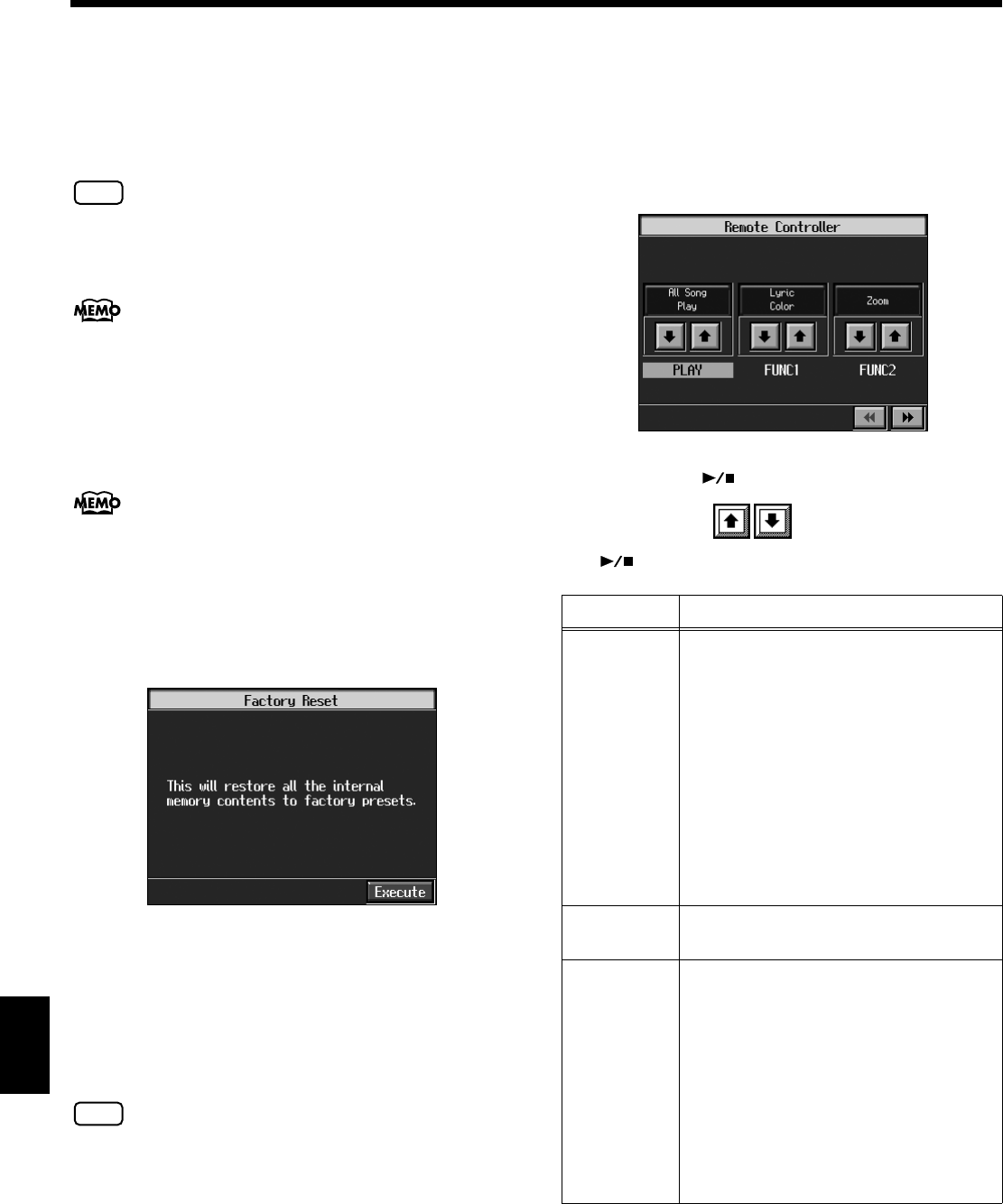
148
Chapter 9 Various Settings
Chapter 9
■Restoring the Factory Settings
(Factory Reset)
You can return the content stored with “Memory Backup” (p.
147) and the User Programs (p. 107) to their original factory
settings. This operation is referred to as “Factory Reset.”
NOTE
When you perform a Factory Reset, all settings that have been
stored in memory up to then are erased and reset to their
factory defaults.
This operation does not return the touch screen
calibration settings to the original factory condition. To
return the touch screen calibration settings to the
original factory settings, refer to “Returning the touch
screen calibration settings to the original factory
settings” (p. 150)
When you want to restore the content registered to the
KR’s User memory to the factory condition, refer to
“Formatting the User Memory” (p. 150).
At step 3 in “Procedure” (p. 141), touch “Factory Reset.”
A screen like the one shown below appears.
fig.d-factory.eps_50
Touch <Execute>.
The confirmation message appears on screen.
Touch <OK> to restore the original factory settings.
When the setting is changed, the previous screen returns.
When you touch <Cancel>, the settings are left untouched,
and you’re returned to the previous screen.
NOTE
Never turn off the power while the display indicates
<Executing...>. Doing so will damage the KR’s internal
memory, making it unusable.
■Changing the Functions of the
Remote Control’s Buttons
You can change the functions assigned to the remote
control’s buttons.
At step 3 in “Procedure” (p. 141), touch <Remocon Setting>.
A screen like the one shown below appears.
Changing the [ ] (PLAY) Button Functions
6. Touch <PLAY> to assign functions to
[ ] (PLAY) button.
7. Press the [Exit] button to return to the Functions screen.
Display Explanation
All Song
Songs are played back continuously in
sequence, starting from the currently
selected song.
Internal Song
Songs in the selected genre are played
back continuously.
“Favorites” Songs
Songs registered to the “Favorites” are
played back in sequence.
Songs on External Memories
Songs within the selected folder are
played back continuously.
One Song Only the selected song is played back.
Playback stops when the song is finished.
Random
The songs are played back in random
order.
Internal Song
The songs in all genres are played back in
random order.
“Favorites” Songs
Songs registered to the “Favorites” are
played back in random order.
Songs on External Memories
Songs within the selected folder are
played back in random order.
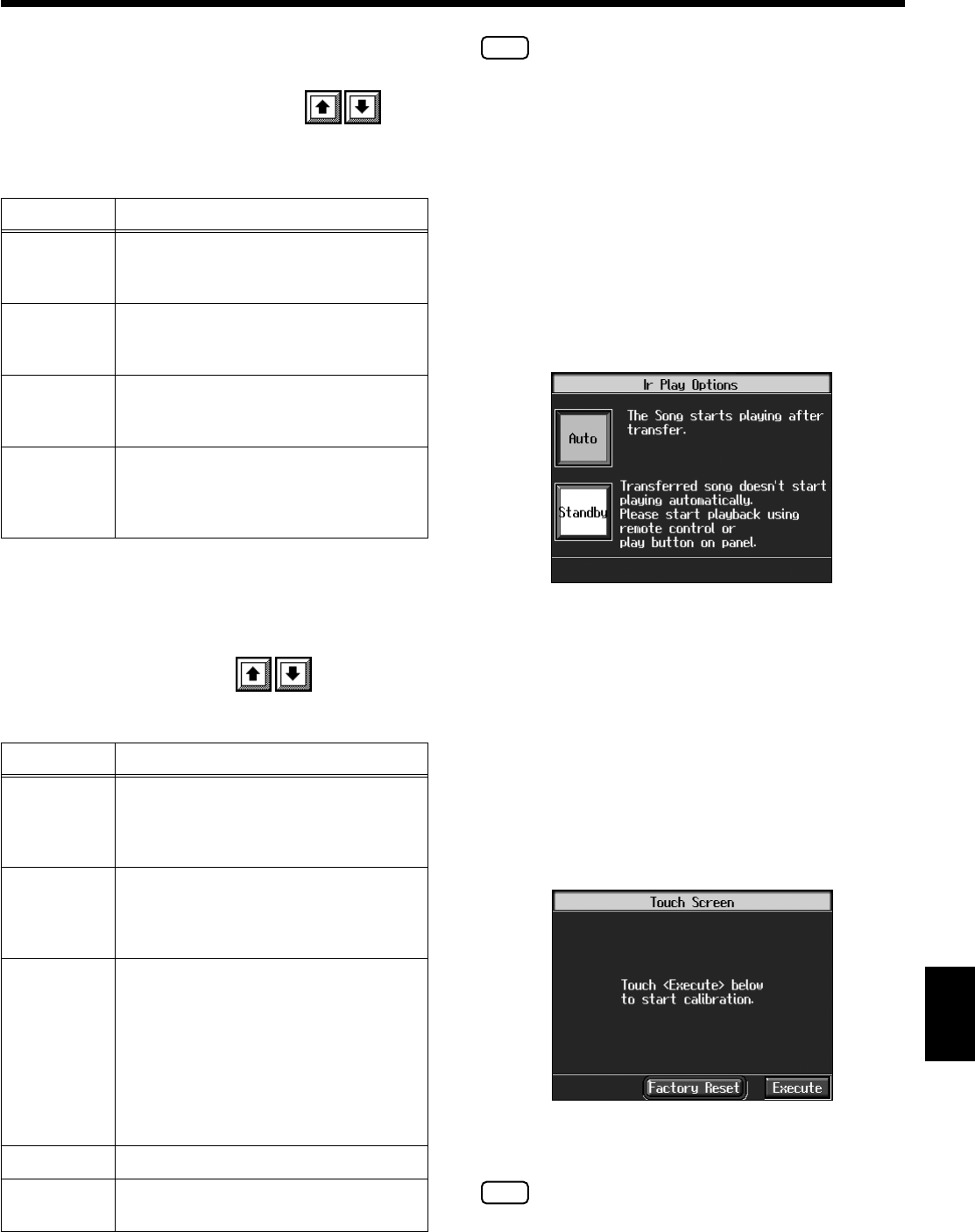
149
Chapter 9 Various Settings
Chapter9
Changing the TEMPO [-] [+] Button and the
TRANSPOSE [+] [-] Button Functions
4. Touch <TEMPO> or <TRANSPOSE> to
assign functions to TEMPO [-] [+] and TANSPOSE [-]
[+] button.
5. Press the [Exit] button to return to the Functions screen.
Changing the [FUNC1] [FUNC2] Button
Functions
4. Touch <FUNC1> <FUNC2> to assign
functions to [FUNC1] [FUNC2] button.
5. Press the [Exit] button to return to the Functions screen.
NOTE
The remote control buttons’ original function assignments are
restored when the power is turned off. If you want to save the
changed settings, carry out the memory backup (p. 147).
■Switching the Remote Sensor
On and Off (iR function)
You set the Remote Sensor to On (active) or Off (disabled).
When switched on, infrared transmission of song data and
remote control information is received.
At step 3 in “Procedure” (p. 141), touch “iR function.”
A screen like the one shown below appears.
Touch <ON> or <OFF>
■Calibrating the Touch Screen
(Touch Screen)
If you’ve been using the touch screen for some time, the
pointer may be shifted, making the KR react incorrectly. You
should correct this displacement when necessary by
performing calibration (repositioning).
At step 3 in “Procedure” (p. 141), touch “Touch Screen.”
A screen like the one shown below appears.
fig.d-touchpanel.eps_50
Touch <Execute>.
Touch the points indicated.
NOTE
Do this carefully, because touching a location that’s different
from the one indicated for the pointer may make the
Display Explanation
Tempo
Changes the tempo. Pressing [-] slows the
tempo down; pressing [+] speeds up the
tempo.
Notation
Scrolls the score in the external display.
Press [-] to return to the previous page;
press [+] to advance to the next page.
Transpose
Transposes the song. Pressing [-] lowers
the pitch in semitone steps; pressing [+]
raises the pitch in semitone steps.
Bwd/Fwd
Fast forwards and rewinds the song.
When [-] is pressed, the song rewinds;
when [+] is pressed, the song is fast
forwarded.
Display Explanation
Track 3
Each time the [FUNC] button is pressed,
the left-hand track is switched on or off.
When turned off, the sound from the left-
hand track does not play.
Track 4
Each time the [FUNC] button is pressed,
the right-hand track is switched on or off.
When turned off, the sound from the
right-hand track does not play.
Pedal
Pressing the button while the song is
playing back stops the playback. When
you release the button, playback resumes
from the beginning of the measure being
played when you pressed the button.
Pressing the button a number of times in
rapid succession moves the playback
position back by the same the number of
measures, after which playback resumes.
Zoom Displays an enlarged notation.
Repeat Playback repeats within the marked
range.
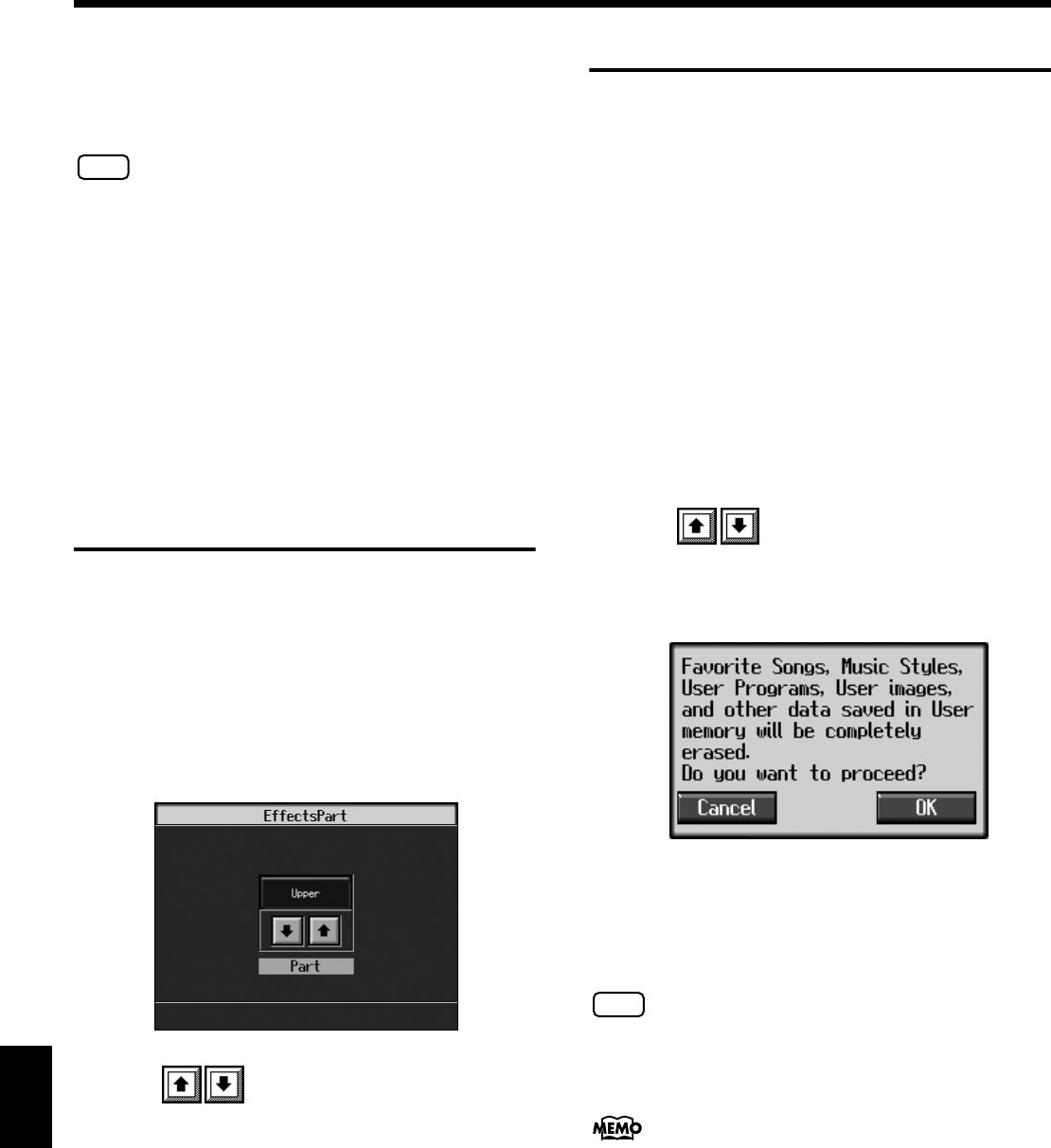
150
Chapter 9 Various Settings
Chapter 9
displacement even worse. Be sure to touch the pointer
accurately.
When the calibration is finished, touch <Write> to store the
settings.
NOTE
If you don’t write them to memory, the calibration settings will
be discarded as soon as the power is switched off.
Returning the touch screen calibration settings
to the original factory settings
If you touch <Factory Reset> in the above screen, the touch
screen calibration settings revert to the original factory
settings.
Selecting the Part to Which
the Effect is Added
(EffectsPart)
You may find effects not being applied to certain parts when
different effects are applied to the right-hand tone, layer
tone, and left-hand tone. In such instances, you can select
which effect is to have priority.
1. Press any tone button, and select the tone (p.**).
2. Touch <Effect>.
3. Touch <Part>.
4. Touch to select the part which the effect is
added.
The effect will be applied to the selected part and other
parts to which the same effect has been applied.
Formatting the User Memory
The KR features an internal storage area where you can save
recorded performances and User Styles. This space is called
the “User Memory.”
The following content is stored to the user memory.
• Content registered to the “Favorites” (p. 68)
• Sets of saved User Programs (p. 108)
• User Styles saved on user memory (p. 134)
• Image files set with the “User Image settings” (p. 146)
To delete all of the content held in the user memory and
restore the original factory settings, carry out the following
procedure.
1. Press the [Song/File] button.
2. Touch <File>.
3. Touch <Format>.
4. Touch to select “User Memory.”
5. Touch <Execute>.
A screen like the one shown below appears.
fig.d-touchpanel.eps_50
6. Touch <OK>.
All of the content in the user memory is deleted.
If you touch <Cancel>, the deletion is cancelled, and
you’re returned to the previous screen.
NOTE
Never turn off the power while the display indicates
<Executing...>. Doing so will damage the KR’s internal
memory, making it unusable.
Carrying out this operation does not initialize any
settings other than the user memory settings. To restore
settings other than those for the user memory to the
original factory settings, carry out Factory Reset (p. 148).
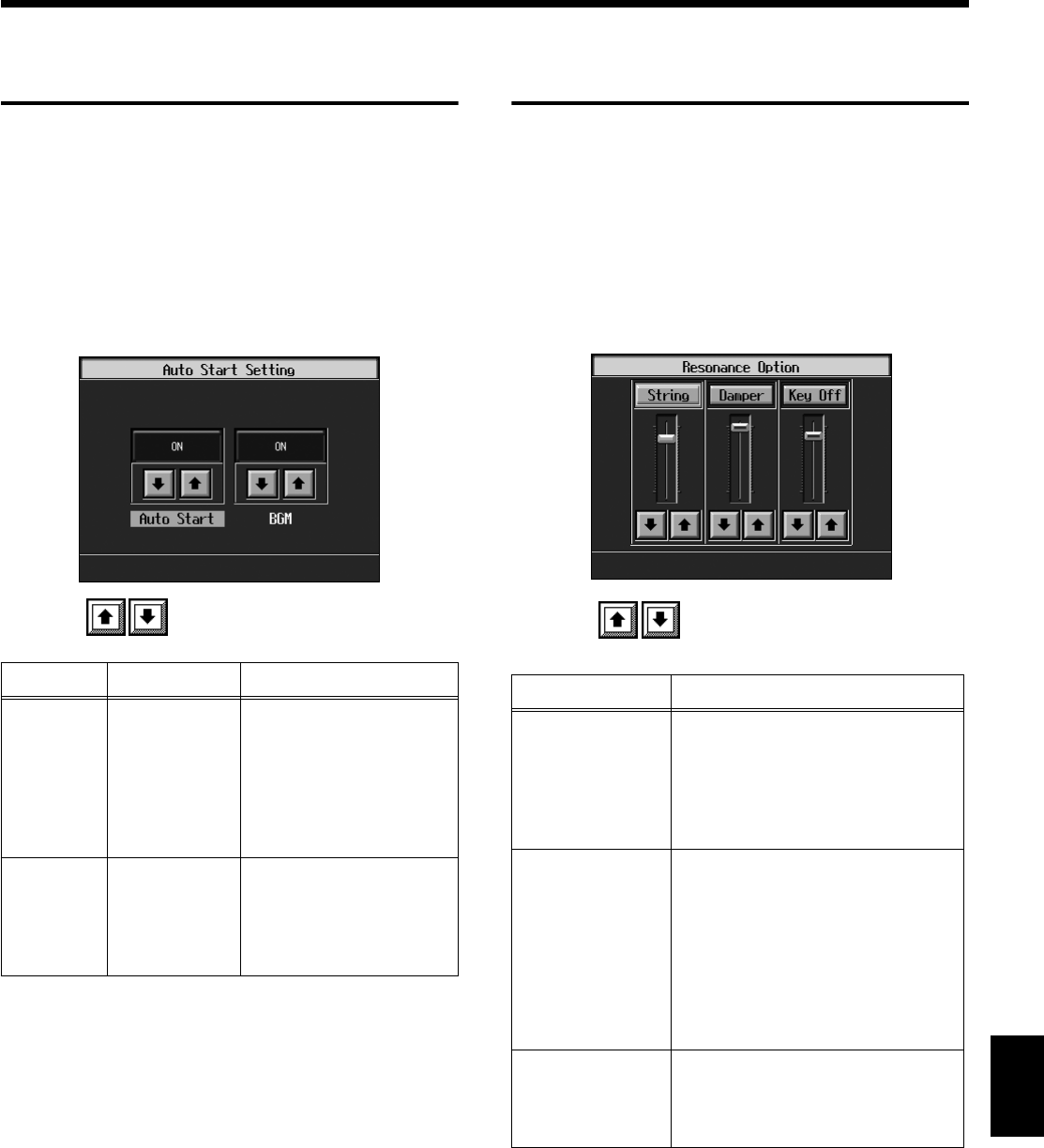
151
Chapter 9 Various Settings
Chapter9
Automatically Starting the
Quick Tour
You can set the instrument so that the Quick Tour starts
automatically with no operation required.
1. Hold down the [Transpose] button and press the
[Ambience/Reverb] button.
The Quick Tour screen appears.
2. Press the [Option] button.
A screen like the one shown below appears.
fig.d-touchpanel.eps_50
3. Touch of each parameter to make settings.
When Auto Start is set to “On,” the demo starts playing
automatically when the KR-107's power is switched on.
The demo stops playing if the instrument is operated in
any way. After operation has ceased, and a period of five
to ten minutes passes without the instrument being
touched, the demo automatically starts again. When
Auto Start is set to “Off,” the demo does not start unless
you touch the icon in the Demo screen.
4. Press the [Exit] button to return to the Quick Tour
screen.
→This setting is saved even after the power is turned off.
* For more information about Quick Tour, refer to the Quick
Start.
Adjusting the Piano Designer
Resonance
You can made precise changes to the Piano Designer
“Resonance” setting.
More of the resonance effect is applied as the value is
increased.
1. Press the [Piano Designer] button.
2. Press the [Option] button.
A screen like the one shown below appears.
fig.d-touchpanel.eps_50
3. Touch of each item to make settings.
Item Display Explanation
Auto Start ON, OFF
This setting determines
whether or not Auto
Demo starts when no
adjustment or other
operation is performed
within a fixed period of
time.
BGM ON, OFF
This setting determines
whether or not
background music is
added when Auto Demo
begins.
Item Explanation
String resonance
With an acoustic piano, playing a
note causes the strings for other keys
already being pressed to resonate.
The function that reproduces this
resonant sound is called “String
Resonance.”
Damper Reso-
nance
When the damper pedal on an
acoustic piano is pressed, the sound
of the key that is played causes other
strings to resonate, adding rich
reverberation and breadth to the
sound. This function reproduces the
resonant sound created by pressing
the damper pedal (Damper
Resonance).
Key-off Reso-
nance
This reproduces the “key off” sound
(the subtle sound made when the
keys are released) produced when
playing an acoustic piano.
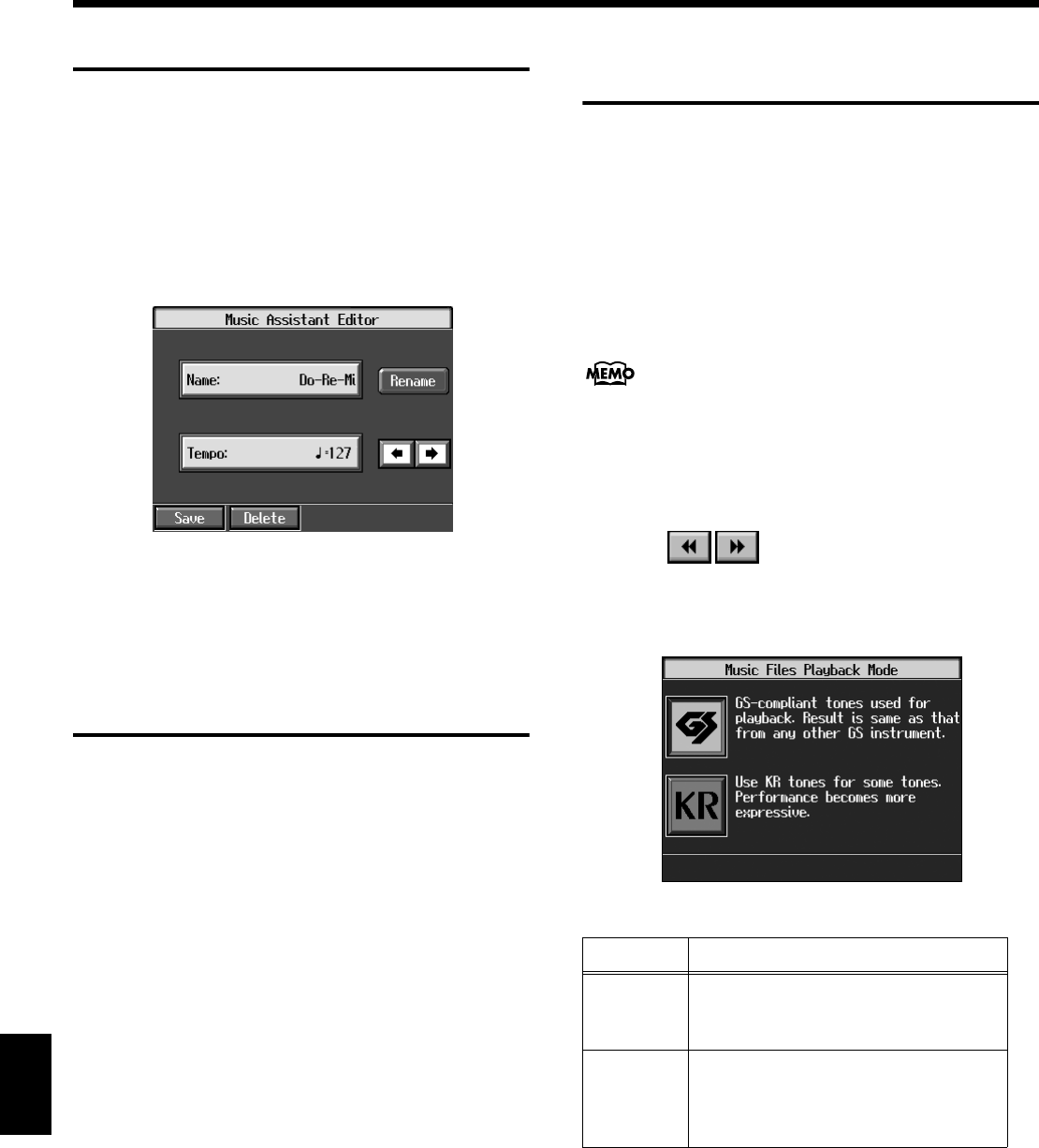
152
Chapter 9 Various Settings
Chapter 9
Registor Music Assistant
1.
2.
3.
4.
Disabling Functions Other
Than Piano Performance
(Panel Lock)
The “Panel Lock” function locks the KR in a state where only
piano performance can be used, and all buttons will be
disabled. This prevents the settings from being inadvertently
modified even if children press the buttons accidentally.
* In the Panel Lock state, only the grand piano sound can be
played.
1. Turn down the volume all the way.
2. Press the [Power] switch to turn off the power.
3. While holding down the [Wonderland/Game] button,
press the [Power] switch and turn on the power.
Then, continue to hold down the button for a few
seconds.
All buttons except for piano play are disabled.
Adjust the volume. When you play the keyboard, the
grand piano sound will be heard.
To undo the Panel Lock function, turn the volume down
to the minimum, and turn on the power once again.
Detailed Song Playback
Settings
■Changing the Tone Settings
When Playing Back Songs
(Play Mode)
With the normal setting, GS tones (sounds that are
compatible with other GS instruments) will normally be used
to play back song data. By changing this setting, you can play
back song using KR-specific tones for certain portions of the
data.
For detailed information about GS, refer to “About the
KR Sound Generator” (p. 183).
1. Press the [Menu] button.
The Menu screen appears.
Touch to switch the screens.
2. Touch <Play Mode>.
A screen like the one shown below appears.
fig.d-plymode.eps_60
3. Touch the icon to choose the setting.
4. Press the [Exit] button to go back to the Menu screen.
5. After changing this setting, try selecting the song once
again.
For more detailed information about selecting a song,
refer to “Playing a Song” (p. 64).
Icon Explanation
GS
Playback uses GS-compatible tones for
performances that sound like other GS
instruments.
KR
Playback uses KR tones for greater
expressiveness. However, differences
may appear when playing back using
devices other than the KR.
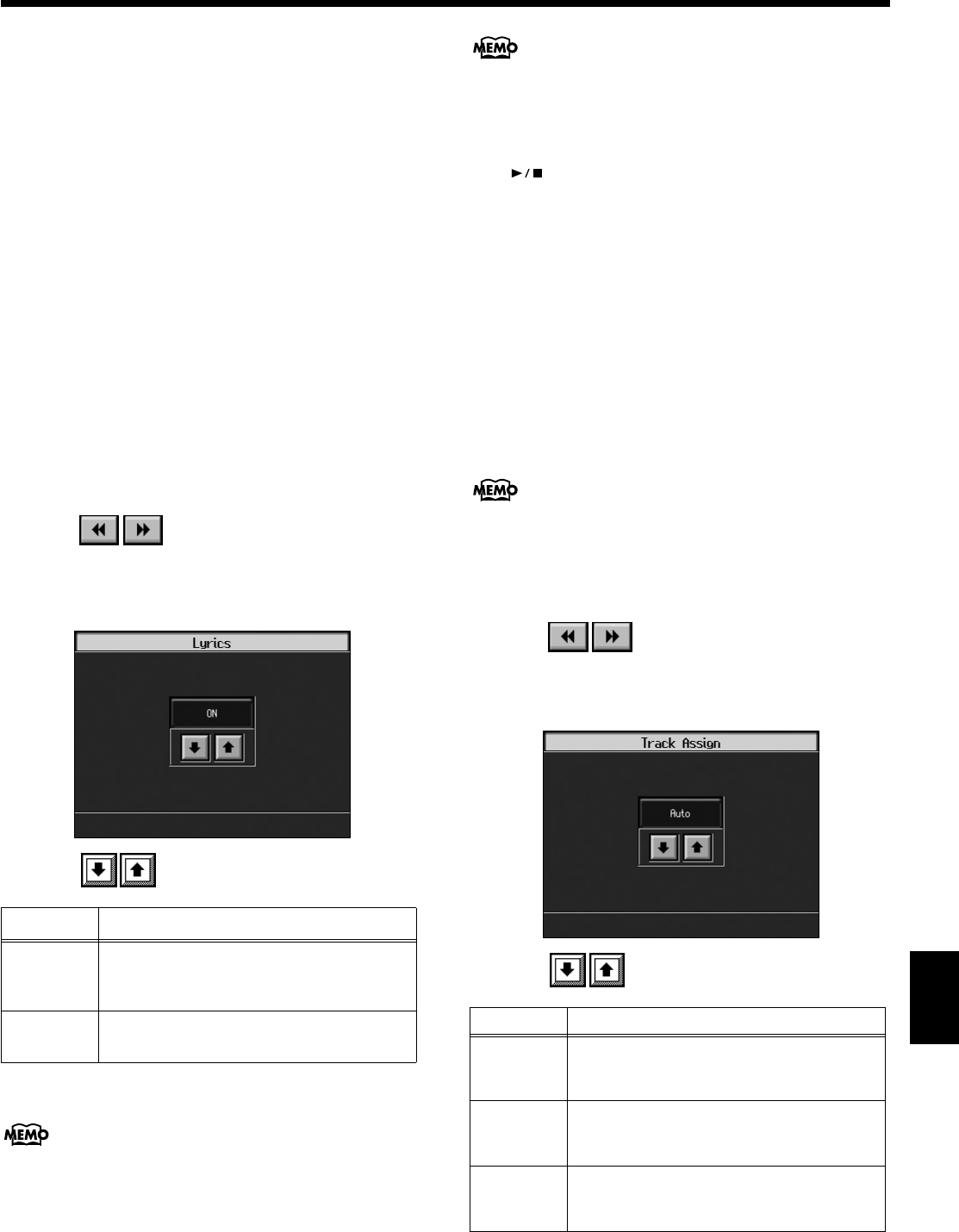
153
Chapter 9 Various Settings
Chapter9
■ Viewing Song Information
(Information)
You can view file names and other information concerning
songs.
1. Press the [Song/File] button.
2. Touch <File>.
3. Touch <Information>.
A song information is displayed.
■Hiding the Lyrics (Lyrics)
Some commercially available music files for use in karaoke,
as well as some of the internal songs include lyrics data.
When you play such music files, the lyrics automatically
appear in the screen. If you do not want lyrics to appear
automatically, set this to “OFF.”
1. Press the [Menu] button.
The Menu screen appears.
Touch to switch the screens.
2. Touch <Lyrics>.
A screen like the one shown below appears.
fig.d-lyric.eps_60
3. Touch to select the setting.
4. Press the [Exit] button to return to the Menu screen.
Even when this is set to “OFF,” you can still have the lyrics be
displayed by touching <lyrics> when it appears in the Piano or
Basic screen (p. 20).
The screen may be switched when you press the button
while the Lyrics screen is displayed. To have the lyrics
displayed again, touch <**~lyrics~**> on the Piano or
Basic screen, or stop playback of the song, then press the
[ (Play/Stop)] button.
■Changing the Parts Assigned
to the Track Buttons During
SMF Playback (Track Assign)
Normally, when playing back Roland Piano Digital-
compatible SMFs (p. 183), the left-hand part is assigned to the
[3/Lower] button, and the right-hand part is assigned to the
[4/Upper] button. However, assignment of the right-hand
and left-hand parts may differ with some SMF data.
If you cannot get the right-hand and left-hand parts to work
well set on “Auto,” then change the setting to “2/1 Part” or
“3/4 Part.”
This setting is effective with SMF format song data.
This is not effective with the internal songs.
1. Press the [Menu] button.
The Menu screen appears.
Touch to switch the screens.
2. Touch <Track Assign>.
A screen like the one shown below appears.
fig.d-trkasgn.eps_60
3. Touch to select the setting.
Display Explanation
ON
Lyrics are displayed automatically (when
performance data containing lyrics is
played back).
OFF Lyrics are not displayed, even if the song
data being played back contains lyrics data.
Display Explanation
Auto
The part assigned to each track will be
determined automatically,
depending on the song data.
2/1 Part
Part 1 will be assigned to the right-hand
track, part 2 to the left-hand track, and part
3 to the user track.
3/4 Part
Part 4 will be assigned to the right-hand
track, part 3 to the left-hand track, and part
1 to the user track.

154
Chapter 9 Various Settings
Chapter 9
4. Press the [Exit] button to return to the Menu screen.
After changing this setting, try selecting the song once
again.
For more detailed information about selecting a song,
refer to “Playing a Song” (p. 64).
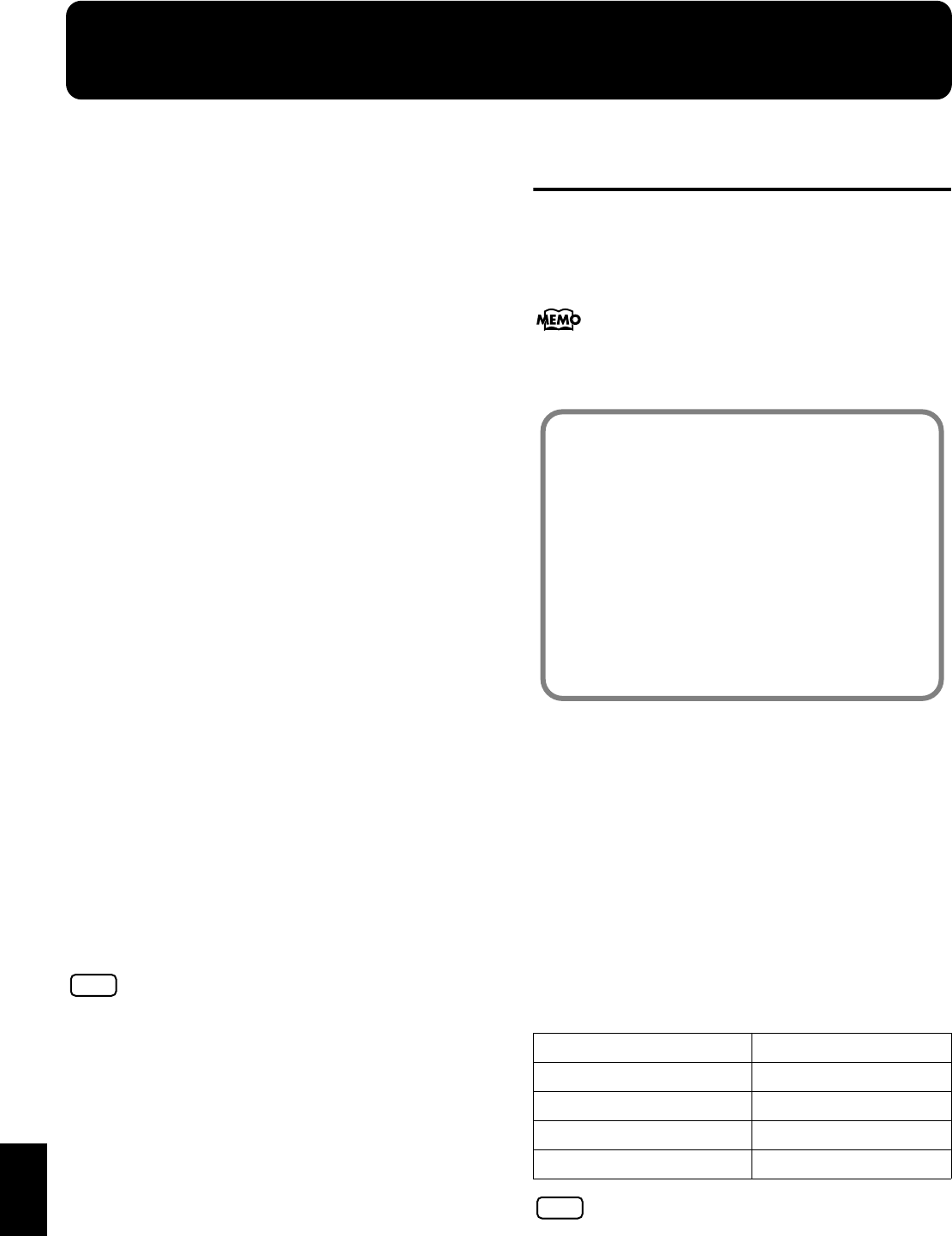
154
Chapter 10
Chapter 10 Connecting External Devices
You can connect the KR to external devices such as audio
equipment, MIDI instruments and computer.
❍ Connecting an External Display or Television
You can connect a computer monitor or other external
display or a television to the KR107, enabling you to display
the Song Select screen, your favorite images, song lyrics, and
notations on a larger screen.
❍ Connecting Video Equipment
With a V-LINK compatible device connected, you can switch
images with the keyboard.
❍Connecting MIDI Devices (p. 158)
You can connect a MIDI sequencer and record performance
data from the KR, or play performance data from the KR on
the sequencer. Also, when you connect a MIDI sound
module, you can perform on the KR and hear the sounds
played through the MIDI sound module.
❍ Connecting Audio Equipment (p. 161)
The KR has high-quality built-in stereo speakers, but you can
also hook it up a stereo system for an even more impressive
sound.
You can also connect it to a tape recorder or other recording
equipment and record your performances.
❍ Connecting a Computer (p. 163)
You can use a sequencer program (such as Roland Visual-
MT) to record performance data from the KR and play
performance data from the program on the KR.
❍Connecting an Expression Pedal
You can connect an expression pedal to the KR.
Insert the pedal cable into the Pedal connector on the
rear panel of the KR107.
925
NOTE
Use only the specified expression pedal (EV-7/5; sold
separately). By connecting any other expression pedals, you risk
causing malfunction and/or damage to the unit.
Connecting an External
Display or Television
You can connect a computer monitor or other external
display or a television to the KR107, enabling you to display
the Song Select screen, your favorite images, song lyrics, and
notations on a larger screen.
You can switch screens with the remote. For details, see
“Using the Remote Control” (p. 32).
For more information about external display settings, refer to
“Selecting What Is To Be Displayed on the External Display
or Television” (p. 50)
■Connecting an External
Display
Displays That Can Be Connected to This
Instrument
In general, a great many of the VGA monitors and multiscan
monitors that are available on the market are compatible
with this instrument. However, before you connect any
monitor, make sure it meets the following specifications:
NOTE
Confirm that the display to be used is compatible with the
frequencies mentioned above. Using a display that is not
compatible with the above frequencies may result in incorrect
image output when images move, and in certain cases may even
damage the display.
Resolution 640 x 480 pixels
Horizontal scan frequency 31.5 kHz
Vertical scan frequency 60 Hz
Connector 3-row, 15-pin D-Sub type
Signal Analog
You cannot simultaneously use both an external
display and a television with the KR107. Moreover,
neither the external display nor the television will be
able to display properly if both are connected at the
same time.
When using an external display, connect the display to
the Ext Display connector, but do not connect a
television to the Video Out connector.
If using a television, connect the television to the Video
Out connector, but do not connect any external display
to the Ext Display connector.
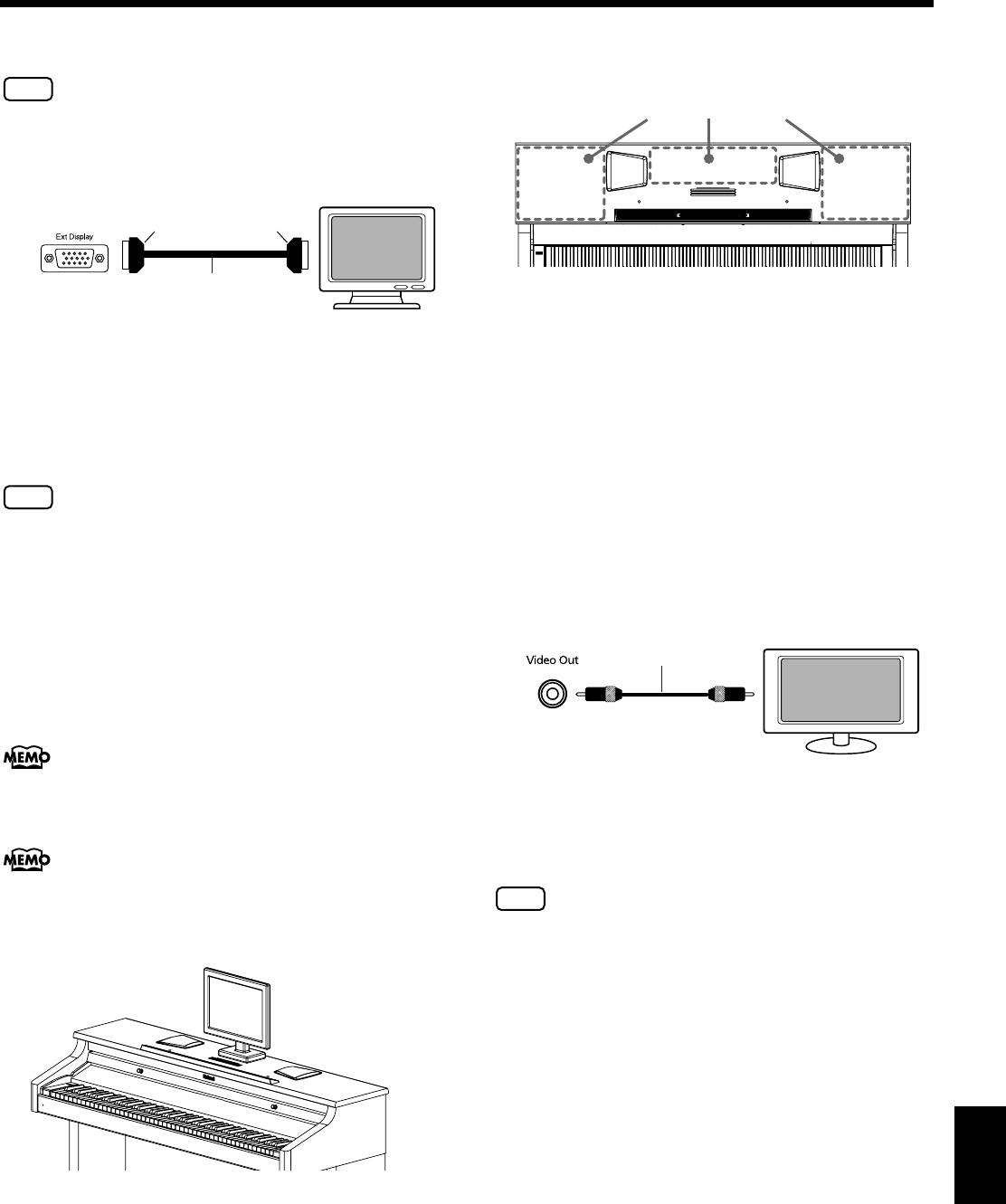
155
Chapter 10 Connecting External Devices
Chapter10
Making the Connections
NOTE
To prevent malfunction and/or damage to speakers or other devices,
always turn down the volume, and turn off the power on all devices
before making any connections.
1. Turn off the power to the KR107 and the display to be
connected.
2. Use display cable (sold separately) to connect the
display to the Ext Display connector on the KR107.
NOTE
You cannot display information or images with an external
display when a television is connected to the Video Out jack. To
use an external display, first disconnect the television from the
Video Out jack, then connect the external display.
3. Switch on the KR107.
4. This sets the display format (p. 157).
5. Switch on the connected display.
For more on handling the external display, refer to your display’s
owner’s manual.
You can also remove the music rest, then place the display there so
that it faces forward. For instructions on removing the music rest,
refer to “Removing the Music Stand” (p. 19).
When using the KR107 with a display placed on it, be sure to
note the following precautions.
• Make sure the display sits stably on the KR107 before
use.
• Do not let the base of the display rest on any of the music
rest’s moving parts. Keep the base of the display within
one of the areas shown by the dotted lines in the
illustration below.
• If you are placing the display on top of the KR, we
recommend using a liquid crystal display (LCD). If using
a cathode ray tube (CRT) display, take extra care to
ensure that the display rests stably on the instrument.
Turning the Power Off
After use, turn off the power using the following procedure.
1. Turn the volume all the way down on the KR107.
2. Turn off the KR107.
3. Turn off the connected display.
■Connecting a Television
Making the Connections
Always be sure to use the following procedure when
connecting a television.
NOTE
You cannot display information or images with a television
when an external display is connected to the Ext Display
connector. To use an television, first disconnect the external
display from the Ext Display connector, then connect the
external display.
1. Turn off the power to the KR107 and the television to
be connected.
2. Use a video cable (sold separately) to connect the
KR107’s Video Out jack with the television’s video
input jack.
3. Turn on the power to the KR107.
4. This sets the display format (p. 157).
5. Turn on the power to the television.
External Display
KR Bottom
Ext Display Connector
D-sub 15 pin
(Mini)
D-sub 15 pin
(Mini)
Display Cable
(Sold separately)
Areas for placing the display
Television
KR107’s Jack Panel
Video Out jack
Video Cable
(Sold separately)
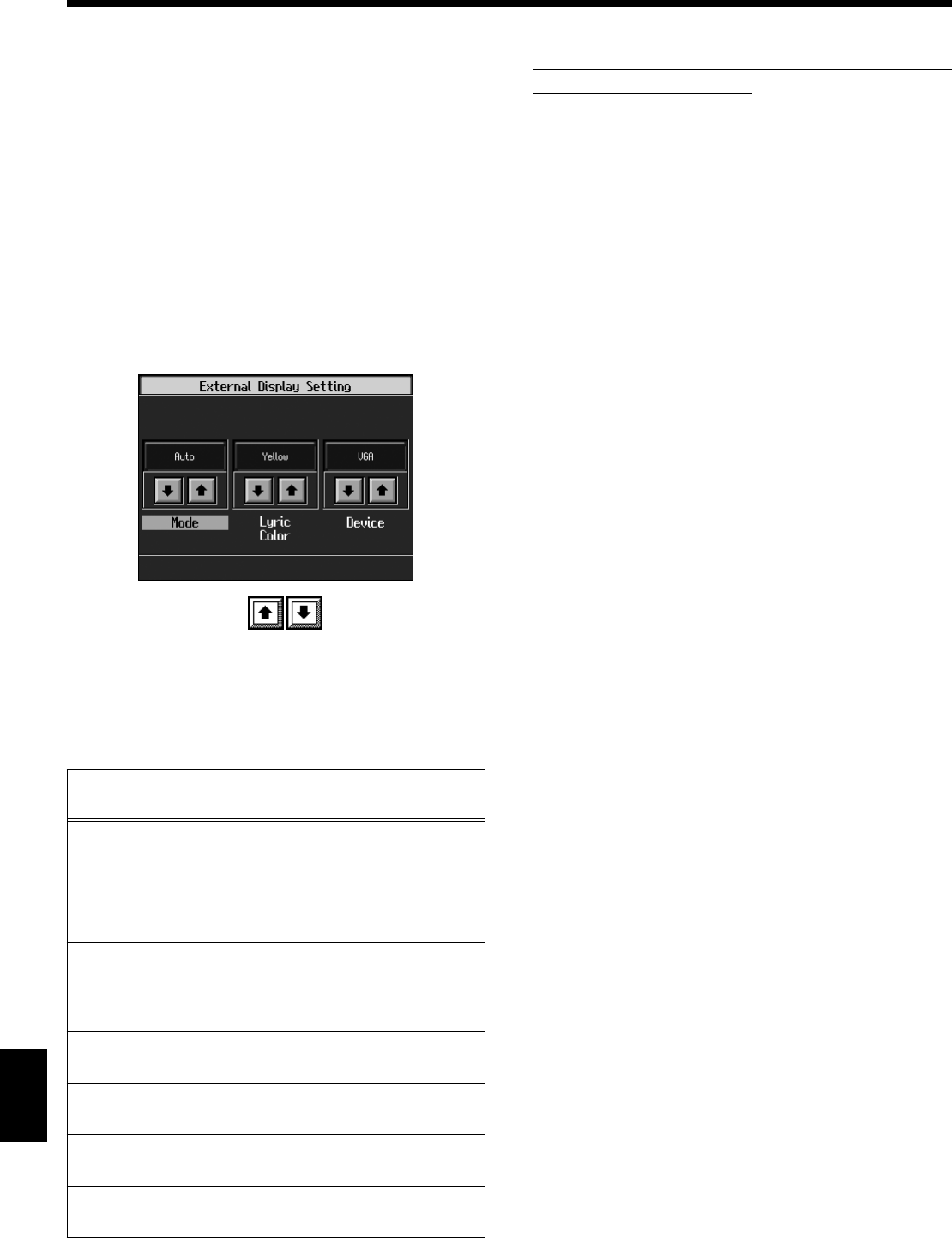
156
Chapter 10 Connecting External Devices
Chapter 10
■Changing the Settings for Showing
Images with the External Display
and the Television (External
Display)
This selects the content shown on the external display or the
television connected to the KR.
1. Switch to the Basic screen, or press the One Touch
Program [Piano] button.
2. Press the [Option] button.
3. Touch <Ext Display>.
A screen like the following appears.
fig.d-extdisp.eps_50
4. Touch the parameter to make the settings.
5. Press the [Exit] button to return to the Function screen.
■Explanation of Each Items
Mode
Notes When Switching the Display on External
Displays and Televisions
• Lyrics are not displayed with audio CDs.
• You cannot display any lyrics screen when playing back
music data that does not include lyrics data.
• The internal songs include a number of jazz pieces that
are played in an improvised fashion, and you may find
notes not conforming to measure lines, odd divisions of
the parts played in the left and right hand, and other
such features that do not match what is shown in the
notation.
Lyric Color
Selects the color used for lyric in the display.
Value: White, Black, Red, Yellow, Green, Blue, Cyan,
Magenta
Device
If you find that the image quality of the television is poor,
try switching the television format.
Value: VGA, PAL, NTSC
Settings
Value Explanation
Auto
The display of notations, lyrics, notation
+ keyboard, and image data are switched
automatically.
Song List The Song select screen is normally
displayed.
Lyrics
The Lyrics screen is normally displayed.
However, lyrics are displayed only when
playing back music files that contains
lyrics data.
Notation The Notation screen is normally
displayed.
Notation and
Keyboard The notation and keyboard are displayed.
Panel Screens are shown the same way they
appear in the KR107's display.
User Image
Display The User Image is normally displayed
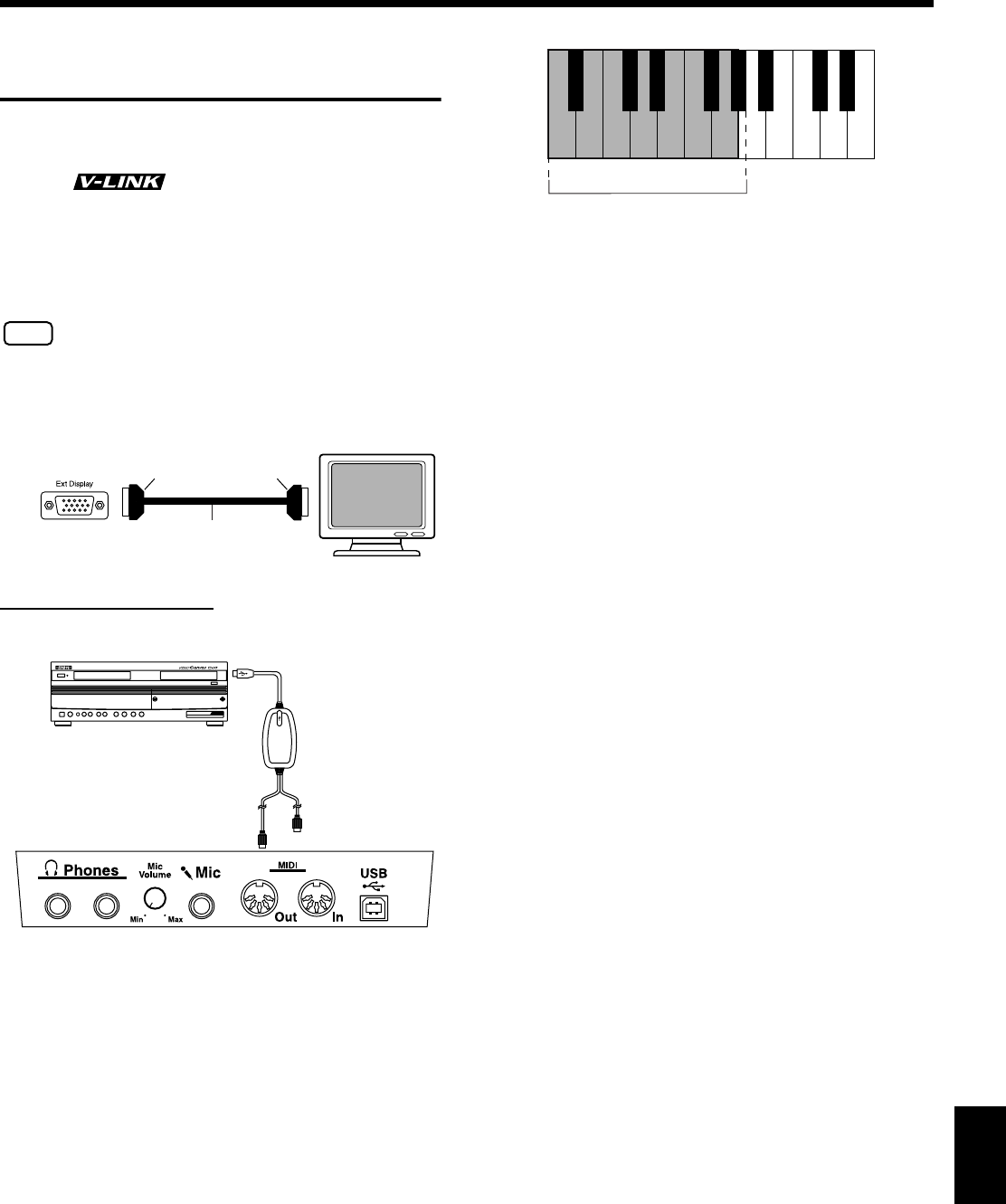
157
Chapter 10 Connecting External Devices
Chapter10
Connecting Video Equipment
(V-LINK)
Connecting the KR107 to a V-LINK compatible image device
allows you to control the images with the KR107.
V-LINK ( ) is functionality promoted by Roland
that allows linked performance of music and visual material.
By using V-LINK-compatible video equipment, visual effects
can be easily liked to, and made part of the expressive
elements of a performance.
921
NOTE
To prevent malfunction and/or damage to speakers or other
devices, always turn down the volume, and turn off the power
on all devices before making any connections.
Connection Examples:
fig.02-
■
Using the V-LINK function
1.
Switch to the Basic screen, or press the One Touch
Program [Piano] button.
2.
Press the [Option] button.
3.
Touch <V-LINK>.
4.
Touch <ON>.
Switches to Image Control mode.
You can control images using the twelve keys at the left
end of the keyboard.
fig.V-LINKkey
While V-LINK is switched on, no sound is produced
when you press any of the twelve keys at the left end of
the keyboard.
5.
Touch <OFF> to cancel the V-LINK function.
External Display
KR Bottom
Ext Display Connector
D-sub 15 pin
(Mini)
D-sub 15 pin
(Mini)
Display Cable
(Sold separately)
KR107
V-LINK compatible image device
USB MIDI Interface
MIDI OUT
C1 D1 E1 F1 G1A0
A0 – G1#
B0
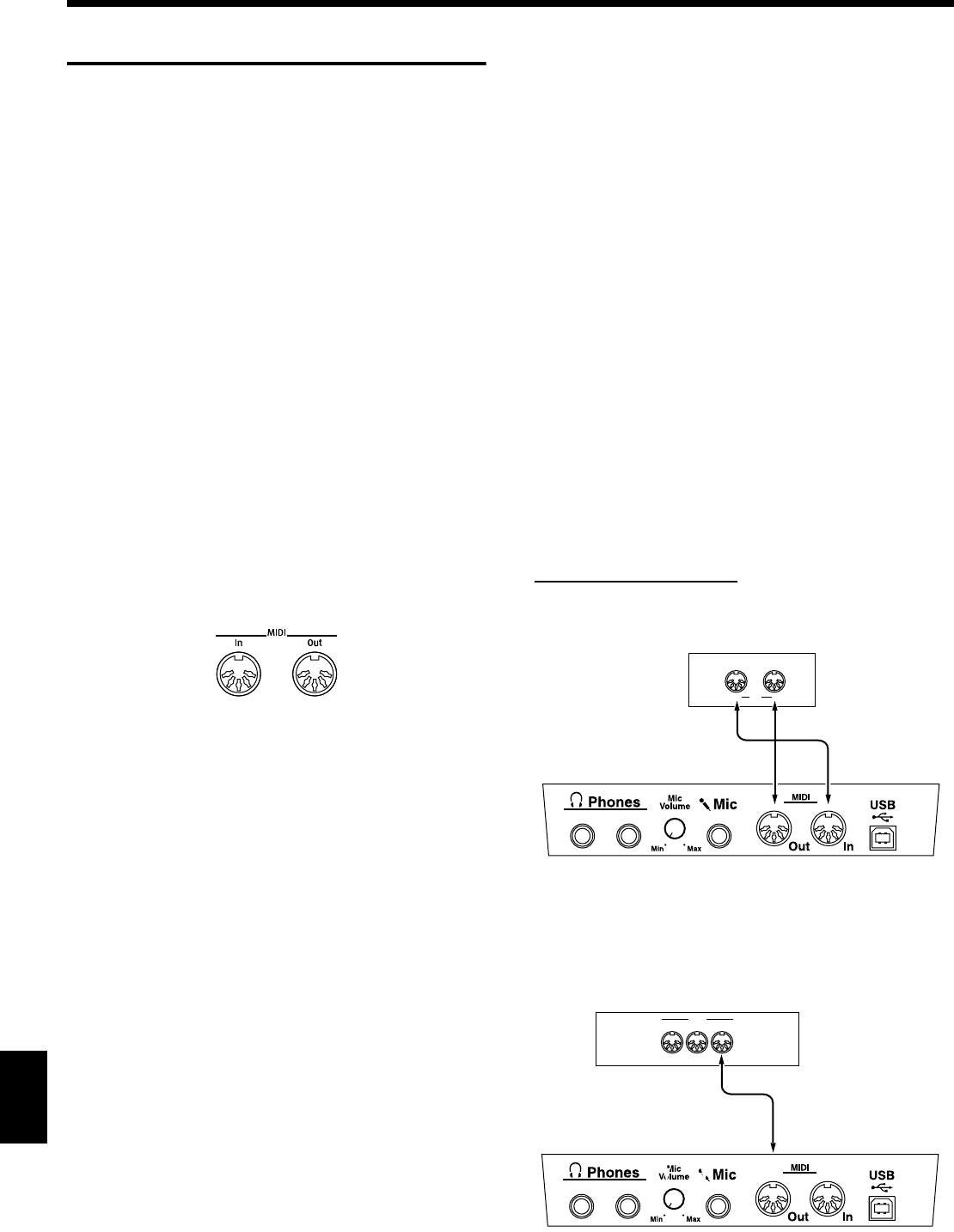
158
Chapter 10 Connecting External Devices
Chapter 10
Connecting MIDI Devices
By connecting an external MIDI device and exchanging
performance data, you can control one device from the other.
For instance, you can output sound from the other
instrument or switch Tones on the other instrument.
What’s MIDI?
MIDI, short for “Musical Instrument Digital Interface,” was
developed as a universal standard for the exchange of
performance data between electronic instruments and
computers.
The KR is equipped with MIDI connectors and a Computer
connector to let it exchange performance data with external
devices. These connectors can be used to connect the KR to
an external device for even greater versatility.
984
* A separate publication titled “MIDI Implementation” is also
available. It provides complete details concerning the way
MIDI has been implemented on this unit. If you should require
this publication (such as when you intend to carry out byte-
level programming), please contact the nearest Roland Service
Center or authorized Roland distributor.
■
Connectors
fig.09-
MIDI Out Connector
Connect this to the MIDI In connector on an external MIDI
device using a MIDI cable (sold separately).
Performance data when you play the keyboard or depress a
pedal is sent from this connector to the external MIDI
connector.
MIDI In Connector
Connect this to the MIDI Out connector on an external MIDI
device using a MIDI cable (sold separately).
This receives MIDI messages that are sent from external
MIDI devices. The KR receiving MIDI messages can output
sounds, exchange tones and perform other operations.
* External MIDI devices can’t be used for remotely changing the
Tones played by the KR’s keyboard.
■
Making the Connections
* To prevent malfunction and/or damage to speakers or other
devices, always turn down the volume, and turn off the power
on all devices before making any connections.
1.
Turn the volume all the way down on the KR and on
the device you’re about to connect.
2.
Switch off the power to the KR and the device you’re
about to connect.
3.
Use a MIDI cable (sold separately) to connect the MIDI
connectors to each other.
Please refer to the connection examples below.
4.
Switch on the power to the KR and the connected
device.
5.
Adjust the volume level on the KR and the connected
device.
6.
You should also set the MIDI settings as needed.
For details on the MIDI-related settings, refer to
p. 159–p. 161.
Connection Examples:
Setup with a MIDI Sequencer
fig.09-10
* When the KR is connected to a MIDI sequencer, set it to Local
OFF. Refer to “Disconnecting the Keyboard from the Internal
Sound Generator (Local On/Off)” (p. 160).
Connecting with a MIDI Sound Module
fig.09-
InOut MIDI
Roland MT Series
KR107
OUTTHRU IN
MIDI
Sound Module
KR107
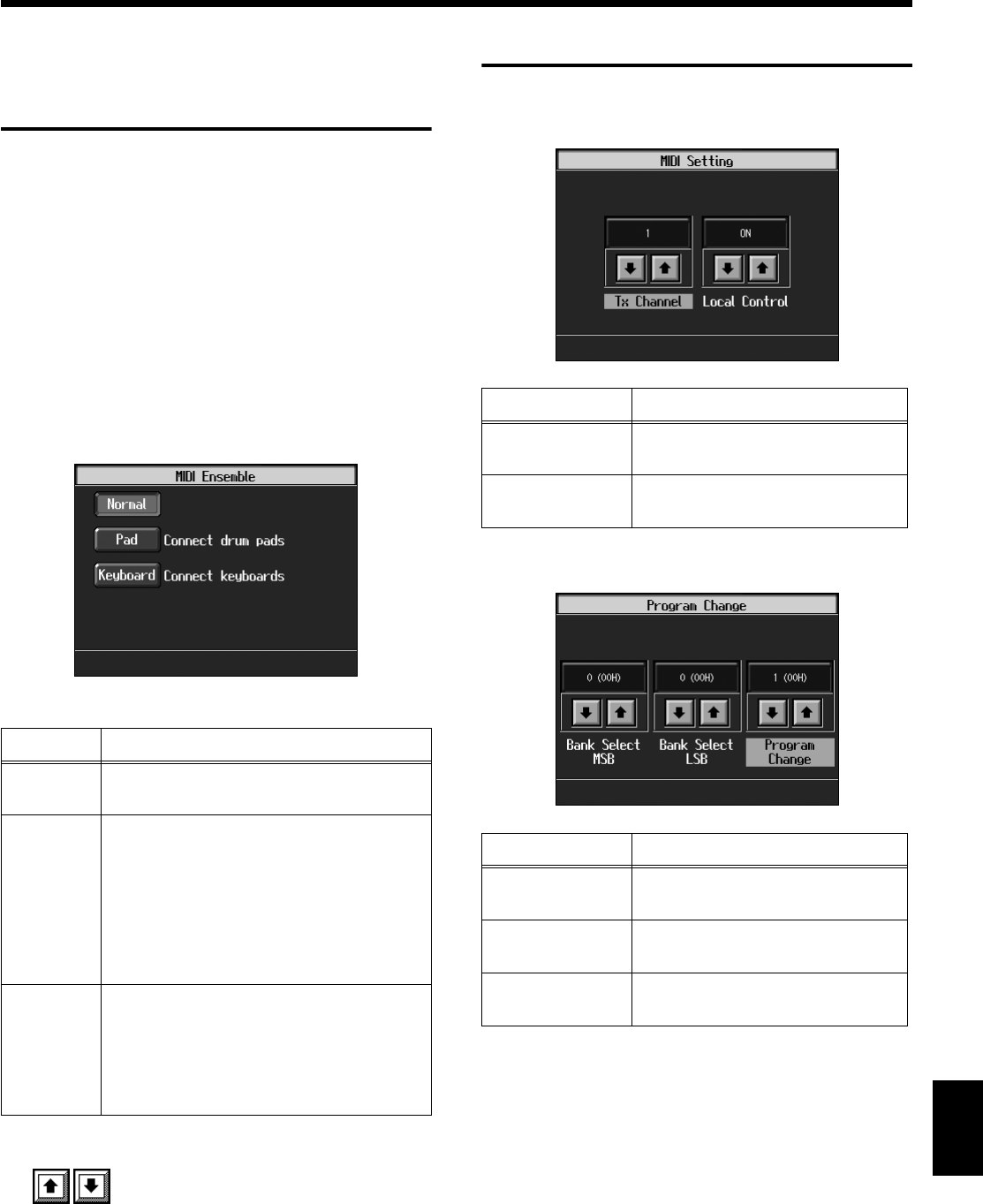
159
Chapter 10 Connecting External Devices
Chapter10
Performing in Ensemble with
MIDI Instruments
(MIDI Ensemble)
You can connect an electronic percussion device or other
MIDI instrument to the KR’s MIDI In connector for ensemble
playing. Making the MIDI settings for the instrument
connected to the MIDI In connector is easy. The sounds from
the connected MIDI instrument are played from the KR’s
speaker.
1.
Switch to the Basic screen, or press the One Touch
Program [Piano] button.
2.
Press the [Option] button.
3.
Touch <MIDI Ensemble>.
A screen like the following appears.
fig.09-04.eps
4.
Select the method for using the MIDI In connector.
5.
When “Keyboard” is selected in Step 4 above, use
to select the Tone.
The connected keyboard plays using the selected Tone.
MIDI Settings
You can make MIDI settings like those described below.
“MIDI Setting Screen”
fig.09-04.eps
“Program Change Screen”
fig.09-04.eps
Displayed Meaning
Normal
Normal setting. Make changes in Tone and
other settings from the connected device.
Pad
Select this when you have percussion pads
(such as Roland’s SPD-20 Total Percussion
Pad) connected to the KR’s MIDI In
connector. You do not need to make any
MIDI settings on the KR. Select pad Tones
and make other settings from the connected
pads (for further details, refer to the Owner’s
Manual provided with the pads).
Keyboard
Select this when you have a keyboard (such
as a Roland A-37 or AX-7 MIDI Keyboard
Controller) connected to the KR’s MIDI In
connector. You can select tones for the
connected keyboard from the KR. No MIDI
settings need be made on the KR.
Display Explanation
Tx Channel
Chooses the MIDI send channel
(p. 160).
Local Control
Switches Local Control on or off
(p. 160).
Display Explanation
Bank Select MSB
Sends Bank Select MSB messages
(p. 161).
Bank Select LSB
Sends Bank Select LSB messages
(p. 161).
Program Change
Sends Program Change messages
(Program Numbers) (p. 161).
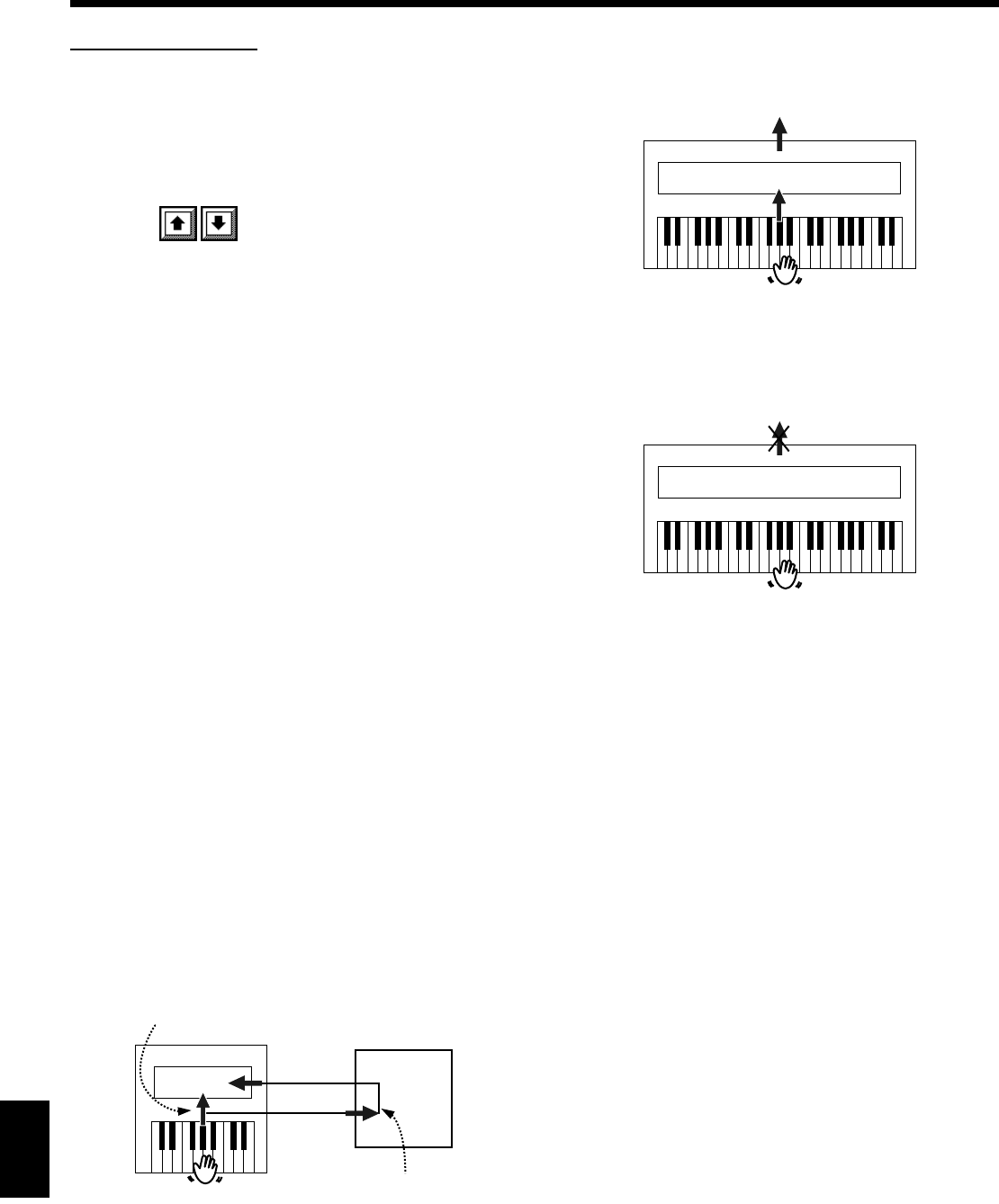
160
Chapter 10 Connecting External Devices
Chapter 10
Making the Settings
1.
Switch to the Basic screen, or press the One Touch
Program [Piano] button.
2.
Press the [Option] button.
3.
Touch <MIDI Setting> or <Program Change>.
4.
Touch to make the setting for each
item.
Press the [Exit] button to return to the Functions screen.
■
Selecting the Transmit Channel
(Tx Channel)
MIDI organizes things into “channels,” which are numbered
from 1 through 16. Simply connecting a cable is not enough
for communication to take place. The connected devices must
be set to use the same MIDI channels. Otherwise, no sound
will be produced, and no sounds can be selected.
Select the transmit channel (1–16) of the KR.
The channel setting is at “1” when the KR is powered up.
If the keyboard has been split into right-hand and left-hand
sections, messages from the left-hand section are fixed at “3.”
The KR receives messages on all channels from 1 through 16.
■
Disconnecting the Internal
Sound Generator and
Keyboard (Local Control)
When connecting a MIDI sequencer, set Local Control to
“OFF.” The setting is at “Local Control ON” when the KR is
powered up.
As illustrated, information describing what has been played
on the keyboard is passed to the sound module over two
different routes, (1) and (2). As a result, you hear overlapping
or intermittent sounds. To prevent this from happening,
route (1) must be disabled, by setting the unit to what is
known as “Local Off.”
fig.09-
Local On
: The keyboard and internal sound generator are
connected.
fig.09-
Local Off
: The keyboard and internal sound generator are
separated. No sound will be produced by the keyboard when
it is played.
fig.09-
→
When connecting a unit in the Roland MT series, you don’t
need to switch off Local Control. MT units transmit Local Off
messages when their power is switched on. First turn on the
power to the KR-107, then after a few moments, play a note on
the KR-107; when you turn on the power to the MT Series
device, Local Off is automatically enabled for the KR-107.
(1)
MIDI
MIDI
MIDI
MIDI
(2)
IN
IN OUT
OUT
Sequencer
Memory
Sound
Generator
Each note played is sounded twice Soft Tru On
Local On
Local On
Sound is emitted
Sound Generator
Local Off
No sound produced
Sound Generator
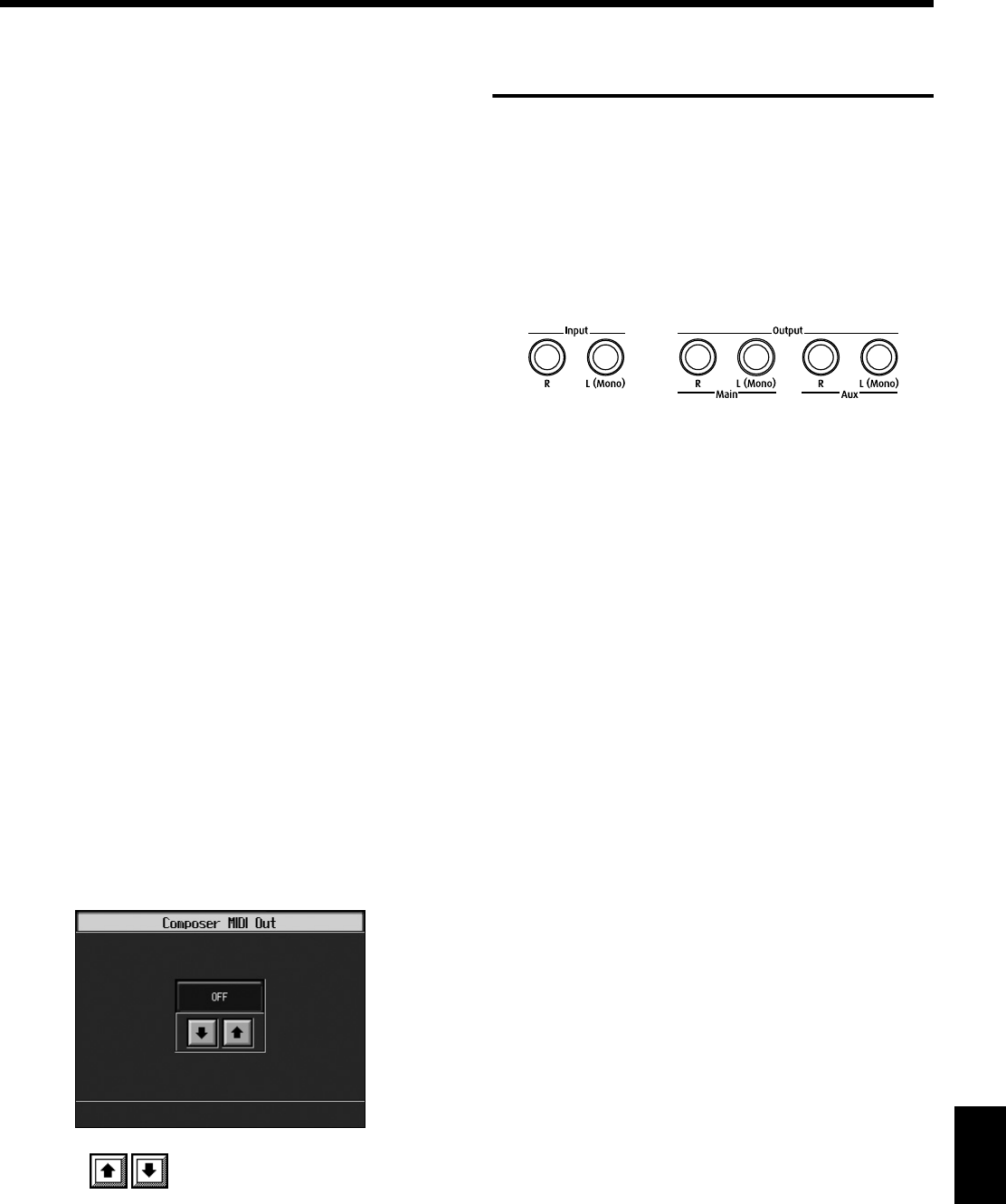
161
Chapter 10 Connecting External Devices
Chapter10
■
Sending Tone Change Messages
(Program Change/Bank Select
MSB/Bank Select LSB)
A Program Change is a message that means “change to the
Tone of the specified number.” The device that receives this
changes to the Tone of the corresponding number.
When you choose a Program Change message (Program
Number), the Program Number will be transmitted to the
MIDI device connected to the KR. The MIDI device that
receives the Program Number changes the tone to the
corresponding Program Number.
Normally, the Tone is selected from the 128 Tones available.
Some MIDI devices, however, have more than 128 Tones.
With such devices, the Tone is selected through a
combination of Program Change messages and Bank Select
messages. There are two parts of a Bank Select message: the
MSB (Controller 0, with a value of 0–127) and the LSB
(Controller 32, with a value of 0–127).
* Some MIDI instruments can’t handle Bank Select messages.
Others can handle Bank Selects, but do not recognize the LSB
part.
■
Sending Recorded
Performance Data to a MIDI
Device (Composer MIDI Out)
When Composer Out is active, you can send performance
data recorded with the KR to a connected MIDI device or
computer.
When you turn on the power, this is set to “OFF” (data is not
sent).
1.
Press the [Menu] button.
2.
Touch <Composer MIDI Out>.
fig.09-04.eps
3.
Touch to set ON or OFF.
4.
Press the [Exit] button to return to the Menu screen.
Connecting to Audio
Equipment
When you connect the KR to audio equipment, you can play
the sounds from the KR through the speakers on the audio
equipment or record your performances on a tape recorder
or other recording device.
When connecting, please use audio cables (sold separately)
with standard phone plugs.
■
Connectors
fig.09-
Output (Main) Jacks
You can connect audio equipment using audio cables (sold
separately) and play the sounds from the KR through the
speakers on the connected equipment, or record your
performances on a tape recorder or other recording device.
If the input of the connected device is monaural, you must
use the L (Mono) jack.
Input Jacks
You can connect another sound source, such as audio
equipment or an electronic instrument, using audio cables
(sold separately). Play the sounds from the connected device
through the speakers on the KR.
If the input of the connected device is monaural, you must
use the L (Mono) jack.
* You cannot use the KR to adjust the volume of the connected
sound generating device.
926a
* When connection cables with resistors are used, the volume
level of equipment connected to the inputs jacks may be low. If
this happens, use connection cables that do not contain
resistors, such as those from the Roland PCS series.
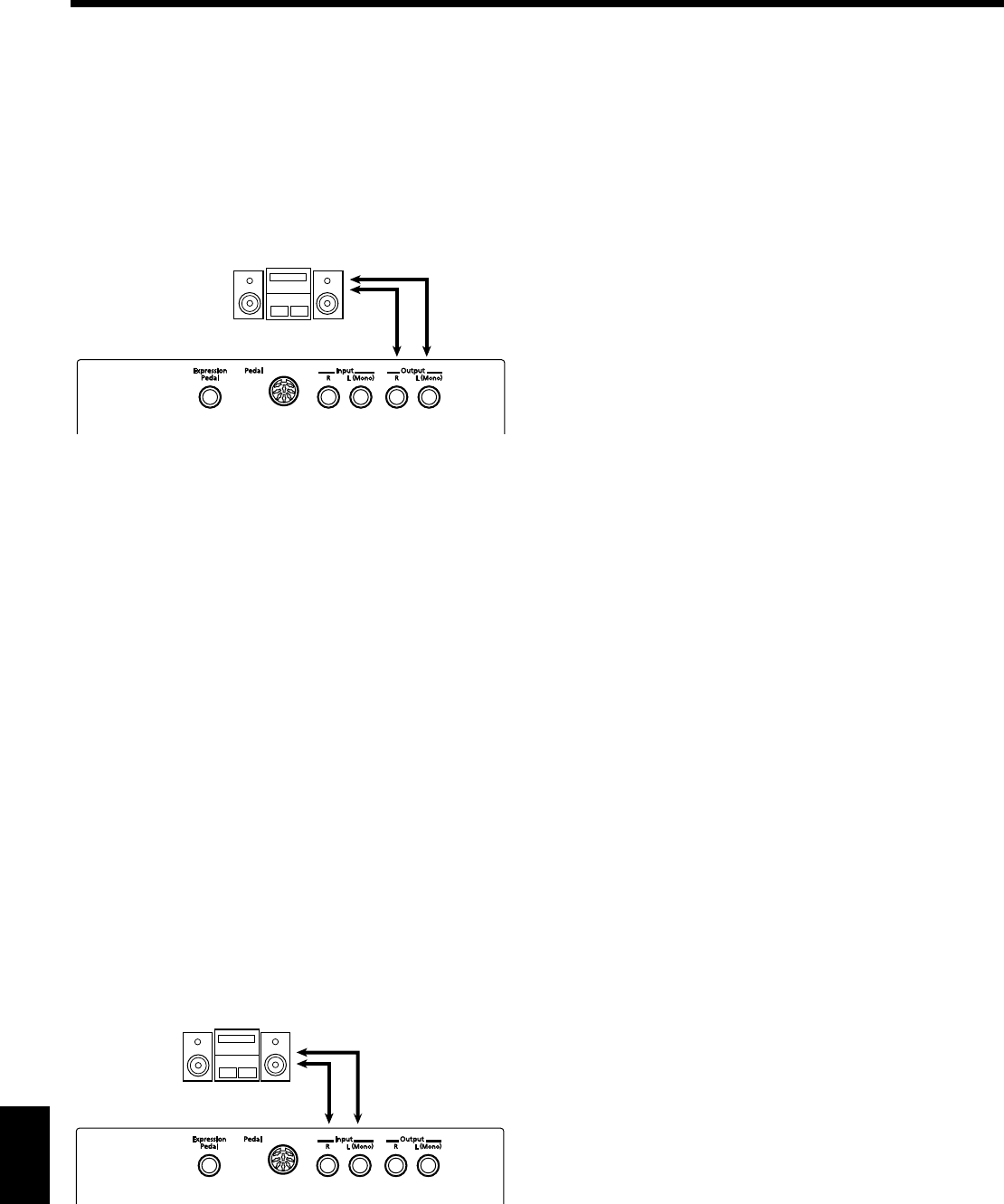
162
Chapter 10 Connecting External Devices
Chapter 10
■
Making the Connections
* To prevent malfunction and/or damage to speakers or other
devices, always turn down the volume, and turn off the power
on all devices before making any connections.
Playing Sounds from the KR Through the Speakers
on Audio Equipment or Recording Your
Performances on a Recording Device
fig.09-
1.
Turn the volume all the way down on the KR and on
the device you’re about to connect.
2.
Turn off the power to the KR and other connected
equipment.
3. Use audio cables (sold separately) to make the
connection.
4. Switch on the KR.
5. Switch on the connected device.
6. Adjust the volume level on the KR and the connected
device.
Recording KR Performances on a Recording Device
7. Start recording with the connected device.
8. Play the keyboard.
9. When the performance ends, stop recording on the
connected equipment.
Playing Audio Equipment Sounds Through the
Speakers on the KR
fig.09-
1. Turn the volume all the way down on the KR and on
the device you’re about to connect.
2. Turn off the power to the KR and other connected
equipment.
3. Use audio cables (sold separately) to make the
connection.
4. Turn on the connected equipment.
5. Turn on the KR.
6. Adjust the volume level on the KR and the connected
device.
After use, turn off the power using the following procedure.
1. Turn the volume all the way down on the KR and on
the device you’re about to connect.
2. Turn off the KR.
3. Turn off the connected equipment.
Input R/L
(Line In, Aux In)
KR107
Output R/L
(Line Out)
KR107
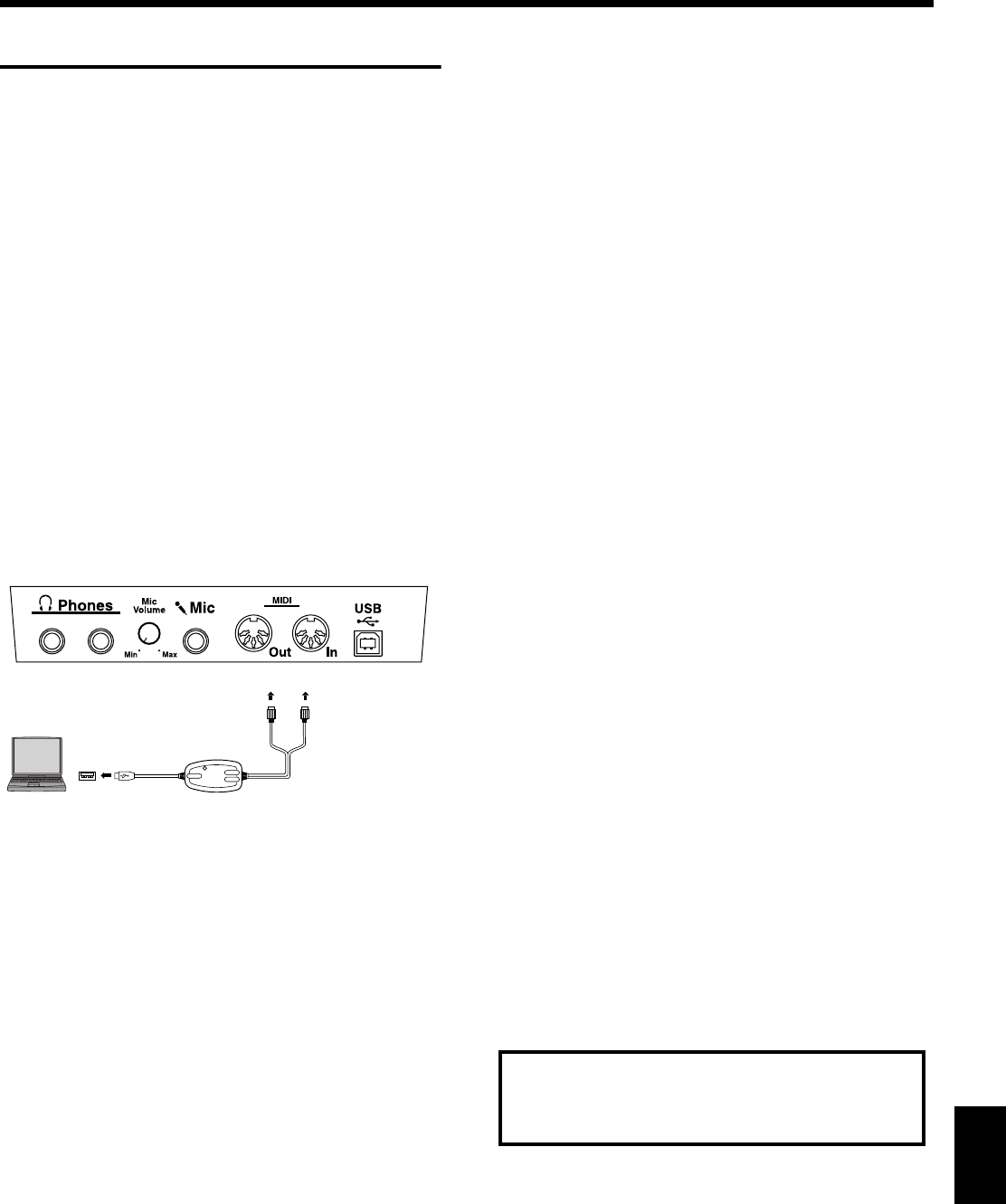
163
Chapter 10 Connecting External Devices
Chapter10
Connecting a Computer
■Connect to the MIDI Connectors
You can use a USB MIDI interface cable (sold separately) to
connect the KR to your computer.
If the KR is connected to a computer in which sequencer
software such as Roland’s “Visual MT” is installed, a song
you’ve recorded on the KR can be saved on your computer.
Connection examples
* To prevent malfunction and/or damage to speakers or other
devices, always turn down the volume, and turn off the power
on all devices before making any connections.
* In order to make connections to your computer, you must
install “MIDI driver” software on your computer. For details,
refer to the owner’s manual for your MIDI interface.
Use a USB MIDI interface cable to connect the USB
connector of your computer to the MIDI connectors of
the KR.
fig.comp.e
■Connect to the USB Connector
You can connect you computer with a USB cable to the USB
connector, located on the left underside of the KR-107, and
exchange MIDI data between the instrument and the
computer. You can use the KR to play SMF data created with
the computer and exchange performance data in the same
manner as with MIDI devices connected to the MIDI
connectors.
Connecting your computer to the KR107 for the first time requires
installation of the “USB Driver” (on the included CD-ROM) to the
computer.
The correct driver and the installation procedure will depend on
your system and on the other programs you are using. Be sure to
read the Readme file on the CD-ROM before installation.
Windows XP/2000
→ \W2kXP\Readme_E.htm
Windows Me/98/98SE
→ \W98Me\Readme_E.htm
Mac OS X
→ \Driver (Mac OS X)\Readme_e.htm
* Only MIDI data can be transmitted using USB.
* To prevent malfunction and/or damage to speakers or other devices,
always turn down the volume, and turn off the power on all devices
before making any connections.
* USB cables are not included. Consult your Roland dealer if you need
to purchase.
* Turn on the power to the KR107 before starting up MIDI applications
on the computer. Do not turn the KR107 on or off while any MIDI
application is running.
* If not using USB, disconnect the USB cable from the KR107.
* If during the transmission/reception of data, the computer switches to
energy-saving mode or suspended mode, or if the KR107’s power is
switched on or off, the computer may freeze, or the KR107’s operation
may become unstable.
* Do not connect or disconnect the USB cable while the KR107’s power
is on++++++++++++.
USB MIDI Interface
Computer
MIDI IN
MIDI OUT
USB Connector
of your Computer
Bottom left of the KR
For more on system requirements, refer to the “USB
Installation Guide.” However, note that the KR107 is
not compatible with Mac OS 9.
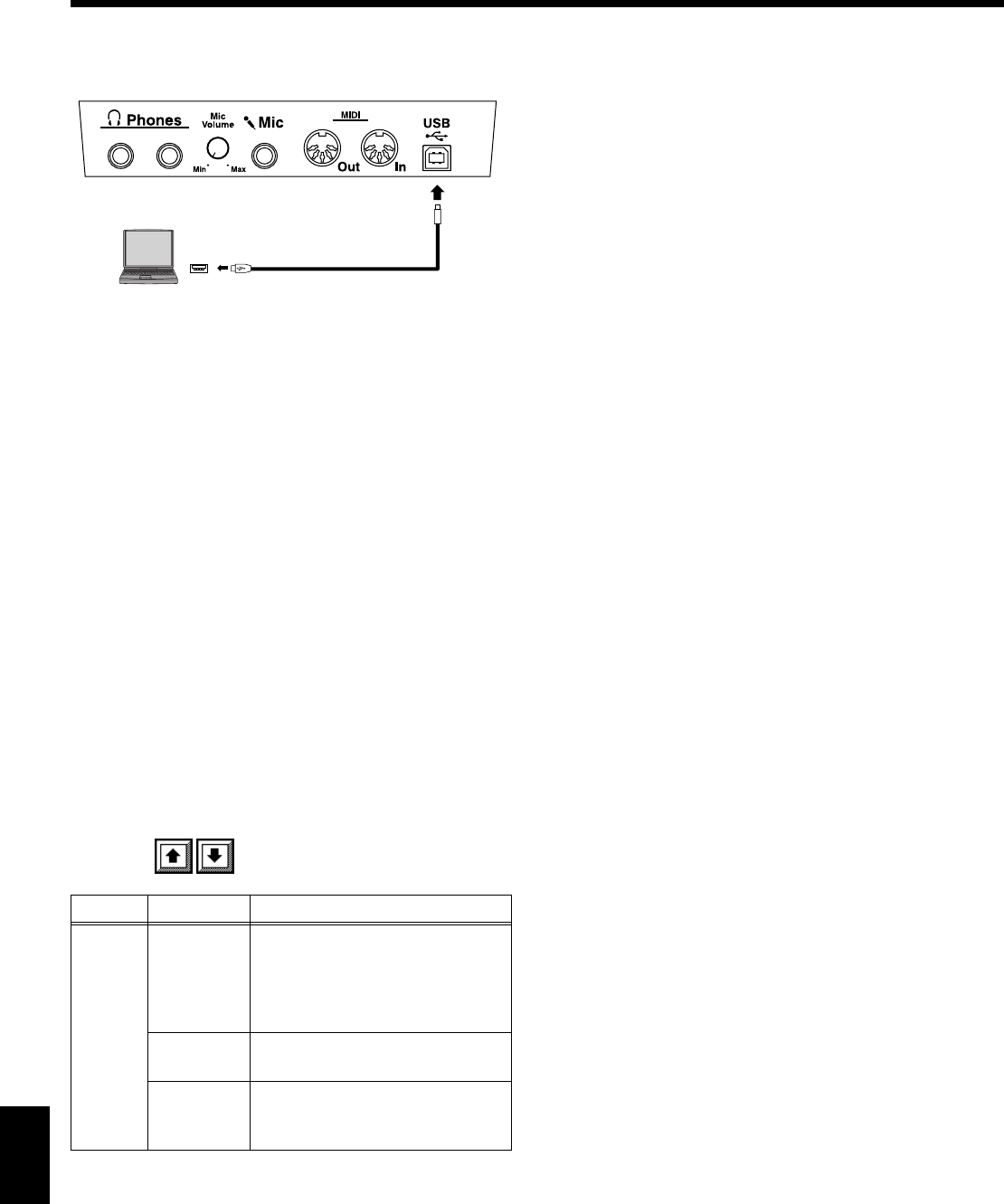
164
Chapter 10 Connecting External Devices
Chapter 10
Connection examples
fig.comp.e
1. Turn off the power to the KR107 and the computer.
2. Start up the computer.
3. Connect the KR-107 and the computer with a USB
cable.
4. Turn on the power to the KR-107.
→ Refer to the owner's manual that came with your computer
■Making the Settings for the
USB Driver
This sets the USB driver used when you have a computer
connected to the USB connector.
1. Open the Basic screen or press the One Touch [Piano]
button.
2. Touch the [Setting] button.
3. Touch <USB Driver>.
4. Touch to select the driver type.
5. After changing the settings, turn the power off, then on
again.
Indication Description
USB
Driver
Original
Select this when using the
supplied driver with a USB
connection.
Under ordinary circumstances,
use this mode.
Original 2 This is an auxiliary mode.
It is not normally used.
Generic
Select this when using a generic
USB driver included with the OS
with a USB connection.
Computer
USB connector
USB Connector
of your Computer
Bottom left of the KR
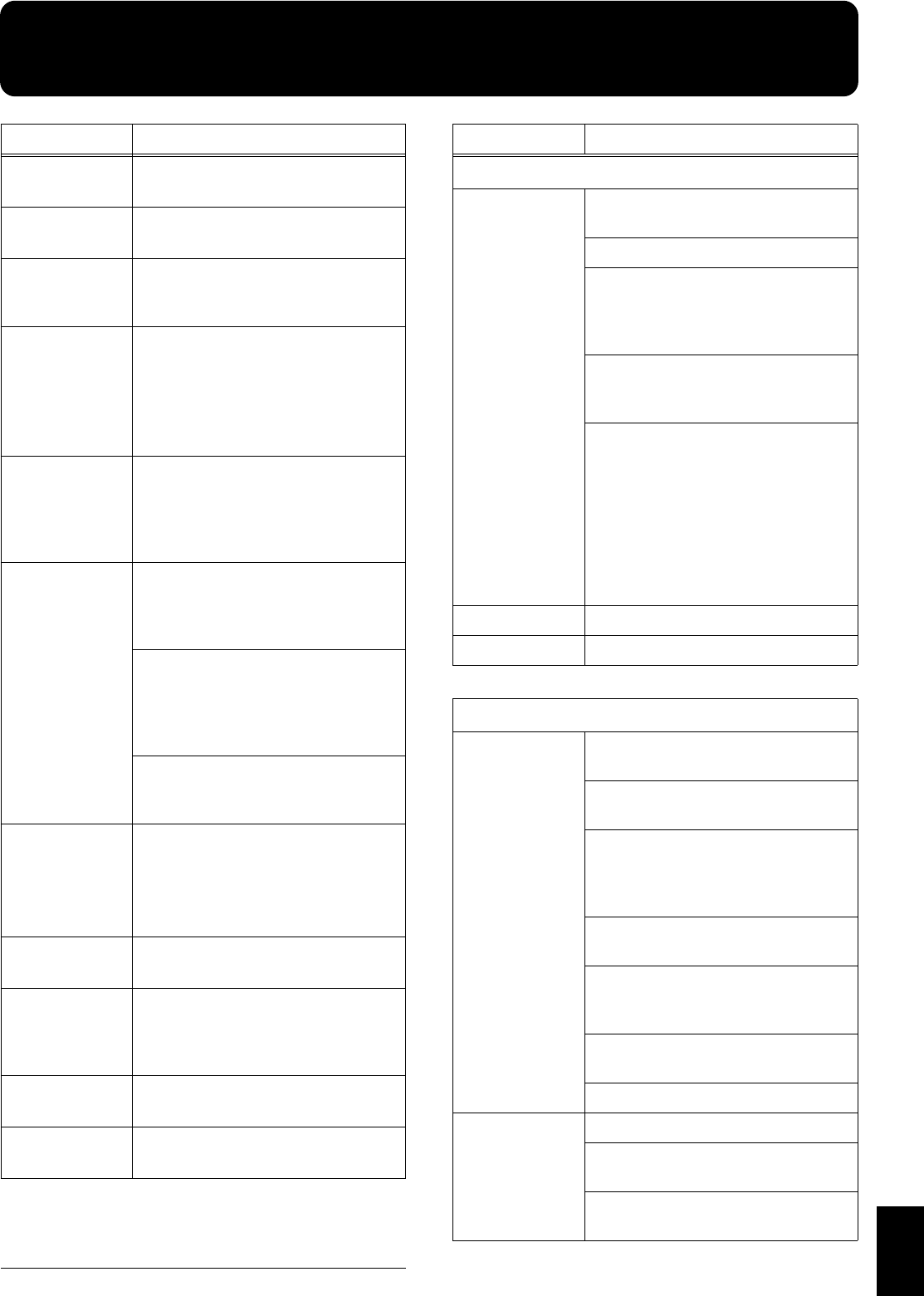
165
Appendices
Troubleshooting
Case Cause/Remedy
The power doesn’t
come on
Is the power cord connected and plugged
in correctly? (p. 16)
The button doesn’t
work
Is the panel locked? (p. 152)
Turn the power off, then back on.
Nothing appears
on screen
The KR uses a liquid-crystal screen, so text
may not be displayed when the ambient
temperature is below freezing.
Vertical lines
appear in the
screen/Color is
“washed out” at the
edges of the
screen
These occur due to the nature of a liquid
crystal display, and do not indicate a
malfunction. They can be minimized by
adjusting the brightness of the screen (p.
19).
The touch screen
doesn’t respond
correctly
The positioning of the touch screen may
become displaced if some time has passed
since it was last used. Take a look at
“Calibrating the Touch Screen (Touch
Screen)” (p. 149) to correct the positioning.
Depressing a
pedal has no
effect, or the pedal
effect doesn’t stop
Is the pedal connected correctly?
Make sure the pedal cord extending from
the stand is securely connected to the pedal
connector on the rear of the unit (p. 16).
Has a different function been assigned to
the pedal?
See “Assigning Functions to Pedals and
Performance Pads (Pedal Setting/User
Functions)” (p. 142).
Normal pedal operation is automatically
enabled when the One Touch Program
[Piano] button is pressed (p. 18).
The volume level
of the instrument
connected to Input
jacks is too low
Could you be using a connection cable that
contains a resistor?
Use a connection cable that does not
contain a resistor.
926b
external
memory+++++ ++++++++++++
Low hum coming
from external
device
Do you have different external devices
plugged into different power outlets?
When connecting external devices, always
draw power from the same outlet.
Mic volume has
changed+++++ Vocal Effect++++++++++++
Remocon is not
affected+++++ ++++++++++++
+++++++++++
Images not shown
on external display
when external
display is
connected
Is the external display properly connected (p.
154)?
Is the external display’s power turned on?
Are you using a display that is compatible
with the KR?
Refer to “Displays That Can Be Connected
to This Instrument” (p. 154).
Do you have a television and external
display connected at the same time?
Connect only one of these.
Are the KR’s settings correct?
Follow the instructions in “Selecting
Images To Be Shown on the KR and
External Displays (User Image Display)”
(p. 146) to set the “External Display” image.
Also refer to “Changing the Settings for
Showing Images with the External Display
and the Television (External Display)” (p.
156).
yokosen+++++ ++++++++++++
television+++++ ++++++++++++
No sound is heard
No sound is heard
Is the volume level of the KR (p. 18) or
connected device turned all the way down?
Are headphones plugged in? (p. 18)
+++++++++++
Has the Balance knob been moved all the
way to the right or left?
Has the volume been set to “0” using the
Part Balance? (p. 62)
Are all sliders in the Equalizer screen at the
minimum level? (p. 33)
Has the footage been adjusted so that all
frequency components aren’t sounded? (p.
15 in the Quick Start)
Is the speaker cable connected and plugged
in correctly?
V-LINK++++++++++++
No sound is heard
(when a MIDI
instrument is
connected)
Have all devices been switched on?
Are the MIDI cables connected correctly?
(p. 158)
Does the MIDI channel match the
connected instrument? (p. 160)
Case Cause/Remedy
Appendices
If you think there’s a problem, read this first.
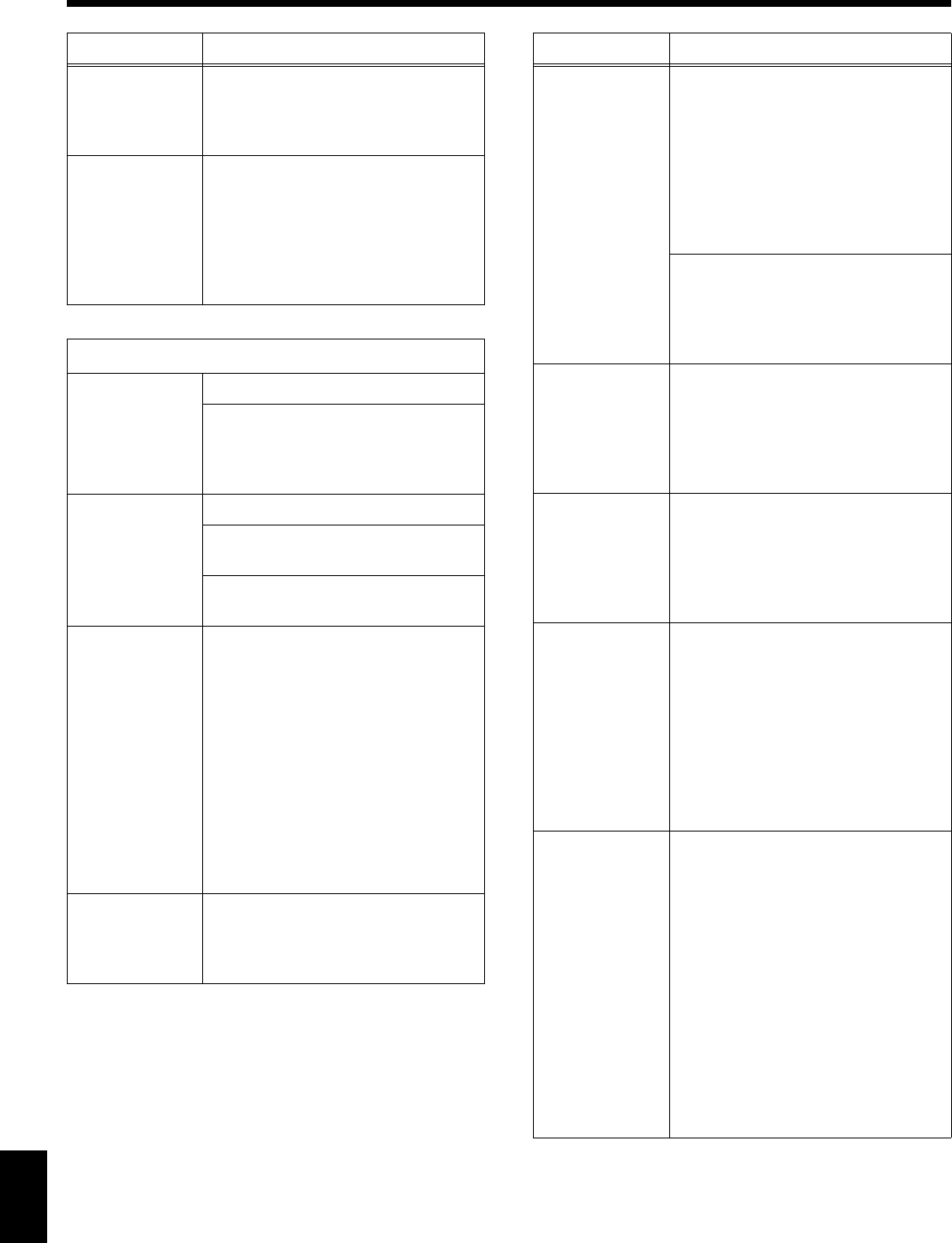
166
Troubleshooting
Appendices
No sound is heard
when the keyboard
is played
Has Local Control been set to “Off”?
When Local Control is set to Off, no sound
is produced by playing the keyboard.
Set Local Control to On (p. 160).
Not all played
notes are sounded
The maximum number of notes can play
simultaneously is 128. Frequent use of the
damper pedal during automatic
accompaniment or when playing along
with a song on floppy disk may result in
performance data with too many notes,
causing some notes to drop out.
The sound is strange
Sounds are heard
twice (doubled)
when the keyboard
is played
Is the KR in layer play? (p. 25)
When the KR is connected to an external
sequencer, set it to the Local OFF mode
(p. 160). Alternatively, the sequencer could
be set so its Soft Thru feature is OFF.
The tuning or pitch
of the keyboard or
song is off
Have you set transpose? (p. 87)
Are the settings for the “Temperament”
and “Stretch Tuning” correct? (p. 141)
Is the setting for the “Master Tune” correct?
(p. 145)
Effects cannot be
applied to Tones
If different effects have been selected for
the right-hand, left-hand, Layer, and other
Tones, and the effects for the Parts don't
match, only one of the effects is applied.
It’s not possible to apply more than one
effect at the same time, so when a
performance has been recorded on multiple
tracks or when playing along with a song as
it’s played back, the desired effect may not
be applied.+++++Are the settings for the
part to which the effect is applied assigned
to any part other than the one to which you
want to have the effect applied?
A note doesn’t stop
playing
Have the Chord Tone and Bass Tone been
changed? (p. 138)
Some Chord Tone and Bass Tone notes may
be sounded continuously.
Case Cause/Remedy
The Tone has
changed
During automatic accompaniment,
changing the Music Style automatically
changes the Tones and tempo of the upper
part of the keyboard to match the new
Music Style. If you want to change only the
Music Style without also altering the tempo
and Tone, check out “Changing Music
Styles Without Changing the Tone or
Tempo (One Touch Setting)” (p. 138).
When a performance made along with a
Music Files tune has been recorded,
recording the performance to button [1/
Whole] may make the Tones for buttons [3/
Lower] and [4/Upper] change as well.
Reverberation still
audible even with
Reverb turned off
Since the KR’s piano sounds faithfully
reproduce the sense of spaciousness and
reverberation of an actual acoustic piano’s
sound, a certain amount of reverberation is
still perceptible, even with the reverb effect
deactivated.
Sound from the
Output jacks is not
right
Have you made the correct Advanced 3D
settings for use with headphones?
Changing the Advanced 3D “Mode” to
“Headphones” or “Auto” and connecting a
pair of headphones configures the settings
for use with headphones.
In the upper range,
the sound changes
abruptly beyond a
certain key
On an acoustic piano, notes in the upper
one and a half octaves of the keyboard
continue to sound until they decay
naturally, regardless of the damper pedal.
There is a difference in the timbre as well.
Roland pianos faithfully simulate such
characteristics of the acoustic piano. The
range that is unaffected by the damper
pedal will change depending on the Key
Transpose setting.
A High-pitched
whine is produced
When listening through headphones:
Some of the more flamboyant and
effervescent piano tones feature an ample
high-end component, which may make the
sound appear to have metallic reverberation
added. Since this reverberation becomes
particularly audible when supplemented by
heavy reverb, you may be able to diminish
the problem by reducing the amount of
reverb applied to the sound.
When listening through speakers:
Here, a different cause (such as resonance
produced by the KR) would be suspect.
Consult your Roland dealer or nearest
Roland Service Center.
Case Cause/Remedy
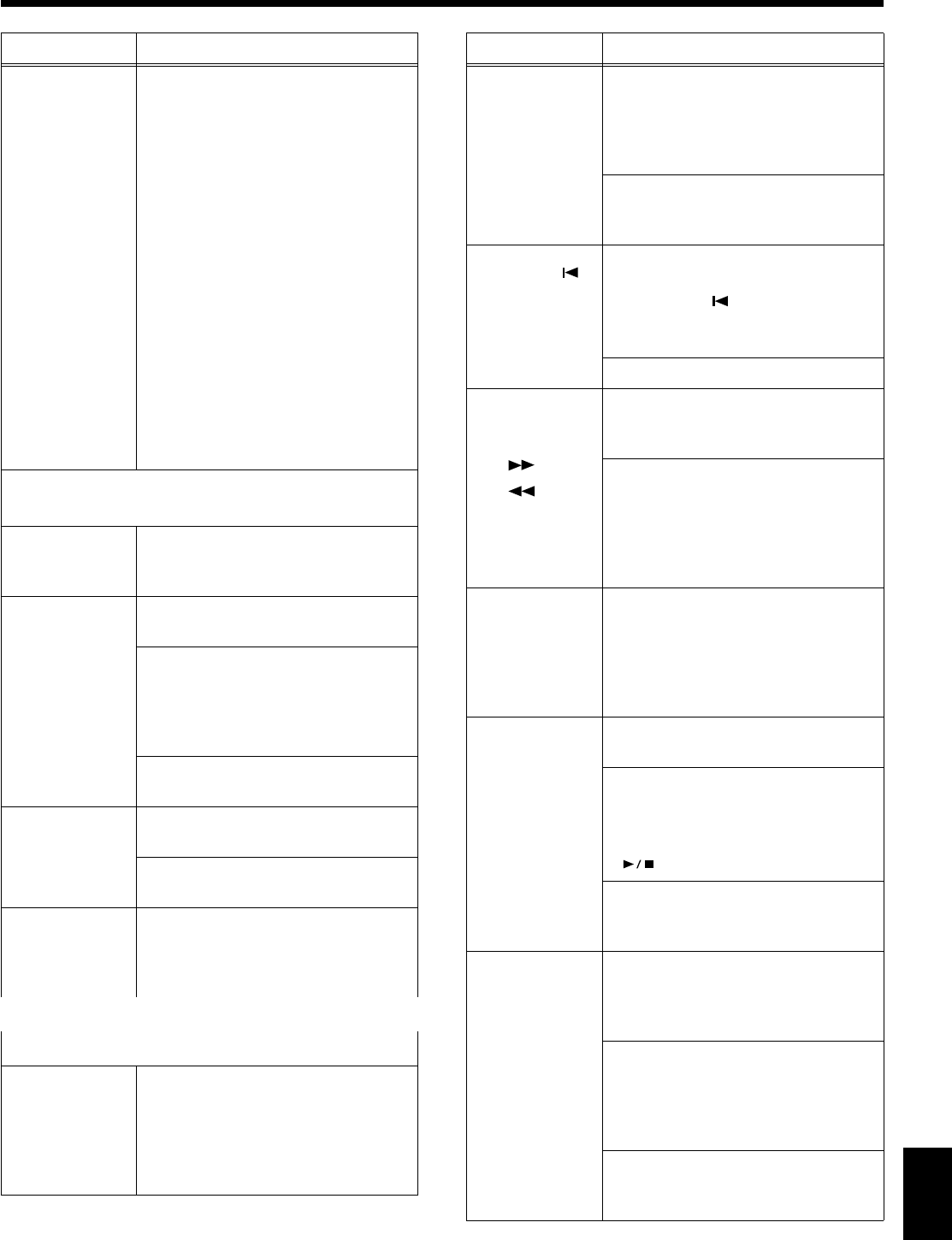
167
Troubleshooting
Appendices
The bass range
sounds odd, or
there is a vibrating
resonance
When listening through speakers:
Playing at loud volumes may cause
instruments near the KR to resonate.
Resonation can also occur with fluorescent
light tubes, glass doors, and other objects.
In particular, this problem occurs more
easily when the bass component is
increased, and when the sound is played at
higher volumes. Use the following
measures to suppress such resonance.
• Place speakers so they are 10–15 cm from
walls and other surfaces.
• Reduce the volume.
• Move the speakers away from any
resonating objects.
When listening through headphones:
Here, a different cause (such as resonance
produced by the KR) would be suspect.
Consult your Roland dealer or nearest
Roland Service Center.
The automatic accompaniment doesn’t play
correctly
Can’t select a tone
or Music Style
Press the [Exit] button several times to
return to the Basic screen (p. 20), and then
select a tone or Music Style.
Automatic
accompaniment is
not heard
Has the Balance knob been moved all the
way to the right? (p. 62)
Have you pressed the One Touch Program
[Arranger] button?
If the One Touch Program [Arranger]
button has not been pressed, only the
rhythm pattern is played (p. 53).
Is the 16-track Sequencer screen displayed?
(p. 113)
Chord Intelligence
can’t be used
Has Chord Intelligence been switched off?
(p. 138)
Is the setting for “Piano Style Arranger”
active? (p. 61)
Accompaniment
tempo becomes
unstable
In certain cases, such as when playing
Music Styles on floppy disks, the
accompaniment may lag when excessive
amounts of performance data are used.
Song doesn’t play back correctly
Song doesn’t play
back
Does the screen indicate message, like “OK
to delete song?” (p. 89)
The internal songs cannot be played back
while recorded performance data remains
in the KR’s memory. Try playing back the
song after deleting the performance data.
Case Cause/Remedy
Only the sound of a
particular
instrument in a
song does not play
Is the light for the Track button
extinguished? (p. 83)
If the button light is out, the music on that
track is not heard. Press the track button so
the light is illuminated.
Have song settings been changed for each
Part on the 16-Track sequencer screen (p.
114)?
Pressing the [
(Reset)] button
doesn’t return to
the beginning of
the song
Some music files may contain settings that
stop play at a point partway through the
song. Press the [ (Reset)] button several
times more to return to the beginning of the
tune.
Has a Marker placed in the song? (p. 84)
The [ (Fwd)]
and [ (Bwd)]
buttons don’t work
The fast-forward and reverse buttons are
ignored while music files is being read in.
Wait until processing finishes.
If you attempt to play back performance
data that contains more data than the entire
capacity of the KR’s memory, you may find
that operations other than playback (such
as rewind or fast forward) become
unavailable.
There is a slight
delay before
playback of a song
on external
memory starts
There are two types of SMF music files:
format 0 and format 1. If the song uses SMF
format 1 data, there will be a slight delay
until playback starts. Refer to the booklet
that came with the music files you’re using
to determine the format type.
Lyrics are not
indicated properly
in the display
With some music files, the lyrics cannot be
displayed correctly.
If you press a button while the lyrics are
being shown in the display, the lyrics will
disappear. To recall them, touch <lyrics> in
the Piano or Basic screen, or press the
[ (Play/Stop)] button.
In the notation screen, some lyrics or notes
could extend beyond the edges of the
screen, and not be displayed.
Notation is not
indicated properly
in the display
If you select a part that does not contain
performance data, notes will not be
displayed in the notation. Change the part
that is displayed (p. 75).
The notation screen feature is particularly
unsuitable for the display of difficult,
complex musical works that demand
accurate notation. Refer to “Notes
Regarding the Notation Display” (p. 73).
In the notation screen, some lyrics or notes
could extend beyond the edges of the
screen, and not be displayed.
Case Cause/Remedy
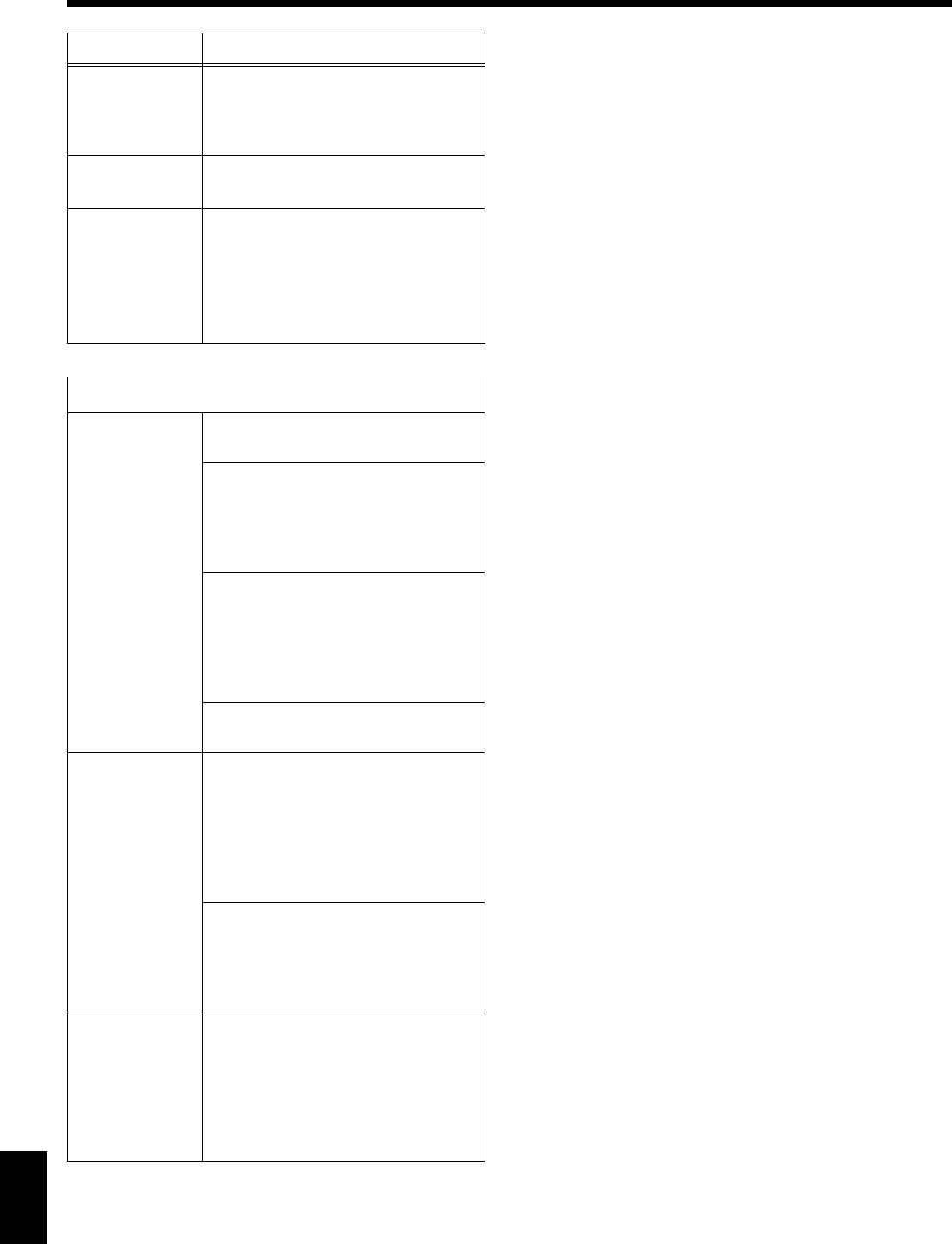
168
Troubleshooting
Appendices
Song becomes
unstable
In certain cases, such as when playing
songs on floppy disks, the song may lag
when excessive amounts of performance
data are used.
internal song
cannot +++++ remocon [MUTE]++++++++++++
Unable to play
back audio files
The KR107 can play back audio files in the
following format.
• “.WAV” extension
• 16bit linear
• Sampling rate of “44.2 kHz”
• Stereo
Can’t record
Can’t record
Has one of the track buttons for recording
been selected? (p. 95)
Has the setting for “Punch-in Recording”
(p. 118) or “Tempo Recording” (p. 127)
been made?
Select the replace recording method (p.
117).
It is not possible to record while the
notation is being generated. Once the unit
has finished generating the notation (i.e.,
when the measure number in the screen is
no longer highlighted), try the operation
once again.
Audio file You cannot include audio files in
recordings.
Tempo of recorded
song or
metronome is off
If you select an internal song in which the
tempo changes during the song, and then
record, the tempo will change in the same
way for the performances that are recorded
on the other tracks. The tempo of the
metronome will also change in the same
way.
If you record additional material without
erasing the previously recorded song, the
song will be recorded at the first-recorded
tempo. Please erase the previously
recorded song before you re-record (p. 96).
The recorded
performance has
disappeared
Any performance that has been recorded is
deleted when the power to the KR is turned
off or a song is selected. A performance
cannot be restored once it’s been deleted.
Be sure to save it on a floppy disk or User
Memory before you turn off the power
(p. 101).
Case Cause/Remedy
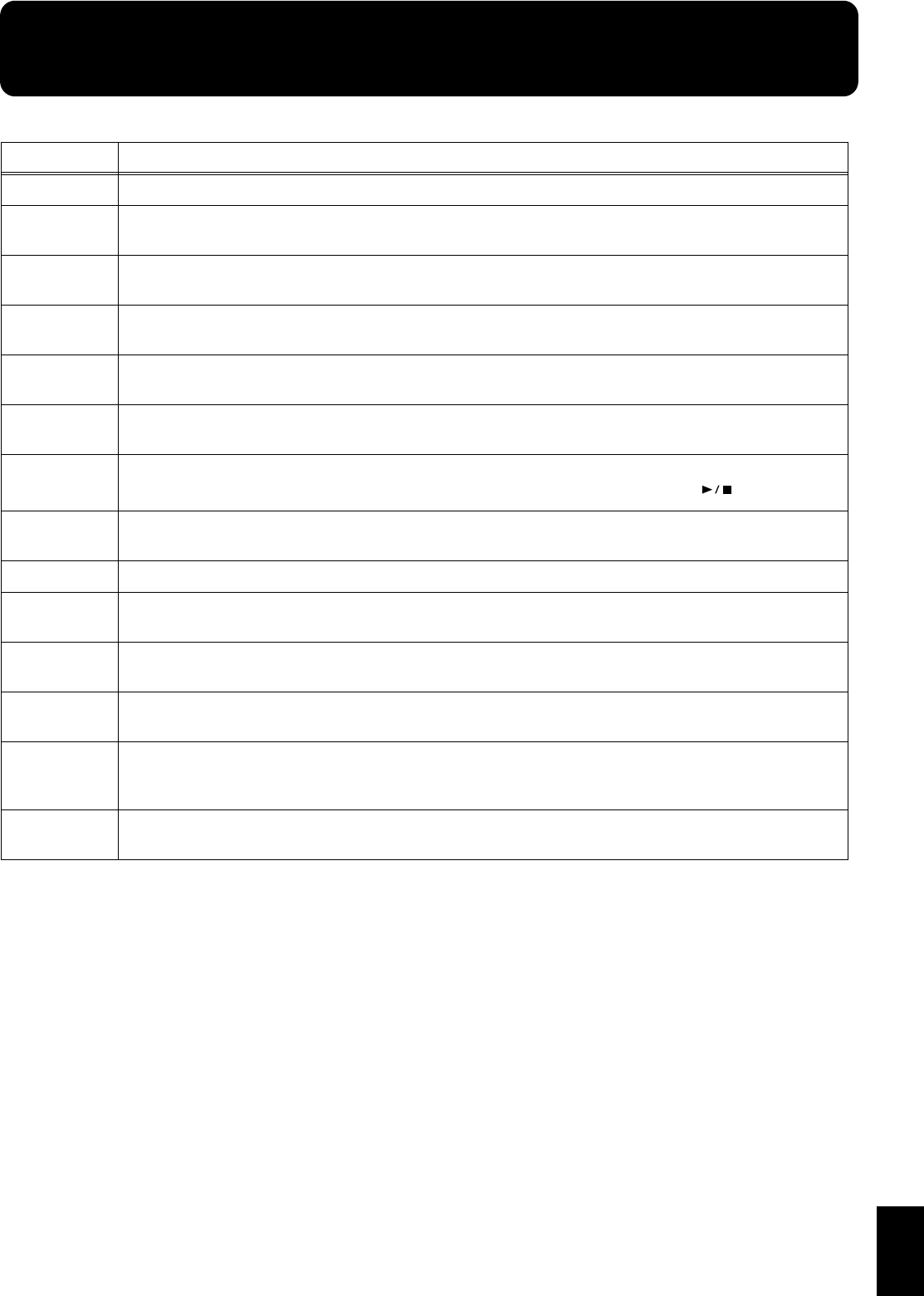
169
Appendices
Error Messages
Indication Meaning
Error 01: You can only read the music file. It can not be saved.
Error 02: An error occurred during writing. The storage media’s protect tab may be in the “Protect” (writing
prohibited) position, or the storage media may not yet be initialized.
Error 10: No storage media is inserted.
Insert the storage media and try again.
Error 11: There is not sufficient free memory in the save destination.
Either insert other storage media or delete unneeded files and try again.
Error 14: An error occurred during writing. The storage media may be corrupted.
Insert other storage media and try again. Alternatively, you can initialize the storage media.
Error 15: The file is unreadable.
The data format is not compatible with the RG-7.
Error 16: Data was not called up in time for playback of the song.
After waiting several seconds, you may be able to play back the song by pressing the [ ] button again.
Error 17: The selected image data cannot be displayed.
Prepare image data that can be used with the RG-7 (p. **).
Error 30: The internal memory capacity of the RG-7 is full.
Error 40: The RG-7 cannot deal with the excessive MIDI data sent from the external MIDI device.
Reduce the amount of MIDI data sent to the RG-7.
Error 41: A MIDI cable has been disconnected.
Connect it properly and securely.
Error 43: A MIDI transmission error has occurred.
Check the MIDI cable and connected MIDI device.
Error 51:
There may be a problem with the system.
Repeat the procedure from the beginning. If it is not solved after you have tried several times, contact the
Roland service center.
Error 65: The Ext Memory port was subjected to excessive current.
Check the storage media to confirm that no damage has occurred to it.
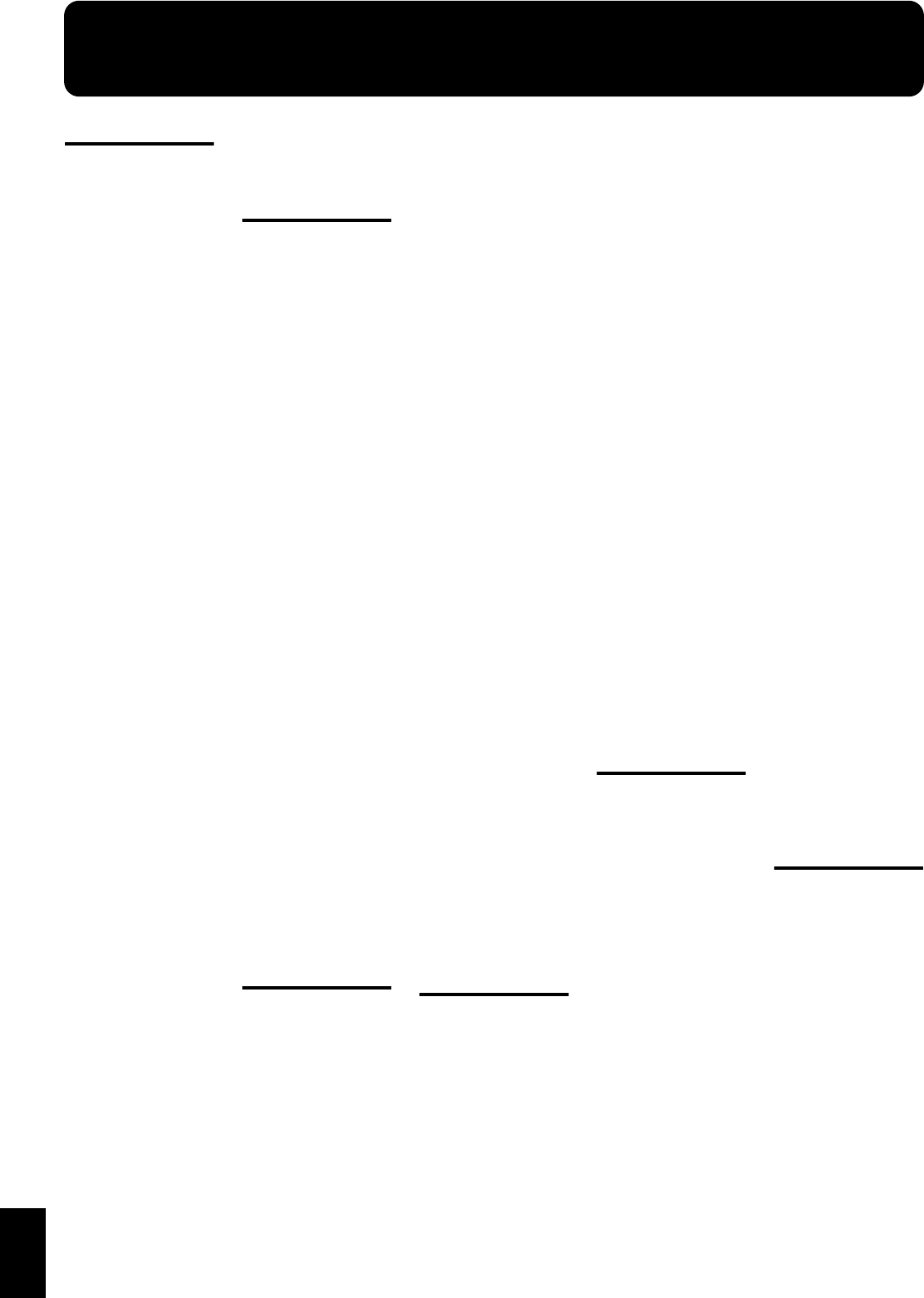
170
Appendices
Tone List
[Piano]
NaturalGrand
Vintage EP
FM E.Piano
Natural Hps.
Vibraphone
Ariel Piano
Natural Gnd2
Honky-tonk
'60sE.Piano1
Phase Clav.2
Morning Lite
Jazzy Vib+Gt
Piano Str2
Piano Oohs
Rock Piano
NaturalMello
Stage EP
Stage Phazer
Vibrations
Celesta
Marimba
Xylophone
NaturalC.Hps
Clav.
Music Box
Glockenspiel
Grand Piano1
Grand Piano2
MellowPiano1
PianoStrings
Bright Piano
DetunedPiano
Honky-tonk 2
MellowPiano2
PianoKidsCho
Air Grand
Ballad Piano
UprightPiano
Mono Piano
FM+SA EP
MIDI Piano1
EG+E.Piano 1
EG+E.Piano 2
Bell Piano
E. Grand
Mild E.Grand
Soft E.Piano
Phase EP
E.Piano 1
Pop E.Piano
Tremolo EP
'60sE.Piano2
E.Piano 2
EP Phase
St.FM EP
EP Legend
Harpsichord
Coupled Hps.
Harpsichord2
Comp Clav.
Reso Clav.
Phase Clav.
Pulse Clav
Celesta 2
Soft Marimba
Vibe Tr.
Marimba Tr.
Kalimba
Music Box 2
Music Bell
Music Bell 2
Tubular-bell
Church Bell
Ballad Bells
Bell Monitor
Timeline
Vibra Bells
[Organ]
ChurchOrgan1
Combo Jz.Org
Ballad Organ
German Acco.
Blues Harp
L-Organ
Jazz Organ1
Masked Opera
Grand Pipe
Theater Org.
La Seine
ParisRomance
Mellow Bars
Organ 1
Organ 2
Lower Organ1
Trem. Organ
'70s E.Organ
'60s Organ
Jazz Organ2
Jazz Organ3
Jazz Organ4
Chorus Organ
Perc. Organ
Rock Organ1
Rotary Organ
Rotary Org.S
Rotary Org.F
ChurchOrgan2
Pipe Organ
Trem.Flute
Organ Flute
Nason flt 8'
Organ Bass
Pipe Org. Bs
Digi Church
VS Organ
Metalic Org.
CheeseOrgan
Accordion Fr
AccordionFr2
Accordion It
Bright Acco.
Soft Acco.
Bandoneon
Harmonica
[Guitar / Bass]
EX Nylon Gtr
EX Steel Gt.
Jazz Guitar2
Fl.Gtr Roll
Mandolin
JC Chorus Gt
TC Clean ff
Overdrive Gt
DistortionGt
Amore Story
EX A.Guitar2
Uncle Martin
Flamenco Gtr
Jazz Guitar
Wild Ac.Bs
A.Bass+Cymbl
Acoustic Bs.
Fingered Bs.
Picked Bass
Fretless Bs.
Nylon Guitar
Requint Gtr
EX Ac.Guitar
Steel-str.Gt
12-str.Gt
Steel + Body
Nylon+Steel
EX A.Guitar3
Steel Vox
Ukulele
Hawaiian Gt
Clean Gt.
JC Clean Gt.
Mid Tone GTR
TC Rear Pick
Acid Guitar
Open Hard
Feedback Gt.
Power Guitar
Guitar Pinch
Mystic Gtr
Funk Gt.
Funk Gt.2
Muted Gt.
Muted Dis.Gt
Rock Rhythm
Dist Rtm GTR
Wah Brush Gt
Wood Bass
W.Bass+Ride
Rockabilly
Finger Slap
Mr.Smooth
Slap Bass 1
Slap Bass 2
Synth Bass 1
Jungle Bass
Hammer
SynthBass101
ResoSH Bass
Acid Bass
Clavi Bass
Synth Bass 2
Beef FM Bass
Attack Pulse
Rubber Bass
Sitar
Sitar 2
Banjo
Shamisen
Koto
Taisho Koto
[Strings]
DolceStrings
Velo Strings
Dolce Qrt
Lunar Strngs
R&B SoftPad
Wind & Str
Aerial Harp
Violin
Cello
Harp Strings
Mellow Str
EX Orchestra
Slow Violin
PizzicatoStr
Strings
Oct Strings
Strings 2
DecayStrings
Bright Str
Slow Strings
SlowStrings2
Legato Str
Warm Strings
Sahara Str
Decay Str2
Tremolo Str
Orchestra
Orchestra 2
Farewell
Choir Str
Bell Strings
Pearly Harp
Harp
St. Harp
Viola
Contrabass
Santur
Yang Qin
Yang Qin 2
Er Hu
Soft Pad
Soft Pad 2
Syn.Strings1
Syn.Strings2
Syn.Slow Str
OB Strings
JP Saw Str
Timpani
Warm JP Str
OrchestraHit
Good Old Hit
Euro Hit
6th Hit
Bass Hit
Philly Hit
Philly Hit 2
Mix Hit 1
Mix Hit 2
[Sax/Brass]
BlowAltoVib
PowerBrass 2
Sax Section
Flute
Good Old Day
Brass Sect 2
EX Tp&Shake
Super Tenor
AltoSax Soft
Soprano Sax
Clarinet
Oboe
EX Trumpet
Flugel Horn
Pan Flute
Qu Di
SuperF.Horns
Angel Pipes
Trumpet
Tp Shake
Bright Tp.
Warm Tp.
Dark Trumpet
Romantic Tp
Trombone
Trombone 2
Twin bones
Bones Sect.
Bright Tb.
Tuba
MutedTrumpet
MuteTrumpet2
MuteTrumpet3
French Horns
French Horn2
OrchestraBrs
Brass 1
Brass 2
BrassSection
PowerBrass
Pop Orch
Contemp'Orch
Brass sfz
Brass Fall
Trumpet Fall
EX Alto Sax
AltoSax + Tp
Alto Sax
Grow Sax
BreathyTenor
Tenor Sax
Tenor Sax 2
Tenor Sax f
Tenor Sax B
Baritone Sax
English Horn
Bassoon
Piccolo
Flute 2
Recorder
Bottle Blow
Shakuhachi
Whistle
Ocarina
Bagpipe
Lochscape
Andes Mood
HimalayaPipe
Wide SynBrss
DeepSynBrass
Jump Brass
Saw Brass1
Saw Brass2
Synth Brass1
Synth Brass2
DetuneSawBrs
Pro Brass
SynBrass sfz
[Voice]
Aerial Choir
Jazz Scat
Kid's Choir
Dreaming Box
Rich Choir
Angels Choir
Boys Choir
Opera Voice
Mellow Choir
Holy Voices
Mystic Str
Trancy X
HPF Slicer
Side Band X
Glasswaves
Church Choir
Voice Oohs
Voice Oohs 2
Choir Hahs
Decay Choir
Doos Voice
Doot Accent
Dat Accent
Bap Accent
Thum Voice
Humming
SynVox

171
Tone List
Appendices
Analog Voice
InfinitePhsr
X Super Saws
Fat Stacks
Frgile Saws
SuperSawSlow
Electrostars
Bending Logo
2600 Sine
Square Wave
Mg Square
JP8 Square
LM Square
Syn.Square
CC Solo
Sleeper
Dual Sqr&Saw
Jupiter Lead
Sinetific
FM Lead 1
FM Lead 2
Saw Wave
Saw
Doctor Solo
Mg Lead
P5 Saw Lead
JP SuperSaw
Rhythmic Saw
Natural Lead
SequencedSaw
Waspy Synth
Velo SawLead
Attack Lead
DelyResoSaws
Wezcoast
Syn.Calliope
JP8 Pulse
LM PureLead
Orgaenia
Chiffer Lead
Cheese Saw
JP OctAttack
Charang
Reso Saw
Wire Lead
2600 SubOsc
Solo Vox
RAVE Vox
5th Saw Wave
Freeze Synth
Bass & Lead
Fat & Perky
Delayed Lead
Fantasia
Fantasia 2
New Age Pad
New Age Pad2
Sugar Key
FreezinNight
New Year Day
Warm Pad
Sine Pad
Nu Epic Pad
Hollow Pad
Decay Pad
Polysynth
P5 Poly
Poly King
Octave Stack
Hoovercraft
DOC Stack
Bustranza
Space Voice
Heaven II
Warm SquPad
Voyager
Film Cue
HumanKindnes
Bowed Glass
Metal Pad
Orbiting
Visionary
Halo Pad
JP8 Sqr Pad
Vox Sweep
Consolament
JP-8 Phase
Sweep Pad
Sweep Pad 2
Ice Rain
Clavi Pad
Toy Box
Soundtrack
Crystal
Syn Mallet
ChristmasBel
Clear Bells
Himalaya Ice
Glittery Pad
Atmosphere
Harpvox
Nylon Harp
Nylon + EP
HollowReleas
Tubulence
Landing Pad
Shangri-La
Motion Pad
Brightness
Org Bells
Goblin
Saturn Siren
RandomEnding
Echo Drops
Echo Bell
Echo Pan
Echo Pan 2
Big Panner
Ai-yai-a
Saturn Rings
Star Theme
Rising Osc
Galaxy Way
12th Planet
PolySweep Nz
En-co-re
Piano 1
Piano 1w
Piano 1d
Piano 2
Piano 2w
Piano 3
Piano 3w
Honky-tonk
Honky-tonk 2
E.Piano 1
E.Piano 2
'60s E.Piano
E.Piano 1v
E.Piano 2v
Detuned EP 1
Detuned EP 2
Harpsichord
Coupled Hps.
Harpsi.w
Harpsi.o
Clav.
Celesta
Glockenspiel
Music Box
Vibraphone
Vibe.w
Marimba
Marimba w
Xylophone
Tubular-bell
Church Bell
Carillon
Santur
Organ 1
Organ 2
Pop Organ 1
Detuned Or.1
Detuned Or.2
Church Org.1
Church Org.2
Church Org.3
Full Organ
Jazz Organ1
Rock Organ
Reed Organ
Accordion Fr
Accordion It
Harmonica
Bandoneon
Nylon-str.Gt
Nylon Gt.2
Nylon Gt.o
Ukulele
Steel-str.Gt
12-str.Gt
Mandolin
Jazz Guitar
Hawaiian Gt
Clean Gt.
Chorus Gt.
Muted Gt.
Funk Gt.
Funk Gt.2
Overdrive Gt
DistortionGt
Feedback Gt.
Gt.Harmonics
Gt. Feedback
Acoustic Bs.
Fingered Bs.
Picked Bs.
Fretless Bs.
Slap Bass 1
Slap Bass 2
SynthBass101
Synth Bass 1
Synth Bass 2
Synth Bass 3
Synth Bass 4
Rubber Bass
Violin
Slow Violin
Viola
Cello
Contrabass
Tremolo Str
PizzicatoStr
Harp
Timpani
Strings
Orchestra
Slow Strings
Syn.Strings1
Syn.Strings2
Syn.Strings3
Choir Aahs
Choir
Pop Voice
SynVox
OrchestraHit
Trumpet
Trombone
Trombone 2
Tuba
MutedTrumpet
French Horns
French Horn2
Brass 1
Brass 2
Synth Brass1
Synth Brass2
Synth Brass3
Synth Brass4
AnalogBrass1
AnalogBrass2
Soprano Sax
Alto Sax
Tenor Sax
Baritone Sax
Oboe
English Horn
Bassoon
Clarinet
Piccolo
Flute
Recorder
Pan Flute
Bottle Blow
Shakuhachi
Whistle
Ocarina
Square Wave
Square
Sine Wave
Saw Wave
Saw
Doctor Solo
Syn.Calliope
Chiffer Lead
Charang
Solo Vox
5th Saw Wave
Bass & Lead
Fantasia
Warm Pad
Polysynth
Space Voice
Bowed Glass
Metal Pad
Halo Pad
Sweep Pad
Ice Rain
Soundtrack
Crystal
Syn Mallet
Atmosphere
Brightness
Goblin
Echo Drops
Echo Bell
Echo Pan
Star Theme
Sitar
Sitar 2
Banjo
Shamisen
Koto
Taisho Koto
Kalimba
Bagpipe
Fiddle
Shanai
Tinkle Bell
Agogo
Steel Drums
Woodblock
Castanets
Taiko
Concert BD
Melo. Tom 1
Melo. Tom 2
Synth Drum
808 Tom
Elec Perc.
Reverse Cym.
Gt.FretNoise
Gt.Cut Noise
String Slap
Breath Noise
Fl.Key Click
Seashore
Rain
Thunder
Wind
Stream
Bubble
Bird
Dog
Horse-Gallop
Bird 2
Telephone 1
Telephone 2
DoorCreaking
Door
Scratch
Windchime
Helicopter
Car-Engine
Car-Stop
Car-Pass
Car-Crash
Siren
Train
Jetplane
Starship
Burst Noise
Applause
Laughing
Screaming
Punch
Heart Beat
Footsteps
Gun Shot
Machine Gun
Lasergun
Explosion
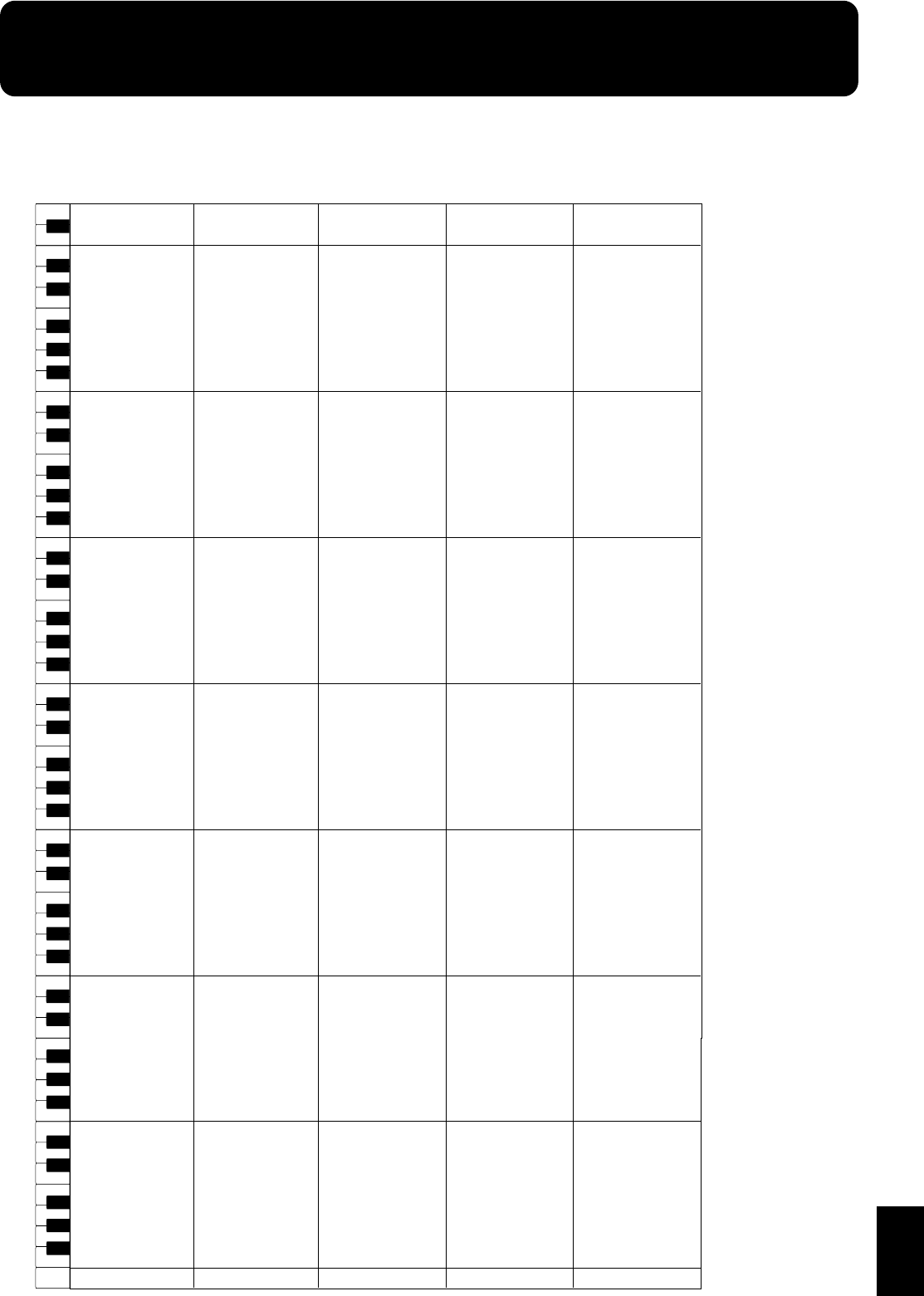
172
Appendices
Drum Set List
* -----: No sound.
* [EXC]: will not sound simultaneously with other percussion instruments of the same number.
R&B Snare
Rock Snare m 1
Rock Snare m 2
Pop Snare m 1
Pop Snare Ghost
Pop Snare m 1
Finger Snap
TR-707 Claps
Hand Clap [EXC7]
Hand Clap 2 [EXC7]
Hand Clap
Pop Pedal HH [EXC1]
Gospel Hand Clap
Snare Roll
Pop Kick 2
Pop Kick 1
Pop Side Stick
Pop Snare s 1
Pop Snare Ghost
Pop Snare s 2
Pop Low Tom f
Pop CHH 1 [EXC1]
Pop Low Tom
Pop CHH 2 [EXC1]
Pop Mid Tom f
Pop OHH [EXC1]
Pop Mid Tom
Pop High Tom f
Pop Crash Cymbal 1
Pop High Tom
Pop Ride Cymbal 1
Pop Chinees Cymbal
Pop Ride Bell
Tambourine 2
Splash Cymbal
Cha Cha CowBell
Pop Crash Cymbal 2
Vibra-slap
Pop Ride Cymbal 2
High Bongo 1
Low Bongo 1
Mute High Conga 1
Open High Conga 1
Low Conga 1
High Timbale
Low Timbale
High Agogo
Low Agogo
Shaker 3
Shaker 4
Short Hi Whistle [EXC2]
Long Low Whistle [EXC2]
Short Guiro [EXC3]
Long Guiro [EXC3]
Claves
High Wood Block
Low Wood Block
Mute Cuica [EXC4]
Open Cuica [EXC4]
Mute Triangle1 [EXC5]
Open Triangle 1 [EXC5]
Shaker
Jingle Bell
Bell Tree
Castanets
Mute Surdo [EXC6]
Open Surdo [EXC6]
Cana
Hi-Timbale Flam
Lo-Timbale Flam
Timbale Phrase
Shekere 1
Shekere 2
Low Bongo Mute
High Bongo Mute
----
----
----
----
Flamenco Hand Clap
Flamenco Hand Clap
Bongo CowBell
----
Bongo CowBell
----
----
----
----
R&B Snare
Pop Snare m 2
Pop Snare m 1
Pop Snare m 1
Pop Snare Ghost
Pop Snare m 2
Finger Snap 2
TR-707 Claps
Hand Clap [EXC7]
Hand Clap 2 [EXC7]
Hand Clap
Pop Pedal HH [EXC1]
Gospel Hand Clap
Snare Roll
Rock Kick 2
Rock Kick 1
Rock Side Stick
Rock Snare s 1
Pop Snare Ghost
Rock Snare s 2
Rock Low Tom f
Rock CHH 1 [EXC1]
Rock Low Tom
Rock CHH 2 [EXC1]
Rock Mid Tom f
Rock OHH [EXC1]
Rock Mid Tom
Rock High Tom f
Rock Crash Cymbal
Rock High Tom
Rock Ride Cymbal 1
Pop Chinees Cymbal
Pop Ride Bell
Tambourine 2
Splash Cymbal
Cha Cha CowBell
Chinees Cymbal
Vibra-slap
Pop Ride Cymbal 3
High Bongo 1
Low Bongo 1
Mute High Conga 1
Open High Conga 1
Low Conga 1
High Timbale
Low Timbale
High Agogo
Low Agogo
Shaker 3
Shaker 4
Short Hi Whistle [EXC2]
Long Low Whistle [EXC2]
Short Guiro [EXC3]
Long Guiro [EXC3]
Claves
High Wood Block
Low Wood Block
Mute Cuica [EXC4]
Open Cuica [EXC4]
Mute Triangle1 [EXC5]
Open Triangle 1 [EXC5]
Shaker
Jingle Bell
Bell Tree
Castanets
Mute Surdo [EXC6]
Open Surdo [EXC6]
Cana
Hi-Timbale Flam
Lo-Timbale Flam
Timbale Phrase
Shekere 1
Shekere 2
Low Bongo Mute
High Bongo Mute
----
----
----
----
Flamenco Hand Clap
Flamenco Hand Clap
Bongo CowBell
----
Bongo CowBell
----
----
----
----
Jungle BD 2
Metronome E.Click
Metronome Pi
Concert SD
Snare Roll
Finger Snap
High Q
Slap
Scratch Push [EXC7]
Scratch Pull [EXC7]
Sticks
Square Click
Metronome Click
Metronome Bell
Jungle BD 2
HipHop BD1
TR-808 Rimshot
Power Snare 1A
TR-707 Clap
Power Snare 2A
Low Tom 2
Pop CHH 1 [EXC1]
Low Tom 1
Pedal Hi-hat 3 [EXC1]
Mid Tom 2
Pop OHH [EXC1]
Mid Tom 1
High Tom 2
Crash Cymbal 3
High Tom 1
Ride Cymbal 1
Reverse Cymbal
Ride Bell
Shake Tambourine
Splash Cymbal
TR-808 Cowbell
Crash Cymbal 2
Vibra-slap
Ride Cymbal 2
High Bongo 2
Low Bongo 2
Mute High Conga 2
Open High Conga 2
Low Conga 2
High Timbale
Low Timbale
High Agogo
Low Agogo
Cabasa
Maracas
Short Hi Whistle [EXC2]
Long Low Whistle [EXC2]
Short Guiro [EXC3]
HipVibraslap [EXC3]
TR-808 Claves
High Wood Block
Low Wood Block
High Hoo [EXC4]
Low Hoo [EXC4]
Mute Triangle2 [EXC5]
Open Triangle 2 [EXC5]
Shaker
Jingle Bell
Bell Tree
Castanets
Mute Surdo [EXC6]
Open Surdo [EXC6]
Applause 2
HipHop SD 2
LoFi SD Rim
TR-808 Clap
Room Snare 1
Standard 1 Snare 2A
Room Snare 2
Standard 1 Snare 1
Standard 1 Snare 2B
----
----
----
----
----
----
Tape Rewind
Phono Noise
Room Snare 1
Room Snare 2A
Elec Snare 4A
Elec Snare 4B
R&B Snare
Rock Snare m 1
Rock Snare m 2
Pop Snare m 1
Pop Snare Ghost
Pop Snare m 1
Finger Snap
TR-707 Claps
Hand Clap [EXC7]
Hand Clap 2 [EXC7]
Hand Clap
Pop Pedal HH
Gospel Hand Clap
Vox Dut
Vox Dom
Vox Tuush
Vox Hehho
Vox Doyear
Vox Thu!
Vox That
Vox Aahhh
Vox Tu
Vox Dooh
Vox Ptu
Vox Down
Vox Pa
Vox Bom
Vox Toear
Vox Aahhu
Vox Toya
Vox Thu
Vox Cheey
Vox Cymm
Vox Tub
Vox Pruru
Vox Tut
Vox Tyun
Vox Tdum
Vox Afahhhh
High Bongo 1
Low Bongo 1
Mute High Conga 1
Open High Conga 1
Low Conga 1
High Timbale
Low Timbale
High Agogo
Low Agogo
Shaker 3
Shaker 4
Short Hi Whistle [EXC2]
Long Low Whistle [EXC2]
Short Guiro [EXC3]
Long Guiro [EXC3]
Claves
High Wood Block
Low Wood Block
Mute Cuica [EXC4]
Open Cuica [EXC4]
Mute Triangle1 [EXC5]
Open Triangle 1 [EXC5]
Shaker
Jingle Bell
Bell Tree
Castanets
Mute Surdo [EXC6]
Open Surdo [EXC6]
Cana
Hi-Timbale Flam
Lo-Timbale Flam
Timbale Phrase
Shekere 1
Shekere 2
Low Bongo Mute
High Bongo Mute
----
----
----
----
Flamenco Hand Clap
Flamenco Hand Clap
Bongo CowBell
----
Bongo CowBell
----
----
----
----
27
28
29
31
33
35
30
32
34
21
23
22
39
40
41
43
45
47
42
44
46
36
38
37
87
88
84
86
85
51
52
53
55
57
59
54
56
58
48
50
49
63
64
65
67
69
71
66
68
70
60
62
61
75
76
77
79
81
83
78
80
82
72
74
73
C2
C3
C4
C5
C6
26
24
25
POP ROCK HIP HOP VOX DRUM
R&B Snare
Pop Snare m 1
Pop Snare m 2
Pop Snare m 1
Pop Snare Ghost
Pop Snare m 1
Finger Snap 2
TR-707 Claps
Hand Clap [EXC7]
Hand Clap 2 [EXC7]
Hand Clap
Pop Pedal HH [EXC1]
Gospel Hand Clap
Snare Roll
Jazz Kick 2
Jazz Kick 1
Jazz Snare Swing 1
Jazz Snare 1
Jazz Snare Swing 2
Jazz Snare 2
Jazz Low Tom f
Pop CHH 1 [EXC1]
Jazz Low Tom
Pop CHH 2 [EXC1]
Jazz Mid Tom f
Pop OHH [EXC1]
Jazz Mid Tom
Jazz High Tom f
Jazz Crash Cymbal 1
Jazz High Tom
Jazz Ride Cymbal 1
Jazz Chinees Cymbal
Jazz Ride Cymbal 2
Tambourine 2
Splash Cymbal
Cha Cha CowBell
Jazz Crash Cymbal 2
Vibra-slap
Jazz Ride Cymbal 3
High Bongo 1
Low Bongo 1
Mute High Conga 1
Open High Conga 1
Low Conga 1
High Timbale
Low Timbale
High Agogo
Low Agogo
Shaker 3
Shaker 4
Short Hi Whistle [EXC2]
Long Low Whistle [EXC2]
Short Guiro [EXC3]
Long Guiro [EXC3]
Claves
High Wood Block
Low Wood Block
Mute Cuica [EXC4]
Open Cuica [EXC4]
Mute Triangle1 [EXC5]
Open Triangle 1 [EXC5]
Shaker
Jingle Bell
Bell Tree
Castanets
Mute Surdo [EXC6]
Open Surdo [EXC6]
Cana
Hi-Timbale Flam
Lo-Timbale Flam
Timbale Phrase
Shekere 1
Shekere 2
Low Bongo Mute
High Bongo Mute
----
----
----
----
Flamenco Hand Clap
Flamenco Hand Clap
Bongo CowBell
----
Bongo CowBell
----
----
----
----
JAZZBRUSH
89
91
93
95
90
92
94
107
108
106
99
100
101
103
105
102
104
96
98
97
C7
C8
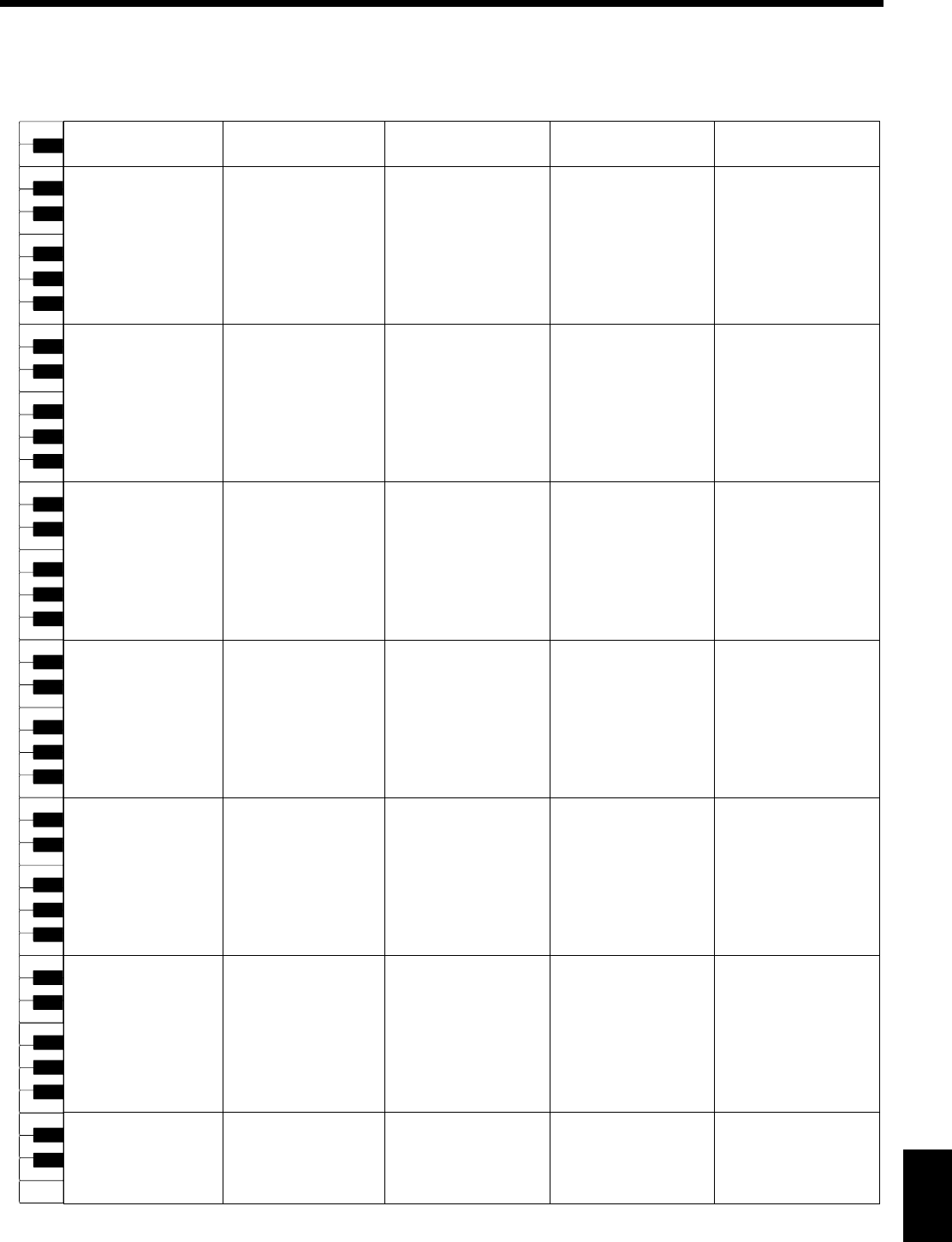
173
Drum Set List
Appendices
* -----: No sound.
* [EXC]: will not sound simultaneously with other percussion instruments of the same number.
----
----
----
Bar Chime
Snare Roll
Finger Snap
High Q
Slap
Scratch Push [EXC7]
Scratch Pull [EXC7]
Sticks
Square Click
Metronome Click
Metronome Bell
Standard 1 Kick 1
Standard 1 Kick 2
Side Stick 1
Standard 1 Snare 1
TR-909 Clap
Standard 1 Snare 2
Low Tom 2
Close Hi-hat1 [EXC1]
Low Tom 1
Pedal Hi-hat 1 [EXC1]
Mid Tom 2
Open Hi-hat 1 [EXC1]
Mid Tom 1
High Tom 2
Crash Cymbal 1
High Tom 1
Ride Cymbal 1
Chinese Cymbal
Ride Bell
Tambourine
Splash Cymbal
Cowbell
Crash Cymbal 2
Vibra-slap
Ride Cymbal 2
----
----
----
Cana
Ban Gu 1
Taiko 1
Nao Bo [EXC8]
Taiko 2
Xiao Bo 1 [EXC8]
Taiko 3
Open High HuYinLuo 2 [EXC8]
Taiko 4
Taiko 5
Open High HuYinLuo 1
Taiko 6
Shou Luo 1
Mute Low HuYinLuo 2
Shou Luo 2
Xiao Bo 2
Ban Gu 2
Xiao Bo 3
Open High HuYinLuo 3
Mute High HuYinLuo
Mute Low HuYinLuo 1
----
----
----
----
----
----
----
----
----
----
----
----
----
Open Sagat
Close Sagat
Ban Gu 1
Ban Gu 3
----
----
----
----
Bar Chime
Snare Roll
Finger Snap
High Q
Slap
Scratch Push [EXC7]
Scratch Pull [EXC7]
Sticks
Square Click
Metronome Click
Metronome Bell
Standard 1 Kick 1
Standard 1 Kick 2
Side Stick 1
Standard 1 Snare 1
TR-909 Clap
Standard 1 Snare 2
Low Tom 2
Close Hi-hat1 [EXC1]
Low Tom 1
Pedal Hi-hat 1 [EXC1]
Mid Tom 2
Open Hi-hat 1 [EXC1]
Mid Tom 1
High Tom 2
Crash Cymbal 1
High Tom 1
Ride Cymbal 1
Chinese Cymbal
Ride Bell
Tambourine
Splash Cymbal
Cowbell
Crash Cymbal 2
Vibra-slap
Ride Cymbal 2
High Bongo 1
Low Bongo 1
Mute High Conga 1
Open High Conga 1
Low Conga 1
High Timbale
Low Timbale
High Agogo
Low Agogo
Cabasa
Maracas
Short Hi Whistle [EXC2]
Long Low Whistle [EXC2]
Short Guiro [EXC3]
Long Guiro [EXC3]
Claves
High Wood Block
Low Wood Block
Mute Cuica [EXC4]
Open Cuica [EXC4]
Mute Triangle1 [EXC5]
Open Triangle 1 [EXC5]
Shaker
Jingle Bell
Bell Tree
Castanets
Mute Surdo [EXC6]
Open Surdo [EXC6]
----
----
----
----
----
----
----
----
----
----
----
----
----
----
----
----
----
Bar Chime
Snare Roll
Finger Snap
High Q
Slap
Scratch Push [EXC7]
Scratch Pull [EXC7]
Sticks
Square Click
Metronome Click
Metronome Bell
Standard 2 Kick 2
Standard 2 Kick 1
Side Stick 2
Standard 2 Snare 1
TR-808 Clap
Standard 2 Snare 2
Low Tom 2
Closed Hi-hat 2 [EXC1]
Low Tom 1
Pedal Hi-hat 2 [EXC1]
Mid Tom 2
Open Hi-hat 2 [EXC1]
Mid Tom 1
High Tom 2
Crash Cymbal 1
High Tom 1
Ride Cymbal 1
Chinese Cymbal
Ride Bell
Tambourine
Splash Cymbal
Cowbell
Crash Cymbal 2
Vibra-slap
Ride Cymbal 2
High Bongo 1
Low Bongo 1
Mute High Conga 1
Open High Conga 1
Low Conga 1
High Timbale
Low Timbale
High Agogo
Low Agogo
Cabasa
Maracas
Short Hi Whistle [EXC2]
Long Low Whistle [EXC2]
Short Guiro [EXC3]
Long Guiro [EXC3]
Claves
High Wood Block
Low Wood Block
Mute Cuica [EXC4]
Open Cuica [EXC4]
Mute Triangle1 [EXC5]
Open Triangle 1 [EXC5]
Shaker
Jingle Bell
Bell Tree
Castanets
Mute Surdo [EXC6]
Open Surdo [EXC6]
----
----
----
----
----
----
----
----
----
----
----
----
----
----
----
----
----
Bar Chime
Snare Roll
Finger Snap
High Q
Slap
Scratch Push [EXC7]
Scratch Pull [EXC7]
Sticks
Square Click
Metronome Click
Metronome Bell
Standard 3 Kick 2
Standard 3 Kick 1
Side Stick 2
Standard 3 Snare 1
TR-808 Clap
Standard 3 Snare 2
Low Tom 2
Closed Hi-hat 3 [EXC1]
Low Tom 1
Pedal Hi-hat 2 [EXC1]
Mid Tom 2
Open Hi-hat 3 [EXC1]
Mid Tom 1
High Tom 2
Crash Cymbal 1
High Tom 1
Ride Cymbal 1
Chinese Cymbal
Ride Bell
Tambourine
Splash Cymbal
Cowbell
Crash Cymbal 2
Vibra-slap
Ride Cymbal 2
High Bongo 1
Low Bongo 1
Mute High Conga 1
Open High Conga 1
Low Conga 1
High Timbale
Low Timbale
High Agogo
Low Agogo
Cabasa
Maracas
Short Hi Whistle [EXC2]
Long Low Whistle [EXC2]
Short Guiro [EXC3]
Long Guiro [EXC3]
Claves
High Wood Block
Low Wood Block
Mute Cuica [EXC4]
Open Cuica [EXC4]
Mute Triangle1 [EXC5]
Open Triangle 1 [EXC5]
Shaker
Jingle Bell
Bar Chime
Castanets
Mute Surdo [EXC6]
Open Surdo [EXC6]
----
----
----
----
----
----
----
----
----
----
----
----
----
----
STD CHINA STANDARD 1 STANDARD 2 STANDARD 3 ROOM
----
----
----
Bar Chime
Snare Roll
Finger Snap
High Q
Slap
Scratch Push [EXC7]
Scratch Pull [EXC7]
Sticks
Square Click
Metronome Click
Metronome Bell
Room Kick 2
Room Kick 1
Side Stick 2
Room Snare 1
TR-808 Clap
Room Snare 2
Room Low Tom 2
Closed Hi-hat 4 [EXC1]
Room Low Tom 1
Pedal Hi-hat 2 [EXC1]
Room Mid Tom 2
Open Hi-hat 4 [EXC1]
Room Mid Tom 1
Room High Tom 2
Crash Cymbal 1
Room High Tom 1
Ride Cymbal 1
Chinese Cymbal
Ride Bell
Tambourine
Splash Cymbal
Cowbell
Crash Cymbal 2
Vibra-slap
Ride Cymbal 2
High Bongo 1
Low Bongo 1
Mute High Conga 1
Open High Conga 1
Low Conga 1
High Timbale
Low Timbale
High Agogo
Low Agogo
Cabasa
Maracas
Short Hi Whistle [EXC2]
Long Low Whistle [EXC2]
Short Guiro [EXC3]
Long Guiro [EXC3]
Claves
High Wood Block
Low Wood Block
Mute Cuica [EXC4]
Open Cuica [EXC4]
Mute Triangle1 [EXC5]
Open Triangle 1 [EXC5]
Shaker
Jingle Bell
Bell Tree
Castanets
Mute Surdo [EXC6]
Open Surdo [EXC6]
----
----
----
----
----
----
----
----
----
----
----
----
----
----
27
28
29
31
33
35
30
32
34
21
23
22
39
40
41
43
45
47
42
44
46
36
38
37
87
88
84
86
85
51
52
53
55
57
59
54
56
58
48
50
49
63
64
65
67
69
71
66
68
70
60
62
61
75
76
77
79
81
83
78
80
82
72
74
73
C2
C3
C4
C5
C6
26
24
25
89
91
93
95
90
92
94
99
100
101
96
98
97
C7
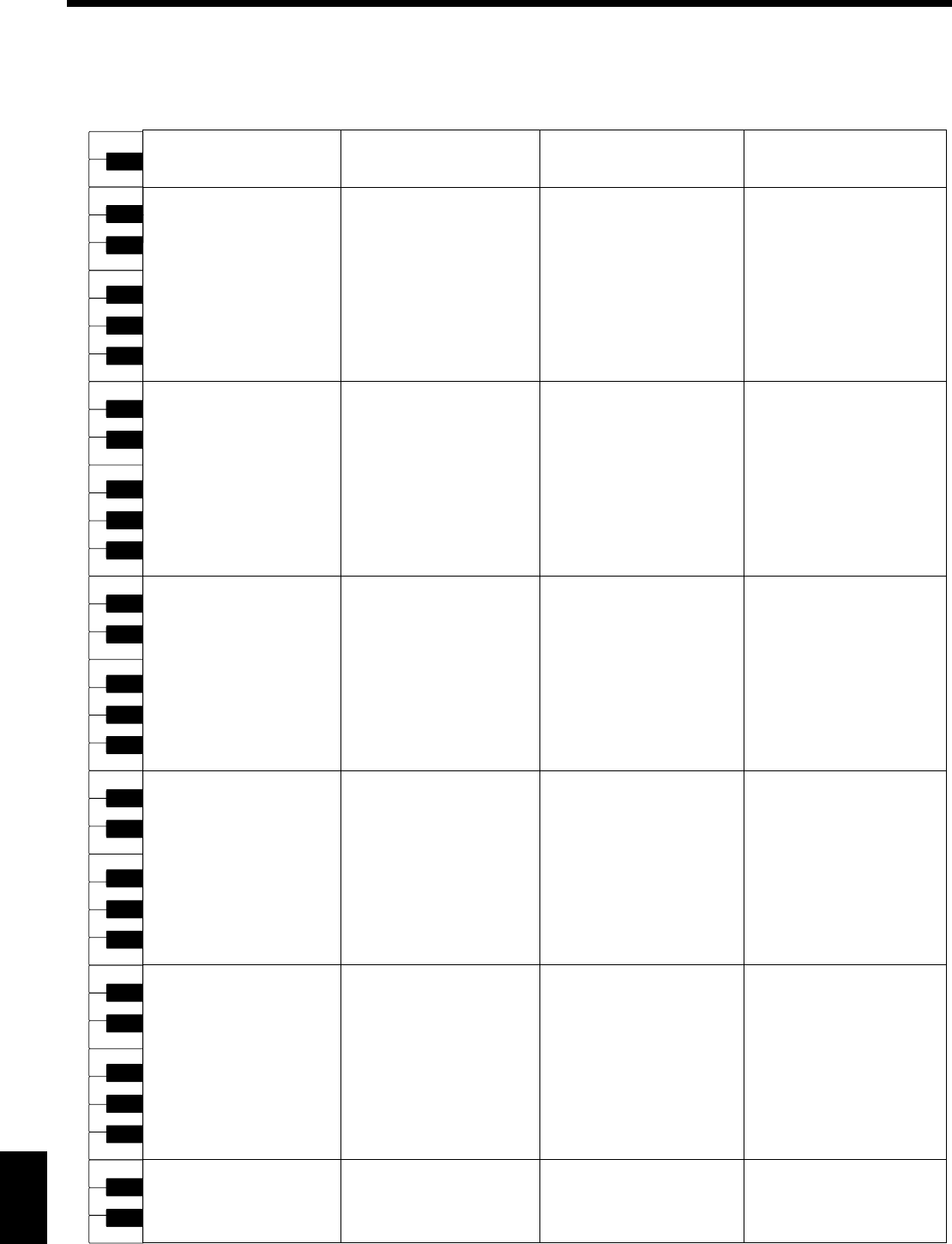
174
Drum Set List
Appendices
* -----: No sound.
* [EXC]: will not sound simultaneously with other percussion instruments of the same number.
----
----
----
Bar Chime
Snare Roll
Finger Snap
High Q
Slap
Scratch Push [EXC7]
Scratch Pull [EXC7]
Sticks
Square Click
Metronome Click
Metronome Bell
Power Kick2
Power Kick1
Side Stick 2
Dance Snare1
TR-808 Clap
Power Snare 1
Power Low Tom 2
Closed Hi-hat 4 [EXC1]
Power Low Tom 1
Pedal Hi-hat 2 [EXC1]
Power Mid Tom 2
Open Hi-hat 4 [EXC1]
Power Mid Tom 1
Power High Tom 2
Crash Cymbal 1
Power High Tom 1
Ride Cymbal 1
Chinese Cymbal
Ride Bell
Tambourine
Splash Cymbal
Cowbell
Crash Cymbal 2
Vibra-slap
Ride Cymbal 2
High Bongo 1
Low Bongo 1
Mute High Conga 1
Open High Conga 1
Low Conga 1
High Timbale
Low Timbale
High Agogo
Low Agogo
Cabasa
Maracas
Short Hi Whistle [EXC2]
Long Low Whistle [EXC2]
Short Guiro [EXC3]
Long Guiro [EXC3]
Claves
High Wood Block
Low Wood Block
Mute Cuica [EXC4]
Open Cuica [EXC4]
Mute Triangle1 [EXC5]
Open Triangle 1 [EXC5]
Shaker
Jingle Bell
Bell Tree
Castanets
Mute Surdo [EXC6]
Open Surdo [EXC6]
----
----
----
----
Bar Chime
Snare Roll
Finger Snap
High Q
Slap
Scratch Push 2 [EXC7]
Scratch Pull 2 [EXC7]
Sticks
Square Click
Metronome Click
Metronome Bell
Elec Kick 2
Elec Kick 1
Side Stick 2
Elec Snare 1
TR-808 Clap
Elec Snare 2
Elec Low Tom 2
Closed Hi-hat 3 [EXC1]
Elec Low Tom 1
Pedal Hi-hat 2 [EXC1]
Elec Mid Tom 2
Open Hi-hat 3 [EXC1]
Elec Mid Tom 1
Elec High Tom 2
Crash Cymbal 1
Elec High Tom 1
Ride Cymbal 1
Reverse Cymbal
Ride Bell
Tambourine
Splash Cymbal
Cowbell
Crash Cymbal 2
Vibra-slap
Ride Cymbal 2
High Bongo 1
Low Bongo 1
Mute High Conga 1
Open High Conga 1
Low Conga 1
High Timbale
Low Timbale
High Agogo
Low Agogo
Cabasa
Maracas
Short Hi Whistle [EXC2]
Long Low Whistle [EXC2]
Short Guiro [EXC3]
Long Guiro [EXC3]
Claves
High Wood Block
Low Wood Block
Mute Cuica [EXC4]
Open Cuica [EXC4]
Mute Triangle1 [EXC5]
Open Triangle 1 [EXC5]
Shaker
Jingle Bell
Bell Tree
Castanets
Mute Surdo [EXC6]
Open Surdo [EXC6]
----
----
----
----
Bar Chime
Snare Roll
Finger Snap
High Q
Slap
Scratch Push 2 [EXC7]
Scratch Pull 2 [EXC7]
Sticks
Square Click
Metronome Click
Metronome Bell
TR-909 Kick
TR-808 Kick
TR-808 Rimshot
TR-808 Snare 1
TR-808 Clap
TR-909 Snare 1
TR-808 Low Tom 2
TR-808 CHH [EXC1]
TR-808 Low Tom 1
TR-808 CHH [EXC1]
TR-808 Mid Tom 2
TR-808 OHH [EXC1]
TR-808 Mid Tom 1
TR-808 High Tom 2
TR-808 Cymbal
TR-808 High Tom 1
Ride Cymbal 1
Chinese Cymbal
Ride Bell
Tambourine
Splash Cymbal
TR-808 Cowbell
Crash Cymbal 2
Vibra-slap
Ride Cymbal 2
High Bongo 1
Low Bongo 1
TR-808 High Conga
TR-808 Mid Conga
TR-808 Low Conga
High Timbale
Low Timbale
High Agogo
Low Agogo
Cabasa
TR-808 Maracas
Short Hi Whistle [EXC2]
Long Low Whistle [EXC2]
Short Guiro [EXC3]
Long Guiro [EXC3]
TR-808 Claves
High Wood Block
Low Wood Block
Mute Cuica [EXC4]
Open Cuica [EXC4]
Mute Triangle1 [EXC5]
Open Triangle 1 [EXC5]
Shaker
Jingle Bell
Bell Tree
Castanets
Mute Surdo [EXC6]
Open Surdo [EXC6]
----
POWER ELECTRONIC TR-808/909
----
----
----
Bar Chime
Snare Roll
Finger Snap
High Q
Slap
Scratch Push 2 [EXC7]
Scratch Pull 2 [EXC7]
Sticks
Square Click
Metronome Click
Metronome Bell
TR-808 Kick 2
HipHop BD1
Side Stick 2
Power Snare 2
TR-808 Clap
Elec Snare 3
Elec Low Tom 2
CR-78 CHH [EXC1]
Elec Low Tom 1
TR-808 CHH [EXC1]
Elec Mid Tom 2
CR-78 OHH [EXC1]
Elec Mid Tom 1
Elec High Tom 2
Crash Cymbal 1
Elec High Tom 1
Ride Cymbal 1
Reverse Cymbal
Ride Bell
Tambourine
Splash Cymbal
TR-808 Cowbell
Crash Cymbal 2
Vibra-slap
Ride Cymbal 2
High Bongo 1
Low Bongo 1
Mute High Conga 1
Open High Conga 1
Low Conga 1
High Timbale
Low Timbale
High Agogo
Low Agogo
Cabasa
TR-808 Maracas
Short Hi Whistle [EXC2]
Long Low Whistle [EXC2]
Short Guiro [EXC3]
Long Guiro [EXC3]
TR-808 Claves
High Wood Block
Low Wood Block
High Hoo [EXC4]
Low Hoo [EXC4]
Mute Triangle1 [EXC5]
Open Triangle 1 [EXC5]
Shaker
Jingle Bell
Bell Tree
Castanets
Mute Surdo [EXC6]
Open Surdo [EXC6]
----
DANCE
27
28
29
31
33
35
30
32
34
21
23
22
39
40
41
43
45
47
42
44
46
36
38
37
87
88
84
86
85
51
52
53
55
57
59
54
56
58
48
50
49
63
64
65
67
69
71
66
68
70
60
62
61
75
76
77
79
81
83
78
80
82
72
74
73
C2
C3
C4
C5
C6
26
24
25
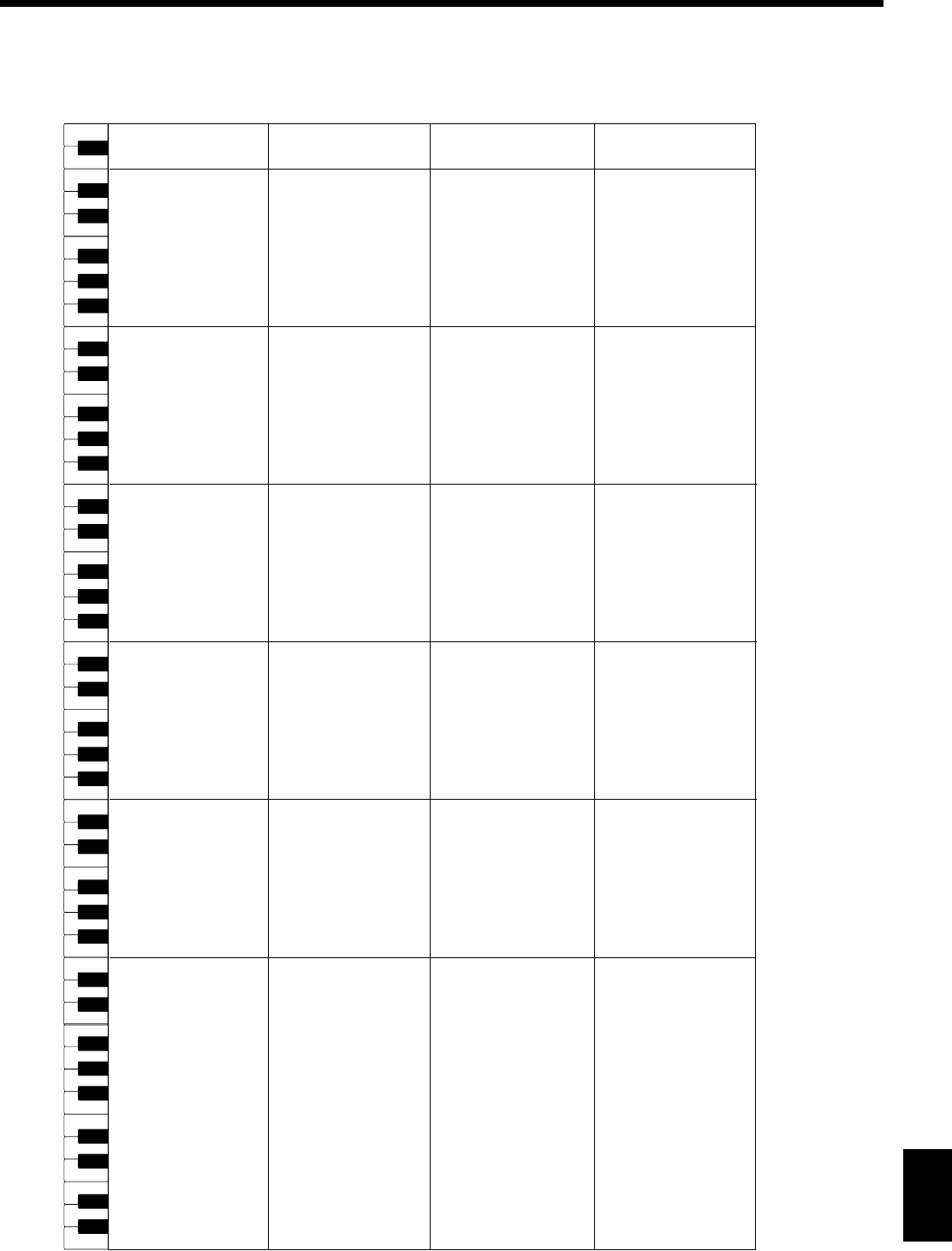
175
Drum Set List
Appendices
* -----: No sound.
* [EXC]: will not sound simultaneously with other percussion instruments of the same number.
■SFX Set
-----
-----
-----
Bar Chime
Snare Roll
Finger Snap
High Q
Slap
Scratch Push [EXC7]
Scratch Pull [EXC7]
Sticks
Square Click
Metronome Click
Metronome Bell
Jazz Kick 2
Jazz Kick 1
Side Stick 2
Jazz Snare 1
Hand Clap 3
Standard 2 Snare 2
Low Tom 2
Closed Hi-hat 3 [EXC1]
Low Tom 1
Pedal Hi-hat 2 [EXC1]
Mid Tom 2
Open Hi-hat 3 [EXC1]
Mid Tom 1
High Tom 2
Crash Cymbal 1
High Tom 1
Ride Cymbal 1
Chinese Cymbal
Ride Bell
Tambourine
Splash Cymbal
Cowbell
Crash Cymbal 2
Vibra-slap
Ride Cymbal 2
High Bongo 1
Low Bongo 1
Mute High Conga 1
Open High Conga 1
Low Conga 1
High Timbale
Low Timbale
High Agogo
Low Agogo
Cabasa
Maracas
Short Hi Whistle [EXC2]
Long Low Whistle [EXC2]
Short Guiro [EXC3]
Long Guiro [EXC3]
Claves
High Wood Block
Low Wood Block
Mute Cuica [EXC4]
Open Cuica [EXC4]
Mute Triangle1 [EXC5]
Open Triangle 1 [EXC5]
Shaker
Jingle Bell
Bell Tree
Castanets
Mute Surdo [EXC6]
Open Surdo [EXC6]
-----
-----
-----
-----
-----
-----
-----
-----
-----
-----
-----
-----
-----
-----
-----
-----
-----
-----
-----
-----
-----
Bar Chime
Snare Roll
Finger Snap
High Q
Slap
Scratch Push [EXC7]
Scratch Pull [EXC7]
Sticks
Square Click
Metronome Click
Metronome Bell
Jazz Kick 2
Jazz Kick 1
Side Stick 2
Brush Tap
Brush Slap
Brush Swirl
Brush Low Tom 2
Brush Closed Hi-hat [EXC1]
Brush Low Tom 1
Pedal Hi-hat 2 [EXC1]
Brush Mid Tom 2
Brush Open Hi-hat [EXC1]
Brush Mid Tom 1
Brush High Tom 2
Brush Crash Cymbal
Brush High Tom 1
Brush Ride Cymbal
Chinese Cymbal
Brush Ride Bell
Tambourine
Splash Cymbal
Cowbell
Crash Cymbal 2
Vibra-slap
Ride Cymbal 2
High Bongo 1
Low Bongo 1
Mute High Conga 1
Open High Conga 1
Low Conga 1
High Timbale
Low Timbale
High Agogo
Low Agogo
Cabasa
Maracas
Short Hi Whistle [EXC2]
Long Low Whistle [EXC2]
Short Guiro [EXC3]
Long Guiro [EXC3]
Claves
High Wood Block
Low Wood Block
Mute Cuica [EXC4]
Open Cuica [EXC4]
Mute Triangle1 [EXC5]
Open Triangle 1 [EXC5]
Shaker
Jingle Bell
Bell Tree
Castanets
Mute Surdo [EXC6]
Open Surdo [EXC6]
-----
-----
-----
-----
-----
-----
-----
-----
-----
-----
-----
-----
-----
-----
-----
-----
-----
-----
JAZZ BRUSH
-----
-----
-----
Bar Chime
Snare Roll
Finger Snap
Closed Hi-hat 3 [EXC1]
Pedal Hi-hat 2 [EXC1]
Open Hi-hat 3 [EXC1]
Ride Cymbal 1
Sticks
Square Click
Metronome Click
Metronome Bell
Jazz Kick 1
Concert BD
Side Stick 2
Concert SD
Castanets
Concert SD
Timpani F
Timpani F#
Timpani G
Timpani G#
Timpani A
Timpani A#
Timpani B
Timpani c
Timpani c#
Timpani d
Timpani d#
Timpani e
Timpani f
Tambourine
Splash Cymbal
Cowbell
Concert Cymbal 2
Vibra-slap
Concert Cymbal 1
High Bongo 1
Low Bongo 1
Mute High Conga 1
Open High Conga 1
Low Conga 1
High Timbale
Low Timbale
High Agogo
Low Agogo
Cabasa
Maracas
Short Hi Whistle [EXC2]
Long Low Whistle [EXC2]
Short Guiro [EXC3]
Long Guiro [EXC3]
Claves
High Wood Block
Low Wood Block
Mute Cuica [EXC4]
Open Cuica [EXC4]
Mute Triangle1 [EXC5]
Open Triangle 1 [EXC5]
Shaker
Jingle Bell
Bell Tree
Castanets
Mute Surdo [EXC6]
Open Surdo [EXC6]
Applause
-----
-----
-----
-----
-----
-----
-----
-----
-----
-----
-----
-----
-----
-----
-----
-----
-----
ORCHESTRA
-----
-----
-----
-----
-----
-----
-----
-----
-----
-----
-----
-----
-----
-----
-----
-----
-----
-----
High Q
Slap
Scratch Push [EXC7]
Scratch Pull [EXC7]
Sticks
Square Click
Metronome Click
Metronome Bell
Guitar sliding Finger
Guitar cutting noise (up)
Guitar cutting noise (down)
String slap of double bass
Fl.Key Click
Laughing
Screaming
Punch
Heart Beat
Footsteps1
Footsteps2
Applause
Door Creaking
Door
Scratch
Wind Chimes
Car-Engine
Car-Stop
Car-Pass
Car-Crash
Siren
Train
Jetplane
Helicopter
Starship
Gun Shot
Machine Gun
Lasergun
Explosion
Dog
Horse-Gallop
Birds
Rain
Thunder
Wind
Seashore
Stream
Bubble
Cat
Bird
BabyLaughing
Boeeeen
SFX Set
Glass & Glam
Ice Ring
Crack Bottle
Pour Bottle
Car Horn
R.Crossing
SL 1
SL 2
Seal
Fancy Animal
Elephant
Bike
-----
Small Club
-----
-----
-----
27
28
29
31
33
35
30
32
34
21
23
22
39
40
41
43
45
47
42
44
46
36
38
37
87
88
84
86
85
51
52
53
55
57
59
54
56
58
48
50
49
63
64
65
67
69
71
66
68
70
60
62
61
75
76
77
79
81
83
78
80
82
72
74
73
C2
C3
C4
C5
C6
26
24
25
89
91
93
95
90
92
94
99
100
101
103
105
102
104
96
98
97
C7
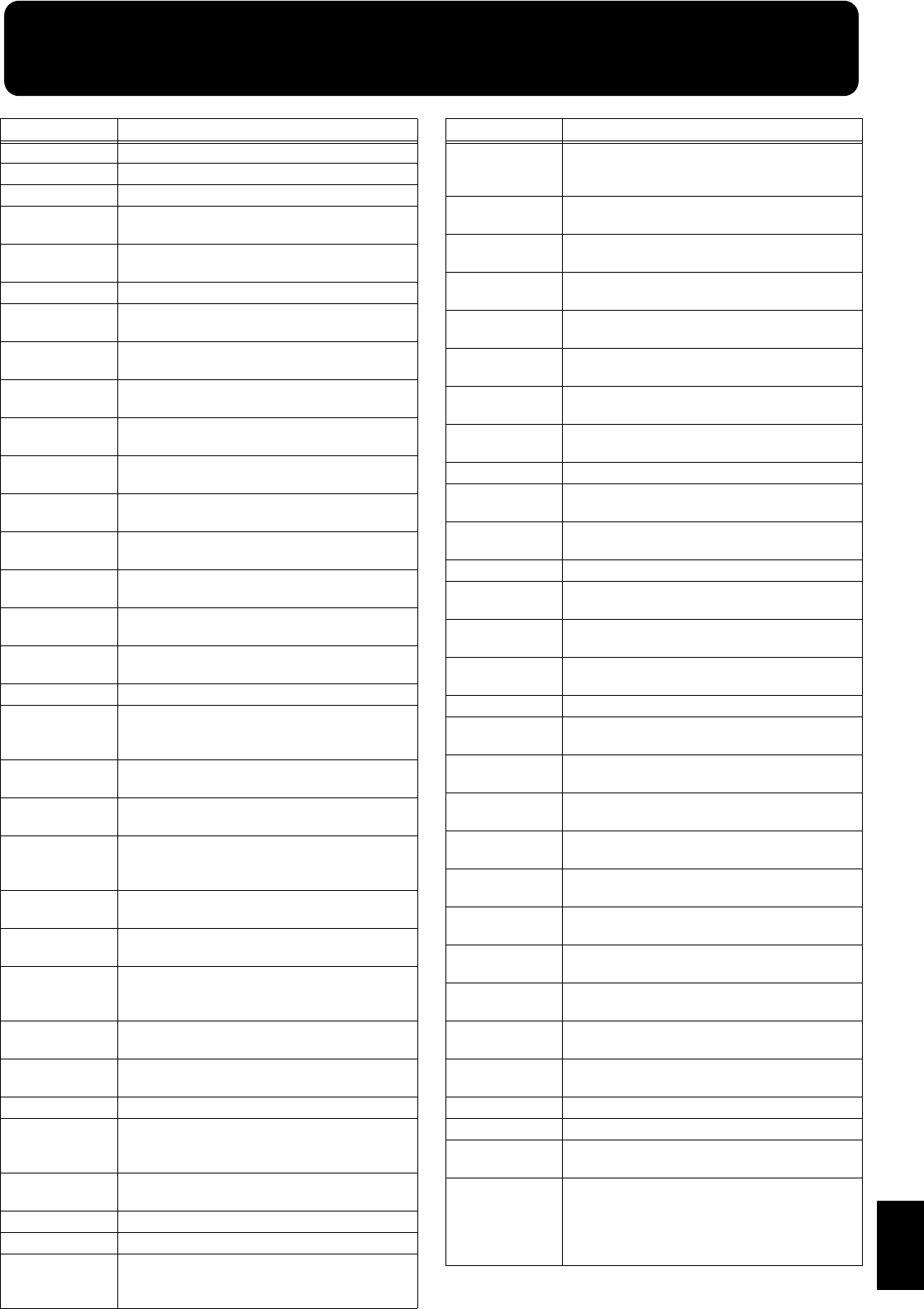
176
Appendices
Effects List
Effect Type Explanation
Equalizer This is a four-band stereo equalizer (low, high).
Spectrum This is a stereo spectrum.
Enhancer Adds sparkle and tightness to the sound.
Isolator Adds a special effect to the sound by cutting the
volume in varying ranges.
Low Boost Boosts the volume of the lower range, creating
powerful lows.
High Pass Filter @@@@@@@@@@@@@@@@@@@@@
Overdrive Creates a soft distortion similar to that produced
by vacuum tube amplifiers.
Distortion Produces a more intense distortion than Over-
drive.
Overdrive2 This is an overdrive that provides heavy distor-
tion.
Distortion2 This is a distortion effect that provides heavy dis-
tortion.
Speaker Simula-
tor
Simulates the speaker type and mic settings used
to record the speaker sound.
Guitar Amp Sim-
ulator
This is an effect that simulates the sound of a gui-
tar amplifier.
Phaser A phase-shifted sound is added to the original
sound and modulated.
Multi Stage
Phaser
Extremely high settings of the phase difference
produce a deep phaser effect.
Infinite Phaser A phaser that continues raising/lowering the fre-
quency at which the sound is modulated.
Stereo Flanger It produces a metallic resonance that rises and
falls like a jet airplane taking off or landing.
3D Flanger This applies a 3D effect to the flanger sound.
2Band Flanger
A flanger that lets you apply an effect indepen-
dently to the low-frequency and high-frequency
ranges.
Auto Wah Cyclically controls a filter to create cyclic change
in timbre.
Humanizer Adds a vowel character to the sound, making it
similar to a human voice.
Ring Modulator
This is an effect that applies amplitude modula-
tion (AM) to the input signal, producing bell-like
sounds.
Tremolo Cyclically modulates the volume to add tremolo
effect to the sound.
Auto Pan Cyclically modulates the stereo location of the
sound.
Slicer
By applying successive cuts to the sound, this ef-
fect turns a conventional sound into a sound that
appears to be played as a backing phrase.
Compressor Flattens out high levels and boosts low levels,
smoothing out fluctuations in volume.
Limiter Compresses signals that exceed a specified vol-
ume level, preventing distortion from occurring.
Stereo Chorus This is a stereo chorus.
Hexa Chorus
Uses a six-phase chorus (six layers of chorused
sound) to give richness and spatial spread to the
sound.
Tremolo Chorus This is a chorus effect with added Tremolo (cyclic
modulation of volume).
Space D Produces a transparent chorus effect.
3D Chorus This applies a 3D effect to the chorus sound.
2 Band Chorus
A chorus effect that lets you apply an effect inde-
pendently to the low-frequency and high-fre-
quency ranges.
Rotary
The Rotary effect simulates the sound of the rota-
ry speakers often used with the electric organs of
the past.
Rotary2 This type provides modified response for the ro-
tary speaker, with the low end boosted further.
Rotary Multi It comprises vibrato/chorus, overdrive, and rota-
ry effects.
Stereo Delay1 This is a stereo delay.
@@@@@@@@@@@@@@@@@
Stereo Delay2 This is a stereo delay.
@@@@@@@@@@@@@@@@@
Stereo Delay3 This is a stereo delay.
@@@@@@@@@@@@@@@@@
Stereo Delay4 This is a stereo delay.
@@@@@@@@@@@@@@@@@
Stereo Delay5 This is a stereo delay.
@@@@@@@@@@@@@@@@@
Monaural Delay This is a monaural delay.
Modulation
Delay Adds modulation to the delayed sound.
Triple Tap Delay Produces three delay sounds; center, left and
right.
3D Delay This applies a 3D effect to the delay sound.
Tape Echo A virtual tape echo that produces a realistic tape
delay sound.
Reverse Delay This is a reverse delay that adds a reversed and
delayed sound to the input sound.
Lo-Fi This is an effect that intentionally degrades the
sound quality for creative purposes.
Telephone This applies a telephone sound.
Gate Cuts the reverb's delay according to the volume of
the sound sent into the effect.
Overdrive ->
Chorus
This effect connects an overdrive and a chorus in
series.
Overdrive ->
Flanger
This effect connects an overdrive and a flanger in
series.
Overdrive ->
Delay
This effect connects an overdrive and a delay in
series.
Distortion ->
Chorus
This effect connects an distortion and a chorus in
series.
Distortion ->
Flanger
This effect connects an distortion and a flanger in
series.
Distortion ->
Delay
This effect connects an distortion and a delay in
series.
Enhancer ->
Chorus
This effect connects an enhancer and a chorus in
series.
Enhancer ->
Flanger
This effect connects an enhancer and a flanger in
series.
Enhancer ->
Delay
This effect connects an enhancer and a delay in se-
ries.
Chorus -> Delay This effect connects a chorus and a delay in series.
Flanger -> Delay This effect connects a flanger and a delay in series.
Chorus ->
Flanger
This effect connects a chorus and a flanger in se-
ries.
Sympathetic
Resonance
On an acoustic piano, holding down the damper
pedal allows other strings to resonate in sympa-
thy with the notes you play, creating rich and spa-
cious resonances. This effect simulates these
damper resonances.
Effect Type Explanation
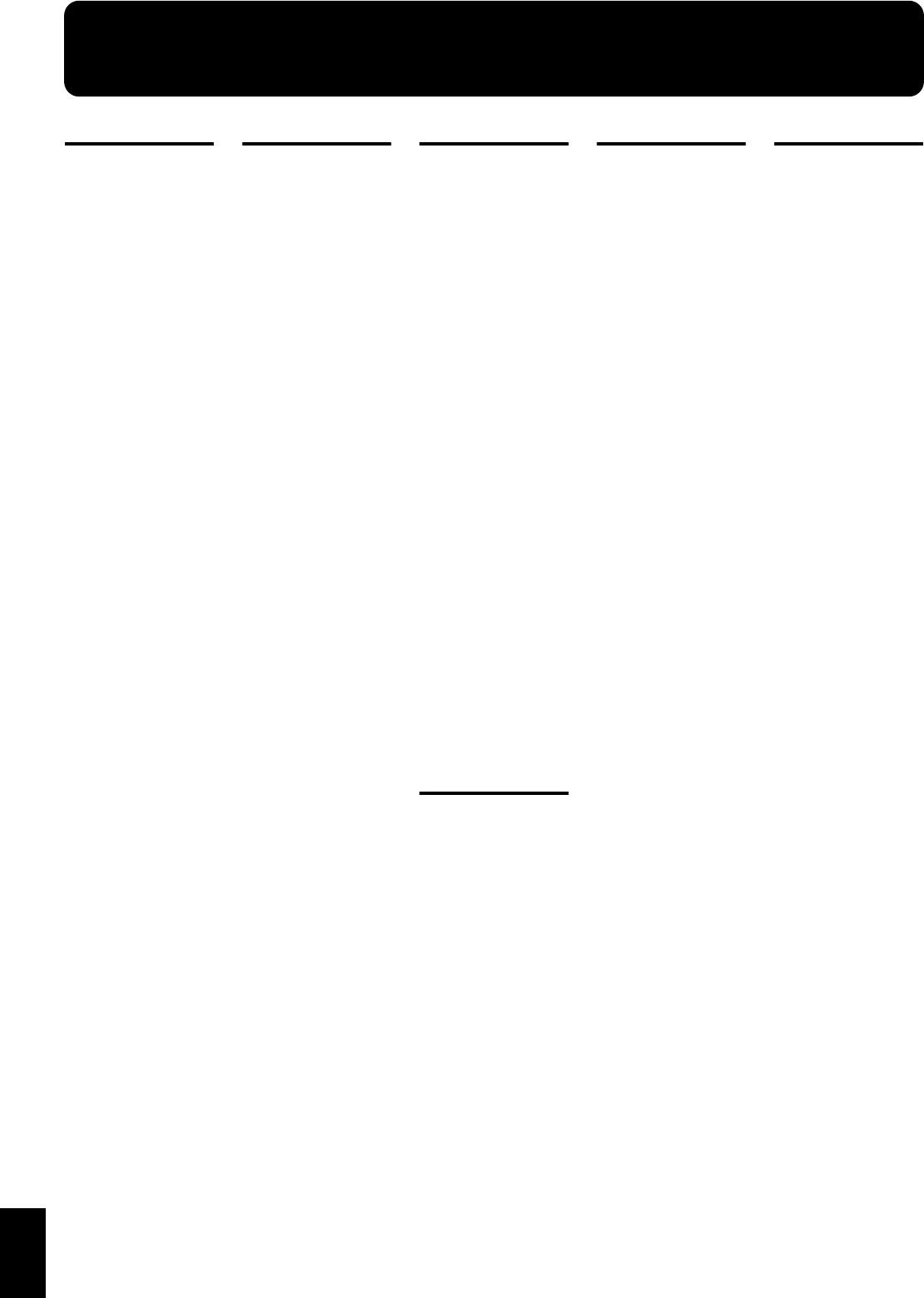
177
Appendices
Music Style List
[Pop/Rock]
Pop
'80s Pop 1
Funky Disco
AdultContemp
Uptown Rock
EZ Listening
Strumin'Away
'70s Disco 1
SmoothContmp
Simple Rock
'60s Feelin'
16Beat Pop
Light Pop
Bright Pop
Heart Beat
Easy Pop
'80s Pop 2
'80s Pop 3
Cute Pop
LovelyShuffl
'70s Disco 2
'70s Dance
Fever Dance
Euro Dance
Hard Tekno
Big House
'90s House
House Pop
Ibiza Dance
Cool Rap
Now Hip Hop
Twostep
HipHop Beat
Hip'n Hop
Easy Hop
MorningShffl
Groovy Pop
Smile Pop
Warm Pop
Sunny Pop
Feel Good
US Groove
Steady Rock
Shuffle Rock
Dyno Rock
Power Rock
Heavy Rock
Thump Rock
Asian Pop
[Ballad/Acoustic]
ModernBallad
'80s Ballad
AcoustBallad
AcoustEzLstn
UnpluggedPop
UnplugBallad
Adult Pop 1
Adult Pop 2
6/8 Ballad
Love Beat
UnplugShuffl
CoolLiveBand
Night Ballad
GuitarShuffl
Euro Ballad
Guitar Trio
MidnightBald
Pop Ballad
Piano Pop
Love Songs
12/8 Ballad
Scat Ballad
'60s Ballad
Torch Song 1
Torch Song 2
Strings
8BeatBallad1
8BeatBallad2
Fireside
Piano Ballad
Story Ballad
SimpleBallad
ClassicBalad
Symph Ballad
R.8-Beat 1
R.8-Beat 2
R.16-Beat 1
R.16-Beat 2
R.16-Beat 3
R.16-Beat 4
R.Afro&Swing
R.5BeatSwing
R.Shuffle 1
R.Waltz 1
R.March 1
R.5-Beat
R.7-Beat
P.Pop 1
P.Classic 1
P.Night
P.Bossa Nova
P.Ragtime
P.Classic 2
P.Ballad 2
P.Swing Pop
P.Rock'nRoll
P.Concerto 1
P.Concerto 2
P.Swing
P.Shuffle
P.Boogie
P.'50s Rock
P.Latin
[Oldies/Country]
Detroit Pop
'60s Rock'n
DreamSloRock
CountryRock1
CountryBald1
Groovin R&B
Oldies 1
Clock Rock'n
CountryPop 1
SwinginCntry
Soul
Rock'n Slow
Oldies 2
CountryBald2
CountrySwing
Rock'n Fever
Country Beat
Slow Country
CountryRock2
Country Fox
Blues
R&B
Slow Dance
Twist
'60s Beach
Slow Oldies
Early Rock
Go Go Rock
Mersey Beat
CountryPop 2
Cajun
Country
Cntry Dreams
Charleston
Bluegrass
Deep Country
[Big Band/
Swing]
MidnitSloSwg
BigBand Slow
Big Band
BigBand Med
BigBand Fast
Medium Swing
Jive
Slow Swing
Quick Step
StringsSwing
Foxtrot
Swing Fox
Fox Band
Gipsy Swing
Fast Swing
JzGuitrSwing
Jazz Waltz
Blue Boogie
BigBandBalad
'30s BigBand
Big Band 2
Jazz Ballad
LooseBigBand
Smooth Jazz
A Cappella
Scat Swing
Organ Swing
Dixieland
Hawaiian
Hula
[Gospel/Latin]
Latin Pop 1
Orch Bossa
Rhumba
GospelShuffl
ContPraise 1
ContPraise 2
Gospel
Samba
ModernChaCha
Salsa
Soft Gospel
Gospel Shout
AcoustRhumba
Acoust Samba
Trad Rhumba
Gospel Pop
GospelBallad
Latin Dance
Cha Cha
Trad Tango
SunshineBosa
Jazz Bossa
Merengue
GuitarRhumba
Mambo
Fast Samba
Fast Bossa
Big Samba
Luv Bossa
Mid Bossa
Latin Pop 2
Reggae
Tango
Beguine
Oye Son
Revival
Gospel Piano
Asian Rhumba
[Trad/World]
Musical
Pub Boogie
Vienna Waltz
Kids Shuffle
Movie March
Music Hall
Orch Bolero
Orch Waltz
Holiday 1
Classic
Jing Ju
MarchingBand
March
Slow Waltz
Fast Waltz
Paris
Quiet Waltz
Holiday 2
Holiday 3
2 Beat
Lager Polka
Slow Polka
AustrianPolk
AustrianWalz
Irish
Tejano
Celtic
Musette
Scotland
Japan
Ireland
Paso Doble
China Pop
Jiang Nan
Xi Bei
SchlagerBeat
PartySchlagr
'70sSchlager
Disco Fox
Party Polka
RockSchlager
ShufflSchlgr
SimpleMarch1
SimpleMarch2
Simple Waltz
Kids 4/4
Kids 6/8
Kids
Kids Dance
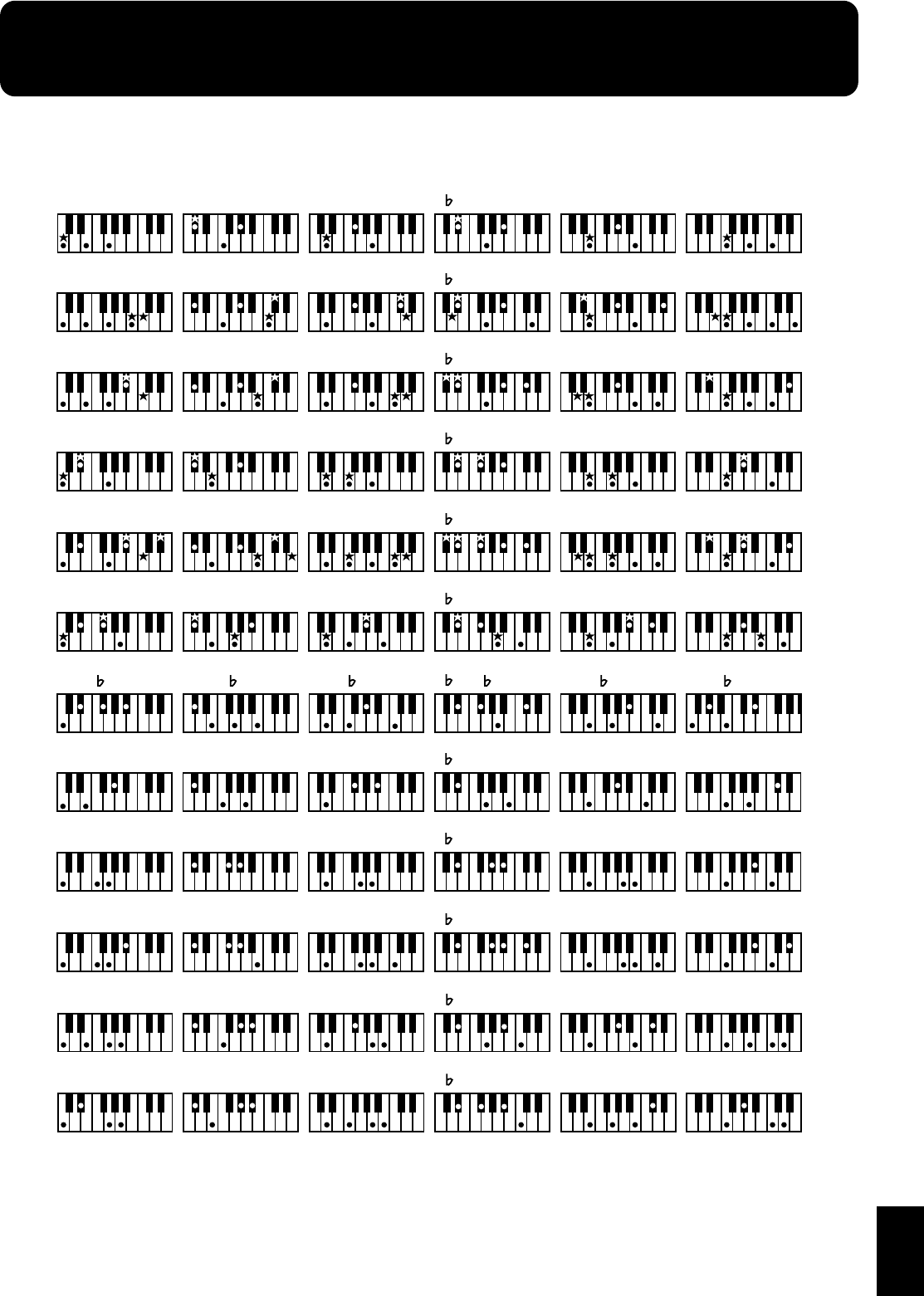
178
Appendices
Chord List
*● symbol: Indicates the constituent note of chords.
*★ symbol: Chord shown with an “★”can be played by pressing just the key marked with the “★” (p. 48).
Cm7 ( 5 )
C C# D E E F
Cmaj7 C#maj7 Dmaj7 E maj7 Emaj7 Fmaj7
C7 C#7 D7 E 7 E7 F7
Cm C#m Dm E m Em Fm
Cm7 C#m7 Dm7 E m7 Em7 Fm7
Cdim C#dim Ddim E dim Edim Fdim
Dm7 ( 5 ) Em7 ( 5 )
Caug C#aug Daug E aug Eaug Faug
Csus4 C#sus4 Dsus4 E sus4 Esus4 Fsus4
C7sus4 C#7sus4 D7sus4 E 7sus4 E7sus4 F7sus4
Fm7 ( 5 )E m7 ( 5 )C#m7 ( 5 )
C6 C#6 D6 E 6 E6
Cm6 Dm6 Em6
F6
Fm6
C#m6 E m6
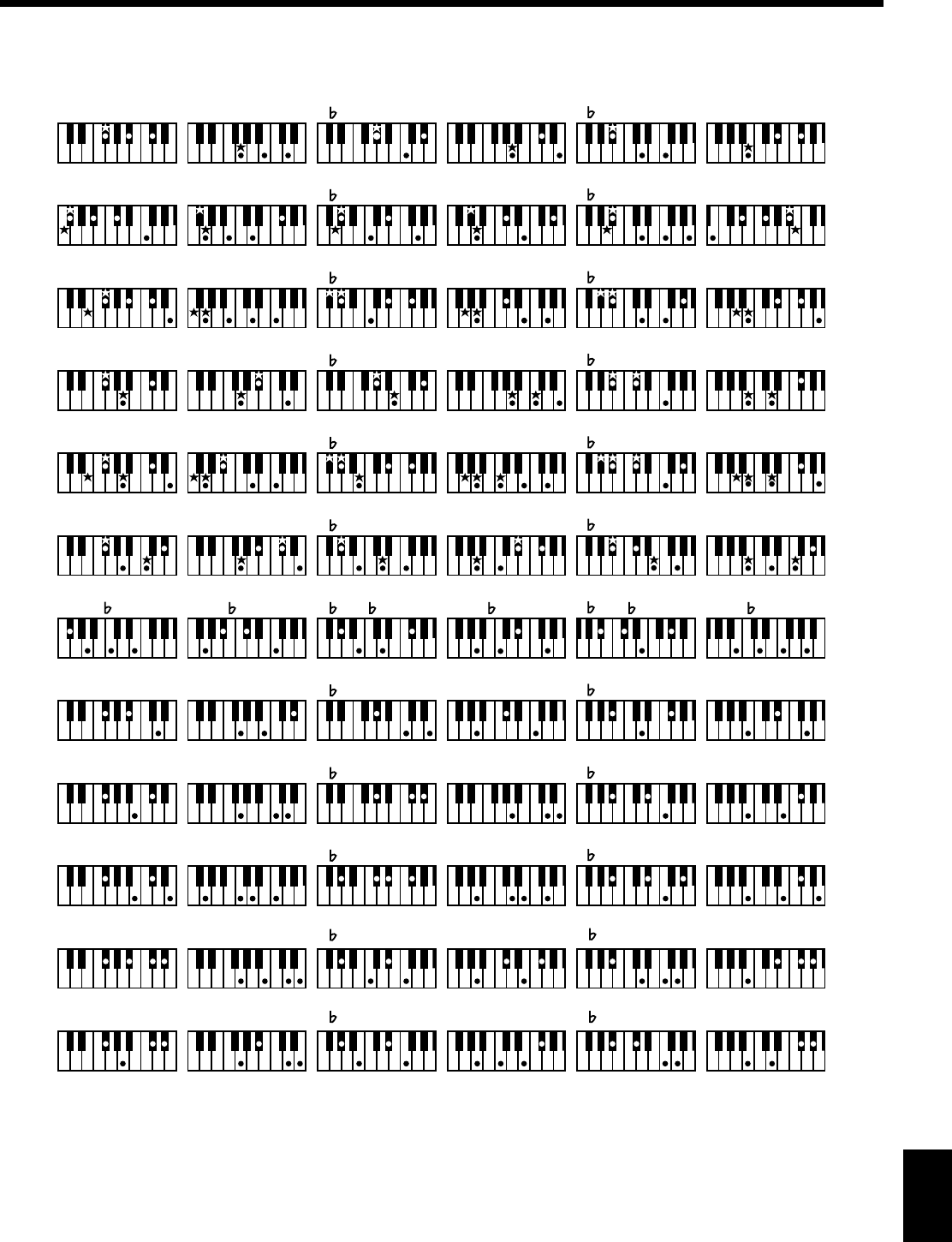
179
Chord List
Appendices
*● symbol: Indicates the constituent note of chords.
*★ symbol: Chord shown with an “★”can be played by pressing just the key marked with the “★” (p. 48).
F# G A A B B
F#maj7 Gmaj7 A maj7 Amaj7 B maj7 Bmaj7
F#7 G7 A 7 A7 B 7 B7
F#m Gm A m Am B m Bm
F#m7 Gm7 A m7 Am7 B m7 Bm7
F#dim Gdim A dim Adim B dim Bdim
Gm7 ( 5 ) Am7 ( 5 ) Bm7 ( 5 )
F#aug Gaug A aug Aaug B aug Baug
F#sus4 Gsus4 A sus4 Asus4 B sus4 Bsus4
F#7sus4 G7sus4 A 7sus4 A7sus4 B 7sus4 B7sus4
B m7 ( 5 )A m7 ( 5 )F#m7 ( 5 )
G6
Gm6
A6A 6 B6
Bm6
B 6
B m6Am6A m6
F#6
F#m6
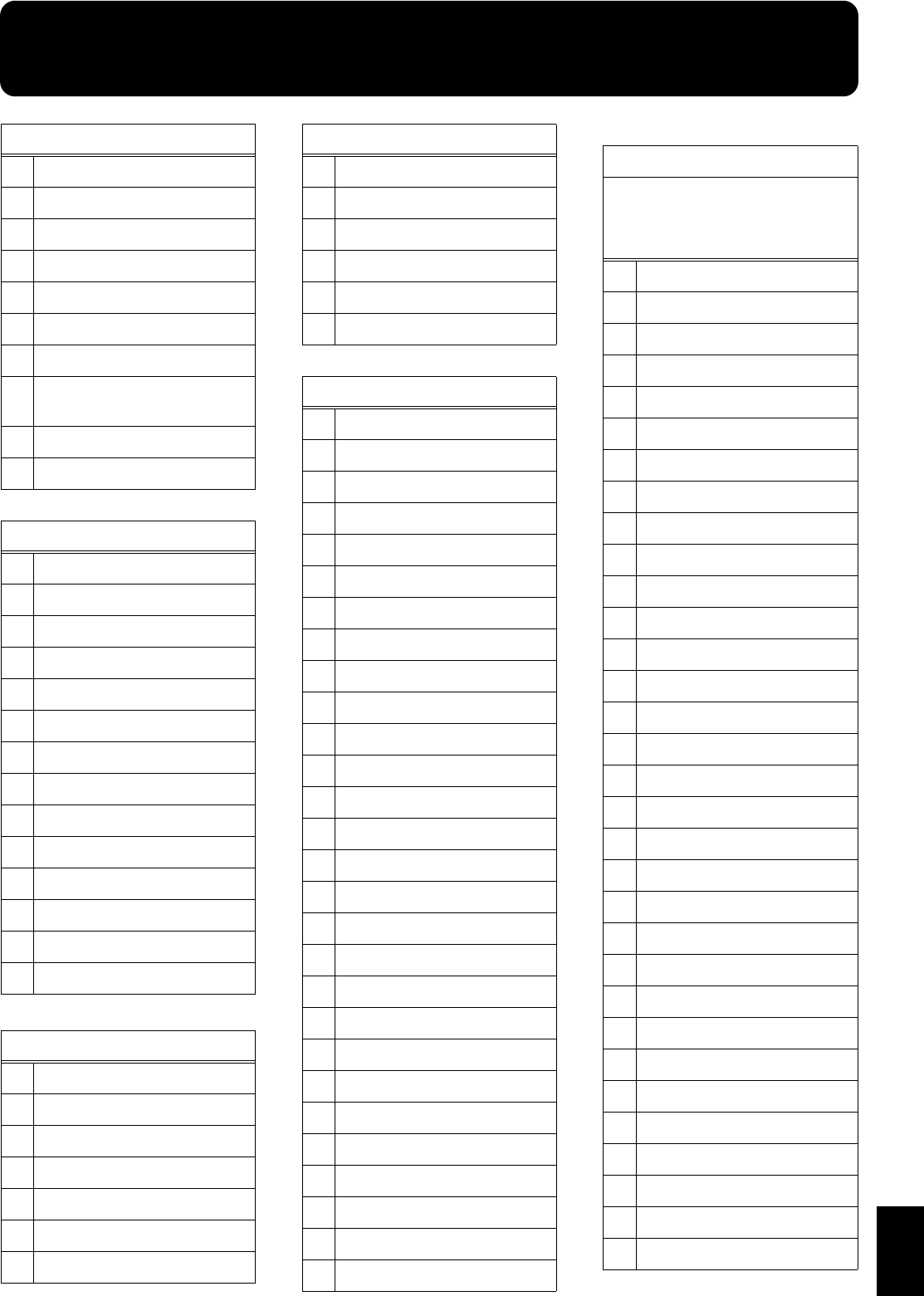
180
Appendices
Internal Song List
Folks
1 Greensleeves
2 Entertainer
3 Annie Laurie
4 Londonderry Air
5 Ave Maria
6 Amazing Grace
7 Little Brown Jug
8When The Saints Go Marchin'
In
9 Stagecoach
10 Hallelujah!
Jazzy
1 Fly Free
2 Secret Agent
3 Late Night Chopin
4 Blue Sky Rag
5 Preludelight
6 Sun Daze
7 Keepers Tale
8 Count On The Blues
9 One Down And Easy
10 A Prelude To ...
11 Bach’s A Boppin’
12 Kismet’s Salsa
13 From Matthew’s Passion
14 Roll Over Ludwig
Kids
1 Grandfather’s Clock
2 Old MacDonald Had A Farm
3 Twinkle Twinkle, Little Star
4 Mary Had A Little Lamb
5 London Bridge
6 Jingle Bells
7 Silent Night, Holy Night
8 Joy To The World
9 Puppy’s March
10 Frog Song
11 Little Fox
12 Lightly Row
13 The Cuckoo
EZ Classical
1 La Fille Aux Cheveux De Lin
2 La Campanell
3 Eine Kleine Nachtmusik
4 Les patineurs, Valse
5 Divertimento
6 Impromptu, Op.90-2
7 Gnossienne 1
8 Die Lorelei
9 Brindisi
10 Air sul G
11 FantaisieImpromptu
12 Grande Valse Brillante
13 Gymnopedie 1
14 Liebestraume 3
15 Mondschein
16 Nocturne No.2
17 Valse, op.64-1
18 Prelude, op.28-15
19 Traumerei
20 Turkischer Marsch(Mozart)
21 Ungarische Tanze 5
22 O’sole Mio
23 La Primavera
24 Trepak
25 Canon (Pachelbel)
26 Ombra maifu
27 Sonata (Haydn)
28 Italian Concerto
Kids
Classical
→Song files of this genre corresponds to
the included collection of printed music
entitled “Roland 60 Classical Piano
Masterpieces.”
1 Sonate No.15
2 Liebestraume 3
3 Etude, op.10-3
4 Je te veux
5 Valse, op.64-1
6 Golliwog’sCakewalk
7 FantaisieImpromptu
8 Arabesque 1
9 Blauen Donau
10 Auf Flugeln des Gesanges
11 Mazurka No.5
12 Gymnopedie 1
13 Etude, op.25-1
14 Clair de Lune
15 Etude, op.10-5
16 Dr.GradusAdParnassum
17 Grande Valse Brillante
18 La priere d’une Vierge
19 Course en Troika
20 To The Spring
21 Valse, op.64-2
22 Radetzky Marsch
23 Traumerei
24 Moments Musicaux 3
25 Prelude, op.28-15
26 Harmonious Blacksmith
27 Ungarische Tanze 5
28 Turkischer Marsch(Beethoven)
29 Nocturne No.2
30 Fruhlingslied
31 Praludium
32 Jagerlied
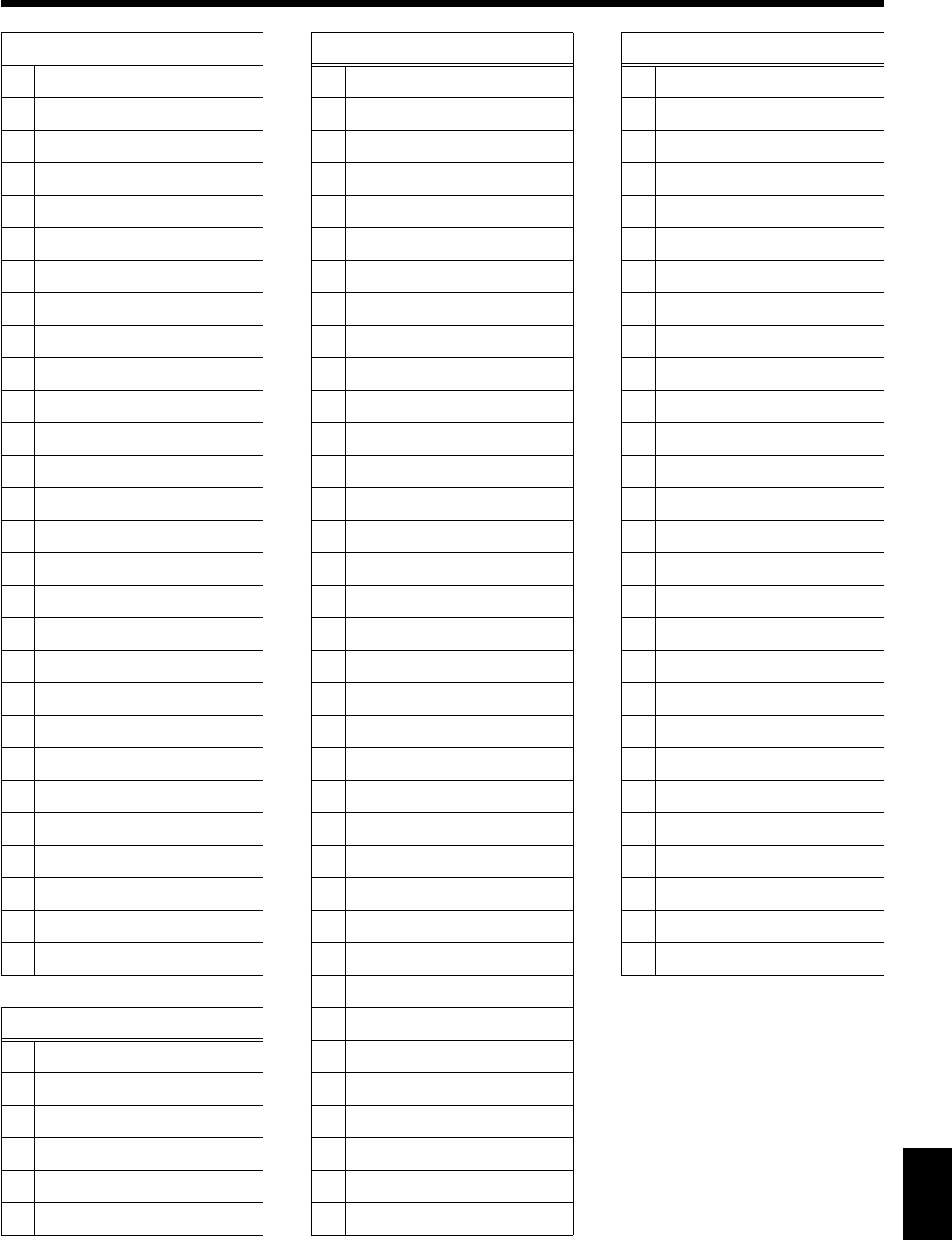
181
Internal Song List
Appendices
981a
* All rights reserved. Unauthorized use
of this material for purposes other than
private, personal enjoyment is a
violation of applicable laws.
33 Menuet Antique
34 Fur Elise
35 Turkischer Marsch(Mozart)
36 Standchen
37 Humoreske
38 Blumenlied
39 Alpenglockchen
40 Menuett G dur(Beethoven)
41 Venezianisches Gondellied
42 Alpenabendrote
43 Farewell to the Piano
44 Brautchor
45 Battle of Waterloo
46 Wiener Marsch
47 Le Coucou
48 Menuett G dur(Bach)
49 Spinnerlied
50 Gavotte
51 Heidenroslein
52 Zigeuner Tanz
53 La Cinquantaine
54 Csikos Post
55 Dolly’s Dreaming Awakening
56 La Violette
57 Frohlicher Landmann
58 Sonatine op.36-1(Clementi)
59 Sonatine op.20-1(Kuhlau)
60 Sonatine No.5(Beethoven)
Practice
1 Arabesque
2 Pastoral
3 A Small Gathering
4 Innocence
5 Progress
6 The Clear Stream
Classical
7 Gracefulness
8 The Hunt
9 Tender Flower
10 The Young Shepherdess
11 Farewell
12 Consolation
13 Austrian Dance
14 Ballad
15 Sighing
16 The Chatterbox
17 Restlessness
18 Ave Maria
19 Tarantella
20 Angelic Harmony
21 Gondola Song
22 The Return
23 The Swallow
24 The Knight Errant
25 Openness
26 Invention 1
27 Invention 2
28 Invention 3
29 Invention 4
30 Invention 5
31 Invention 6
32 Invention 7
33 Invention 8
34 Invention 9
35 Invention 10
36 Invention 11
37 Invention 12
38 Invention 13
39 Invention 14
40 Invention 15
41 Beyer 15
42 Beyer 21
Practice
43 Beyer 25
44 Beyer 29
45 Beyer 34
46 Beyer 38
47 Beyer 42
48 Beyer 46
49 Beyer 51
50 Beyer 55
51 Beyer 60
52 Beyer 64
53 Beyer 67
54 Beyer 73
55 Beyer 78
56 Beyer 81
57 Beyer 90
58 Beyer 93
59 Beyer 98
60 Beyer 103
61 Czerny 100- 1
62 Czerny 100-10
63 Czerny 100-20
64 Czerny 100-30
65 Czerny 100-38
66 Czerny 100-43
67 Czerny 100-60
68 Czerny 100-75
69 Czerny 100-86
70 Czerny 100-96
Practice
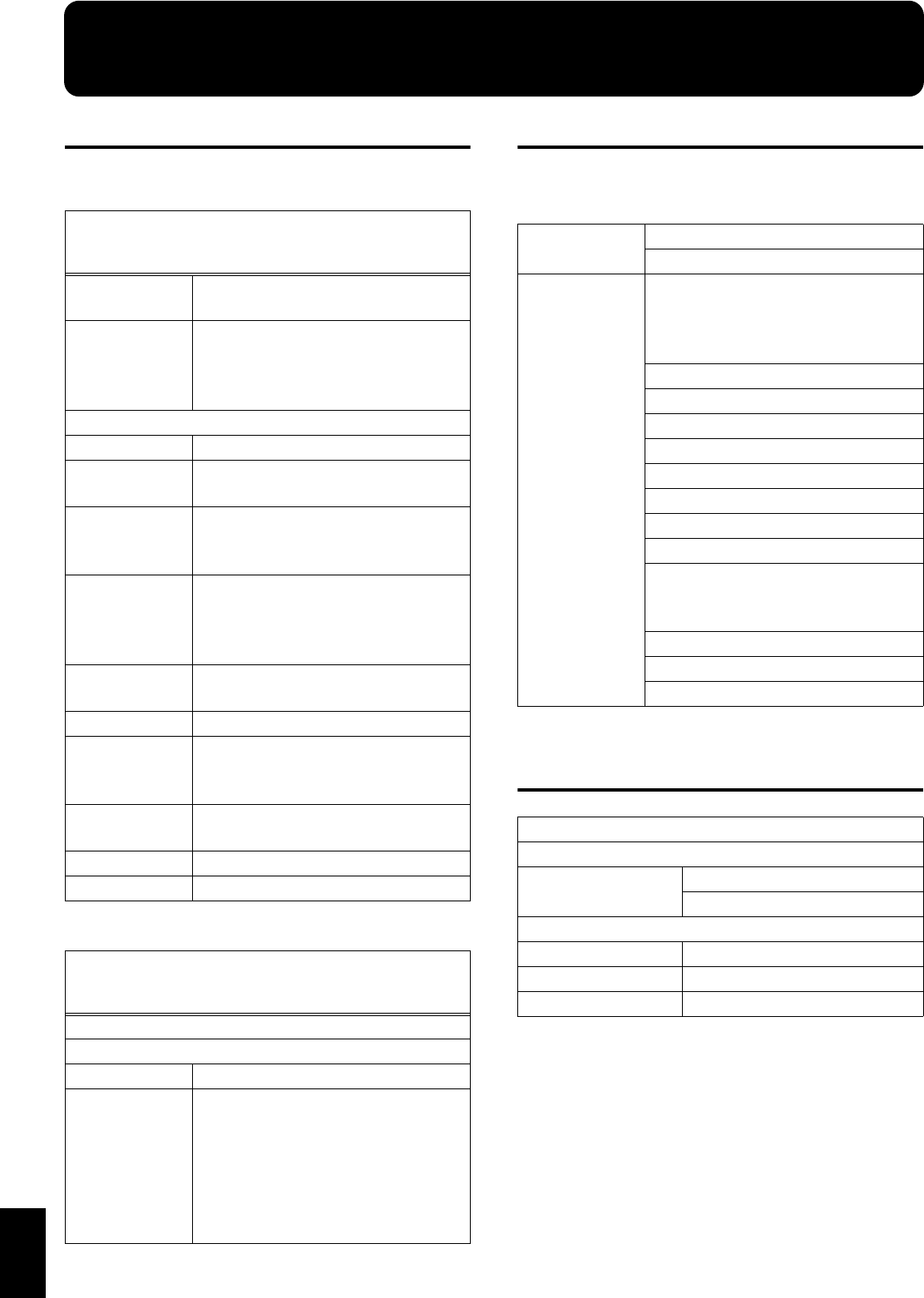
182
Appendices
Parameters Stored to Internal Memory
Parameters Stored in the User Program
→“Saving Performance Settings (User Program)” (p. 108)
Parameters Stored in Memory Backup
→“Remembering the Settings Even When the Power is Turned Off (Memory
Backup)” (p. 148)
Parameters That are Stored After the
Power is Turned Off
Parameters that switch immediately after the User Pro-
gram name is touched when <Option> on the User Pro-
gram screen is set to “Delayed”
Organ Rotary effect (Slow/Fast),
Footage (Upper, Lower), Percussion
Selected
Right-hand Tone,
Layer Tone,
Left-hand Tone
Tone, Octave Shift,
Effect (Type, Control 1, Control 2, On/Off,
+++++++ Part)
Bass Tone, Chord Tone
Part Balance Keyboard Parts
Melody
Intelligent On/Off, Type
Keyboard Mode
Split 1, Split 2, On/Off for the Part,
Layer 1, Layer 2, On/Off for the Part,
Keyboard Transpose, Split Point
Pedal Settings
Functions Assigning to the Left Pedal and
Center Pedal
Bend Range
Functions Assigning to the Expression Pedal
Performance Pad
Settings User Function
Reverb On/Off, Type, Depth
Vocal Effects
On/Off, Echo (Type, Depth),
Transformer Type, Harmonist Type,
Transformer/Harmonist, Music Files Part
MIDI Settings for
User Program
Bank Select LSB, Bank Select MSB,
Program Change, MIDI Transmit Channel
Equalizer On/Off, Each Sliders Level, Master Level
Dynamic Emphasis On/Off, Type
Parameters that switch after the User Program name is
touched for a few moments when <Option> on the User
Program screen is set to “Delayed”
Music Style
Tempo
Part Balance Accompaniment Part
Arranger
Settings
Accompaniment On/Off,
Chord Recognize Mode,
Leading Bass On/Off, Original/Variation,
Sync Start On/Off,
<Accomp> Setting for
Arranger Configuration,
Style Orchestrator, Division
Tone
Parameters
Octave Shift
Effects: On/Off, Type, Control 1, Control 2
System
Parameters
One-Touch Piano Settings:
Lid, Tuning (Tuning, Key, Stretch Tunings),
Resonance (Depth), Key Touch,
Hamper Response (Depth)
Master Tune
Effect: ++++++ Part
Metronome: Sound
Count-In: Measures, Sound
Countdown: Sound
Language
Track Assign
Reverb: On/Off, Type, Depth
Advanced 3D:
On/Off, On/Off for Each Part,
Various Settings
Remote Control’s Setting
External Display (Device)
iR Function
Touch Screen
Opening Message
Auto Demo Start: On/Off
BGM: On/Off
USB Driver
Equalizer User Settings
Jazz Organ Footage User Settings
Piano Designer User Settings
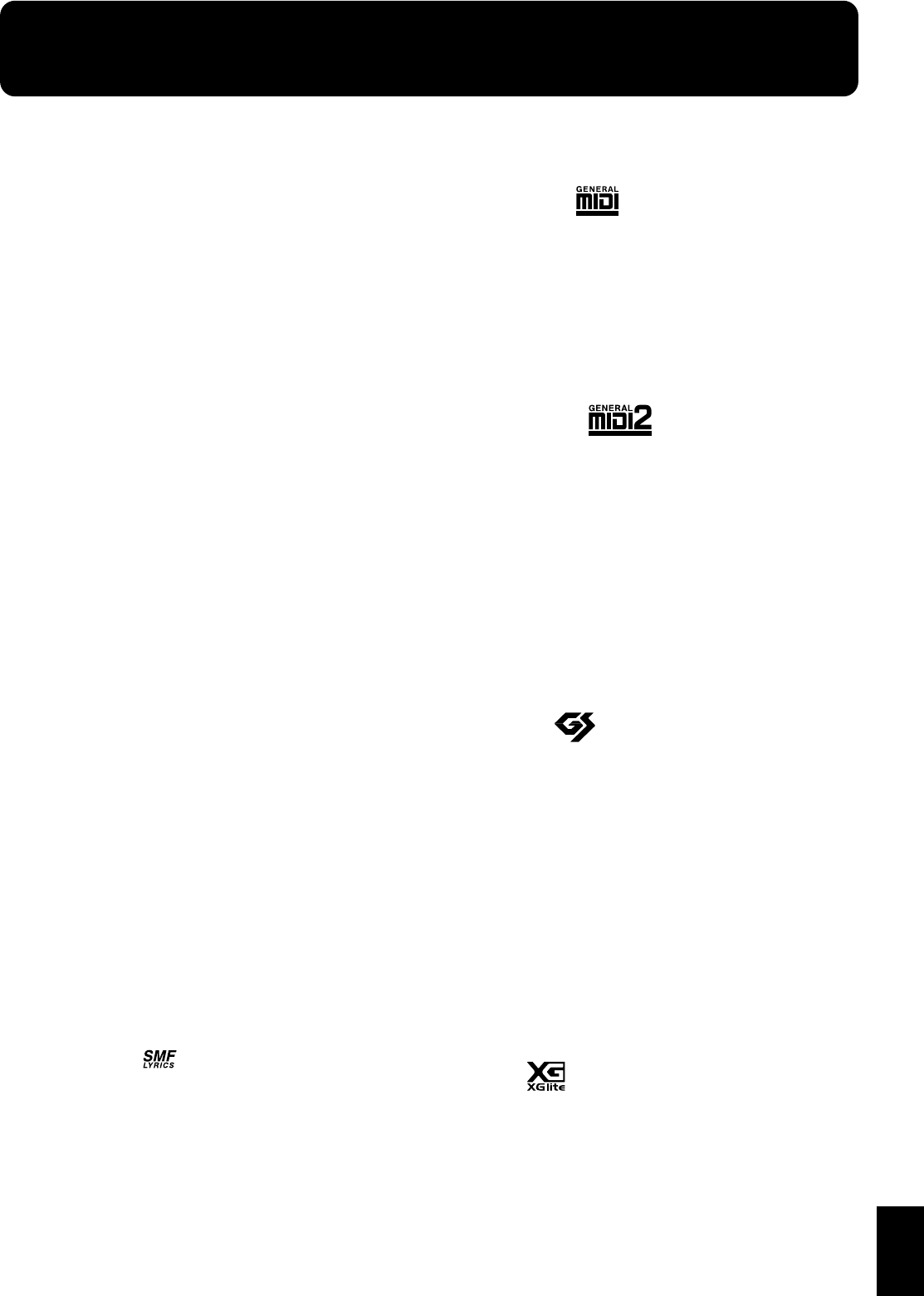
183
Appendices
Music Files That the KR Can Use
What Are Music Files?
Music Files contain information describing the details of a
musical performance, such as “the C3 key on a keyboard was
pressed for this amount of time, using this amount of force.”
By inserting the floppy disk into the disk drive on the KR, the
performance information is sent from the floppy disk to the
piano, and played faithfully by the piano. This is different
than a CD, since the music file does not contain a recording
of the sound itself. This makes it possible to erase certain
parts, or to change instruments, tempos and keys freely,
allowing you to use it in many different ways.
Regarding Copyright
Use of the song data supplied with the Data Disk attached to
this product for any purpose other than private, personal
enjoyment without the permission of the copyright holder is
prohibited by law. Additionally, this data must not be
copied, nor used in a secondary copyrighted work without
the permission of the copyright holder.
■The KR allows you to use the
following music files
●Floppy disks saved on a Roland MT Series, or Roland Piano
Digital HP-G/R and KR Series instrument
●Roland Digital Piano Compatible Music Files
Roland’s original music file is made specifically for practicing the
piano. Some follow an instructional curriculum, allowing for a
complete range of lessons, such as “practicing each hand
separately” or “listening to only the accompaniment.”
●SMF Music Files (720KB/1.44MB format)
SMFs (Standard MIDI Files) use a standard format for music file
that was formulated so that files containing music file could be
widely compatible, regardless of the manufacturer of the
listening device. An enormous variety of music is available,
whether it be for listening, for practicing musical instruments, for
Karaoke, etc.
* If you wish to purchase SMF Music Files, please consult the
retailer where you purchased your KR.
SMF with Lyrics
“SMF with Lyrics” refers to SMF (Standard MIDI File) that
contains the lyrics. When Music Files carrying the “SMF with
Lyrics” logo are played back on a compatible device (one
bearing the same logo), the lyrics will appear in its display.
■About the KR Sound Generator
The KR come equipped with GM 2/GS sound generators.
General MIDI
The General MIDI is a set of recommendations which seeks to
provide a way to go beyond the limitations of proprietary designs,
and standardize the MIDI capabilities of sound generating devices.
Sound generating devices and music files that meets the General
MIDI standard bears the General MIDI logo. Music files bearing the
General MIDI logo can be played back using any General MIDI
sound generating unit to produce essentially the same musical
performance.
General MIDI 2
The upwardly compatible General MIDI 2 recommendations pick up
where the original General MIDI left off, offering enhanced
expressive capabilities, and even greater compatibility. Issues that
were not covered by the original General MIDI recommendations,
such as how sounds are to be edited, and how effects should be
handled, have now been precisely defined. Moreover, the available
sounds have been expanded. General MIDI 2 compliant sound
generators are capable of reliably playing back music files that carry
either the General MIDI or General MIDI 2 logo.
In some cases, the conventional form of General MIDI, which does
not include the new enhancements, is referred to as “General MIDI
1” as a way of distinguishing it from General MIDI 2.
GS Format
The GS Format is Roland’s set of specifications for standardizing the
performance of sound generating devices. In addition to including
support for everything defined by the General MIDI, the highly
compatible GS Format additionally offers an expanded number of
sounds, provides for the editing of sounds, and spells out many
details for a wide range of extra features, including effects such as
reverb and chorus. Designed with the future in mind, the GS Format
can readily include new sounds and support new hardware features
when they arrive. Since it is upwardly compatible with the General
MIDI, Roland’s GS Format is capable of reliably playing back GM
Scores equally as well as it performs GS music files (music files that
have been created with the GS Format in mind). This product
supports both the General MIDI 2 and the GS Format, and can be
used to play back music data carrying either of these logos.
XG lite
XG is a tone generator format of YAMAHA Corporation, that
defines the ways in which voices are expanded or edited and the
structure and type of effects, in addition to the General MIDI 1
specification. XGlite is a simplified version of XG tone generation
format. You can play back any XG music files using an XGlite tone
generator. However, keep in mind that some music files may play
back differently compared to the original files, due to the reduced set
of control parameters and effects.
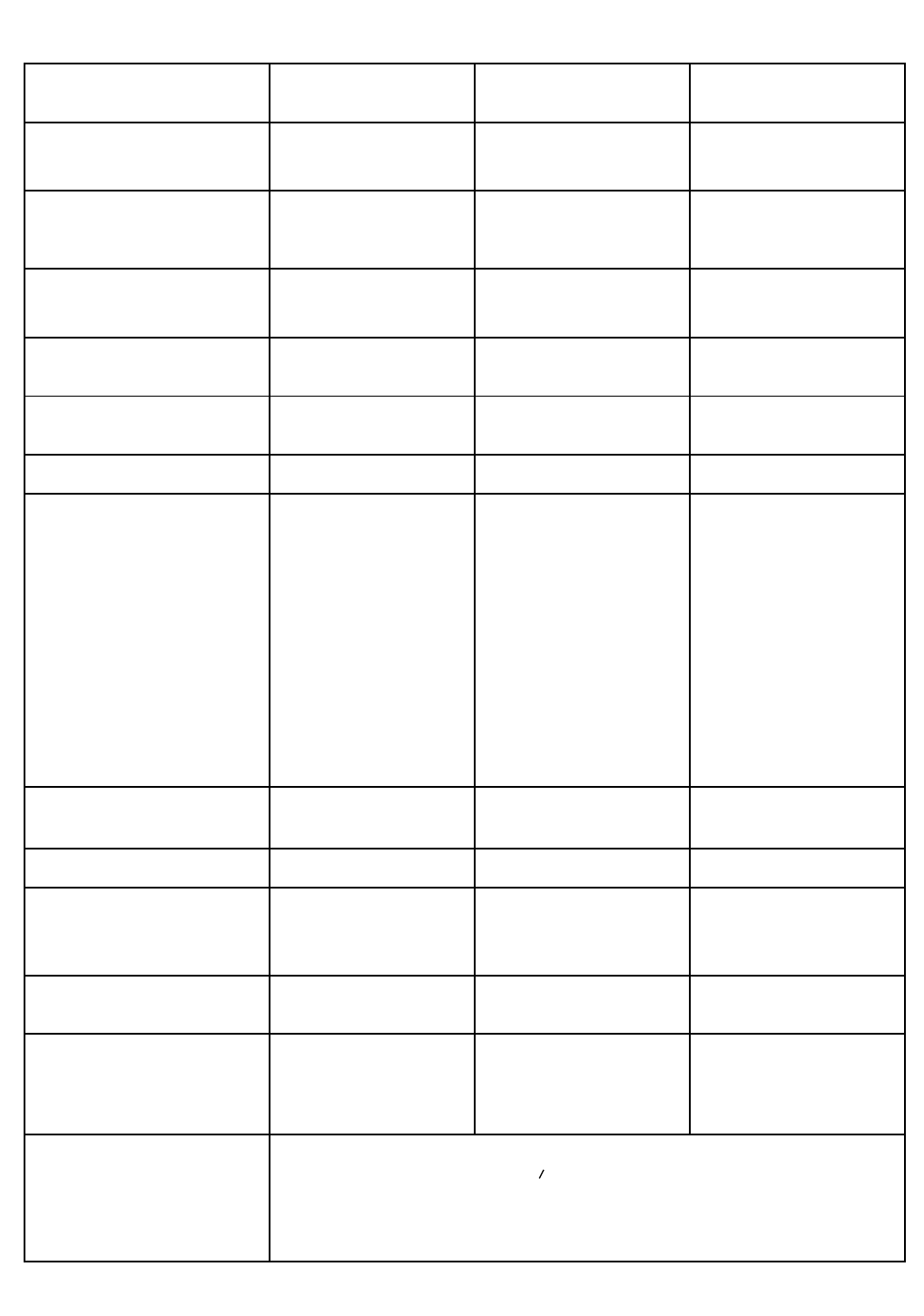
184
Function...
Basic
Channel
Mode
Note
Number :
Velocity
After
Touch
Pitch Bend
Control
Change
Prog
Change
System Exclusive
System
Common
System
Real Time
Aux
Message
Notes
Transmitted Recognized Remarks
Default
Changed
Default
Messages
Altered
True Voice
Note ON
Note OFF
Key’s
Ch’s
0, 32
1
5
6, 38
7
10
11
64
65
66
67
84
91
93
98, 99
100, 101
: True #
: Song Pos
: Song Sel
: Tune
: Clock
: Commands
: All sound off
:
Reset all controllers
: Local Control
: All Notes OFF
: Active Sense
: Reset
1
1–16
Mode 3
x
O
O
15–113
x
x
O
O
O
O
O
O
O
O
O
O
O
O
O
O
O
O
O
O
O
O
O
O
O
O
O
O
O
O
O
O (Reverb)
O (Chorus)
O
O
0–127
**************
O
x
x
x
O
x
x
x
x
x
O
x
1–16
1–16
Mode 3
Mode 3, 4 (M=1)
O
O
0–127
0–127
O
O
O
O
0–127
O
x
x
x
x
x
O (120, 126, 127)
O
O
O (123–125)
O
x
Bank select
Modulation
Portamento time
Data entry
Volume
Panpot
Expression
Hold 1
Portamento
Sostenuto
Soft
Portamento control
Effect1 depth
Effect3 depth
NRPN LSB, MSB
RPN LSB, MSB
* 1 O x is selectable by SysEx.
* 2 Recognized as M=1 even if M=1.
DIGITAL PIANO
Model KR-107
Date : Mar. 1, 2005
Version : 1.00
MIDI Implementation Chart
**************
**************
Mode 1 : OMNI ON, POLY
Mode 3 : OMNI OFF, POLY
Mode 2 : OMNI ON, MONO
Mode 4 : OMNI OFF, MONO
O : Yes
X : No
* 2
Program number 1–128
*1
*1
*1
*1
*1
*1
*1
*1
*1
*1
*1
*1
*1
*1
*1
*1
*1
*1
*1
*1
*1
*1
*1
*1
*1
*1
*1
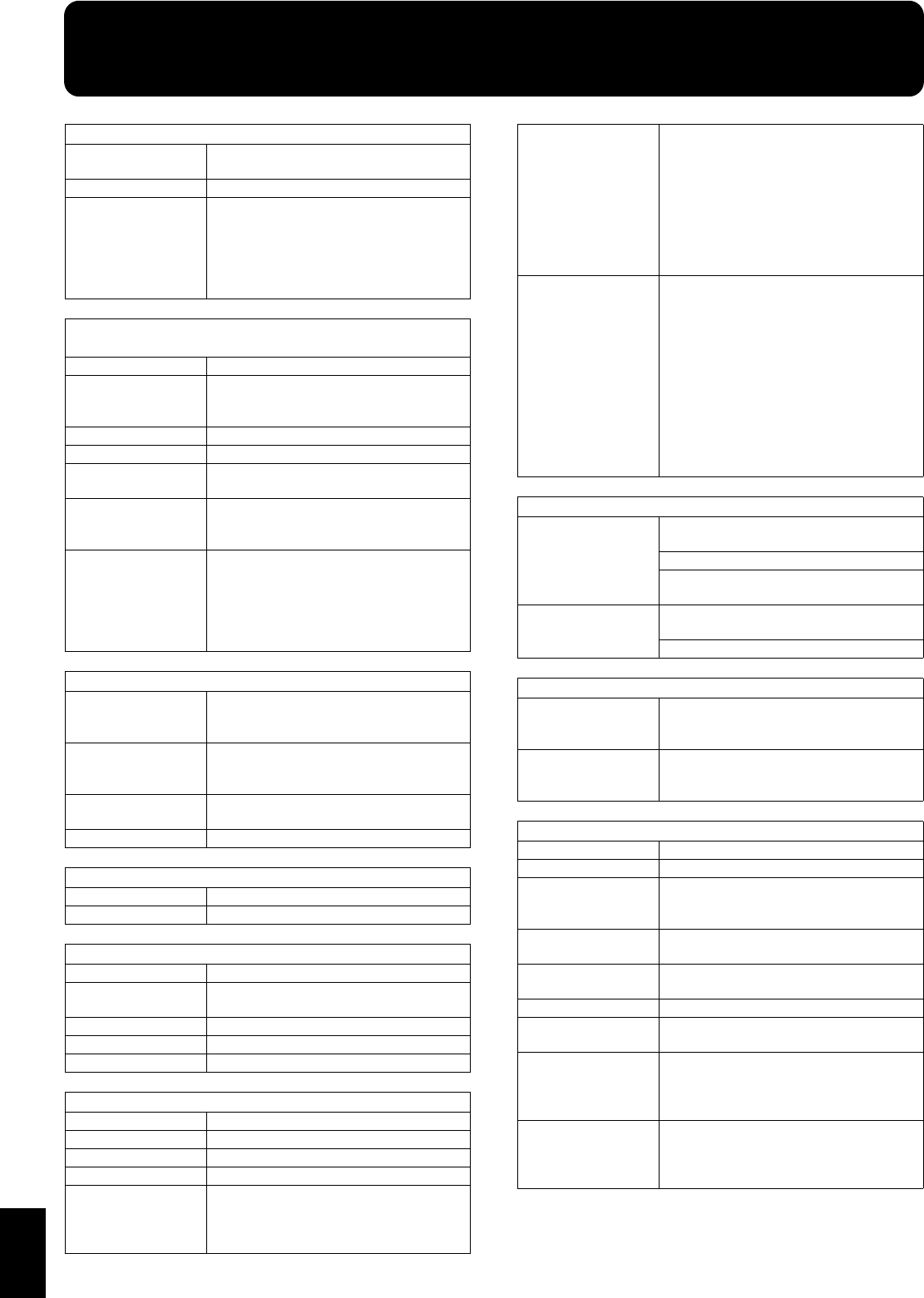
185
Appendices
Main Specifications
<Keyboard>
Keyboard 88 keys (Progressive hammer action
keyboard with escapement)
Touch Sensitivity 100 levels
Keyboard Mode
Whole
Split (adjustable split point)
Layer
Arranger
Piano Style Arranger
Manual Drums / SFX
<Sound Generator>
Conforms to GM2 / GS / XG Lite
Max. Polyphony 128 voices
Tones
(Tone Search by
terms and by letters)
6 groups 736 variations (including 8 tone
wheel Organs, 18 drum sets, SFX set)
Temperament 8 types, selectable tonic
Stretched Tuning 2 types
Master Tuning 415.3 Hz–466.2 Hz (adjustable in
increments of 0.1 Hz)
Transpose
Key Transpose (-6–+5 in units of semitone)
Playback Transpose (-24–+24 in units of
semitone)
Effects
Reverb (12 types, 127 levels)
Chours, Rotary and 60 other types
Advanced 3D
Grand Space
Dynamic Emphasis (3 types)
Equalizer (5 bands, Master level)
<Arranger>
Music Styles
(Style Search by
terms and by letters)
6 groups 265 styles x 3 types (Style
Orchestrator)
Music Assistant
(Search by terms
and by letters)
Over 500 sets x 6 presets
Visual Music Assistant
Programmable
Music Styles
Style Converter
Style Composer
Melody Intelligence 24 types
<User Programs>
Internal 36
External Memory Max. 99 sets
<Metronome>
Tempo Quarter note = 10–500
Beat 2/2, 0/4, 2/4, 3/4, 4/4, 5/4, 6/4, 7/4, 3/8,
6/8, 9/8, 12/8
Volume 10 levels
Metronome Pattern 11 patterns
Metronome Sound 8 types
<Composer>
Tracks 5 tracks / 16 tracks
Song 1 song
Note Storage Approx. 30,000 notes
Resolution 120 ticks per quarter note
Recording Method
Realtime (Replace, Mix, Auto Punch In,
Manual Punch In, Loop, Tempo)
Step (Chord Sequencer)
Beat Map
Edit
Copy
Quantize
Delete
Insert
Erase
Transpose
Part Exchange
Note Edit
PC Edit
Other Functions
Touch the Notes
Replay
Super Tones
Piano Designer
Visual Lesson
Wonderland/Game
Demo
Audition
Panel Lock
User Image Display
BMP Export
V-LINK
<External Storage> USB Memory
Playable Software
Song: Standard MIDI Files (Format 0/1),
Roland Original Format (i-Format)
Music Style: MSA, MSD, MSE
Audio File: WAV Format (44.1 kHz 16 bits
linear, stereo)
Save
Song: Standard MIDI Files (Format 0),
Roland Original Format (i-Format)
Music Style: MSE
<Internal Memory>
Internal Songs
(Song Search by
terms and by letters)
Over 190 songs
User Memory
Max. 200 songs on Favorites
Max. 99 User Styles
Max. 99 User Program Sets
<Others>
Rated Power Output 60 W x 2
Speakers
20 cm x 2, 5 cm x 2, 10 cm x 2
Display
Bouncing Beat Indicator
Graphical Color LCD 320 x 240 dot (backlit
LCD)
Notation Grand staff / G Clef staff / F Clef staff,
with note name /lyrics/ chords / fingering
Language English / Japanese / German / French /
Spanish
Lyrics Yes (built-in, external display, MIDI output)
One Touch Program One Touch Piano
One Touch Arranger
Pedals
Damper Pedal (half-pedal recognition)
Soft Pedal (half-pedal recognition,
functions assignable)
Sostenuto Pedal (functions assignable)
Vocal Effects
Echo
Voice Transformer
Vocal Keyboard
Harmonist
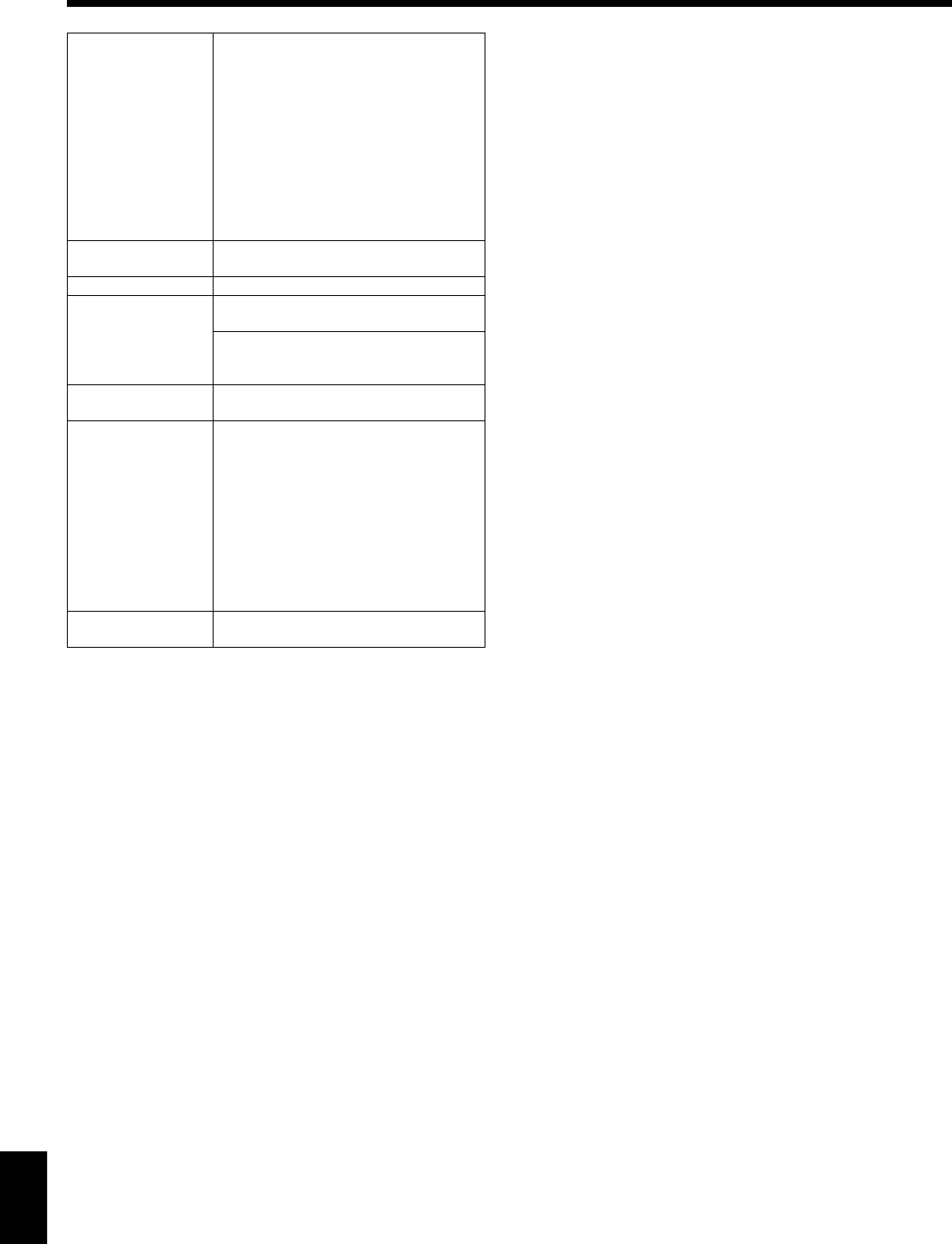
186
Main Specifications
Appendices
* In the interest of product improvement, the specifications and/or
appearance of this unit are subject to change without prior
notice.
962a
Connectors
USB memory connector
FDD connector
Output jacks (L/Mono, R)
Input jacks (L/Mono, R)
Mic Input jack
Headphones jack (Stereo) x 2
MIDI In connector x 2
MIDI Out connector
USB connector
Ext Display connector (15-pin D-Sub type)
Video Out jack
Expression Pedal jack
Power Supply AC 115 V, AC 117 V, AC 220 V, AC 230 V,
AC 240 V (50/60 Hz)
Power Consumption 155 W
Dimensions
(including the piano
stand)
1421 (W) x 550 (D) x 901 (H) mm
56 (W) x 21-11/16 (D) x 35-1/2 (H) inches
Including the music rest
1421 (W) x 550 (D) x 1116 (H) mm
56 (W) x 21-11/16 (D) x 43-15/16 (H) inches
Weights (including
the piano stand) 103 kg / 228 lbs
Accessories
Quick Start
Owner’s Manual
Roland 60 Classical Piano Masterpieces
Remote Control
Dry-cell Batteries
USB Installation Guide
CD-ROM (Roland Digital Piano USB
Driver)
Power cord
Headphones Hook
Anti-theft lock screws
Options USB Memory
Flopy Disk Drive

187
“QS **” refers to the page number in Quick Start.
Index
Numerics
16-Track Sequencer ..........................................................113
A
AC inlet .............................................................................16
Accompaniment
Start and Stop ...............................................................54
Sync Start .....................................................................54
Adjuster .............................................................................18
Advanced 3D .....................................................................30
[Ambience/Reverb] button ...............................................30
Arranger Config ..............................................................138
Audio Equipment ............................................................161
Auto Punch-In/Out .........................................................119
Automatic Accompaniment ...............................................46
B
Balance ..............................................................................62
Balance Knob .....................................................................62
Bank Select LSB ...............................................................160
Bank Select MSB ..............................................................160
Basic Screen .......................................................................20
Basic tempo .....................................................................127
Bass Tone ................................................................... 55, 138
Beat
Metronome ..................................................................44
Beat Map ..........................................................................127
Bend Range ......................................................................144
Blank Recording ..............................................................118
[Brilliance] knob ................................................................18
[Song] button .....................................................................64
[Bwd] button .....................................................................65
C
Calibration .......................................................................148
Chord Finder .....................................................................49
Chord Intelligence .............................................................48
Chord List ........................................................................178
Chord Sequencer .............................................................120
Chord Tone ................................................................ 55, 138
Chord type .........................................................................48
Chords .........................................................................48, 77
Clef L .................................................................................77
Clef R .................................................................................77
Compatibility ...................................................................103
Composer MIDI Out ........................................................161
Computer ........................................................................163
Connected
Expression Pedal ........................................................154
Connecting
Audio Equipment ......................................................161
Computer ...................................................................163
MIDI device ...............................................................158
Contrast .............................................................................19
Contrast knob ....................................................................19
Copy (Song Edit) .............................................................122
Copying
Songs ..........................................................................105
User Program .............................................................110
User Styles .................................................................136
Count In .............................................................................82
Countdown ........................................................................56
D
Damper pedal ....................................................................18
Delete (Song Edit) ............................................................123
Deleting
A song ........................................................................104
User Style ...................................................................135
Divisions ............................................................................46
Drum Set List ...................................................................172
Drums ................................................................................23
Dynamic Emphasis ............................................................32
E
Echo ...................................................................................37
Editing .............................................................................121
Effects ................................................................................35
Effects List .......................................................................176
Ending .........................................................................46, 55
Equalizer ............................................................................33
Erase (Song Edit) .............................................................124
Erasing
Performance on specific tracks .....................................96
Recorded performance .................................................96
Error Messages ................................................................169
Export ................................................................................78
Expression Pedal ..............................................................154
Ext Display connector ......................................................155
External Display ......................................................154, 156
External Memory ...............................................................98
F
Factory Reset ...................................................................147
Factory Setting
Touch Screen ..............................................................149
User Memory .............................................................149
Favorites ....................................................................68, 101

188
Index
“QS **” refers to the page number in Quick Start.
Registering ...................................................................68
Removing .....................................................................69
Fill In .................................................................................57
Fill In To Original ..............................................................46
Fill In To Variation ............................................................46
Finger Numbers .................................................................77
Format
Floppy disk ..................................................................99
Functions .........................................................................137
[Fwd] button ......................................................................65
G
General MIDI ...................................................................183
General MIDI 2 ................................................................183
GS ....................................................................................183
GS Format ........................................................................183
H
Harmonist ..........................................................................38
Harmony ...........................................................................59
Headphones ......................................................................18
I
Icon ....................................................................................20
i-format ............................................................................103
Insert (Song Edit) .............................................................124
Internal Song List ............................................................180
Intro .............................................................................46, 54
[Intro/Ending] button .......................................................54
K
Karaoke .............................................................................42
Key ....................................................................................77
Key Touch .......................................................................137
L
Language .........................................................................145
Layer ..................................................................................25
Layer tone ..........................................................................25
Leading bass ....................................................................143
Lid .....................................................................................17
Local Control ...................................................................160
Loop Recording ...............................................................118
Lower Tone ........................................................................60
Lyrics .........................................................................77, 152
lyrics ..................................................................................20
M
Manual Punch-In/Out .....................................................119
Marker .......................................................................84, 140
Erasing .........................................................................85
Moving .........................................................................85
Placing .........................................................................84
Repeat ..........................................................................86
Master Tuning .................................................................145
Melody Intelligence ...........................................................59
[Melody Intelligence] button .............................................59
Memory Backup ..............................................................146
Metronome ........................................................................43
Beat ..............................................................................44
Pattern ..........................................................................45
Sound ...........................................................................44
Volume .........................................................................44
[Metronome] button ..........................................................43
Mic In jack .........................................................................19
[Mic Volume] knob ............................................................19
Microphone .......................................................................19
MIDI ................................................................................158
MIDI Connector ...............................................................158
MIDI Devices ...................................................................158
MIDI Ensemble ................................................................159
MIDI Settings ...................................................................159
Minus One .........................................................................83
Mix Recording .................................................................117
Multitrack Recording .......................................................113
Music Files .........................................................................41
Music Holder .....................................................................16
Music Style ........................................................................46
On Disk ........................................................................51
Rhythm Pattern ............................................................53
Music Style Buttons ...........................................................50
Music Style List ................................................................177
Mute ..........................................................................83, 114
N
New Song ..........................................................................90
Notaion
Saving as image data ....................................................78
Notation .............................................................................73
Settings .........................................................................75
Note Edit (Song Edit) .......................................................126
O
Octave Shift .......................................................................27
One Touch Program [Arranger] button .............................47
One Touch Program [Piano] button ...................................21
One Touch Settings ..........................................................138
One-Touch Arranger .........................................................47

189
Index
“QS **” refers to the page number in Quick Start.
Settings ......................................................................137
One-Touch Piano ...............................................................21
Opening Message ............................................................146
Original .............................................................................46
[Original] button ................................................................57
Output Jacks ....................................................................161
P
Panel Lock .......................................................................151
Part Balance .......................................................................62
[Part Balance] button .........................................................62
Part Exchange (Song Edit) ...............................................125
PC Edit (Song Edit) ..........................................................126
Pedal ..................................................................................18
Pedal Cable ........................................................................16
Pedal connector .........................................................16, 154
Pedal Settings ..................................................................142
Percussion .........................................................................23
Performance Pad .......................................................58, 142
Phones jack ........................................................................18
Piano ..................................................................................21
Piano Screen ......................................................................20
Pickup ................................................................................97
Pitches ...............................................................................77
Play Mode ........................................................................151
[Play/Stop] button ............................................................65
Playing ...............................................................................64
All of the internal songs ...............................................64
At a fixed tempo (Tempo Mute) ..................................81
In random ....................................................................64
Repeat ..........................................................................86
Power Cord .......................................................................16
Power On and Off .............................................................17
[Power] switch ...................................................................17
Preset .................................................................................50
Program Change ..............................................................160
PU (Pickup) .......................................................................97
Punch-in Recording .........................................................119
Q
Quantize (Song Edit) .......................................................123
Quick Tour
Automatically starting ...............................................150
R
Rec Mode ................................................................... 96, 116
Record/Playback Buttons ..................................................65
Recording ..........................................................................89
16-Track Sequencer ....................................................115
A new song ..................................................................90
Along with a Song ........................................................94
Redoing recordings ......................................................95
Track buttons ...............................................................95
With Accompaniment ..................................................92
Remote Control .................................................... 70–71, 147
Repeat ................................................................................86
Replace Recording ...........................................................117
[Reset] button ....................................................................65
Restoring the Factory Settings .........................................147
Reverb ................................................................................28
Right-hand tone .................................................................25
Root note ............................................................................48
Rotary effect .....................................................................143
S
Saving ..............................................................................101
Compatibility .............................................................103
User Style ...................................................................134
[Score Display] button .......................................................73
Screens
16-track Sequencer screen ..........................................113
Advanced 3D screen ....................................................30
Basic screen ............................................................20, 47
Chord Sequencer screen .............................................120
Copy Song screen .......................................................105
Copy Style screen .......................................................136
Copy User Programs screen ...............................110–111
Count In settings screen ...............................................82
Countdown settings screen ..........................................56
Delete Song screen .....................................................104
Delete Style screen .....................................................135
Delete User Program screen .......................................110
Effect screen .................................................................35
Equalizer screen .....................................................33–34
File screen ....................................................................99
Functions screen .........................................................141
Load User Program screen .........................................109
Marker screen ..............................................................84
Melody Intelligence screen ..........................................59
Metronome screen ........................................................43
MIDI Setting Screen ...................................................159
Notation screen ............................................................73
Part Balance screen ......................................................62
Piano screen ...........................................................20–21
Program Change Screen .............................................159
Rec Mode screen ........................................................117
Rename screen ........................................... 102, 107, 134

190
Index
“QS **” refers to the page number in Quick Start.
Reverb screen ...............................................................28
Save Song screen ........................................................101
Save Style screen ........................................................134
Save User Program screen .........................................108
Song Edit screen .........................................................121
Song Search screen .......................................................67
Song Selection screen ...................................................64
Style Composer screen ...............................................130
Style Converter screen ...............................................132
Style Search screen .......................................................52
Style Selection screen ...................................................50
Tone search screen .......................................................24
Tone selection screen ...................................................22
Transpose screen ..........................................................87
User Program screen ..................................................107
Vocal Effects screen ......................................................36
Write User Program screen ........................................107
Search
Music Style ...................................................................52
Song .............................................................................67
Tone .............................................................................24
SMF .................................................................................183
SMF Music files ...............................................................183
Soft pedal ...........................................................................18
Solo ..................................................................................114
Song Search .......................................................................67
Sostenuto pedal .................................................................18
[Sound Control] button .....................................................33
Sound Effects .....................................................................23
Sound Generator .............................................................183
Speaker Cable ....................................................................16
Split ...................................................................................61
Split Point ........................................................................138
[Start/Stop] button ............................................................54
Stretch Tuning .................................................................142
Style Composer ...............................................................129
Style Converter ................................................................131
Style Orchestrator ..............................................................58
[Style Orchestrator] button ................................................58
Style Search .......................................................................52
Sync ...................................................................................54
T
Tap Tempo ........................................................................80
Temperament ..................................................................141
Tempo ................................................................... 44, 53, 80
Tempo [-] [+] buttons .........................................................80
Tempo Mute ......................................................................81
Tempo Recording ............................................................127
Tone Buttons ......................................................................22
Tone List ..........................................................................170
Tone Search .......................................................................24
Tone Set ...........................................................................115
Touch Screen .............................................................19, 148
Touch the Notes .................................................................74
Track Assign ....................................................................152
Track Buttons ......................................................... 83, 91, 93
Transformer .......................................................................37
Transpose ..........................................................................87
Transpose (Song Edit) ......................................................124
[Transpose] button .............................................................87
Troubleshooting ..............................................................165
Tuning .............................................................................141
Tuning Curve ..................................................................142
Tx Channel .......................................................................160
U
Undo (Song Edit) .............................................................122
USB Driver .......................................................................164
User Functions .................................................................142
User Image Display .........................................................145
User Memory ...................................................................134
Formatting .................................................................149
User Program ...................................................................107
Calling up ..................................................................108
Copying .....................................................................110
Deleting ......................................................................110
Loading ......................................................................109
Registering .................................................................107
Saving ........................................................................108
Transmitting PC Numbers .........................................111
User Style ...................................................................51, 129
Copying .....................................................................136
Deleting ......................................................................135
Saving ........................................................................134
V
Variation ............................................................................46
[Variation] button ..............................................................57
V-LINK ............................................................................157
Vocal Count-In ...................................................................39
Vocal Effect ........................................................................36
[Vocal Effect] button ..........................................................36
Vocal Keyboard .................................................................40
Volume
CD ................................................................................72

191
Index
“QS **” refers to the page number in Quick Start.
Metronome ..................................................................44
Microphone ..................................................................19
Overall .........................................................................18
[Volume] knob ...................................................................18
X
XG lite ..............................................................................183
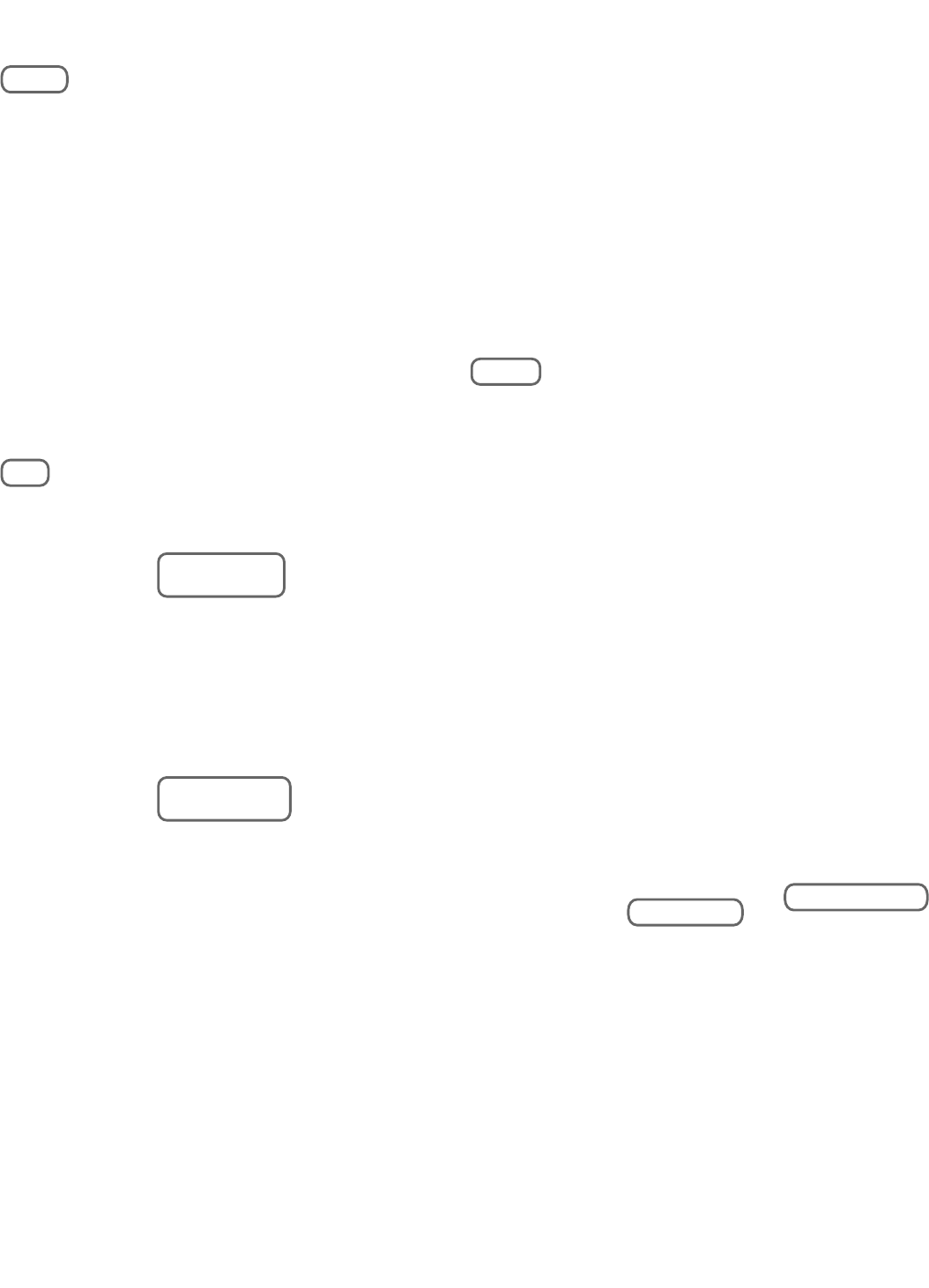
As of January 15, 2005 (ROLAND)
Information
When you need repair service, call your nearest Roland Service Center or authorized Roland
distributor in your country as shown below.
EGYPT
Al Fanny Trading Office
9, EBN Hagar A1 Askalany
Street,
ARD E1 Golf, Heliopolis,
Cairo 11341, EGYPT
TEL: 20-2-417-1828
REUNION
Maison FO - YAM Marcel
25 Rue Jules Hermann,
Chaudron - BP79 97 491
Ste Clotilde Cedex,
REUNION ISLAND
TEL: (0262) 218-429
SOUTH AFRICA
That Other Music Shop(PTY)Ltd.
11 Melle St., Braamfontein,
Johannesbourg,
SOUTH AFRICA
TEL: (011) 403 4105
FAX: (011) 403 1234
Paul Bothner(PTY)Ltd.
17 Werdmuller Centre,
Main Road, Claremont 7708
SOUTH AFRICA
TEL: (021) 674 4030
CHINA
Roland Shanghai Electronics
Co.,Ltd.
5F. No.1500 Pingliang Road
Shanghai 200090, CHINA
TEL: (021) 5580-0800
Roland Shanghai Electronics
Co.,Ltd.
(BEIJING OFFICE)
10F. No.18 3 Section Anhuaxili
Chaoyang District Beijing
100011 CHINA
TEL: (010) 6426-5050
Roland Shanghai Electronics
Co.,Ltd.
(GUANGZHOU OFFICE)
2/F., No.30 Si You Nan Er Jie
Yi Xiang, Wu Yang Xin Cheng,
Guangzhou 510600, CHINA
TEL: (020) 8736-0428
HONG KONG
Tom Lee Music Co., Ltd.
Service Division
22-32 Pun Shan Street, Tsuen
Wan, New Territories,
HONG KONG
TEL: 2415 0911
Parsons Music Ltd.
8th Floor, Railway Plaza, 39
Chatham Road South, T.S.T,
Kowloon, HONG KONG
TEL: 2333 1863
INDIA
Rivera Digitec (India) Pvt. Ltd.
409, Nirman Kendra
Mahalaxmi Flats Compound
Off. Dr. Edwin Moses Road,
Mumbai-400011, INDIA
TEL: (022) 2493 9051
INDONESIA
PT Citra IntiRama
J1. Cideng Timur No. 15J-150
Jakarta Pusat
INDONESIA
TEL: (021) 6324170
KOREA
Cosmos Corporation
1461-9, Seocho-Dong,
Seocho Ku, Seoul, KOREA
TEL: (02) 3486-8855
MALAYSIA
Roland Asia Pacific Sdn. Bhd.
45-1, Block C2, Jalan PJU 1/39,
Dataran Prima, 47301 Petaling
Jaya, Selangor, MALAYSIA
TEL: (03) 7805-3263
PHILIPPINES
G.A. Yupangco & Co. Inc.
339 Gil J. Puyat Avenue
Makati, Metro Manila 1200,
PHILIPPINES
TEL: (02) 899 9801
SINGAPORE
SWEE LEE MUSIC
COMPANY PTE. LTD.
150 Sims Drive,
SINGAPORE 387381
TEL: 6846-3676
CRISTOFORI MUSIC PTE LTD
Blk 3014, Bedok Industrial Park E,
#02-2148, SINGAPORE 489980
TEL: 6243-9555
TAIWAN
ROLAND TAIWAN
ENTERPRISE CO., LTD.
Room 5, 9fl. No. 112 Chung
Shan N.Road Sec.2, Taipei,
TAIWAN, R.O.C.
TEL: (02) 2561 3339
THAILAND
Theera Music Co. , Ltd.
330 Verng NakornKasem, Soi 2,
Bangkok 10100, THAILAND
TEL: (02) 2248821
VIETNAM
Saigon Music
Suite DP-8
40 Ba Huyen Thanh Quan Street
Hochiminh City, VIETNAM
TEL: (08) 930-1969
AUSTRALIA/
NEW ZEALAND
Roland Corporation
Australia Pty.,Ltd.
38 Campbell Avenue
Dee Why West. NSW 2099
AUSTRALIA
For Australia
Tel: (02) 9982 8266
For New Zealand
Tel: (09) 3098 715
ARGENTINA
Instrumentos Musicales S.A.
Av.Santa Fe 2055
(1123) Buenos Aires
ARGENTINA
TEL: (011) 4508-2700
BARBADOS
A&B Music Supplies LTD
12 Webster Industrial Park
Wildey, St.Michael, Barbados
TEL: (246)430-1100
BRAZIL
Roland Brasil Ltda.
Rua San Jose, 780 Sala B
Parque Industrial San Jose
Cotia - Sao Paulo - SP, BRAZIL
TEL: (011) 4615 5666
CHILE
Comercial Fancy II S.A.
Rut.: 96.919.420-1
Nataniel Cox #739, 4th Floor
Santiago - Centro, CHILE
TEL: (02) 688-9540
COLOMBIA
Centro Musical Ltda.
Cra 43 B No 25 A 41 Bododega 9
Medellin, Colombia
TEL: (574)3812529
COSTA RICA
JUAN Bansbach Instrumentos
Musicales
Ave.1. Calle 11, Apartado 10237,
San Jose, COSTA RICA
TEL: 258-0211
CURACAO
Zeelandia Music Center Inc.
Orionweg 30
Curacao, Netherland Antilles
TEL:(305)5926866
DOMINICAN REPUBLIC
Instrumentos Fernando Giraldez
Calle Proyecto Central No.3
Ens.La Esperilla
Santo Domingo,
Dominican Republic
TEL:(809) 683 0305
ECUADOR
Mas Musika
Rumichaca 822 y Zaruma
Guayaquil - Ecuador
TEL:(593-4)2302364
EL SALVADOR
OMNI MUSIC
75 Avenida Norte y Final
Alameda Juan Pablo II,
Edificio No.4010 San Salvador,
EL SALVADOR
TEL: 262-0788
GUATEMALA
Casa Instrumental
Calzada Roosevelt 34-01,zona 11
Ciudad de Guatemala
Guatemala
TEL:(502) 599-2888
HONDURAS
Almacen Pajaro Azul S.A. de C.V.
BO.Paz Barahona
3 Ave.11 Calle S.O
San Pedro Sula, Honduras
TEL: (504) 553-2029
MARTINIQUE
Musique & Son
Z.I.Les Mangle
97232 Le Lamantin
Martinique F.W.I.
TEL: 596 596 426860
Gigamusic SARL
10 Rte De La Folie
97200 Fort De France
Martinique F.W.I.
TEL: 596 596 715222
MEXICO
Casa Veerkamp, s.a. de c.v.
Av. Toluca No. 323, Col. Olivar
de los Padres 01780 Mexico
D.F. MEXICO
TEL: (55) 5668-6699
NICARAGUA
Bansbach Instrumentos
Musicales Nicaragua
Altamira D'Este Calle Principal
de la Farmacia 5ta.Avenida
1 Cuadra al Lago.#503
Managua, Nicaragua
TEL: (505)277-2557
PANAMA
SUPRO MUNDIAL, S.A.
Boulevard Andrews, Albrook,
Panama City, REP. DE
PANAMA
TEL: 315-0101
PARAGUAY
Distribuidora De
Instrumentos Musicales
J.E. Olear y ESQ. Manduvira
Asuncion PARAGUAY
TEL: (595) 21 492147
PERU
Audionet
Distribuciones Musicales SAC
Juan Fanning 530
Miraflores
Lima - Peru
TEL: (511) 4461388
NORWAY
Roland Scandinavia Avd.
Kontor Norge
Lilleakerveien 2 Postboks 95
Lilleaker N-0216 Oslo
NORWAY
TEL: 2273 0074
POLAND
MX MUSIC SP.Z.O.O.
UL. Gibraltarska 4.
PL-03664 Warszawa POLAND
TEL: (022) 679 44 19
PORTUGAL
Roland Iberia, S.L.
Portugal Office
Cais das Pedras, 8/9-1 Dto
4050-465, Porto, PORTUGAL
TEL: 22 608 00 60
ROMANIA
FBS LINES
Piata Libertatii 1,
535500 Gheorgheni,
ROMANIA
TEL: (266) 364 609
RUSSIA
MuTek
3-Bogatyrskaya Str. 1.k.l
107 564 Moscow, RUSSIA
TEL: (095) 169 5043
SPAIN
Roland Iberia, S.L.
Paseo García Faria, 33-35
08005 Barcelona SPAIN
TEL: 93 493 91 00
SWEDEN
Roland Scandinavia A/S
SWEDISH SALES OFFICE
Danvik Center 28, 2 tr.
S-131 30 Nacka SWEDEN
TEL: (0)8 702 00 20
SWITZERLAND
Roland (Switzerland) AG
Landstrasse 5, Postfach,
CH-4452 Itingen,
SWITZERLAND
TEL: (061) 927-8383
UKRAINE
TIC-TAC
Mira Str. 19/108
P.O. Box 180
295400 Munkachevo,
UKRAINE
TEL: (03131) 414-40
UNITED KINGDOM
Roland (U.K.) Ltd.
Atlantic Close, Swansea
Enterprise Park, SWANSEA
SA7 9FJ,
UNITED KINGDOM
TEL: (01792) 702701
BAHRAIN
Moon Stores
No.16, Bab Al Bahrain Avenue,
P.O.Box 247, Manama 304,
State of BAHRAIN
TEL: 17 211 005
CYPRUS
Radex Sound Equipment Ltd.
17, Diagorou Street, Nicosia,
CYPRUS
TEL: (022) 66-9426
IRAN
MOCO INC.
No.41 Nike St., Dr.Shariyati Ave.,
Roberoye Cerahe Mirdamad
Tehran, IRAN
TEL: (021) 285-4169
ISRAEL
Halilit P. Greenspoon & Sons
Ltd.
8 Retzif Ha'aliya Hashnya St.
Tel-Aviv-Yafo ISRAEL
TEL: (03) 6823666
TRINIDAD
AMR Ltd
Ground Floor
Maritime Plaza
Barataria Trinidad W.I.
TEL: (868)638 6385
URUGUAY
Todo Musica S.A.
Francisco Acuna de Figueroa
1771
C.P.: 11.800
Montevideo, URUGUAY
TEL: (02) 924-2335
VENEZUELA
Instrumentos Musicales
Allegro,C.A.
Av.las industrias edf.Guitar
import
#7 zona Industrial de Turumo
Caracas, Venezuela
TEL: (212) 244-1122
AUSTRIA
Roland Elektronische
Musikinstrumente HmbH.
Austrian Office
Eduard-Bodem-Gasse 8,
A-6020 Innsbruck, AUSTRIA
TEL: (0512) 26 44 260
BELGIUM/FRANCE/
HOLLAND/
LUXEMBOURG
Roland Central Europe N.V.
Houtstraat 3, B-2260, Oevel
(Westerlo) BELGIUM
TEL: (014) 575811
CZECH REP.
K-AUDIO
Kardasovska 626.
CZ-198 00 Praha 9,
CZECH REP.
TEL: (2) 666 10529
DENMARK
Roland Scandinavia A/S
Nordhavnsvej 7, Postbox 880,
DK-2100 Copenhagen
DENMARK
TEL: 3916 6200
FINLAND
Roland Scandinavia As, Filial
Finland
Elannontie 5
FIN-01510 Vantaa, FINLAND
TEL: (0)9 68 24 020
GERMANY
Roland Elektronische
Musikinstrumente HmbH.
Oststrasse 96, 22844
Norderstedt, GERMANY
TEL: (040) 52 60090
GREECE
STOLLAS S.A.
Music Sound Light
155, New National Road
Patras 26442, GREECE
TEL: 2610 435400
HUNGARY
Roland East Europe Ltd.
Warehouse Area ‘DEPO’ Pf.83
H-2046 Torokbalint,
HUNGARY
TEL: (23) 511011
IRELAND
Roland Ireland
G2 Calmount Park, Calmount
Avenue, Dublin 12
Republic of IRELAND
TEL: (01) 4294444
ITALY
Roland Italy S. p. A.
Viale delle Industrie 8,
20020 Arese, Milano, ITALY
TEL: (02) 937-78300
JORDAN
AMMAN Trading Agency
245 Prince Mohammad St.,
Amman 1118, JORDAN
TEL: (06) 464-1200
KUWAIT
EASA HUSAIN AL-YOUSIFI
& SONS CO.
Abdullah Salem Street,
Safat, KUWAIT
TEL: 243-6399
LEBANON
Chahine S.A.L.
Gerge Zeidan St., Chahine
Bldg., Achrafieh, P.O.Box: 16-
5857
Beirut, LEBANON
TEL: (01) 20-1441
OMAN
TALENTZ CENTRE L.L.C.
P.O. BOX 37, MUSCAT,
POSTAL CODE 113
TEL: 931-3705
QATAR
Al Emadi Co. (Badie Studio &
Stores)
P.O. Box 62, Doha, QATAR
TEL: 4423-554
SAUDI ARABIA
aDawliah Universal
Electronics APL
Corniche Road, Aldossary
Bldg., 1st Floor, Alkhobar,
SAUDI ARABIA
P.O.Box 2154, Alkhobar 31952
SAUDI ARABIA
TEL: (03) 898 2081
SYRIA
Technical Light & Sound
Center
Rawda, Abdul Qader Jazairi St.
Bldg. No. 21, P.O.BOX 13520,
Damascus, SYRIA
TEL: (011) 223-5384
TURKEY
Ant Muzik Aletleri Ithalat Ve
Ihracat Ltd Sti
Siraselviler Caddesi
Siraselviler Pasaji No:74/20
Taksim - Istanbul, TURKEY
TEL: (0212) 2449624
U.A.E.
Zak Electronics & Musical
Instruments Co. L.L.C.
Zabeel Road, Al Sherooq Bldg.,
No. 14, Grand Floor, Dubai,
U.A.E.
TEL: (04) 3360715
CANADA
Roland Canada Music Ltd.
(Head Office)
5480 Parkwood Way
Richmond B. C., V6V 2M4
CANADA
TEL: (604) 270 6626
Roland Canada Music Ltd.
(Toronto Office)
170 Admiral Boulevard
Mississauga On L5T 2N6
CANADA
TEL: (905) 362 9707
U. S. A.
Roland Corporation U.S.
5100 S. Eastern Avenue
Los Angeles, CA 90040-2938,
U. S. A.
TEL: (323) 890 3700
ASIA
AFRICA
AUSTRALIA/
NEW ZEALAND
EUROPE
CENTRAL/LATIN
AMERICA
MIDDLE EAST NORTH AMERICA